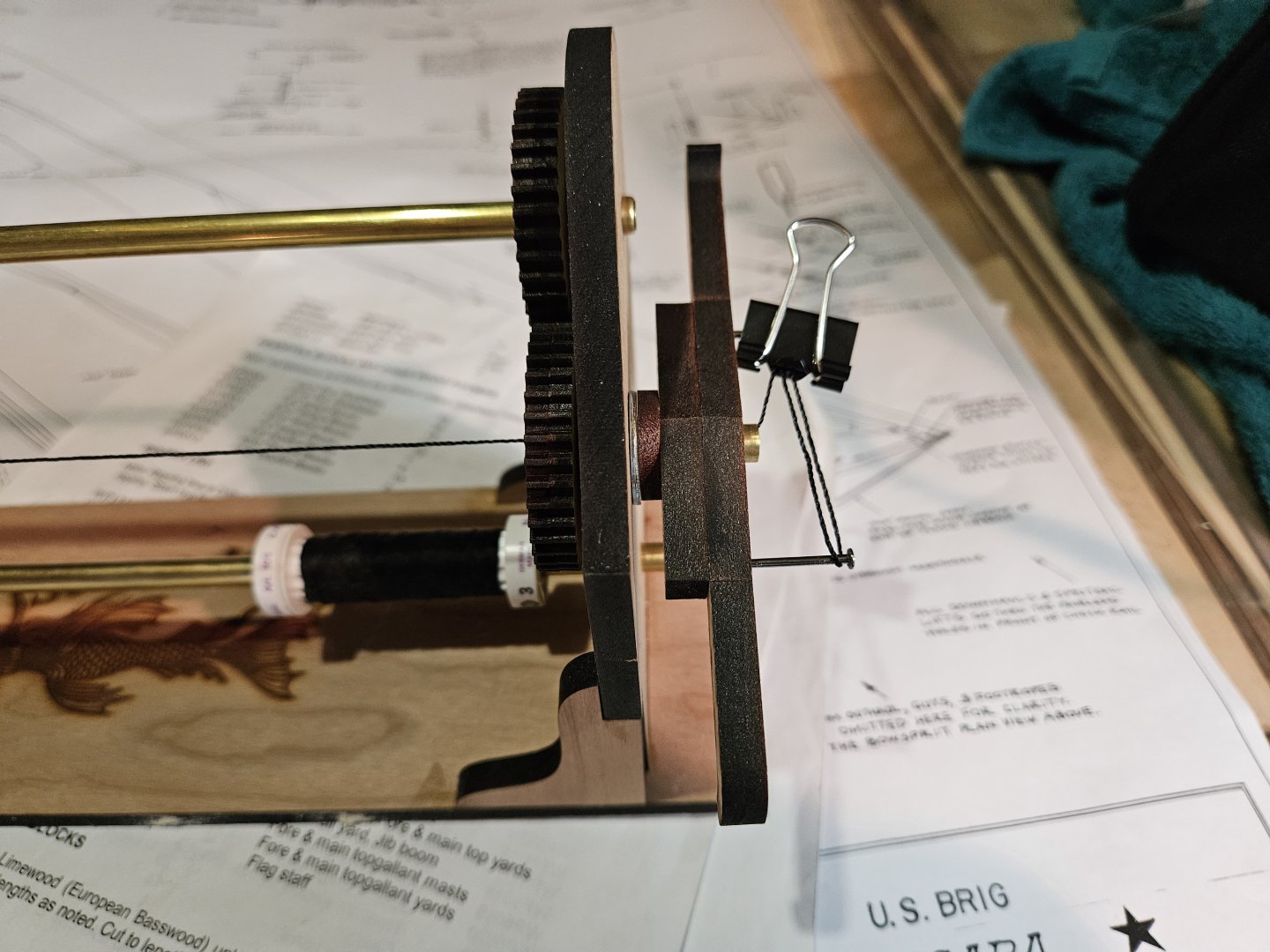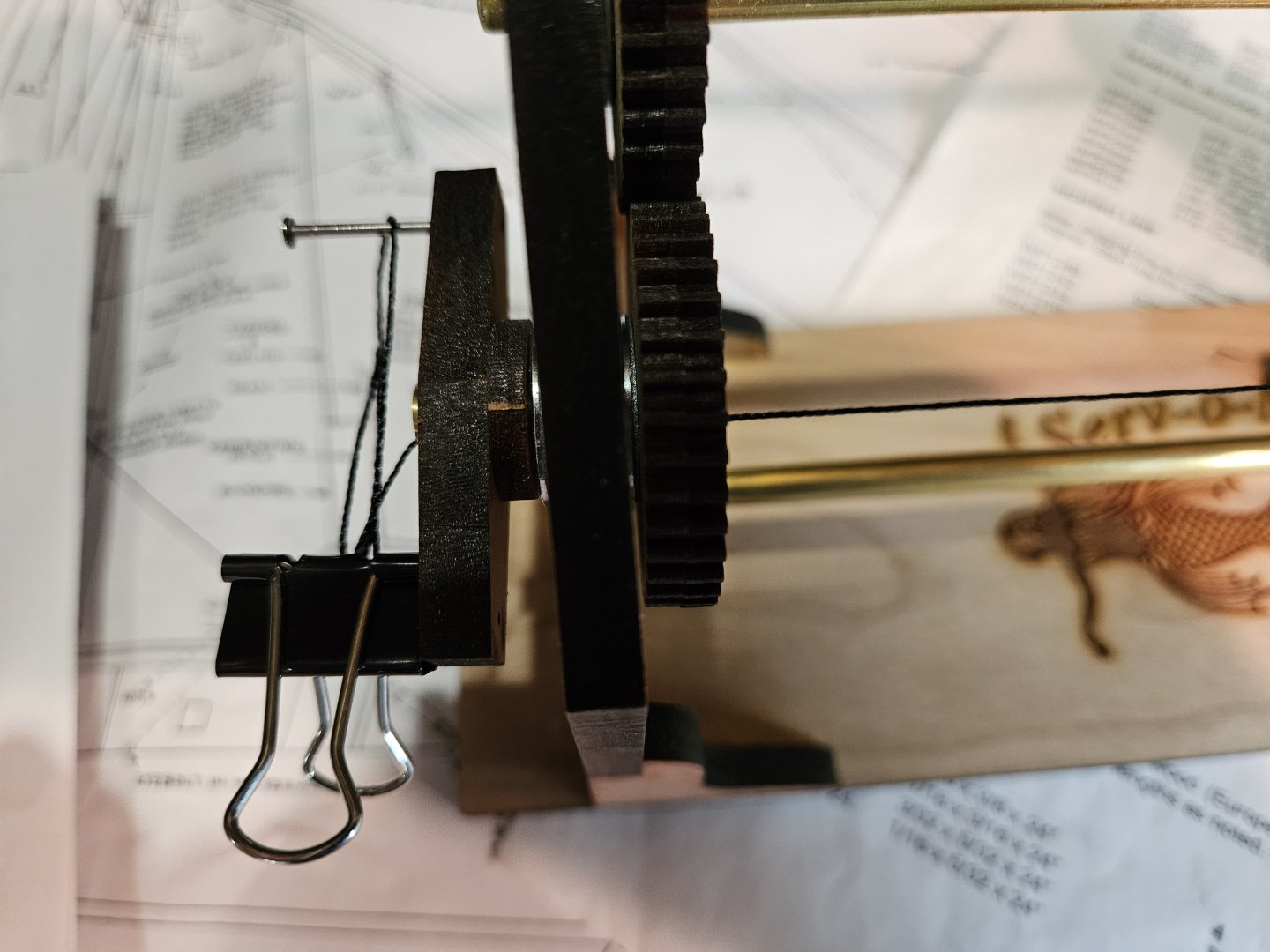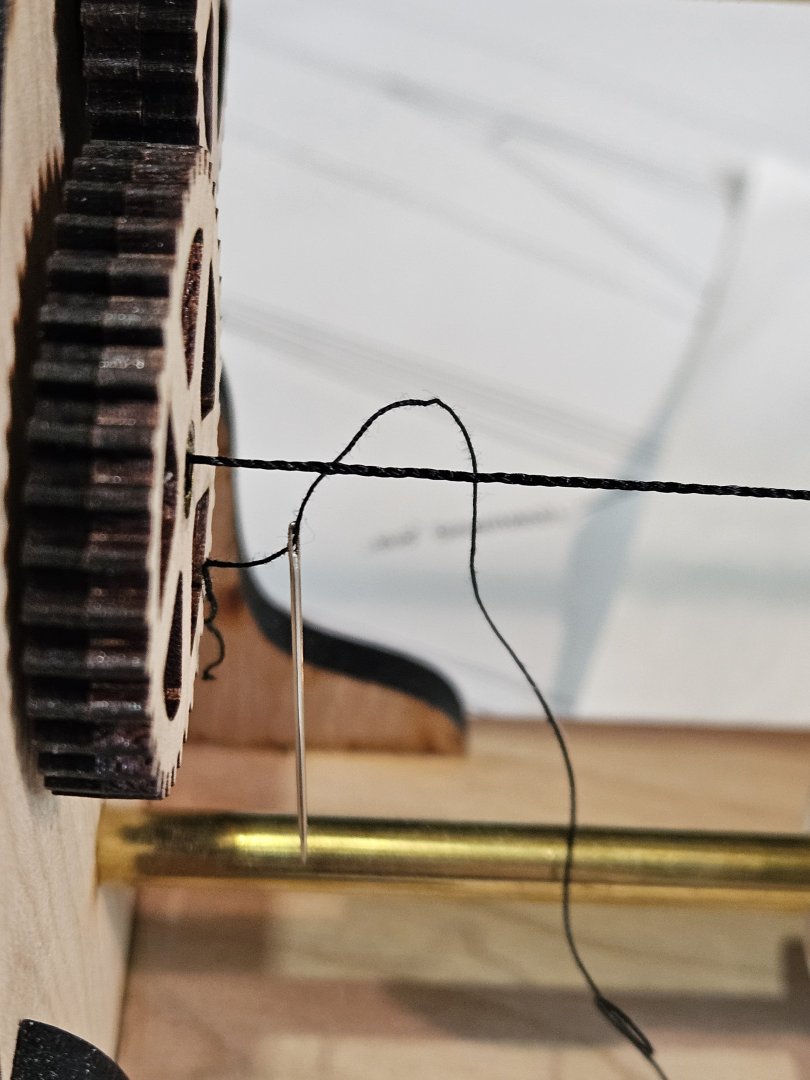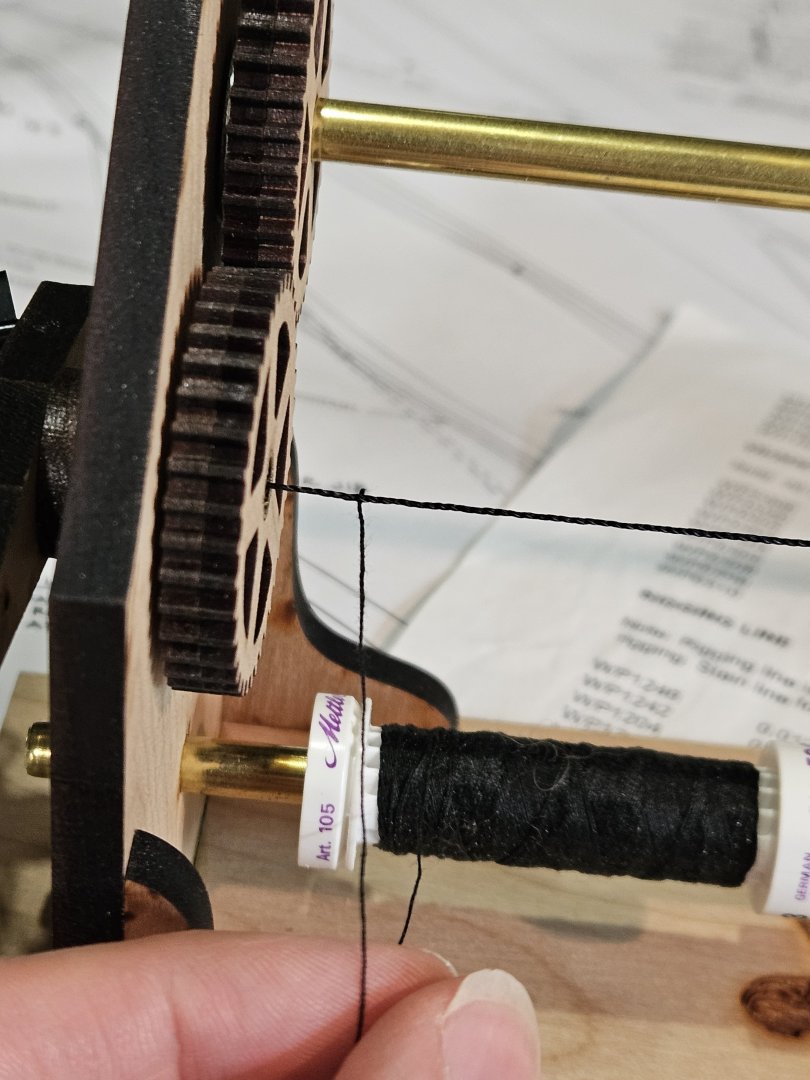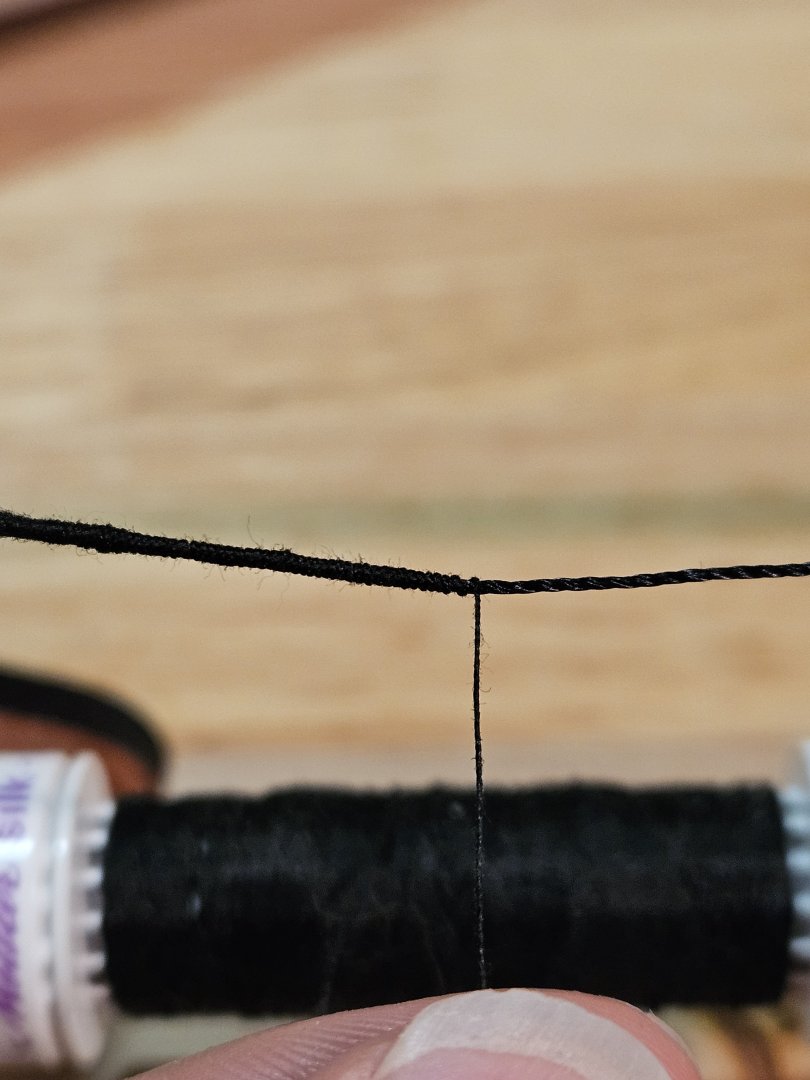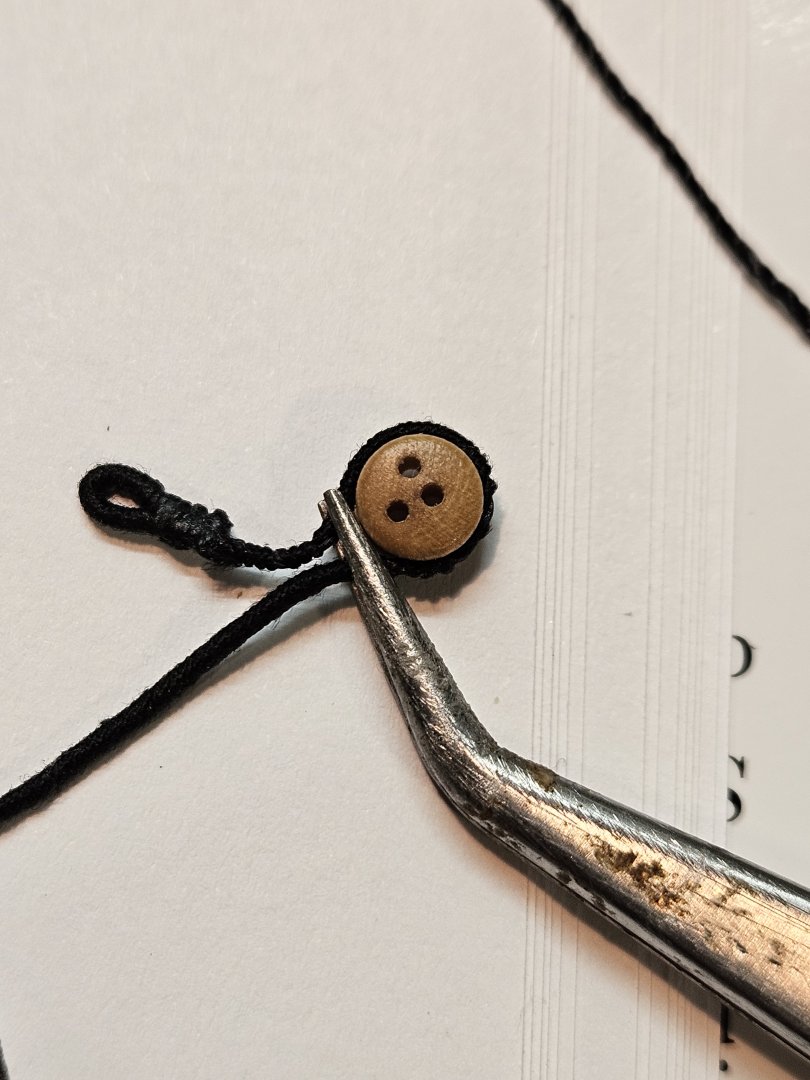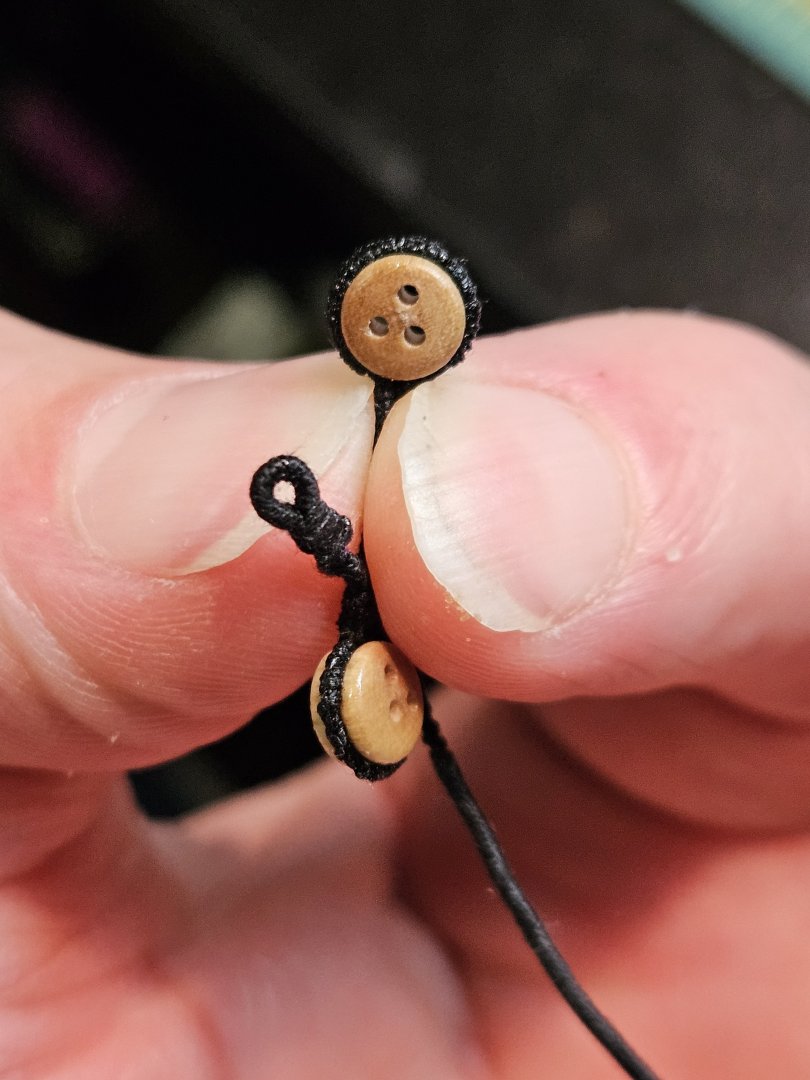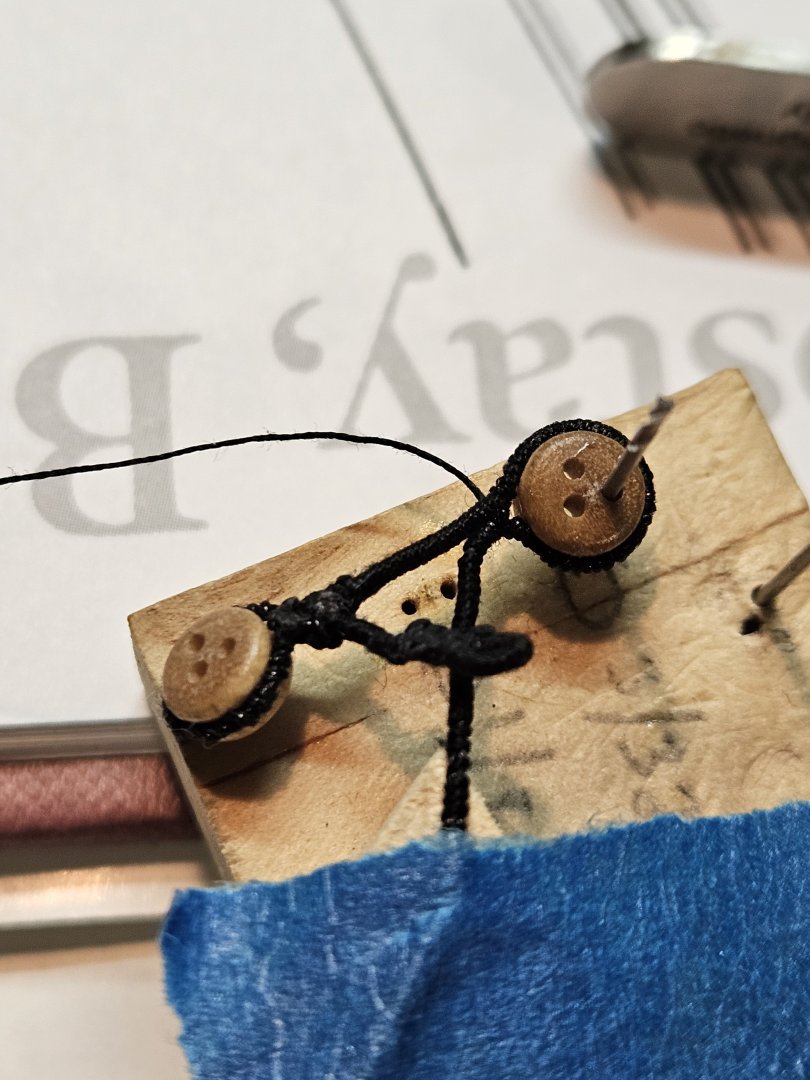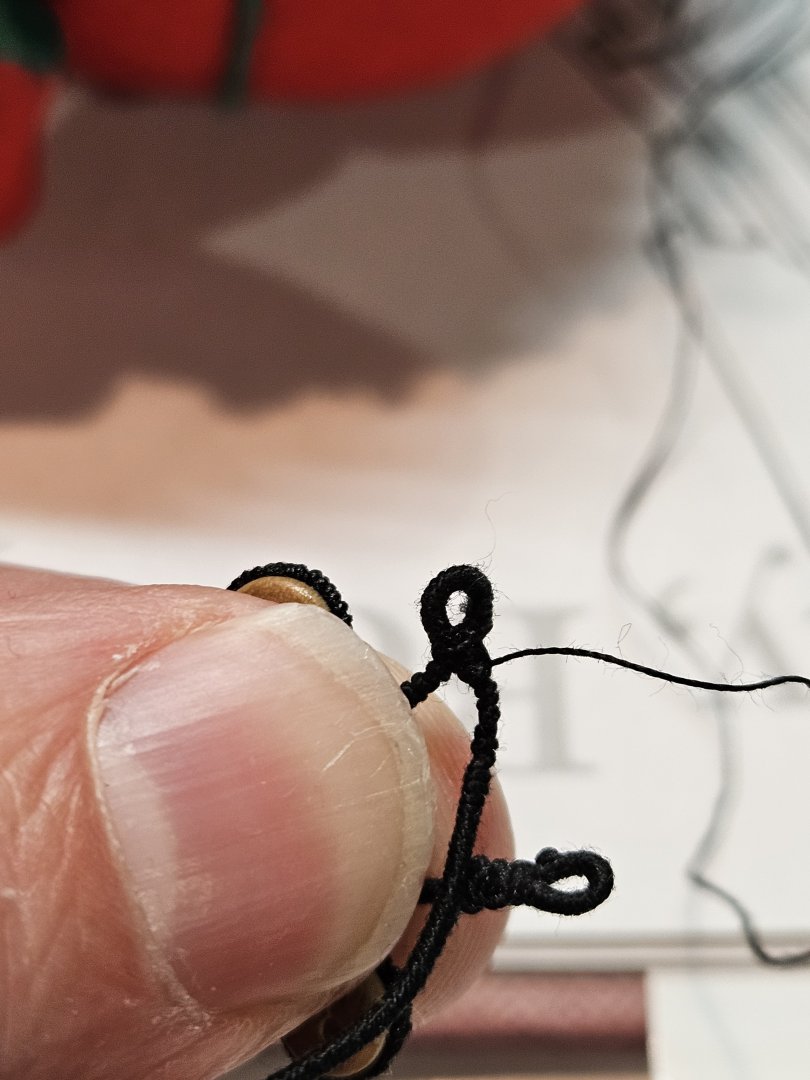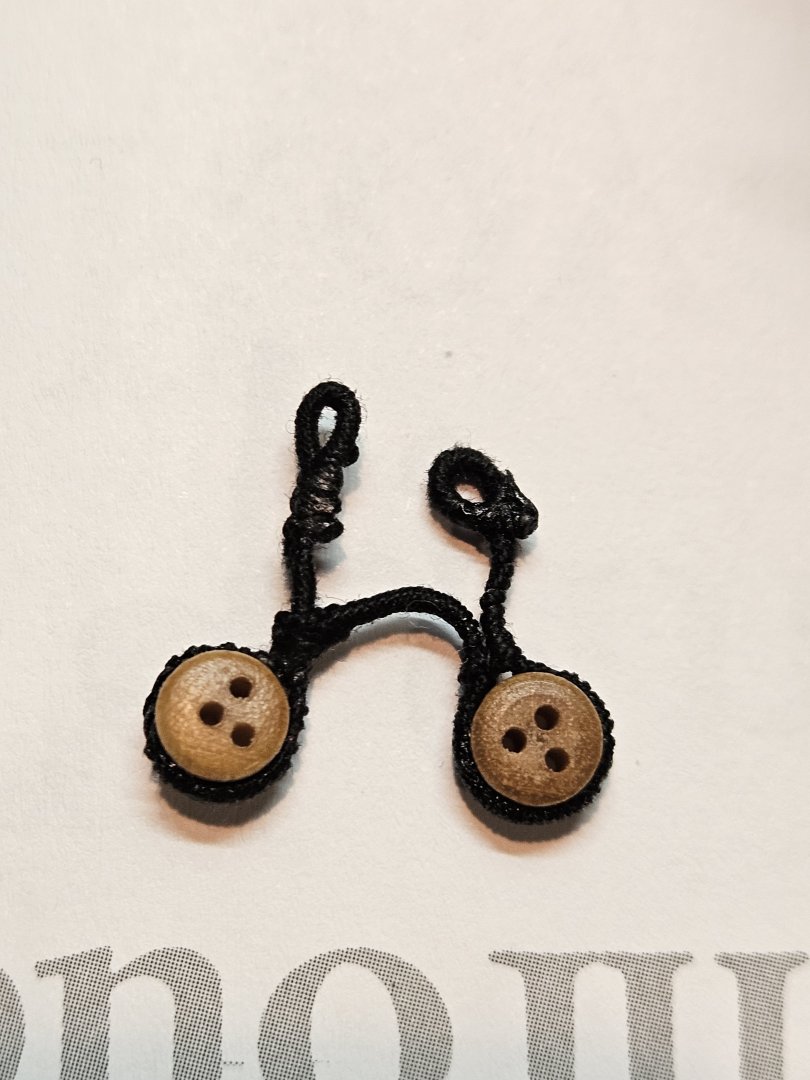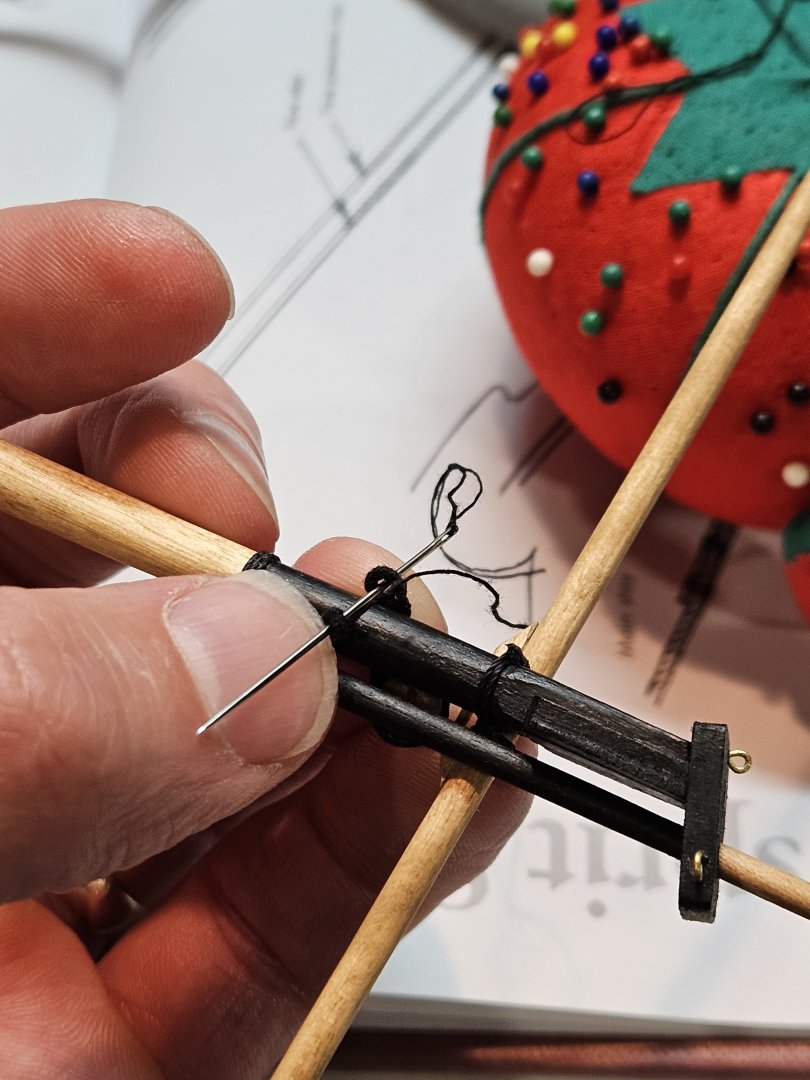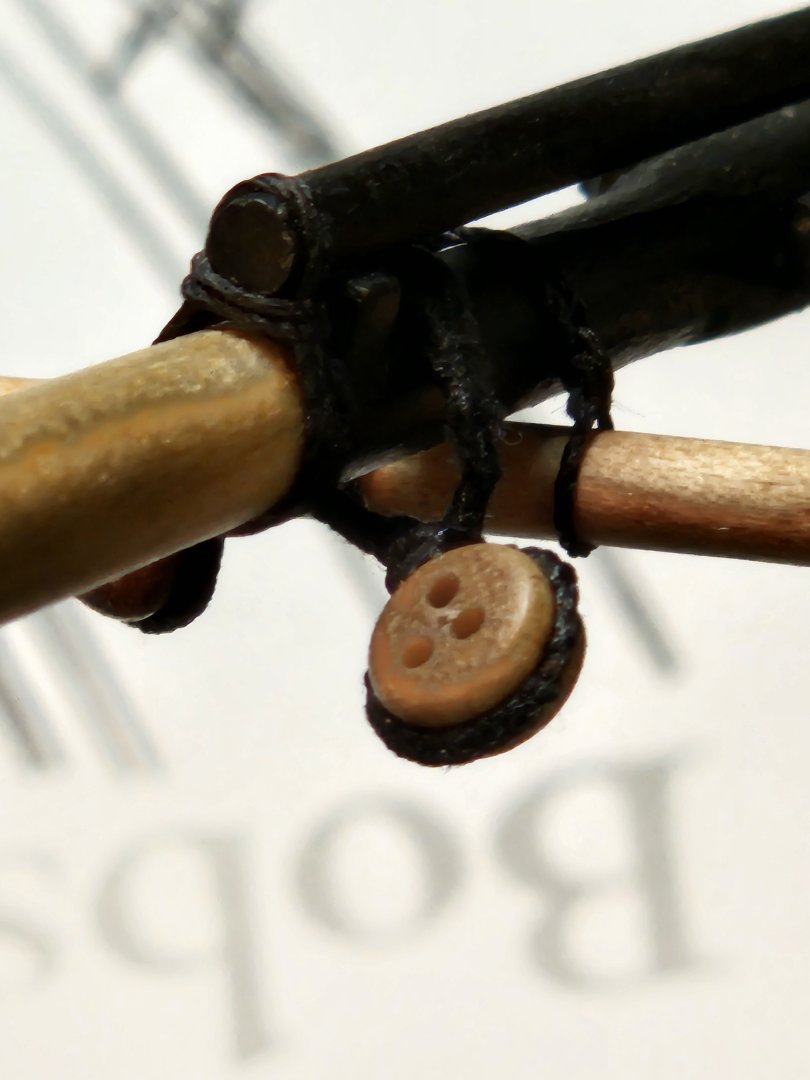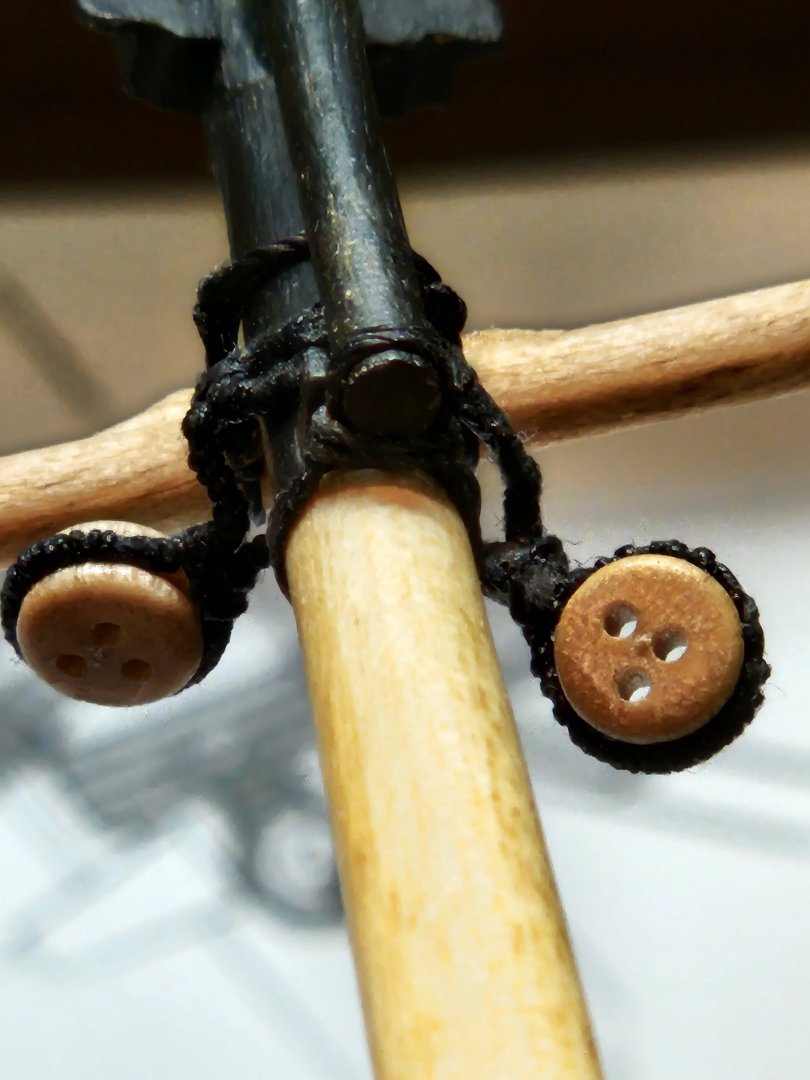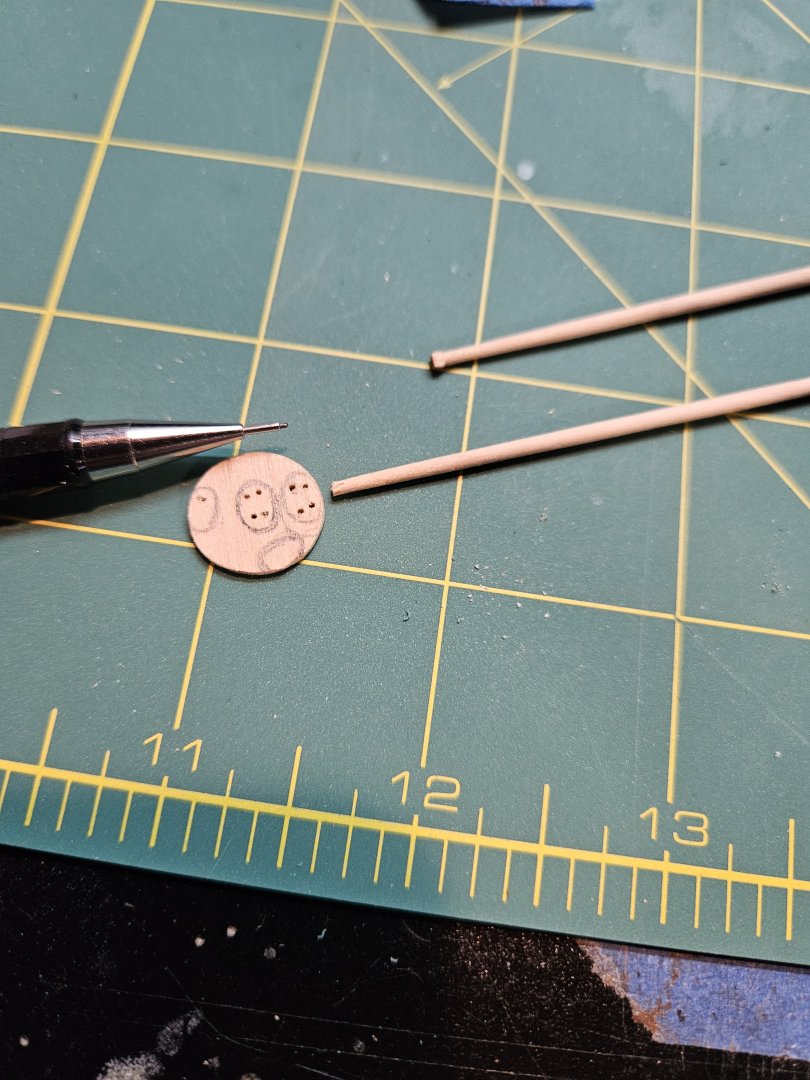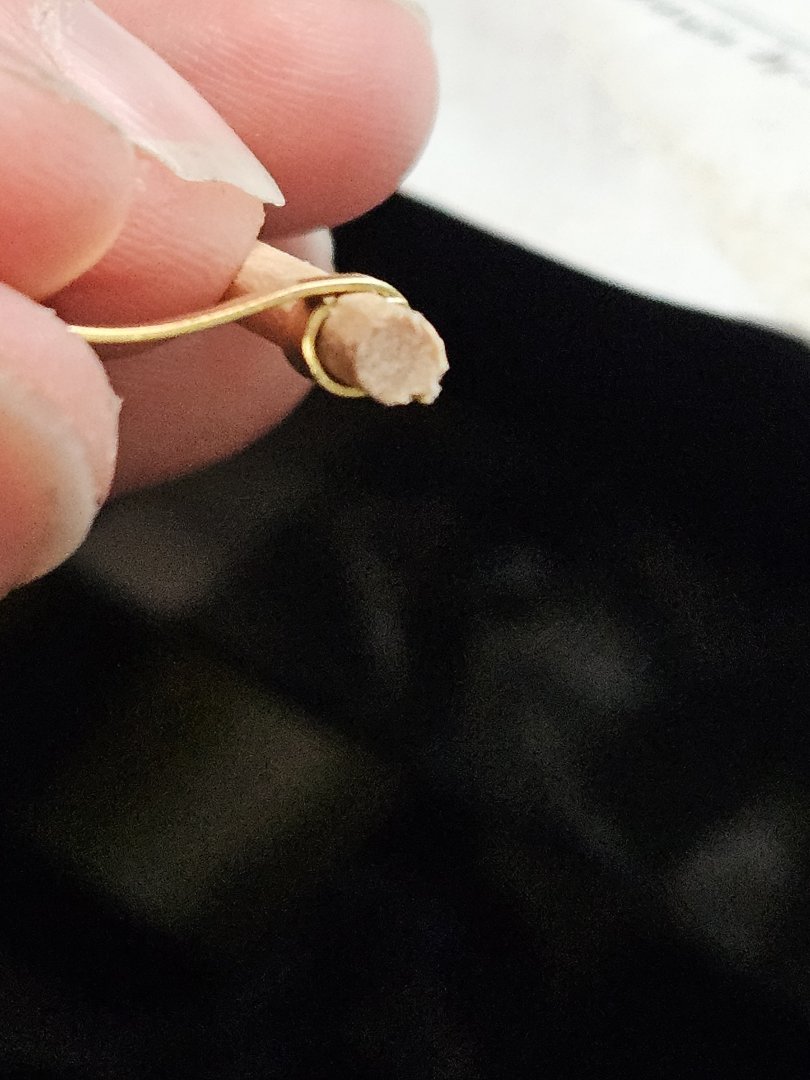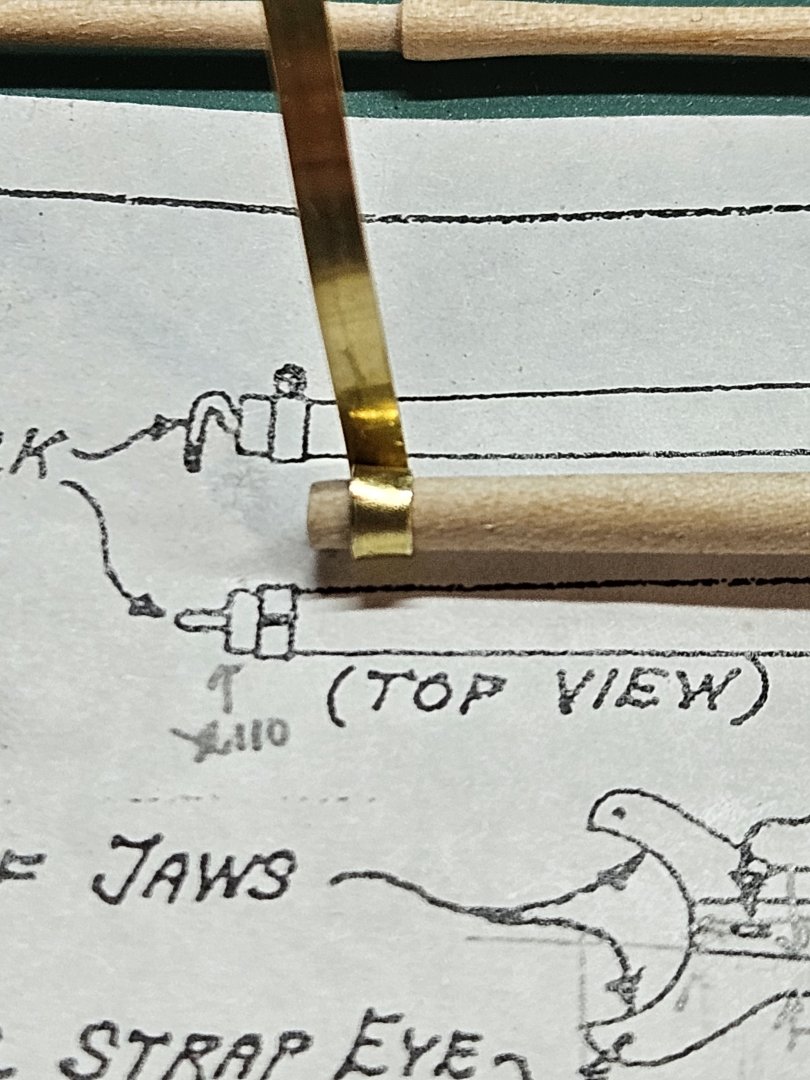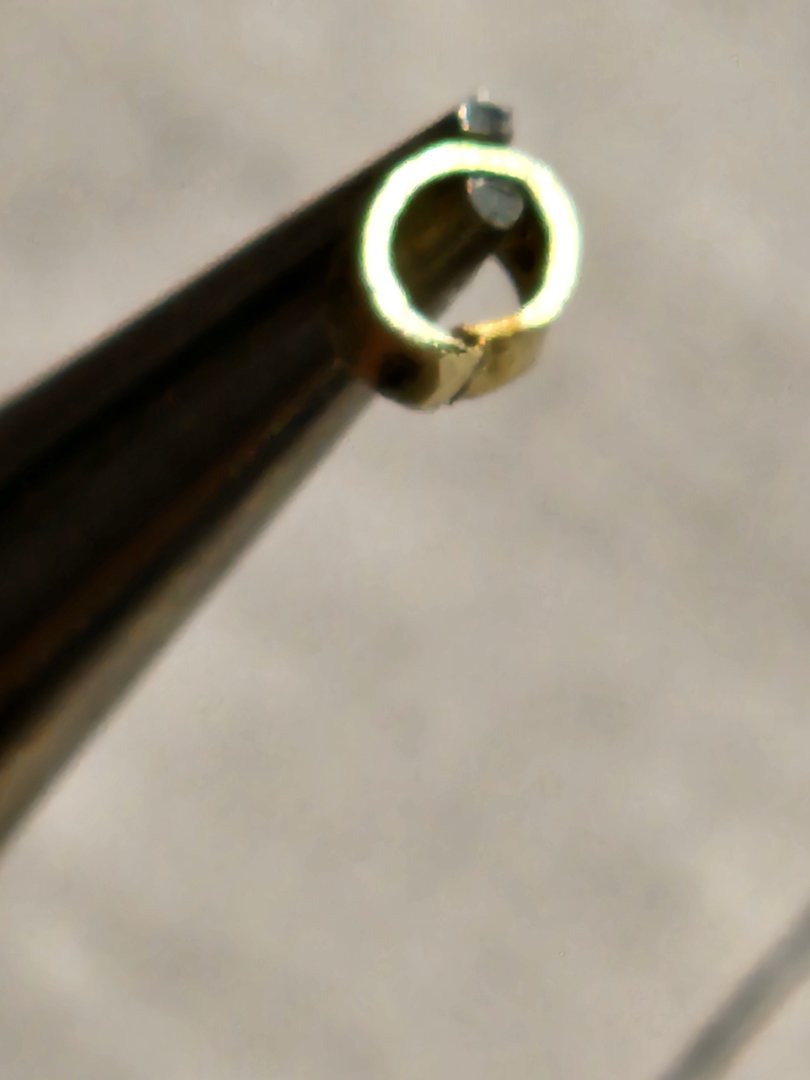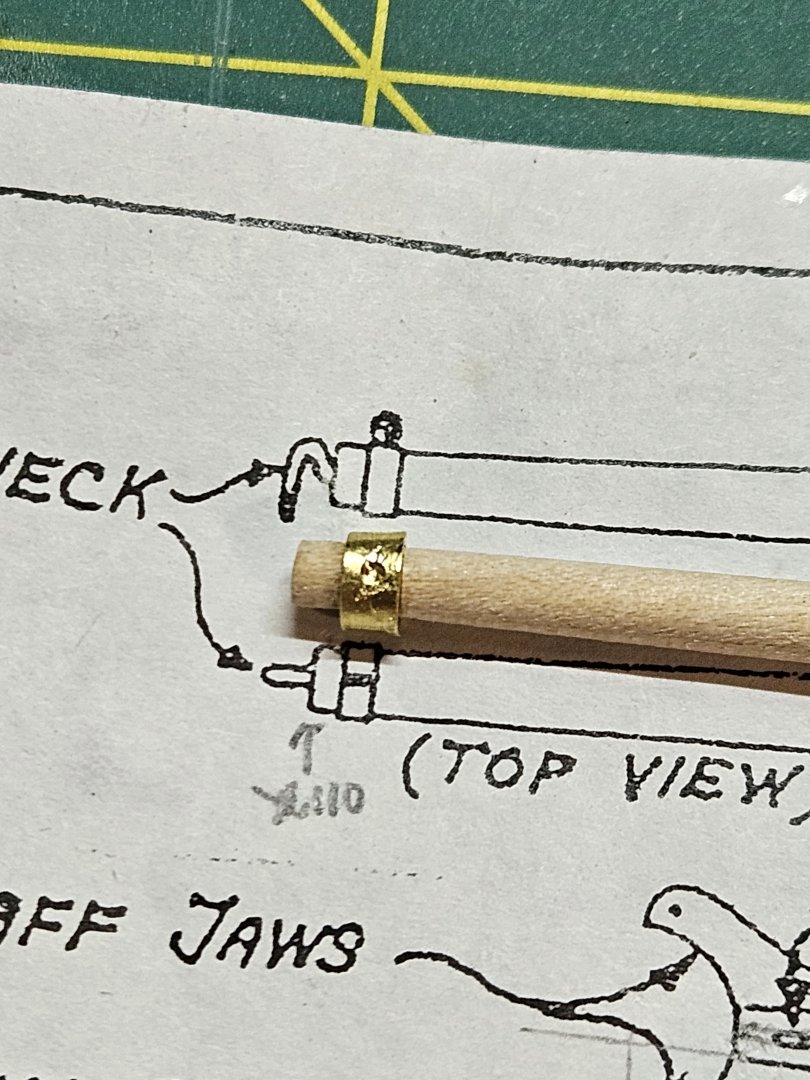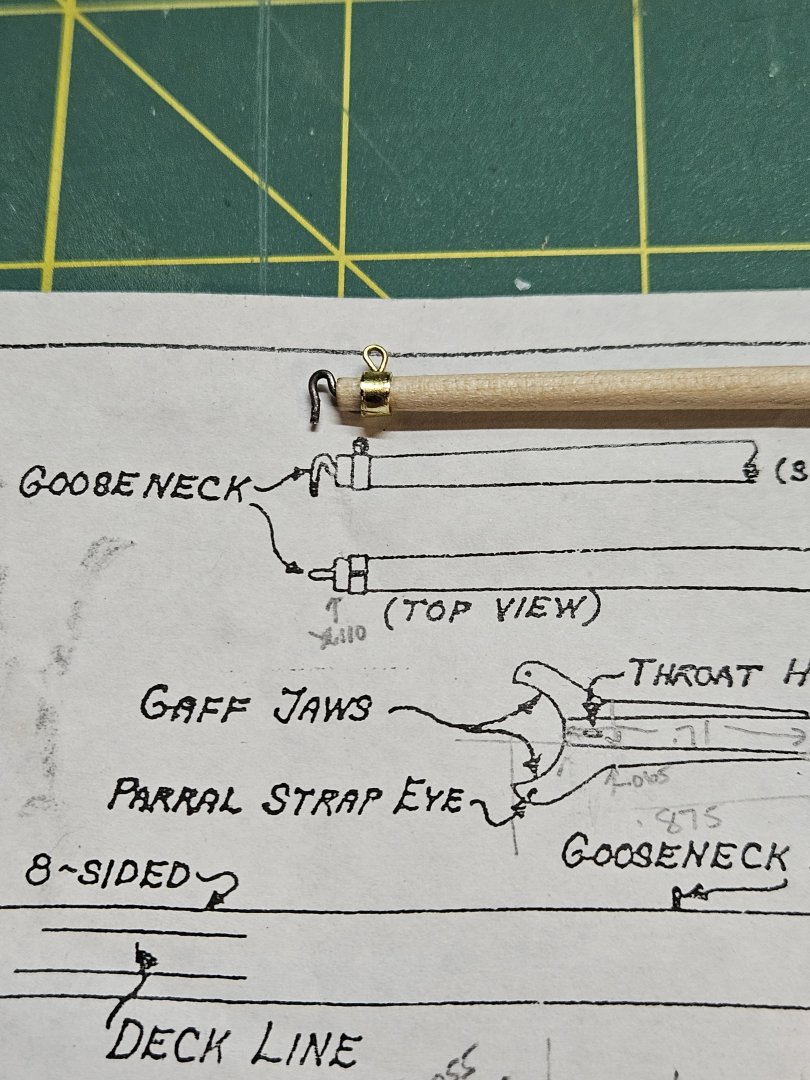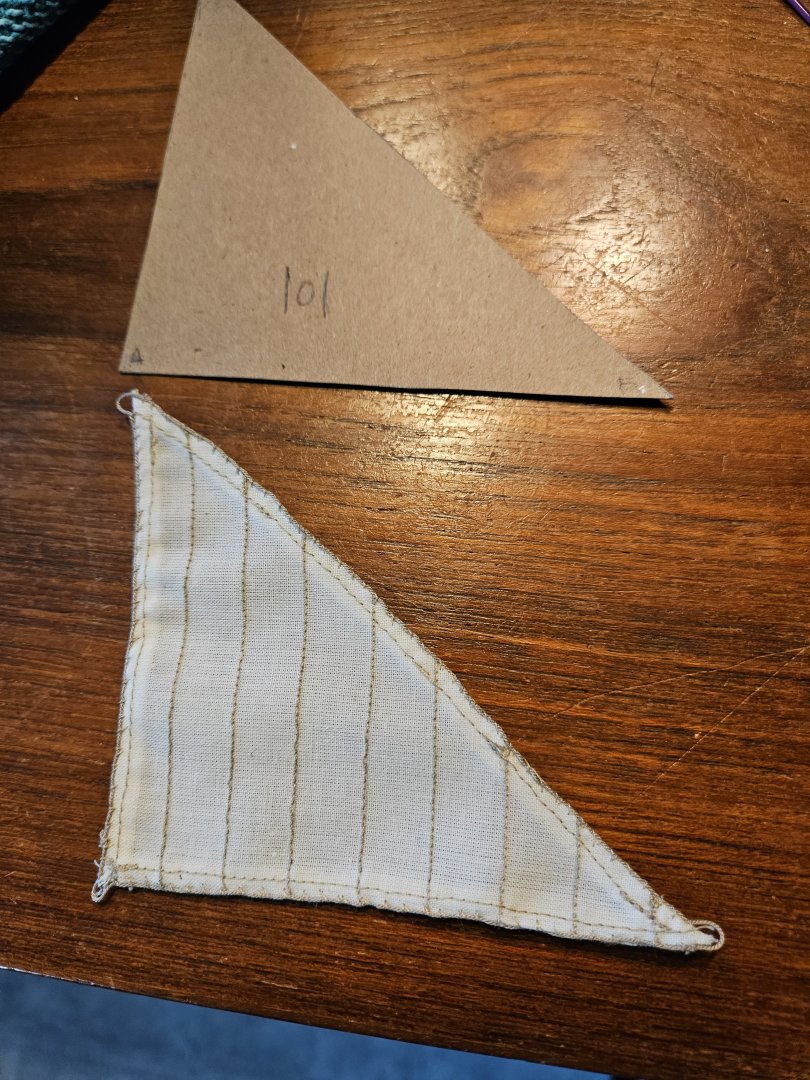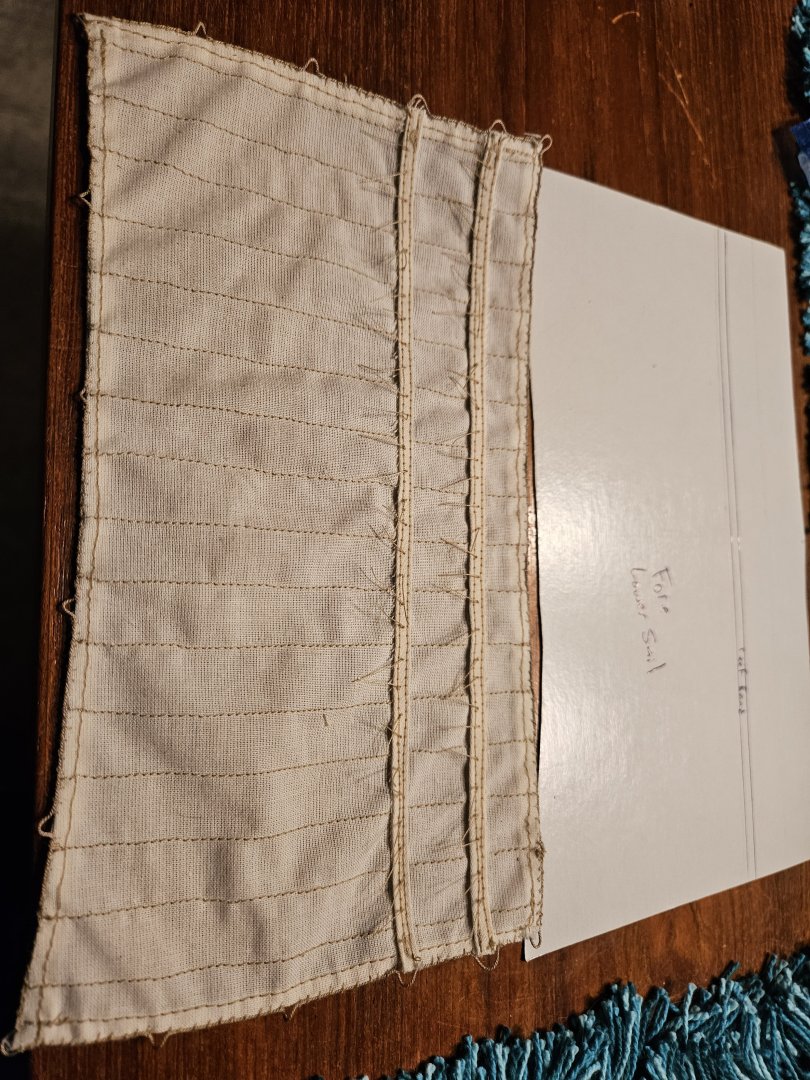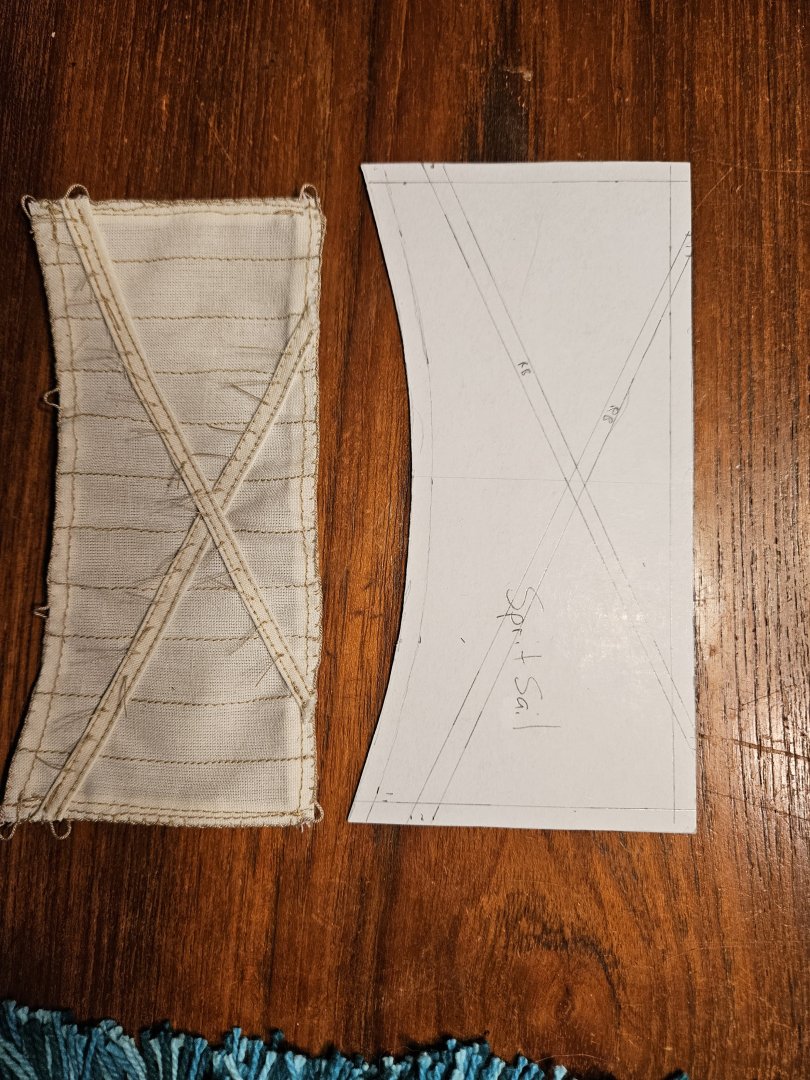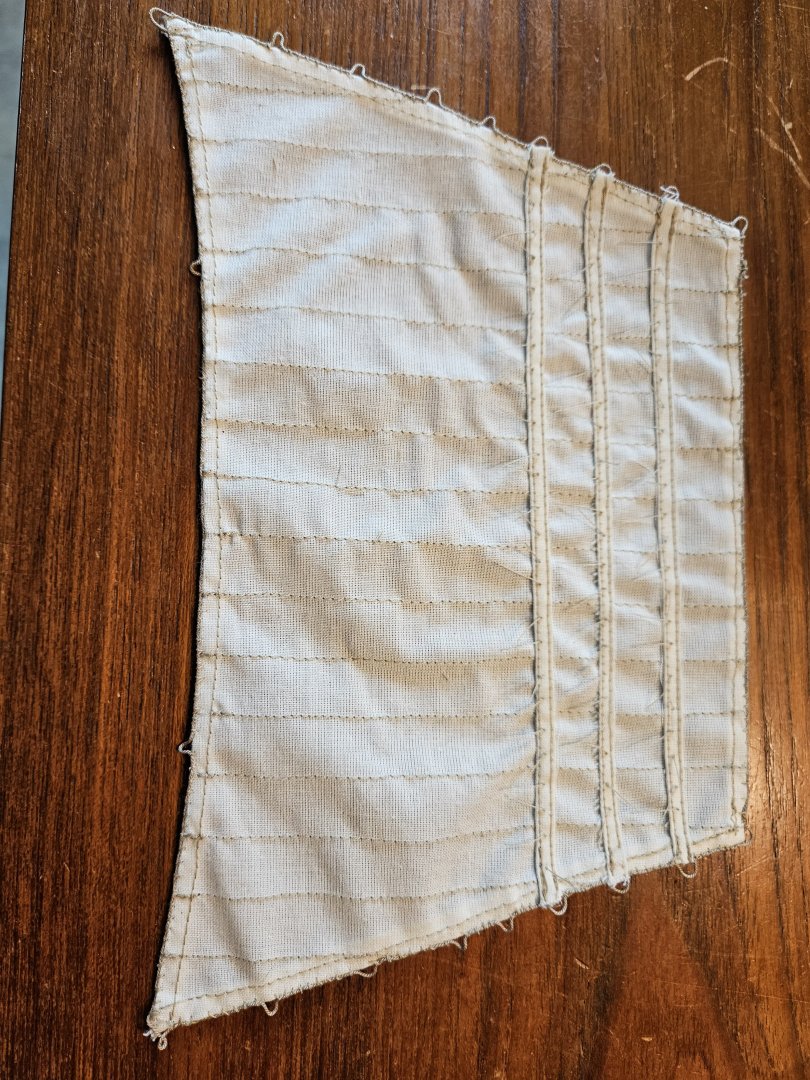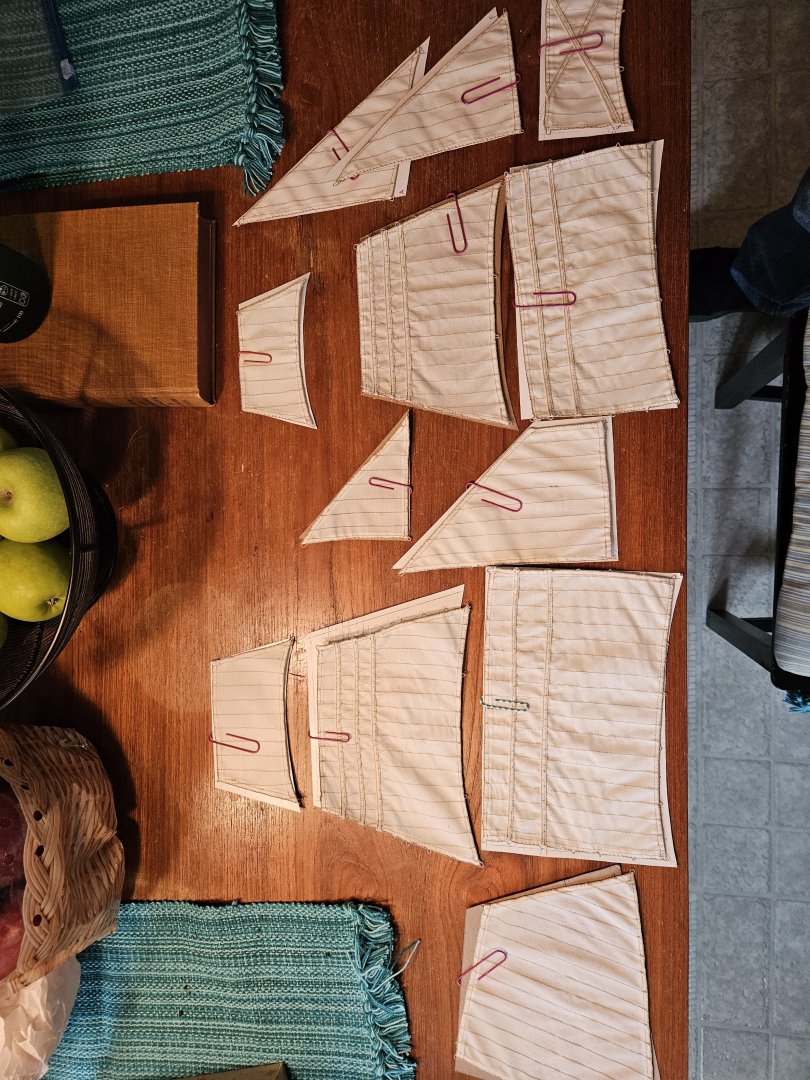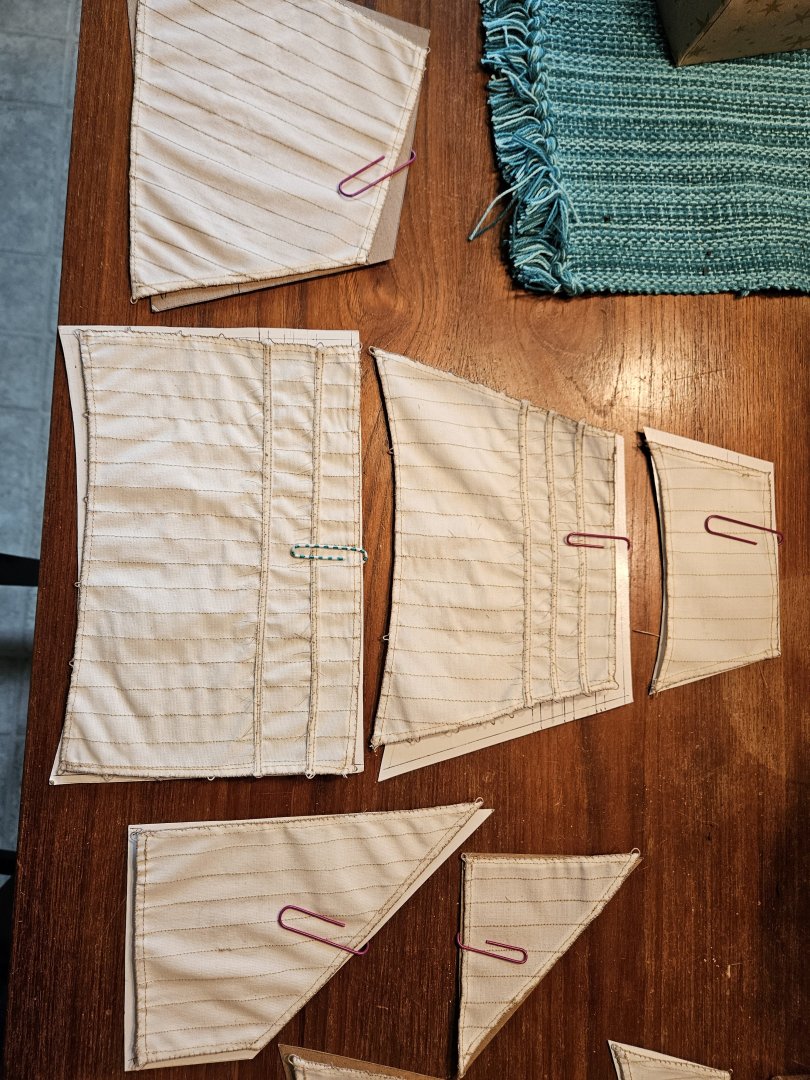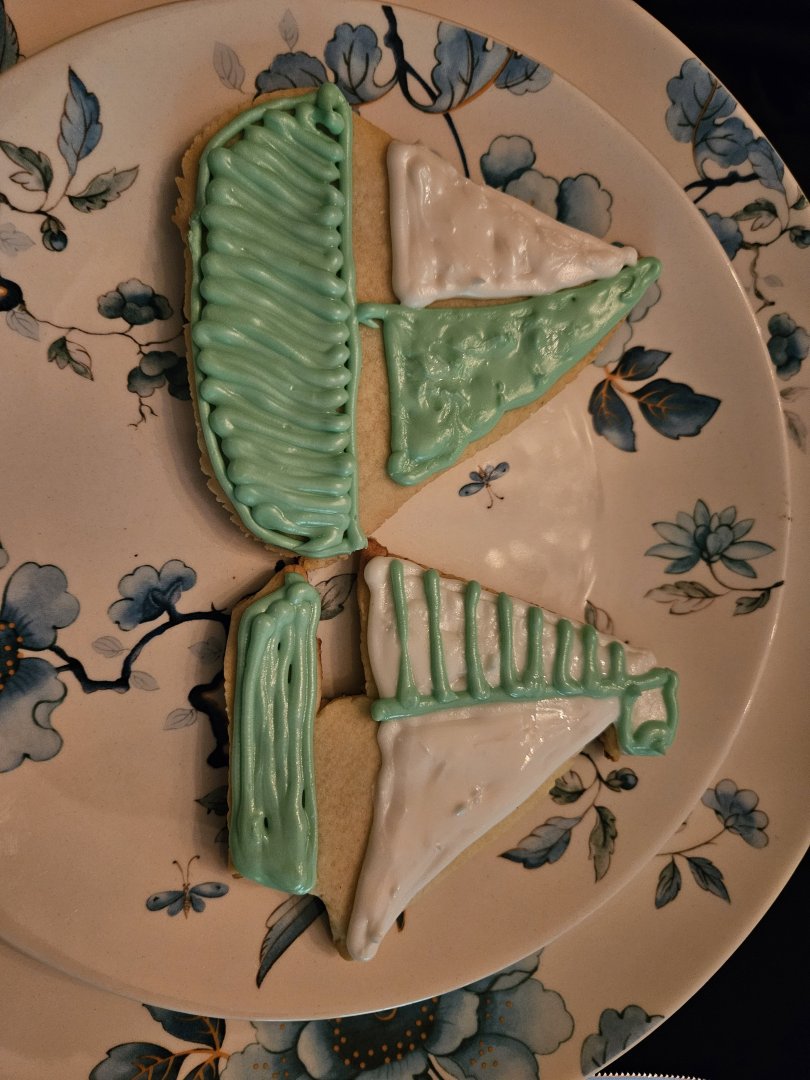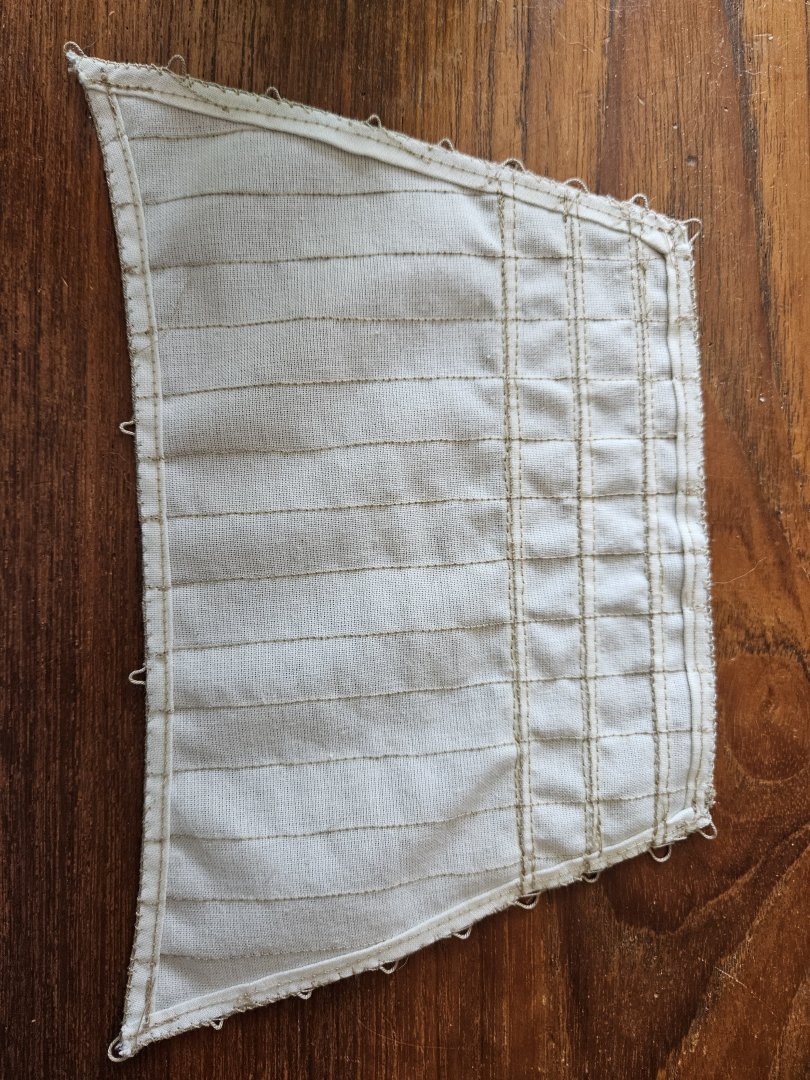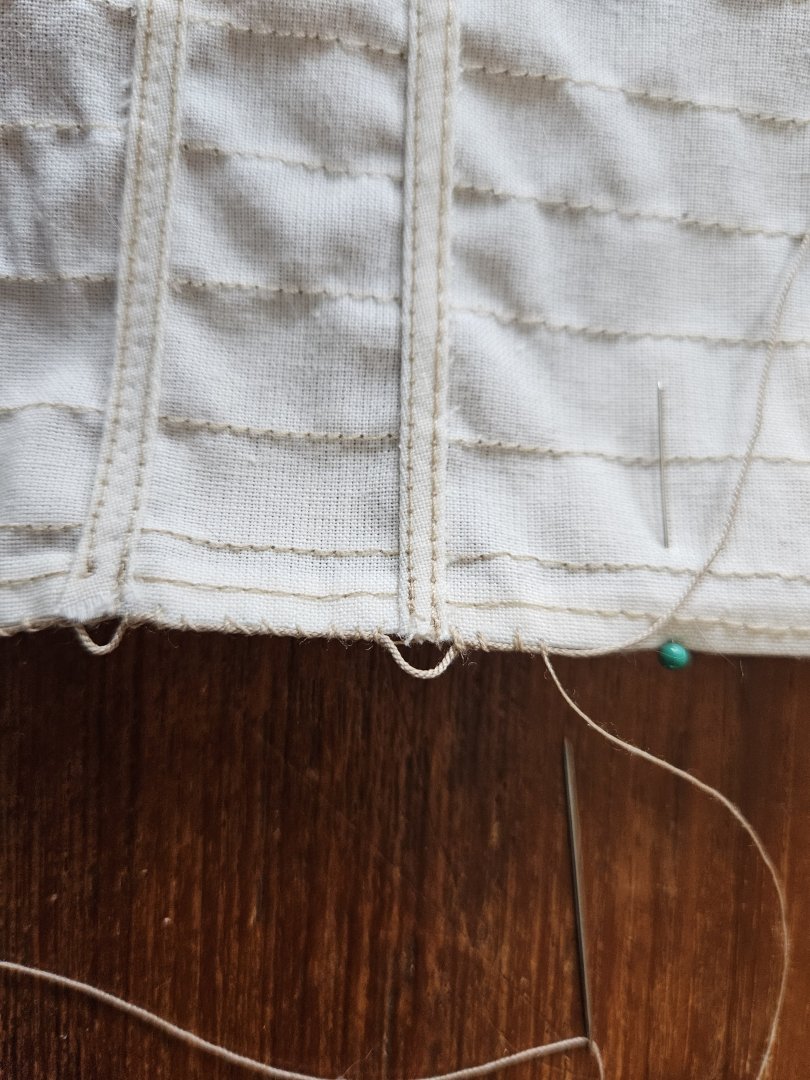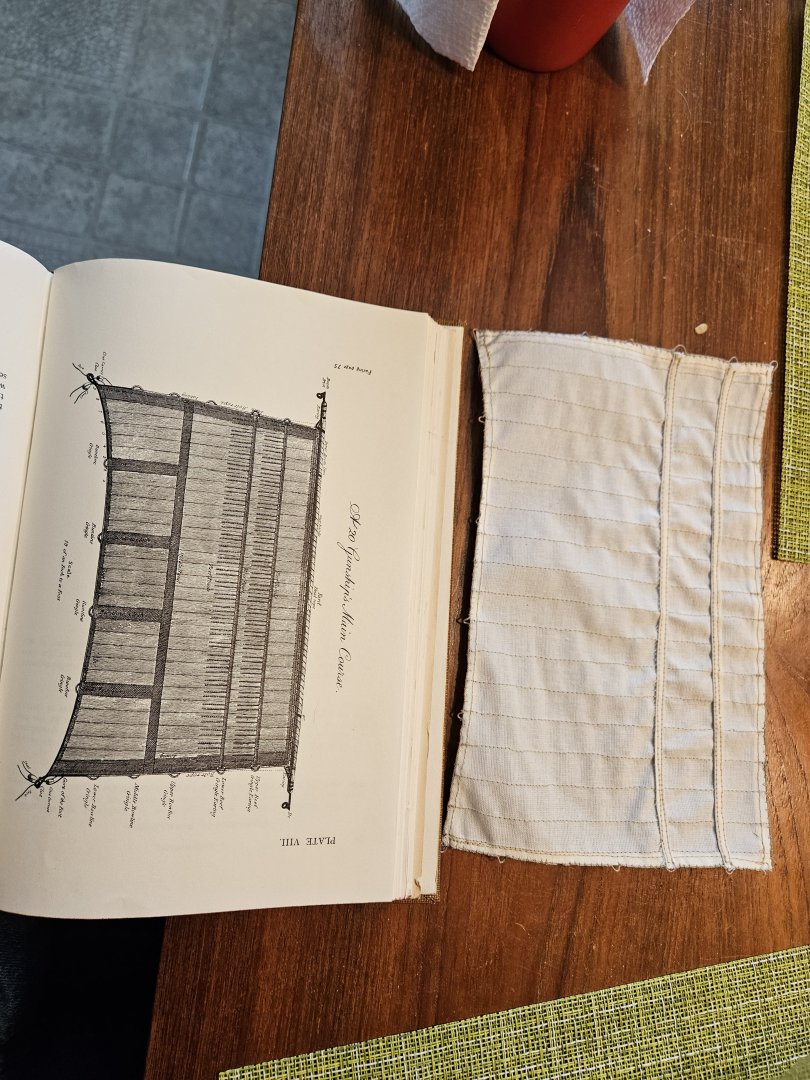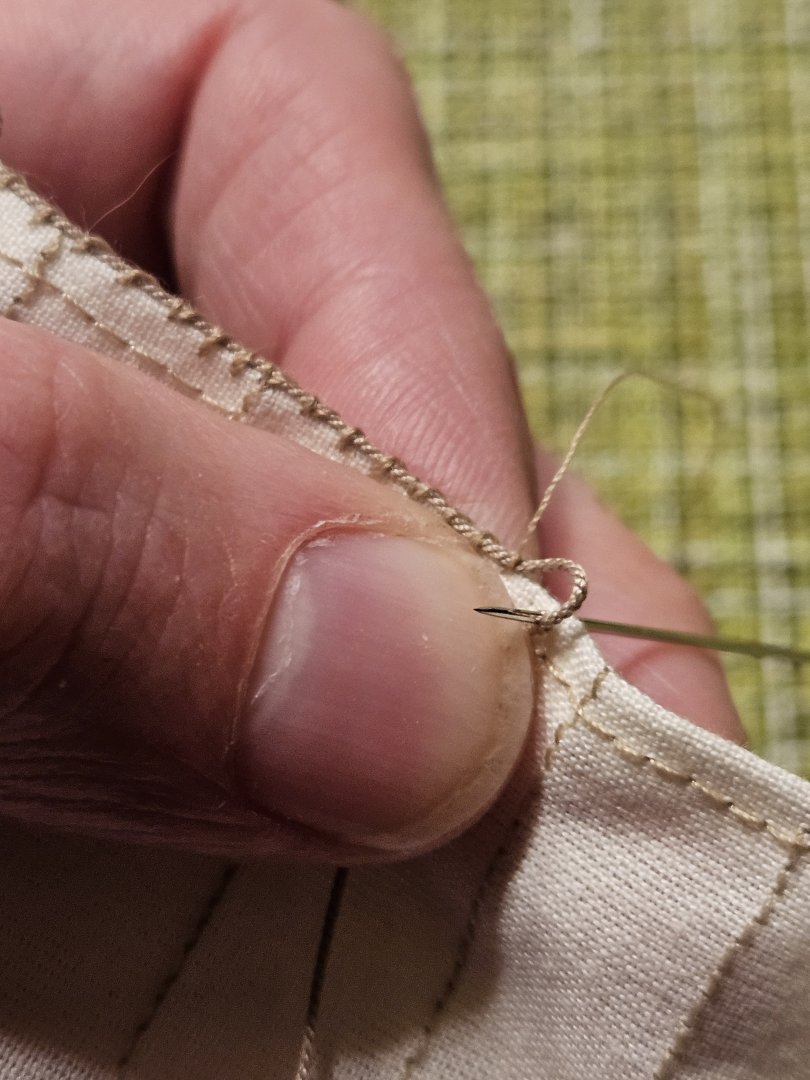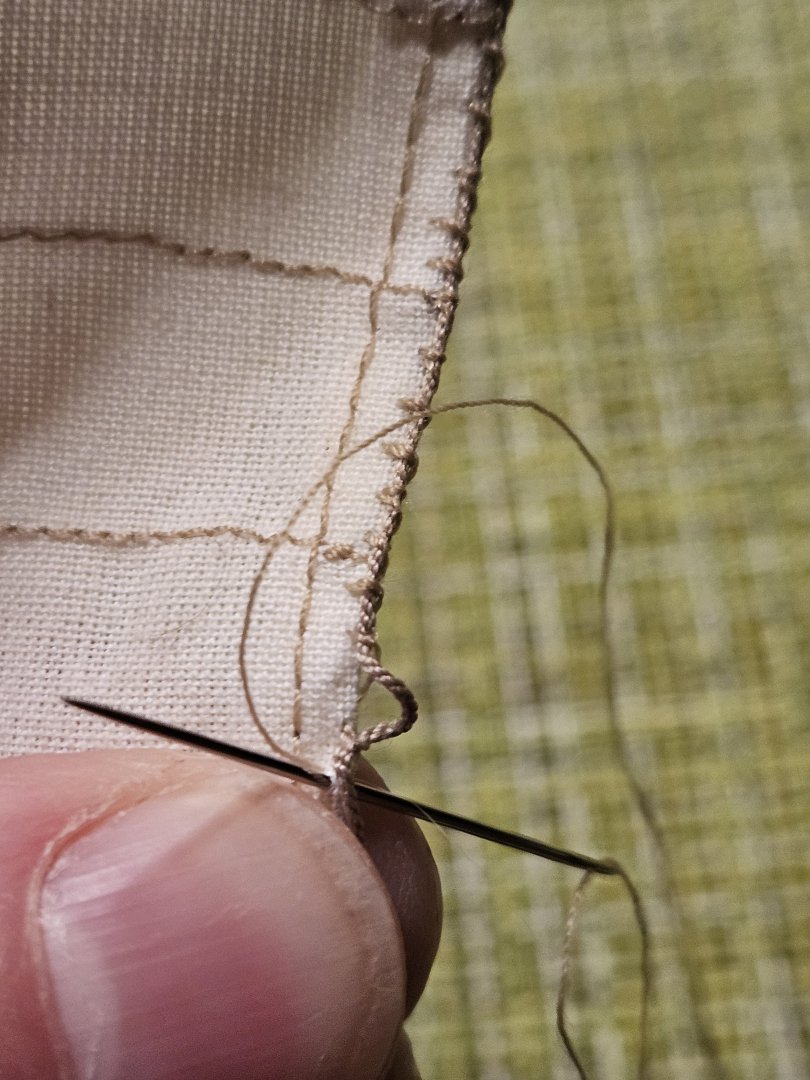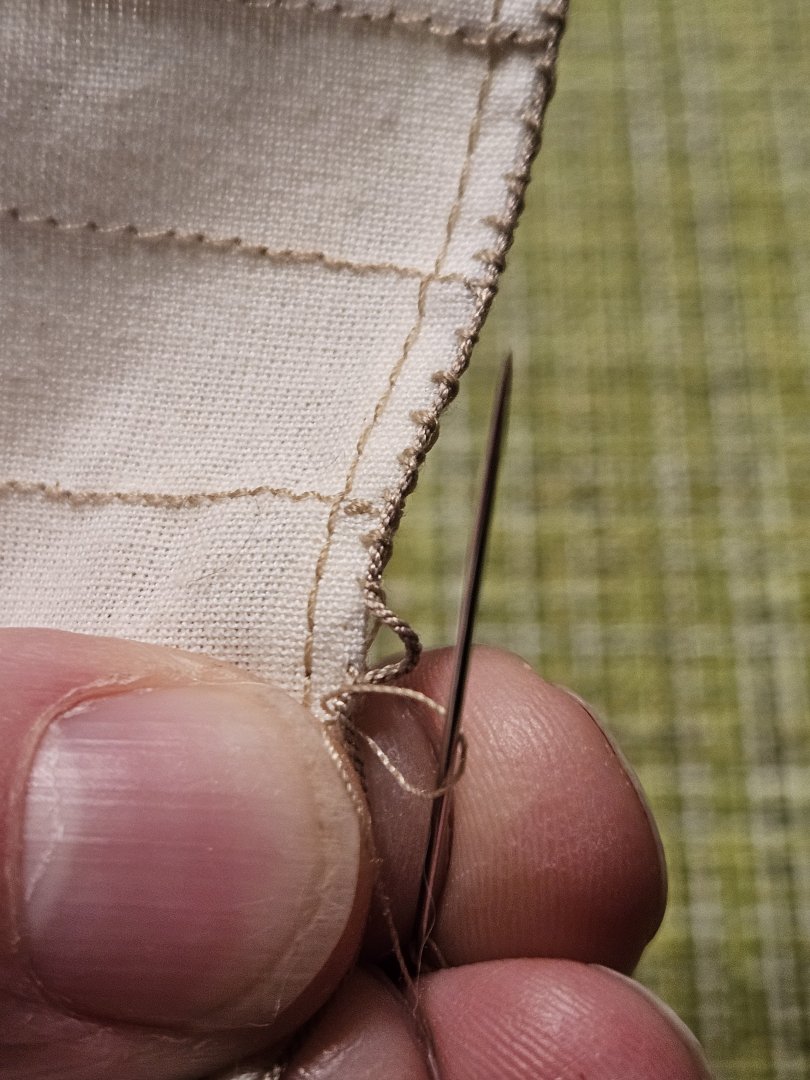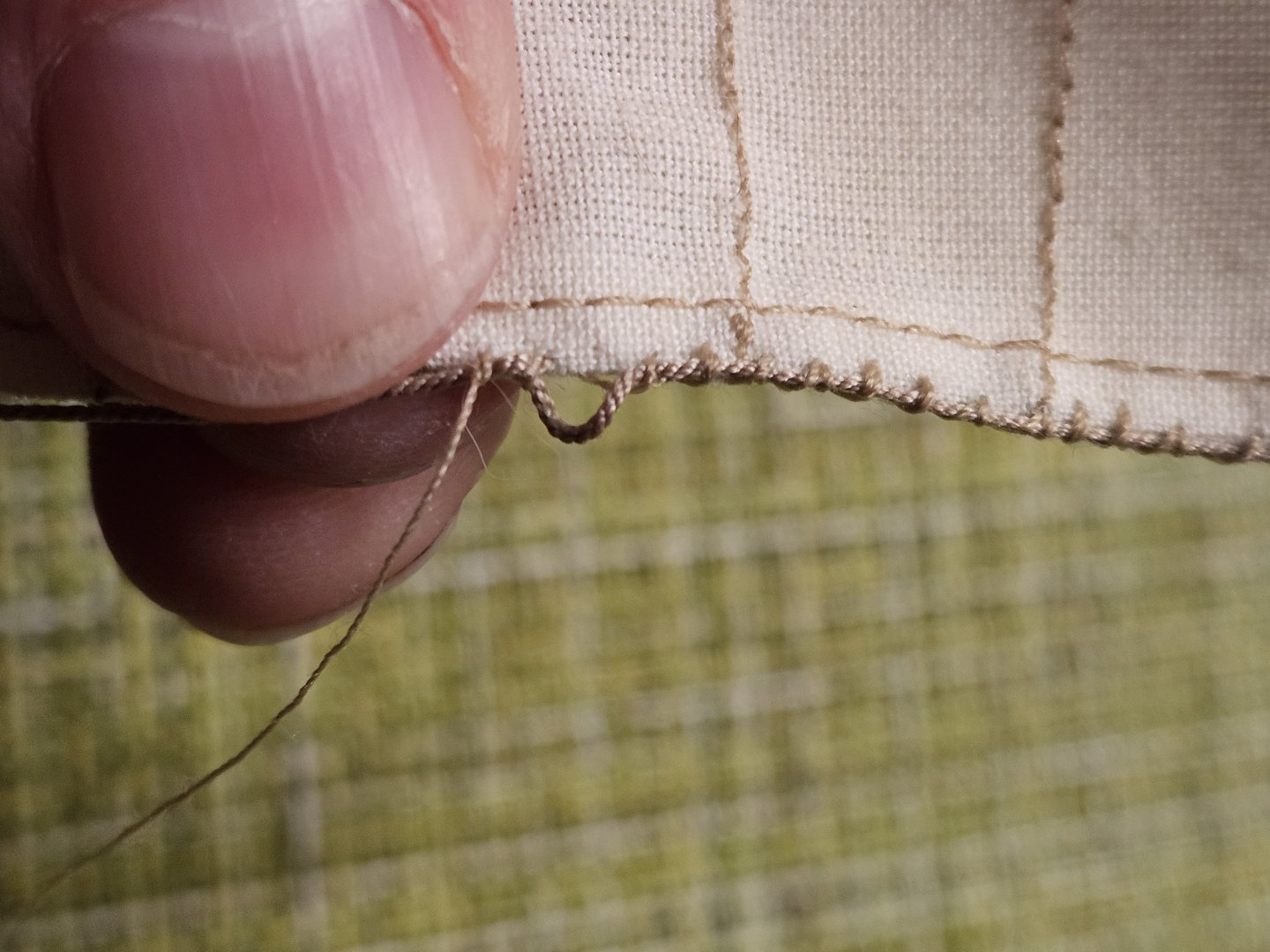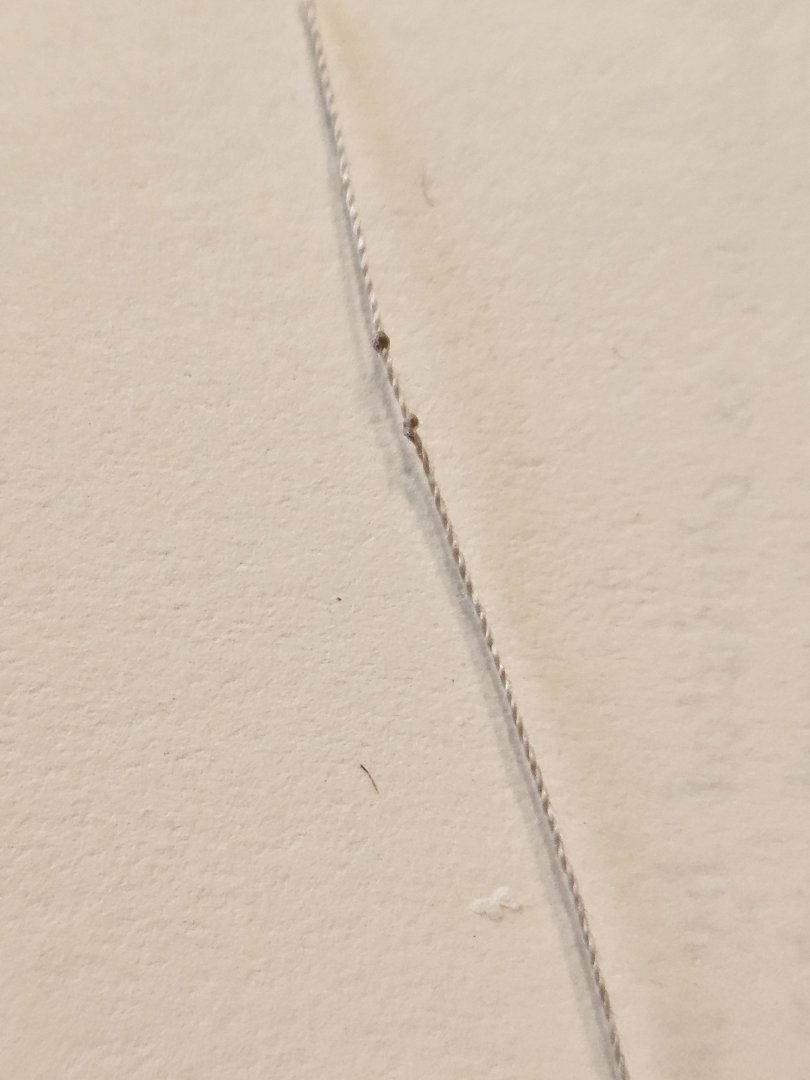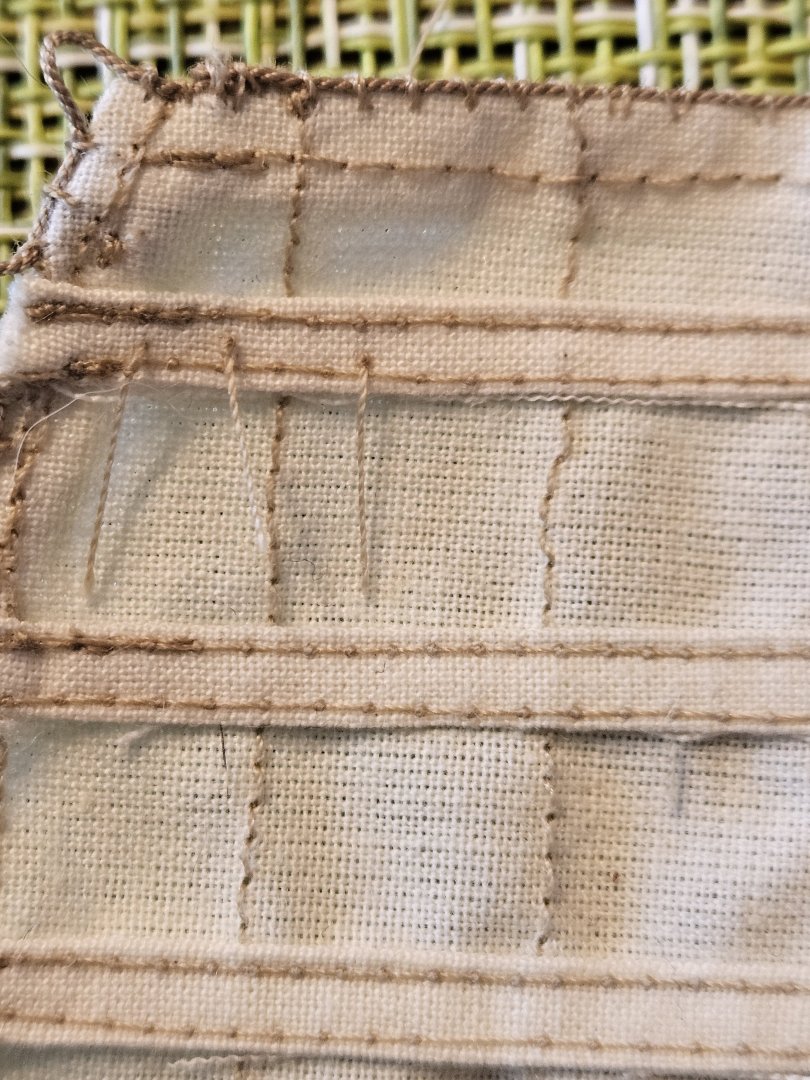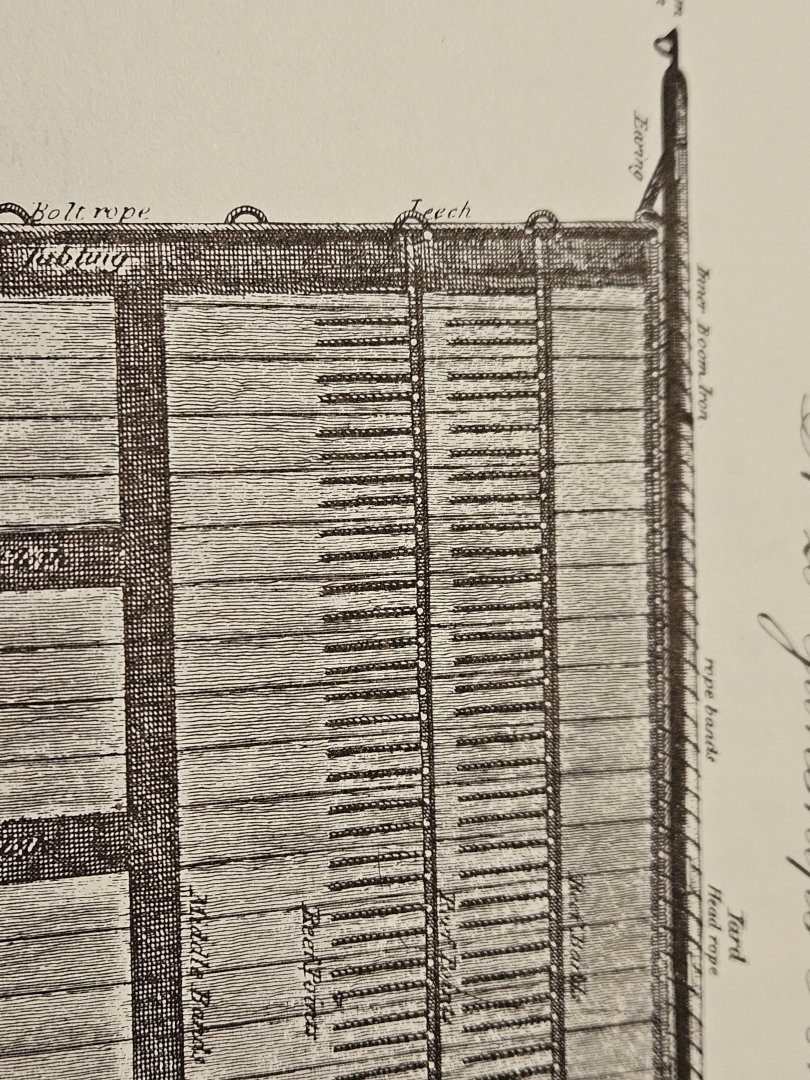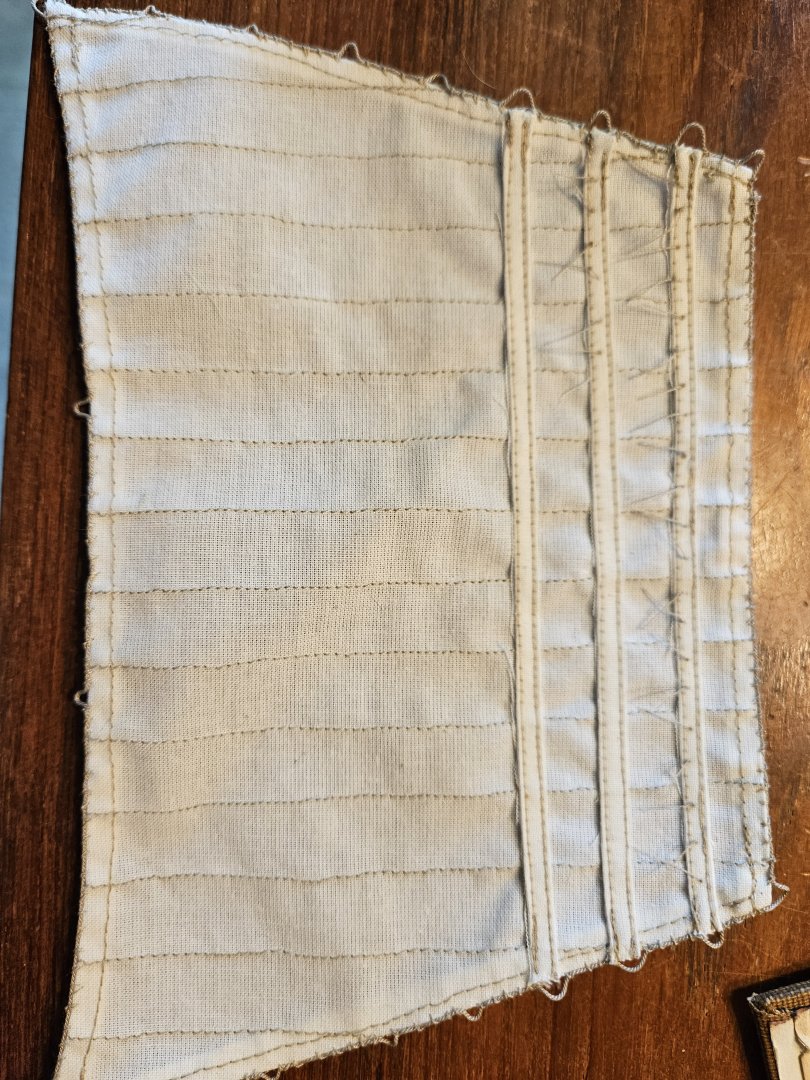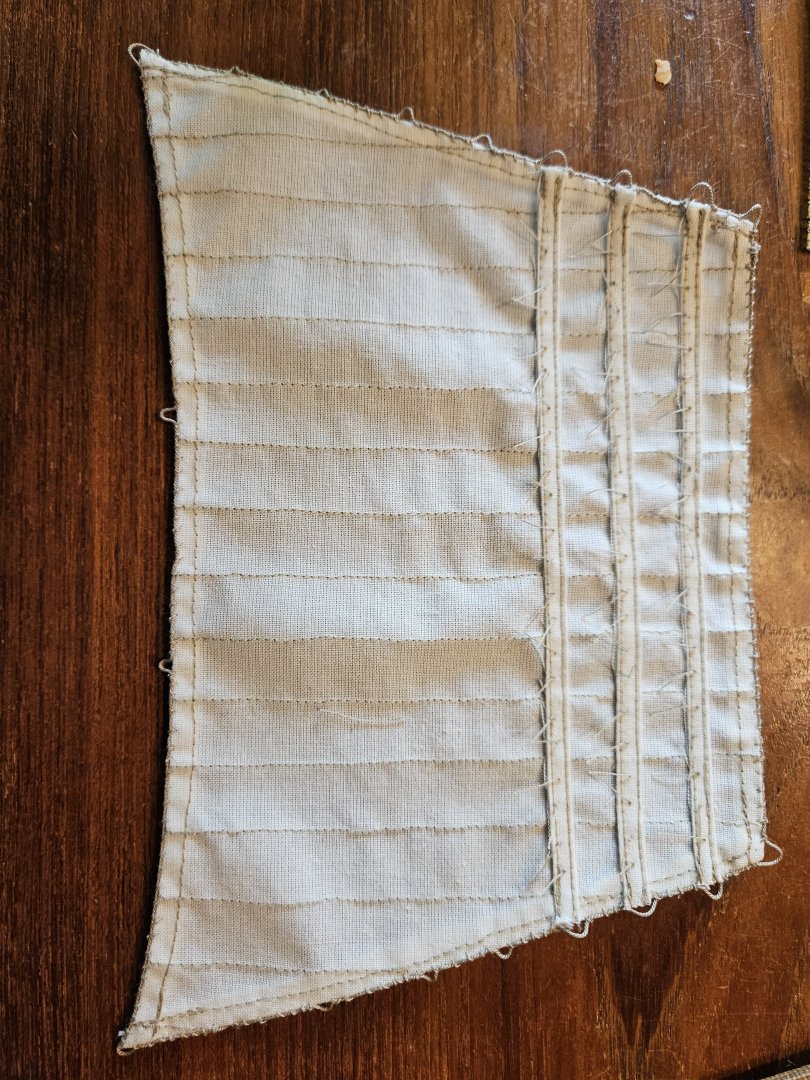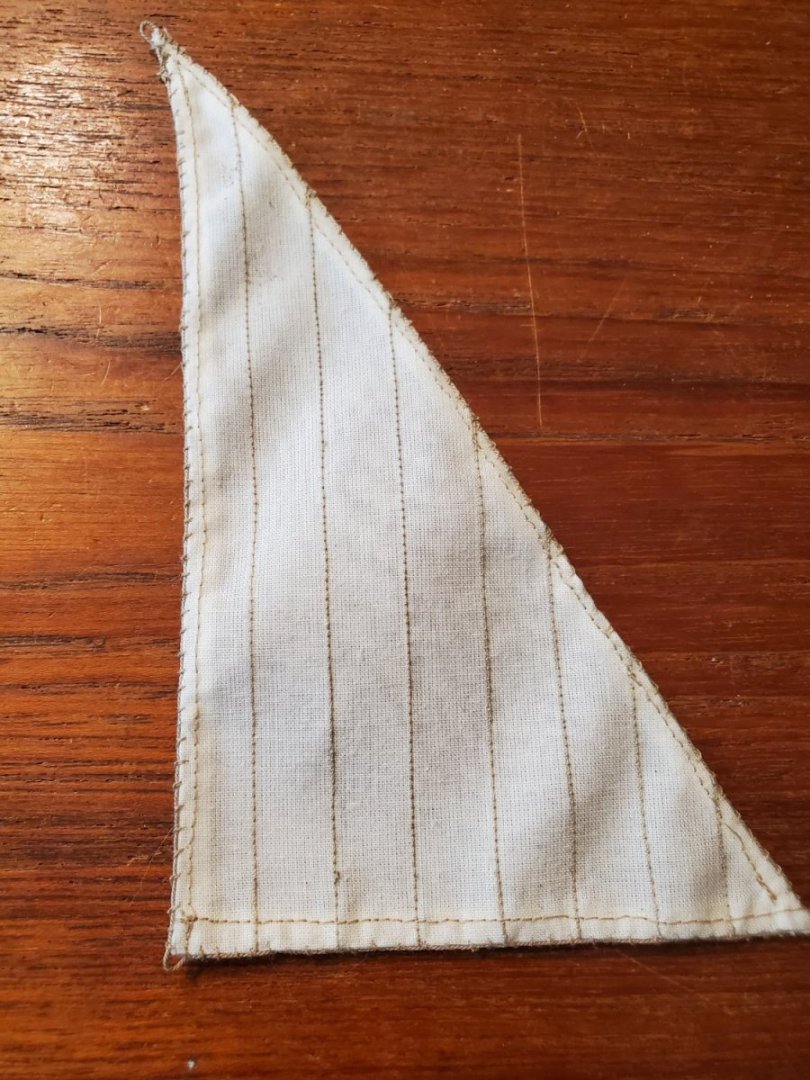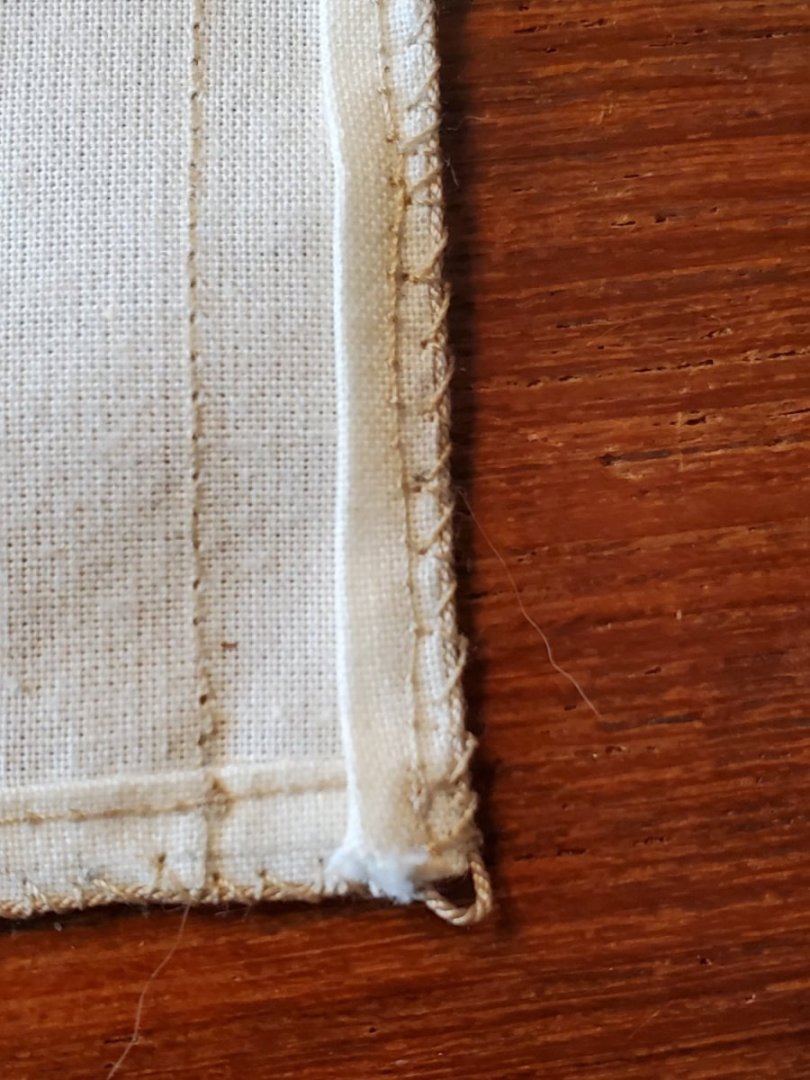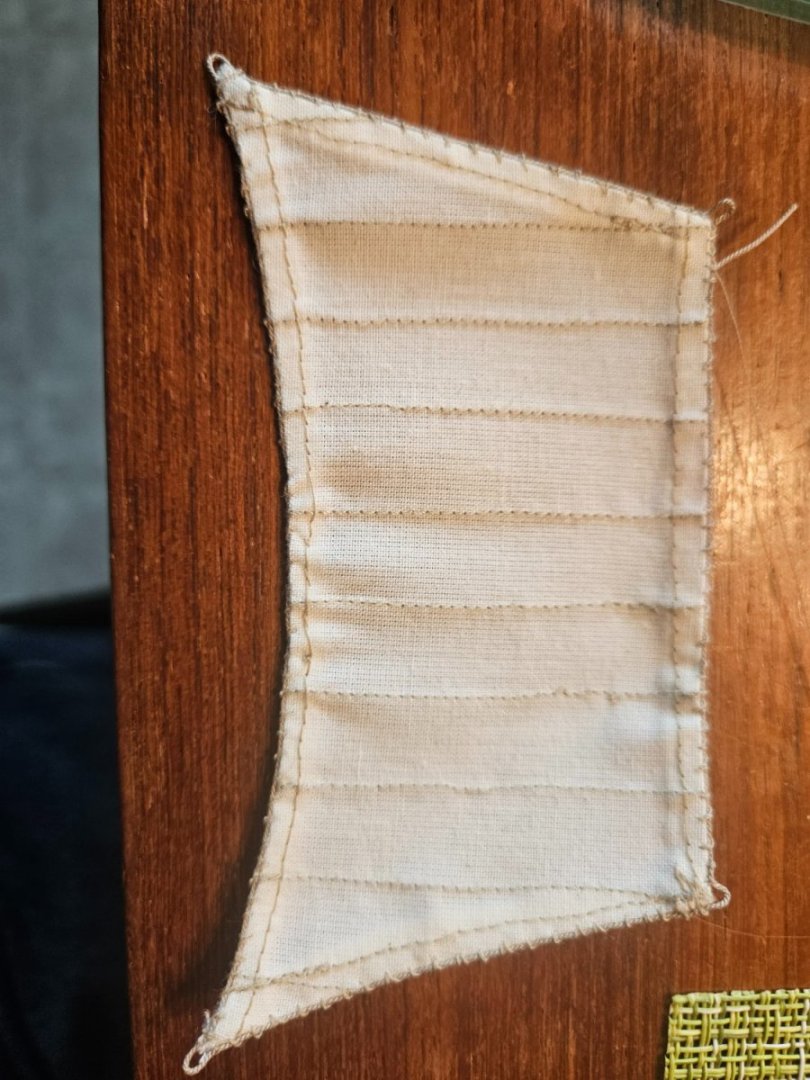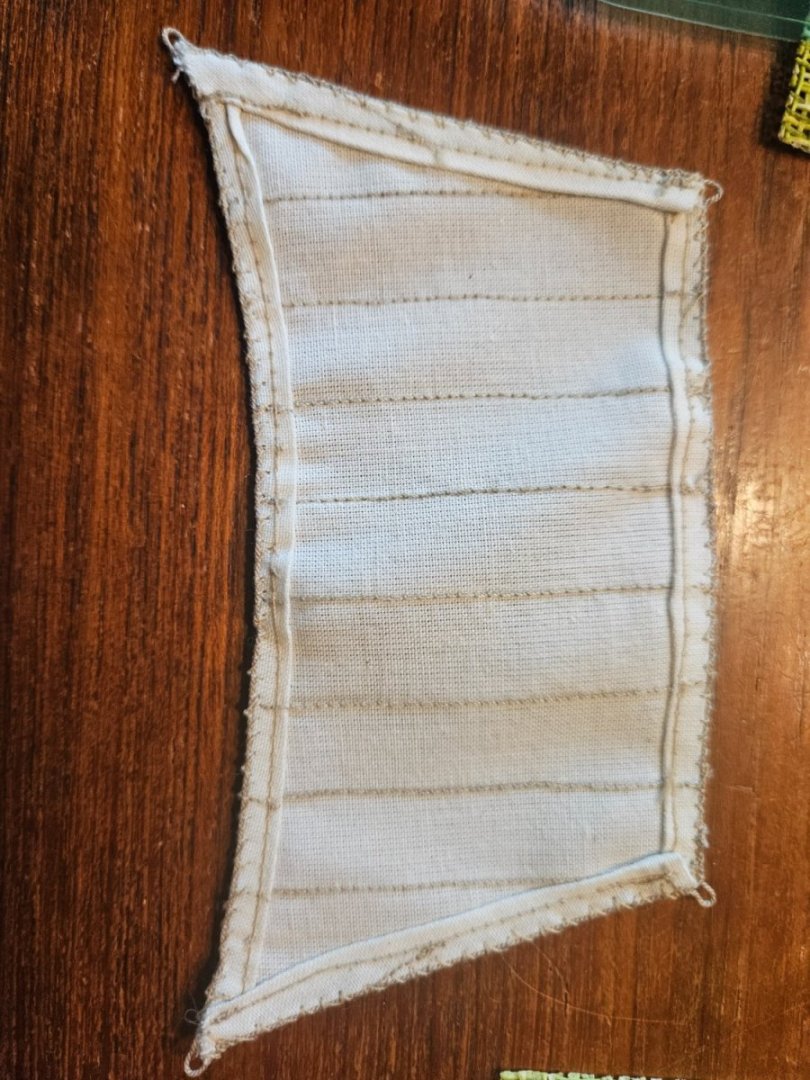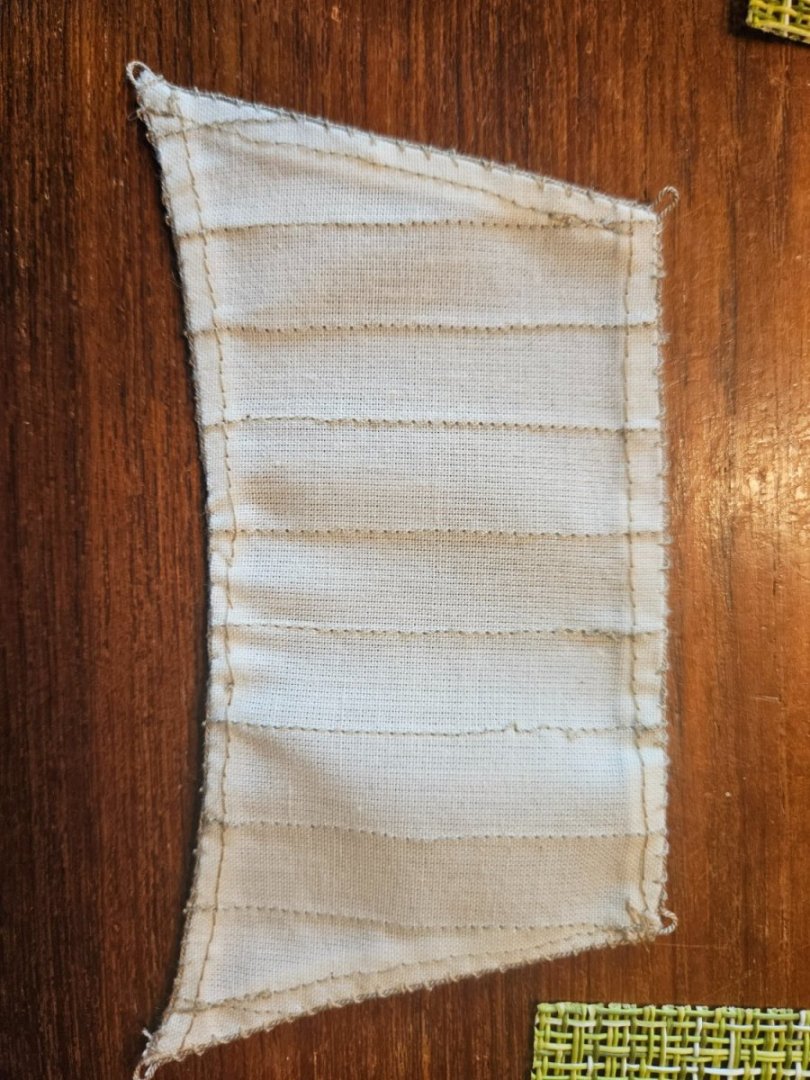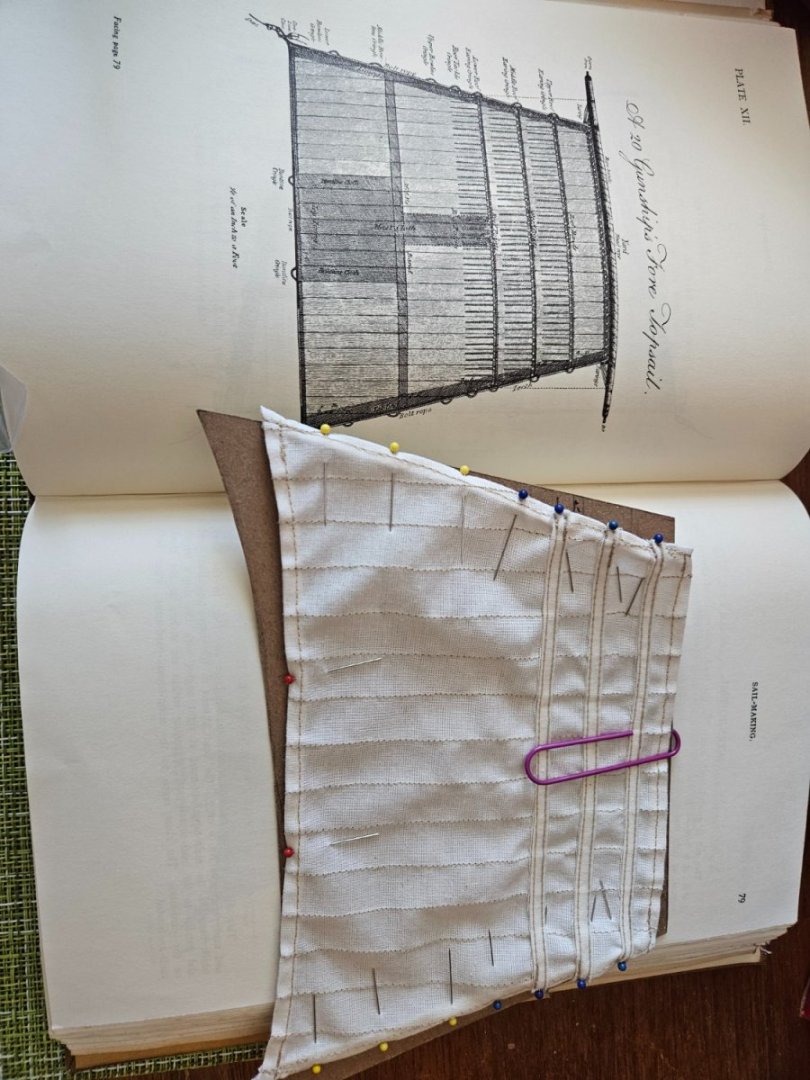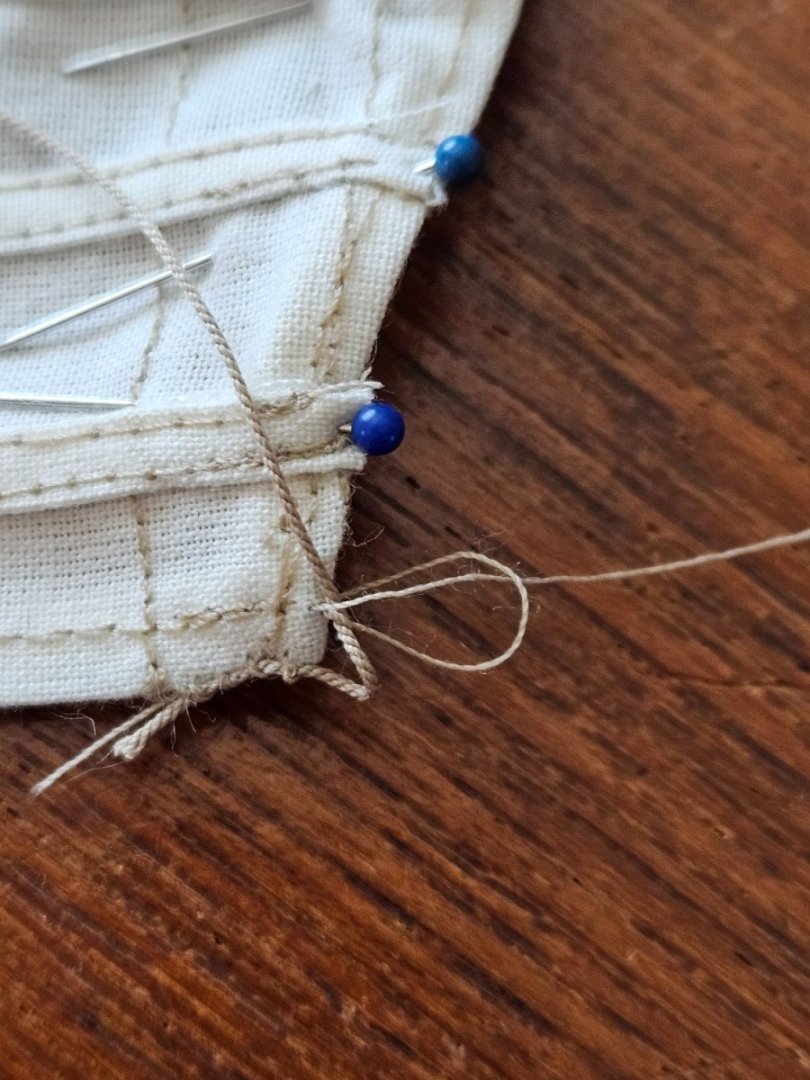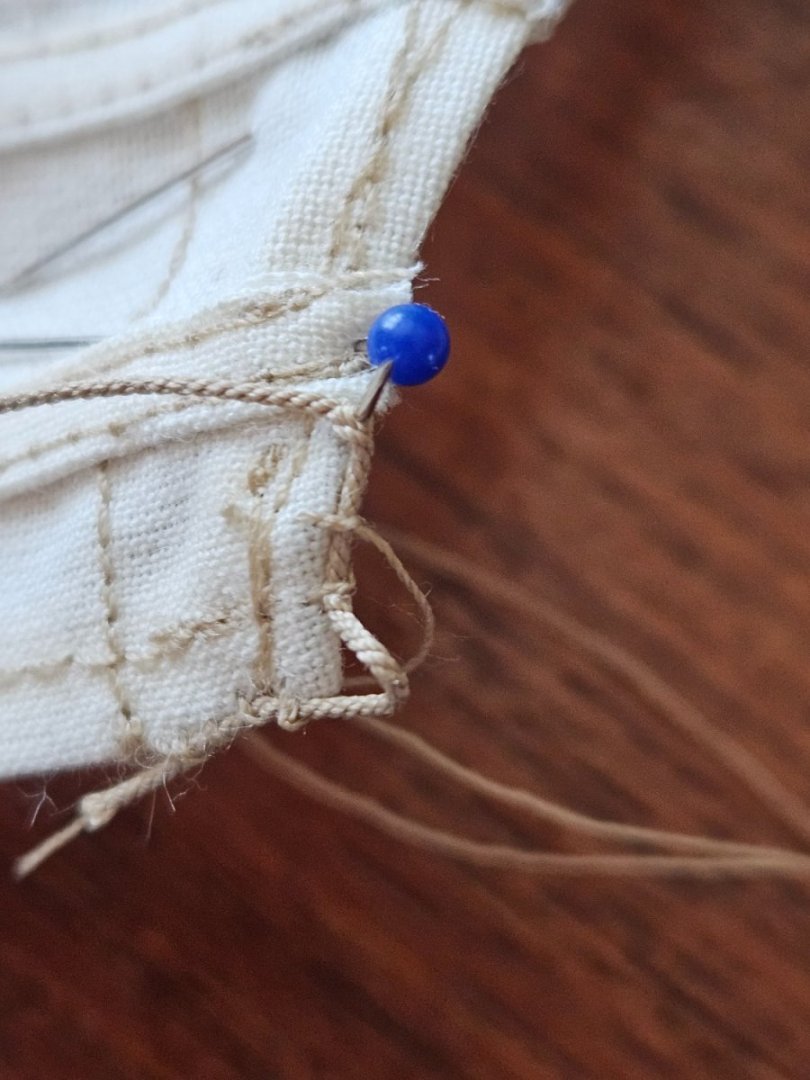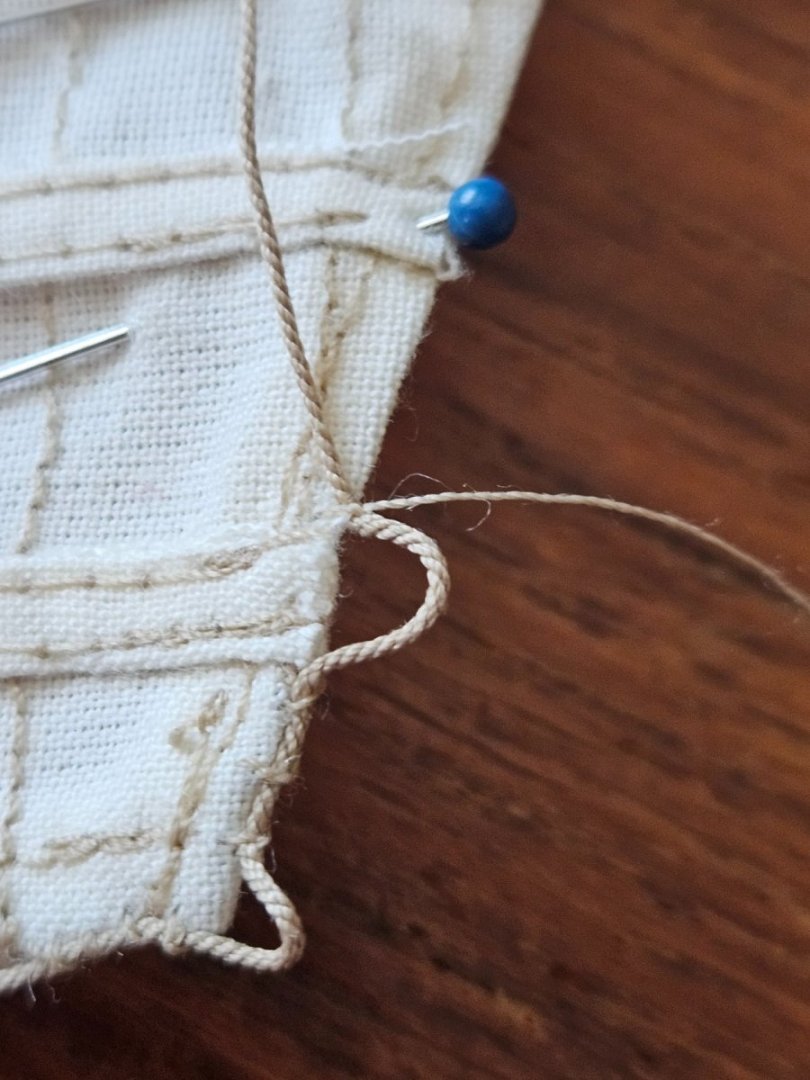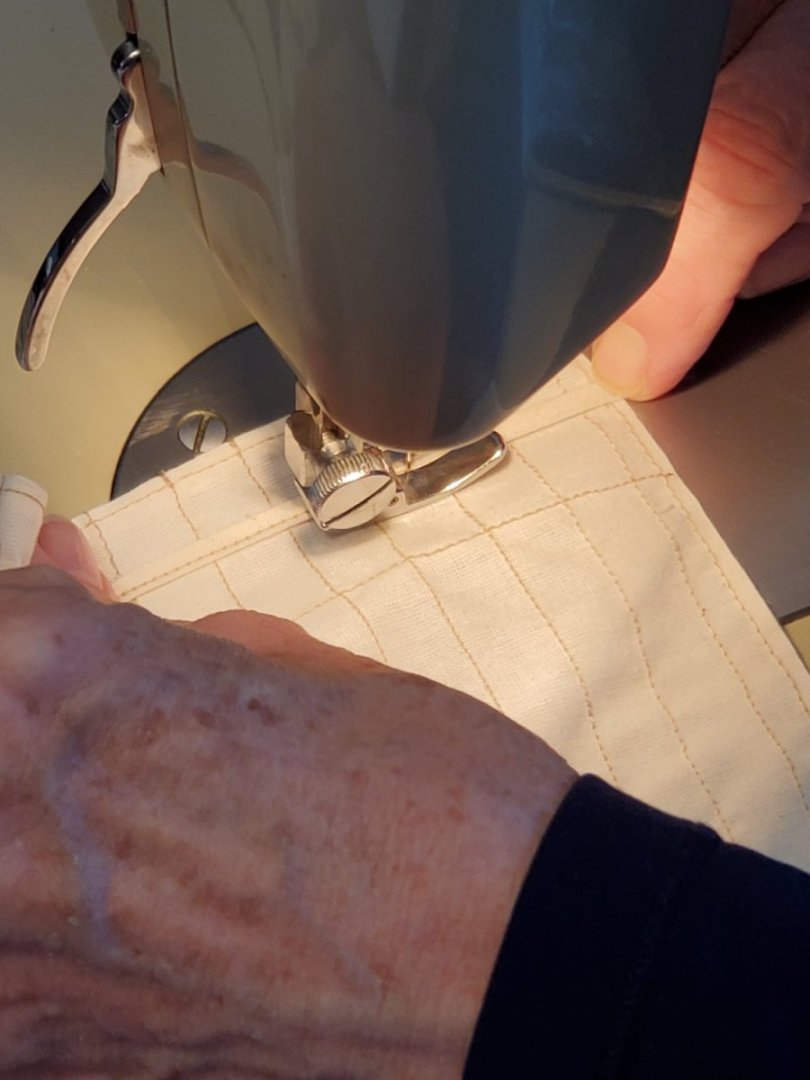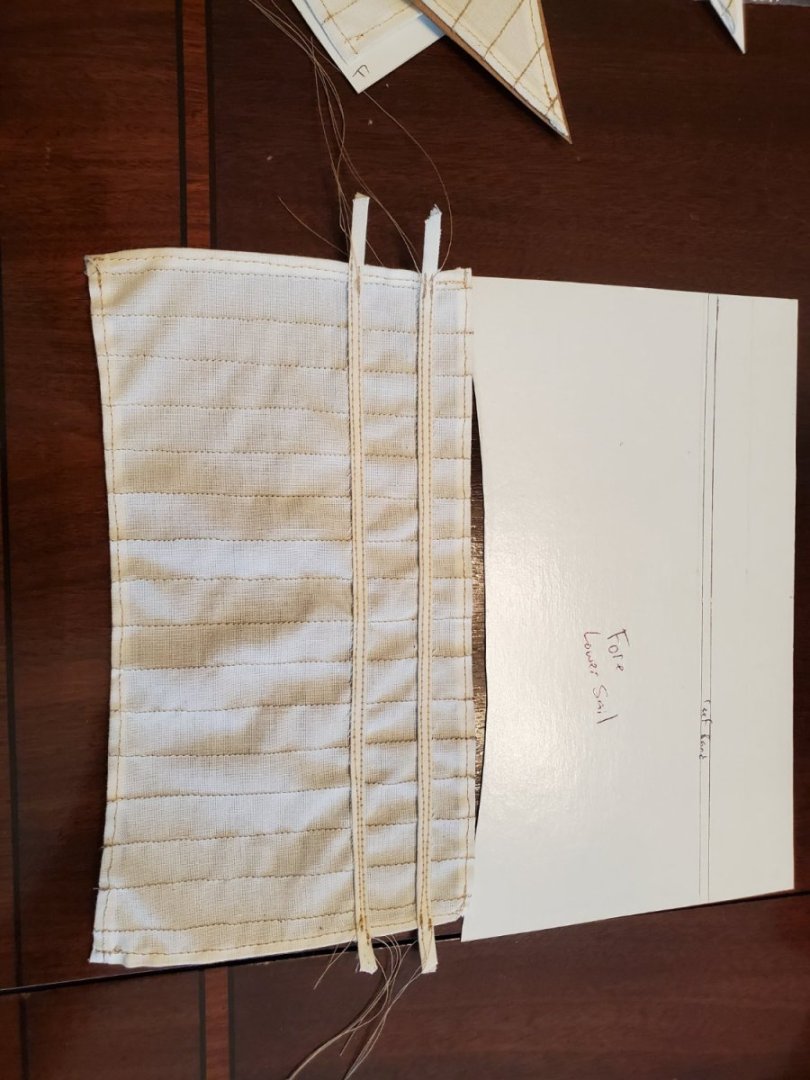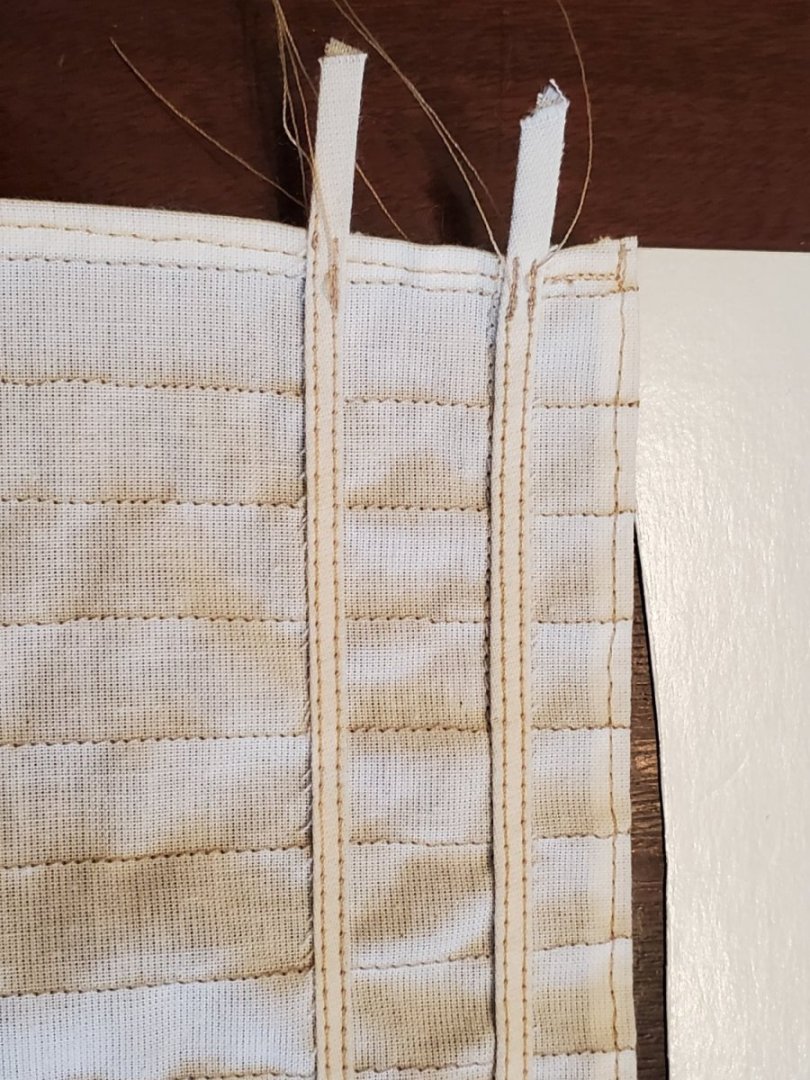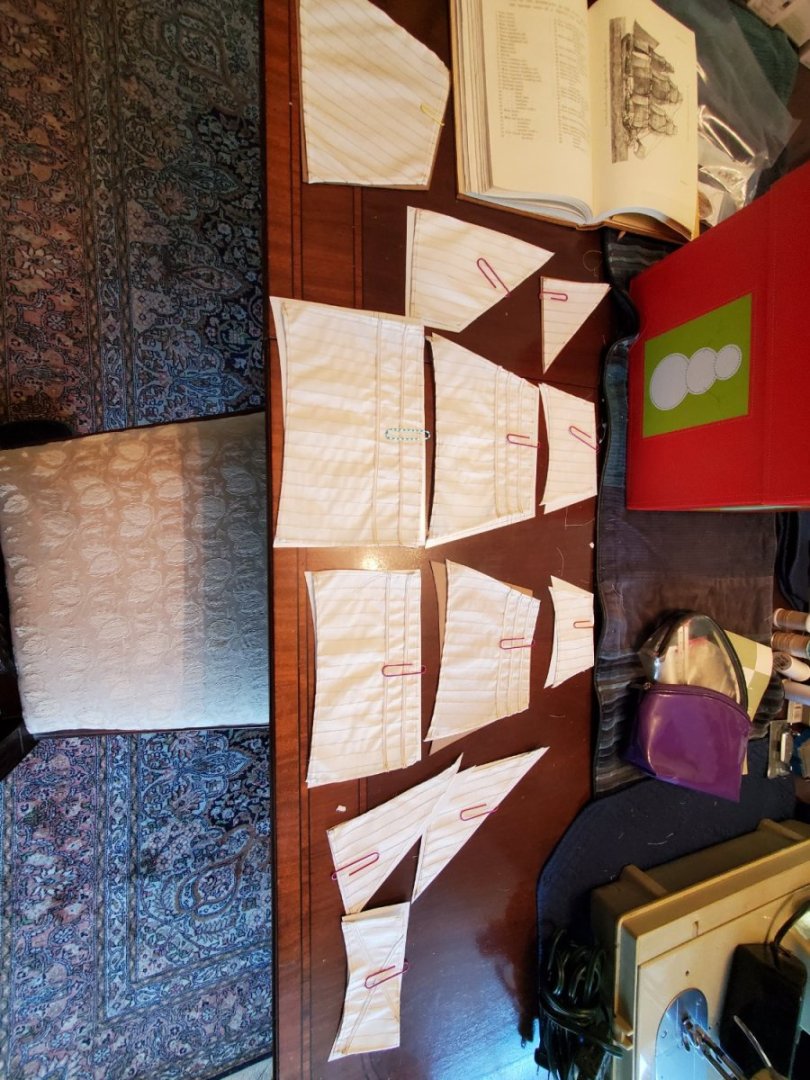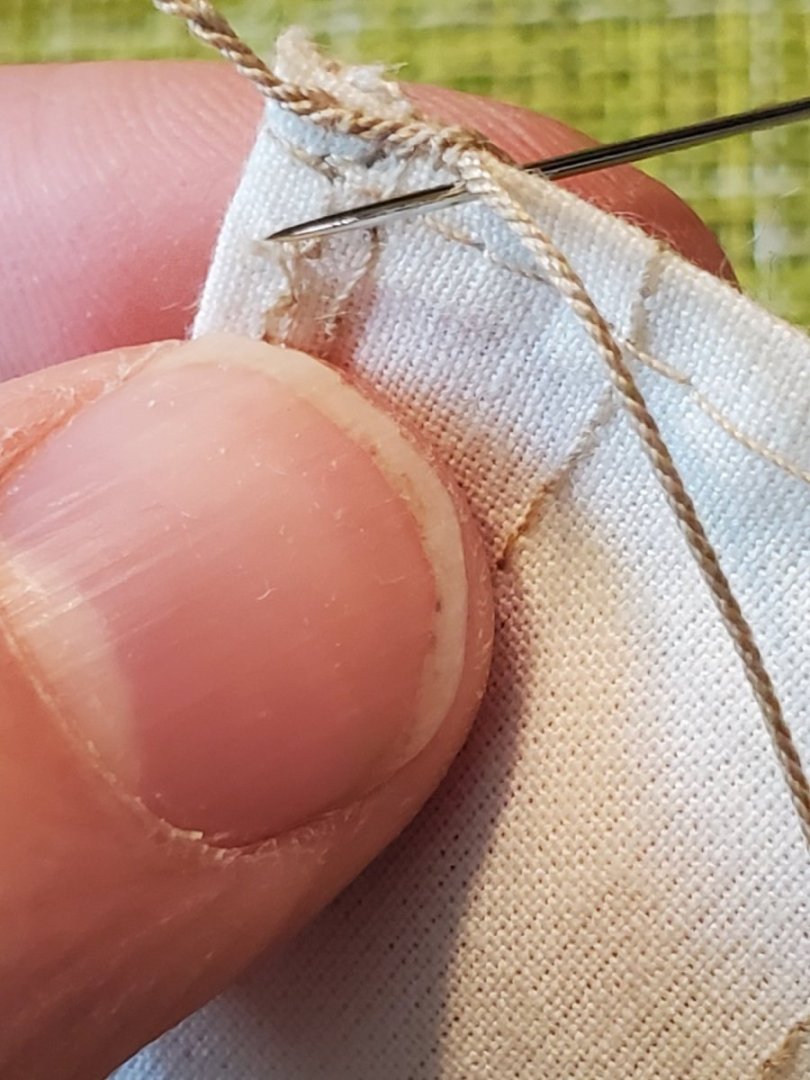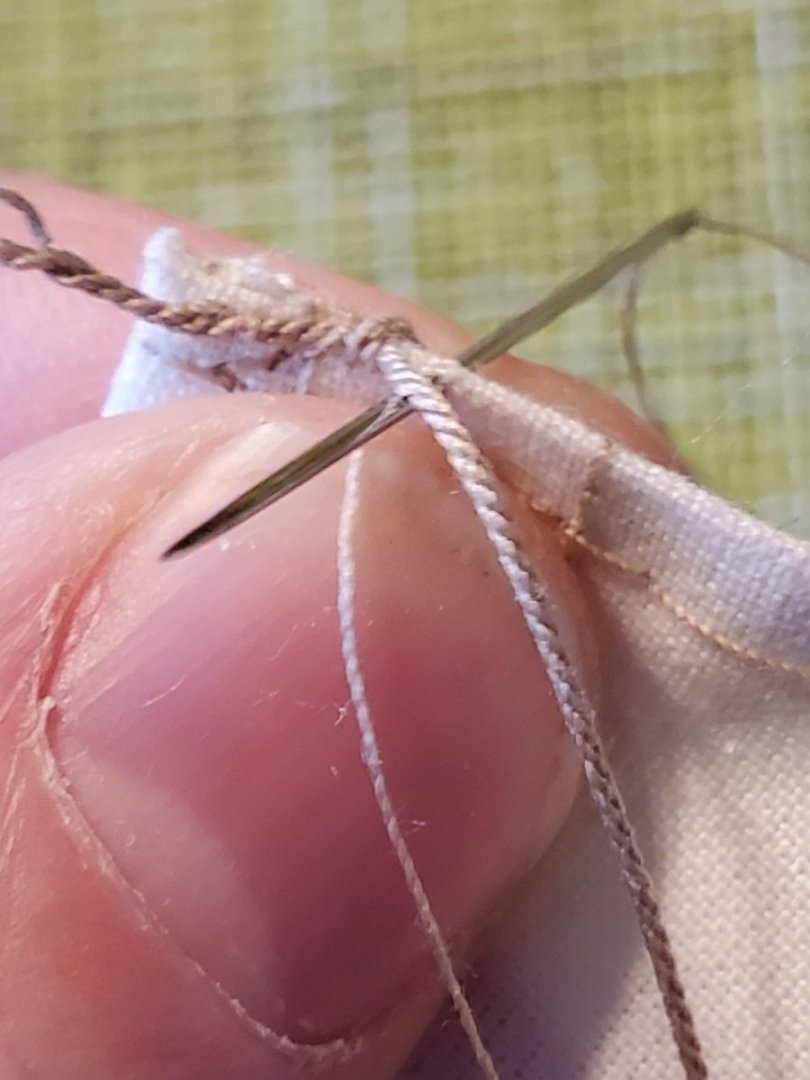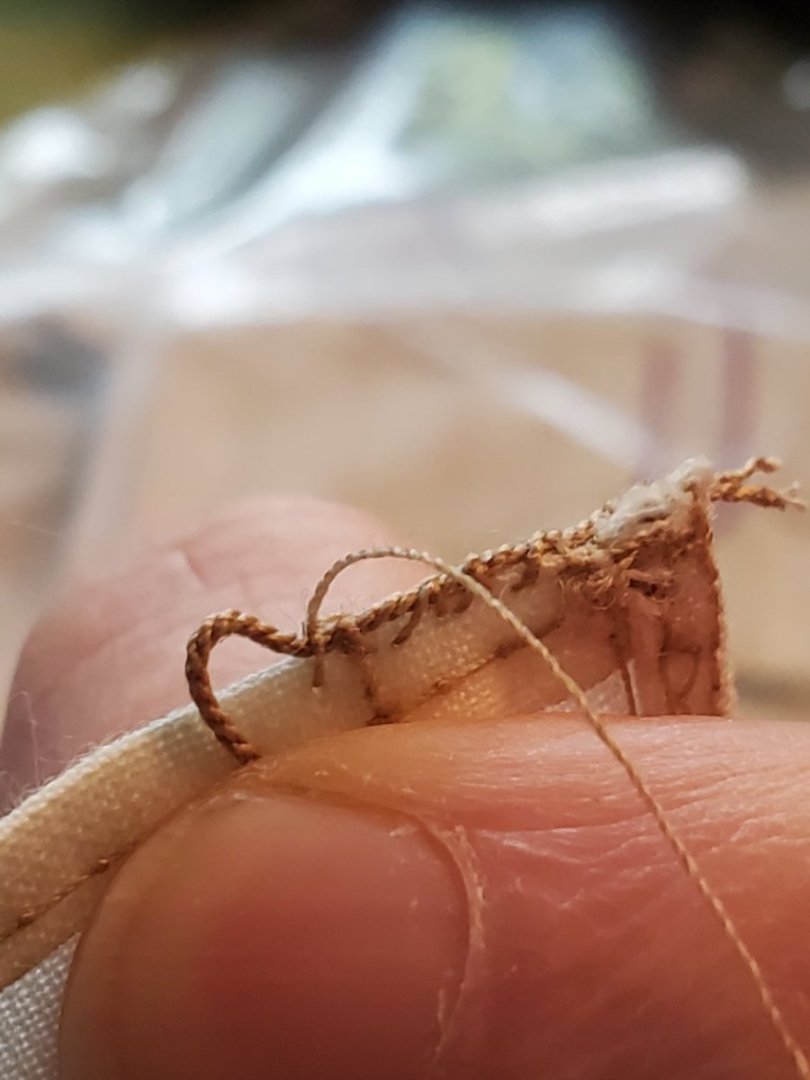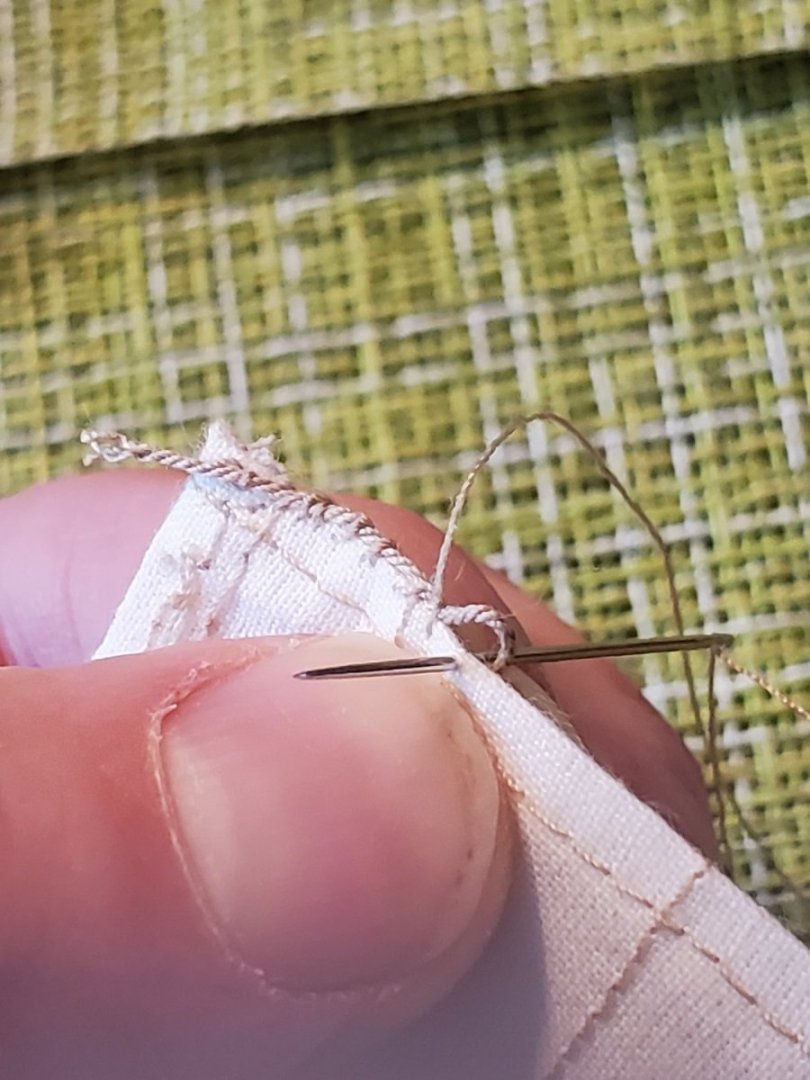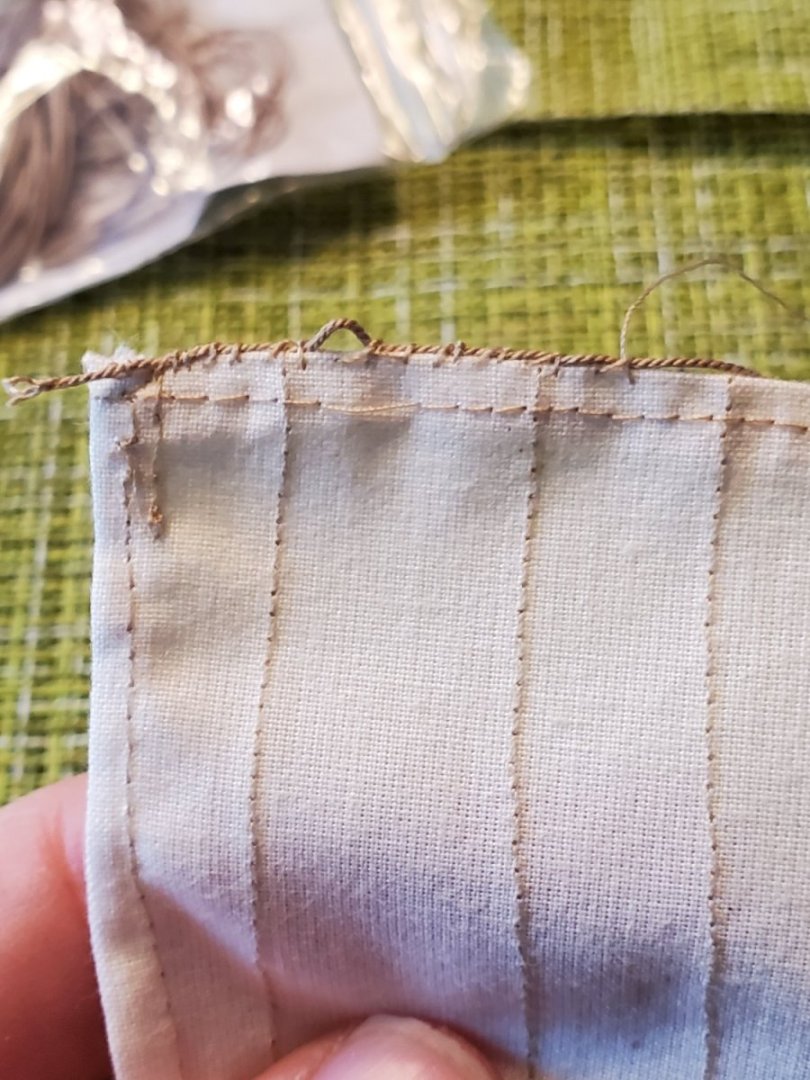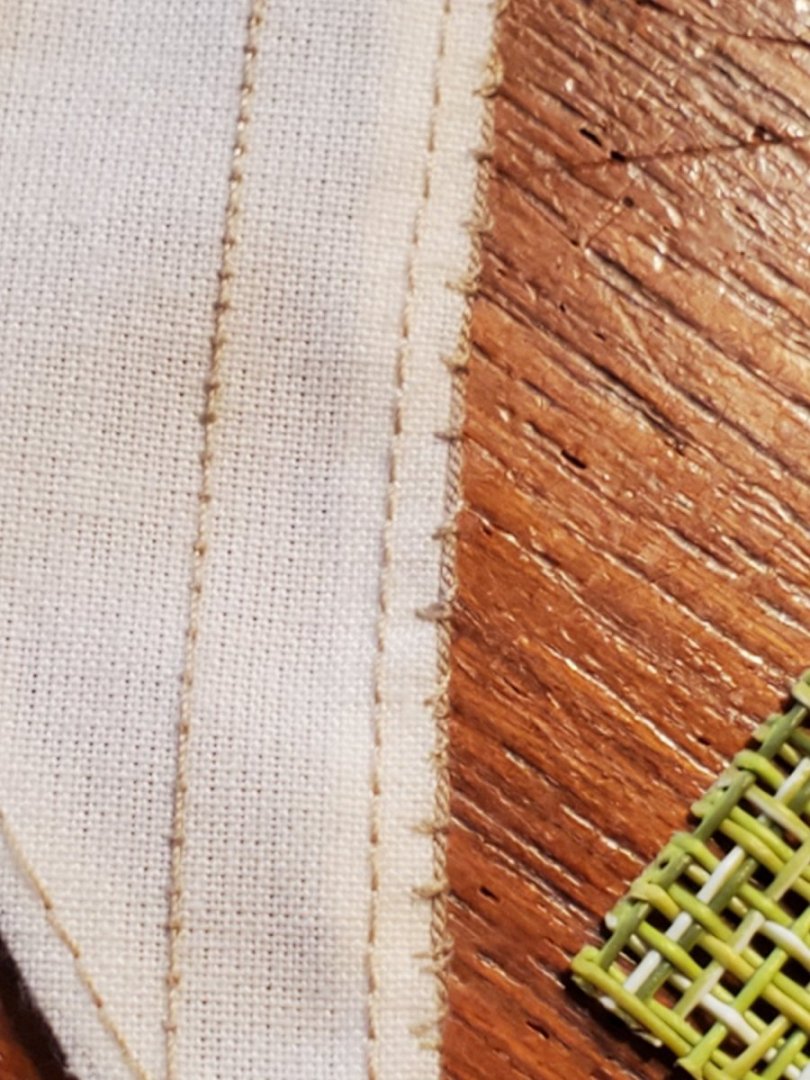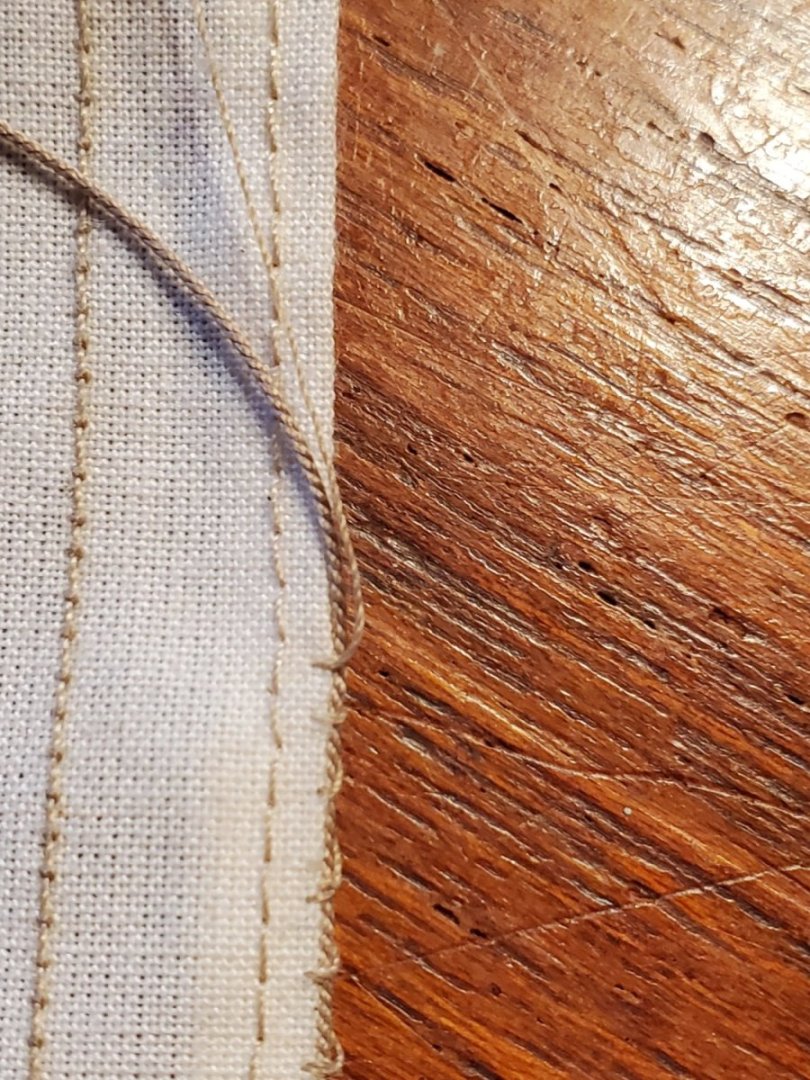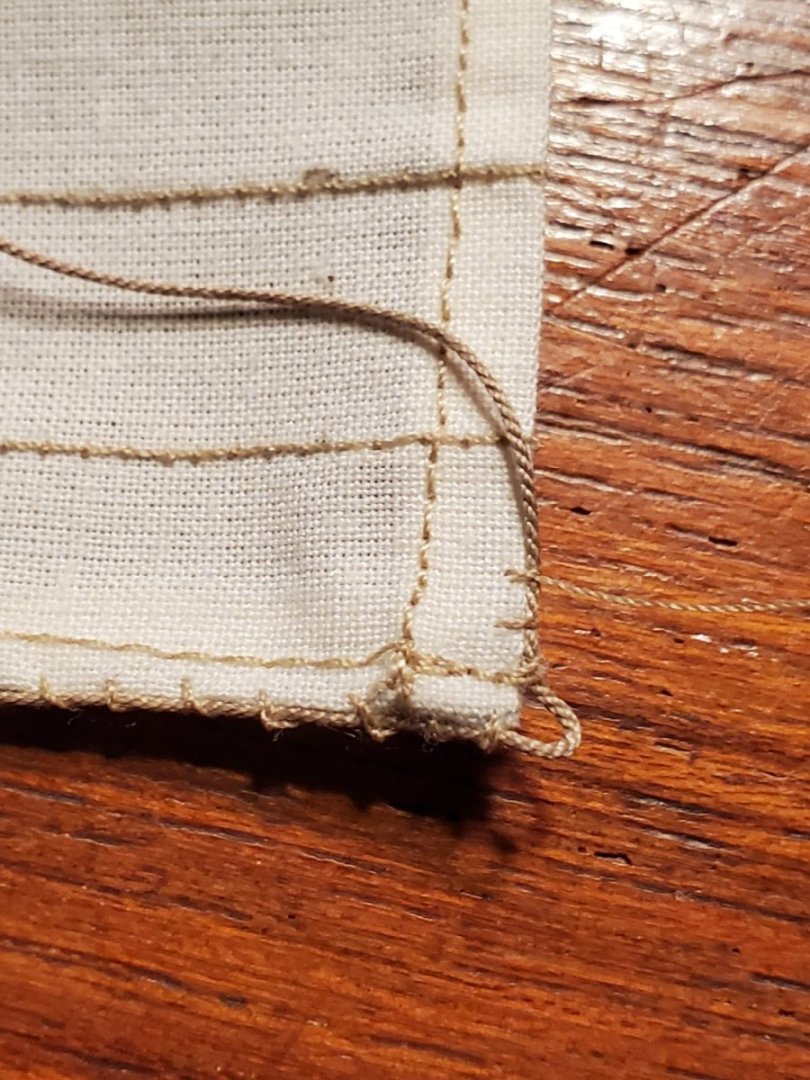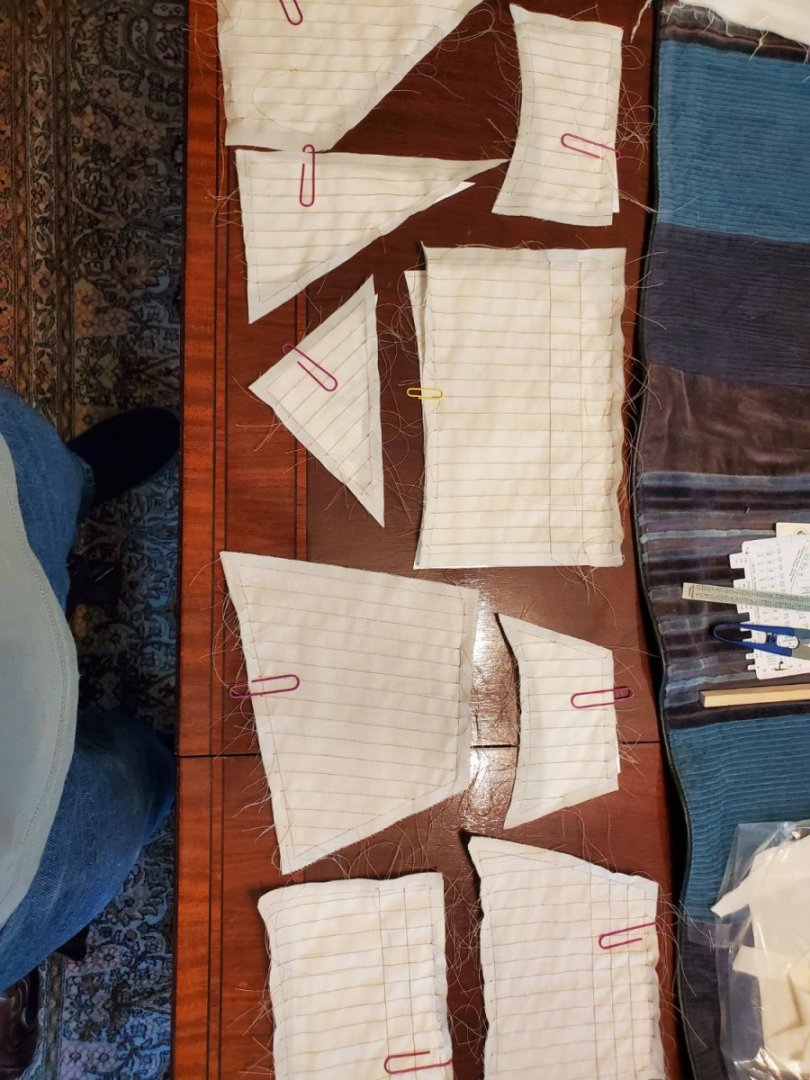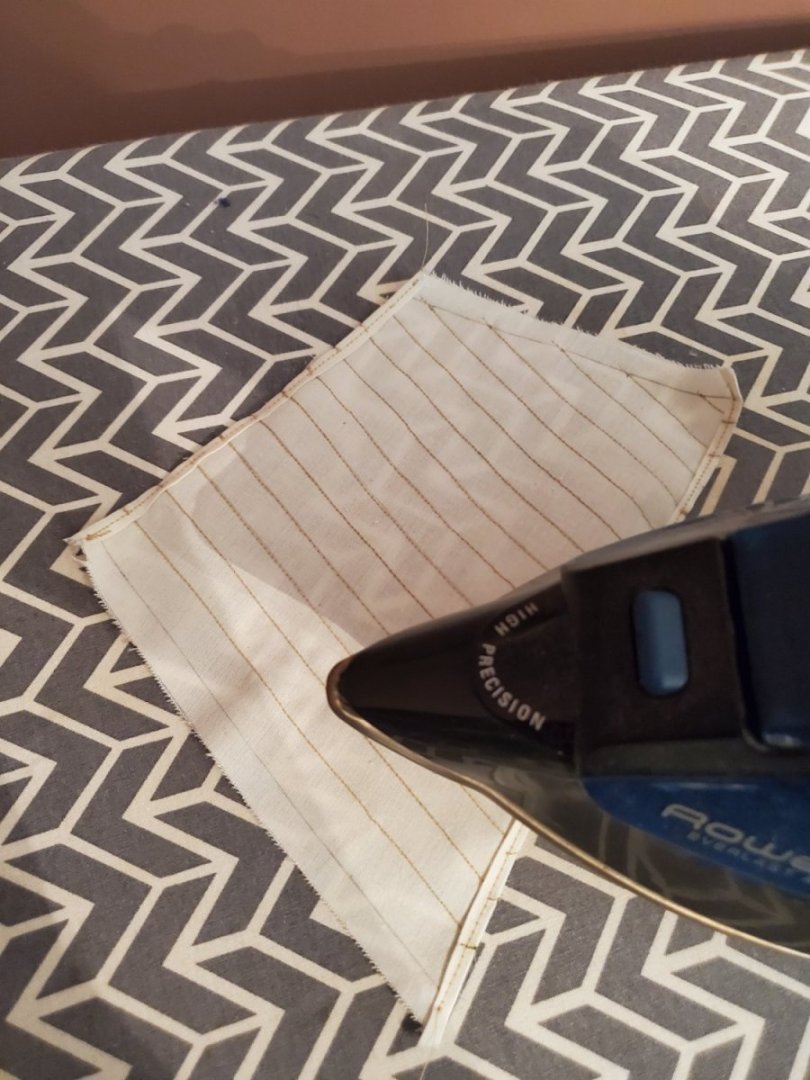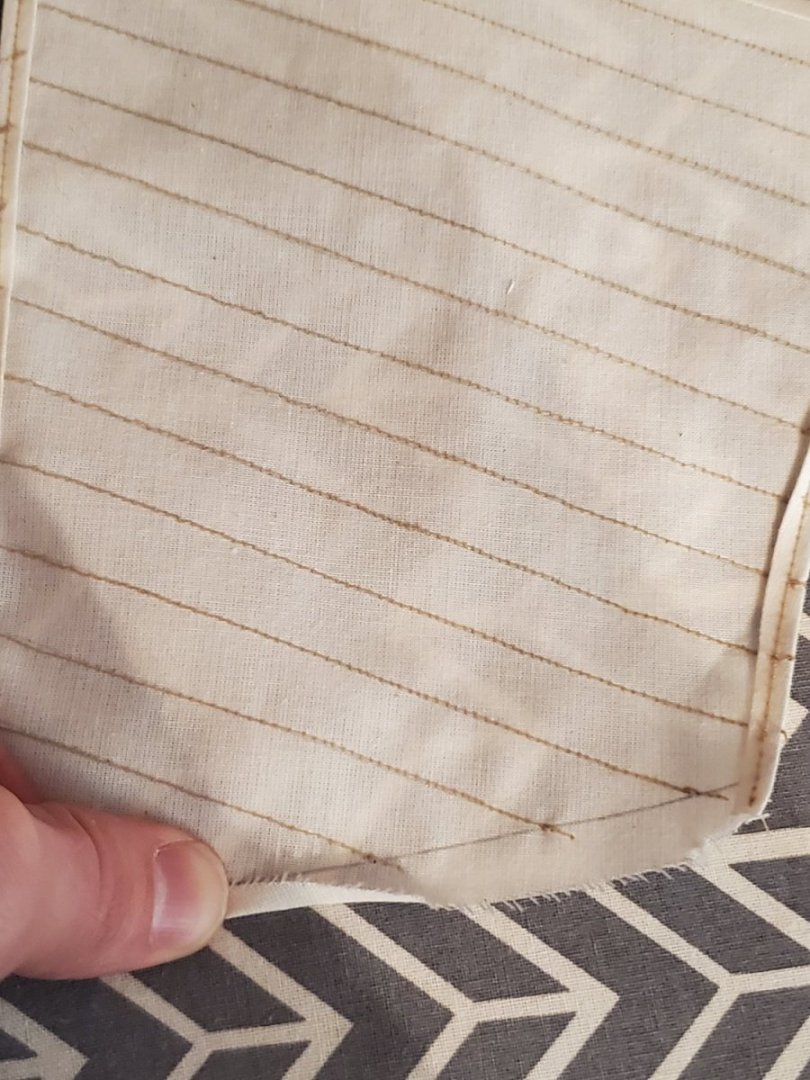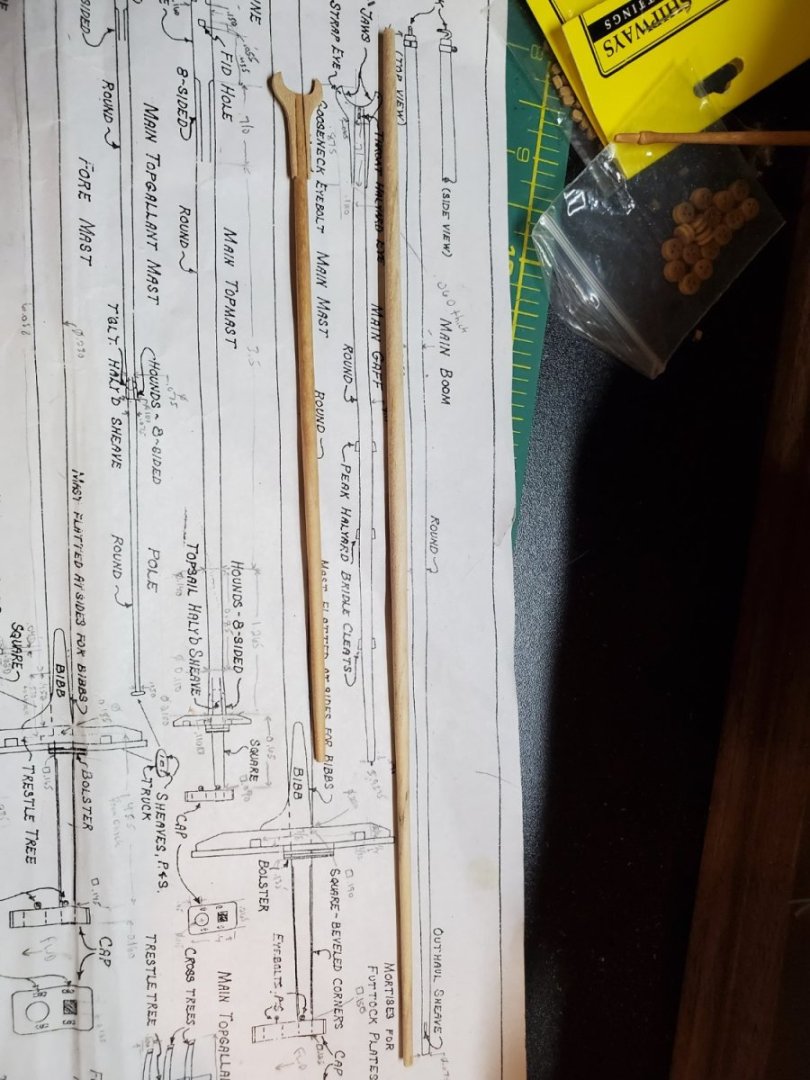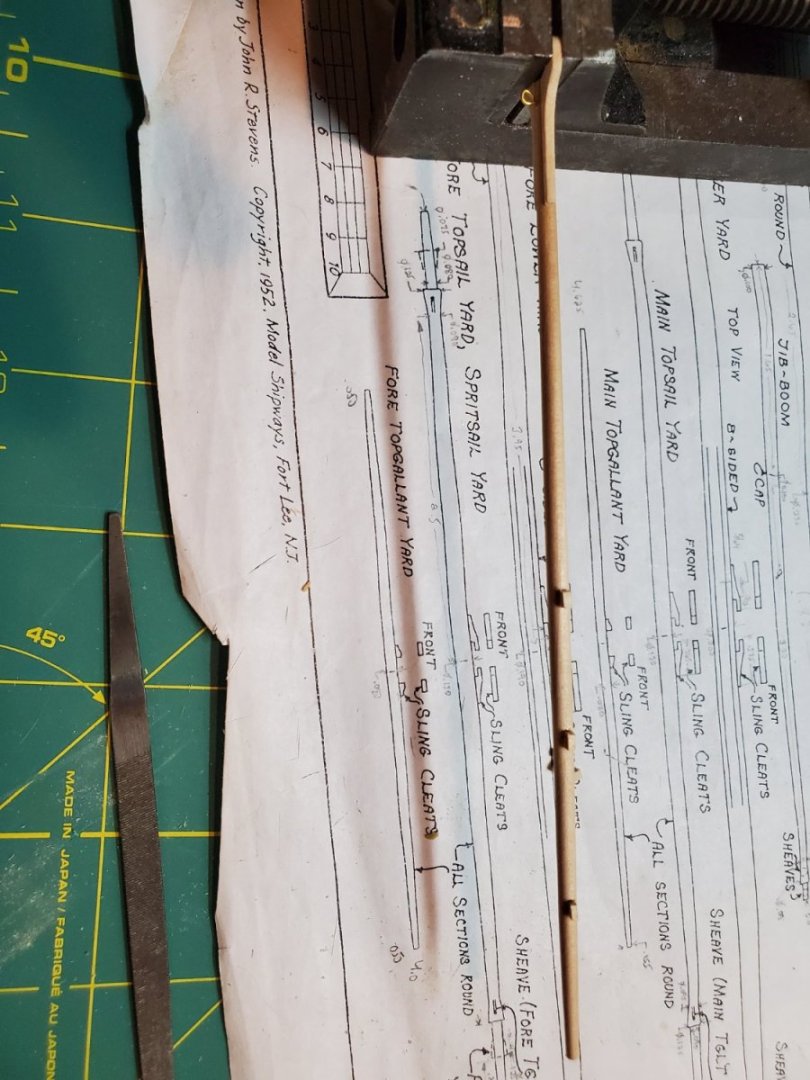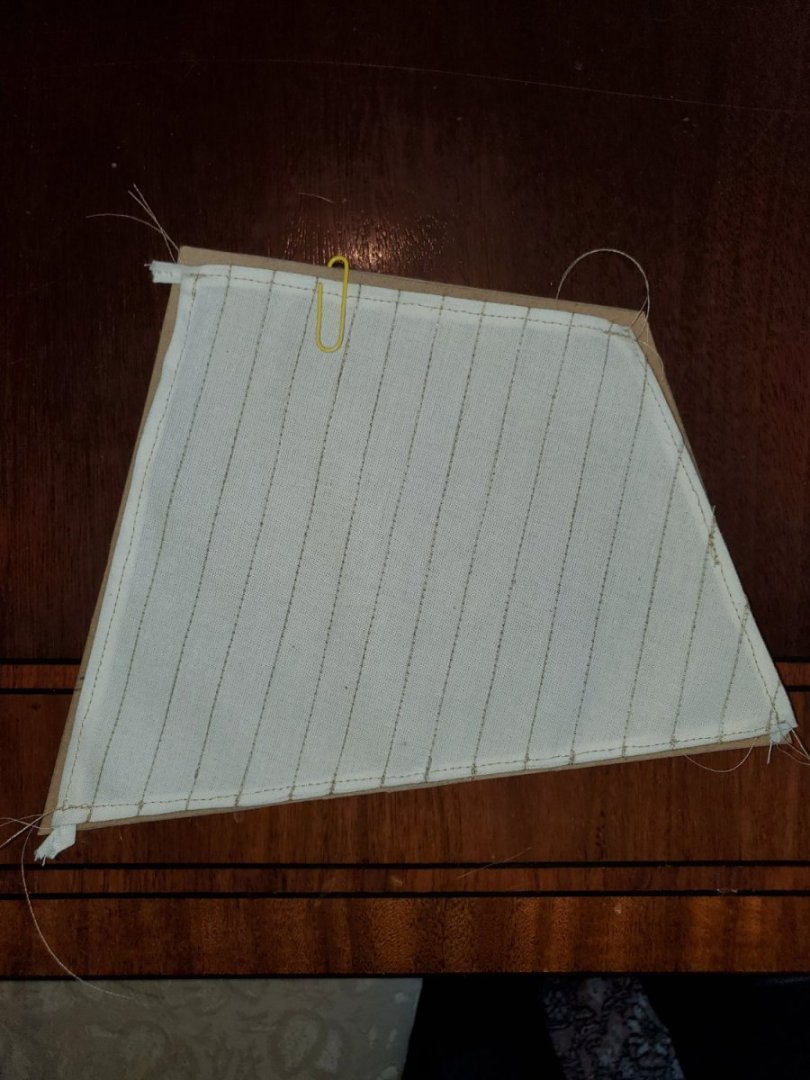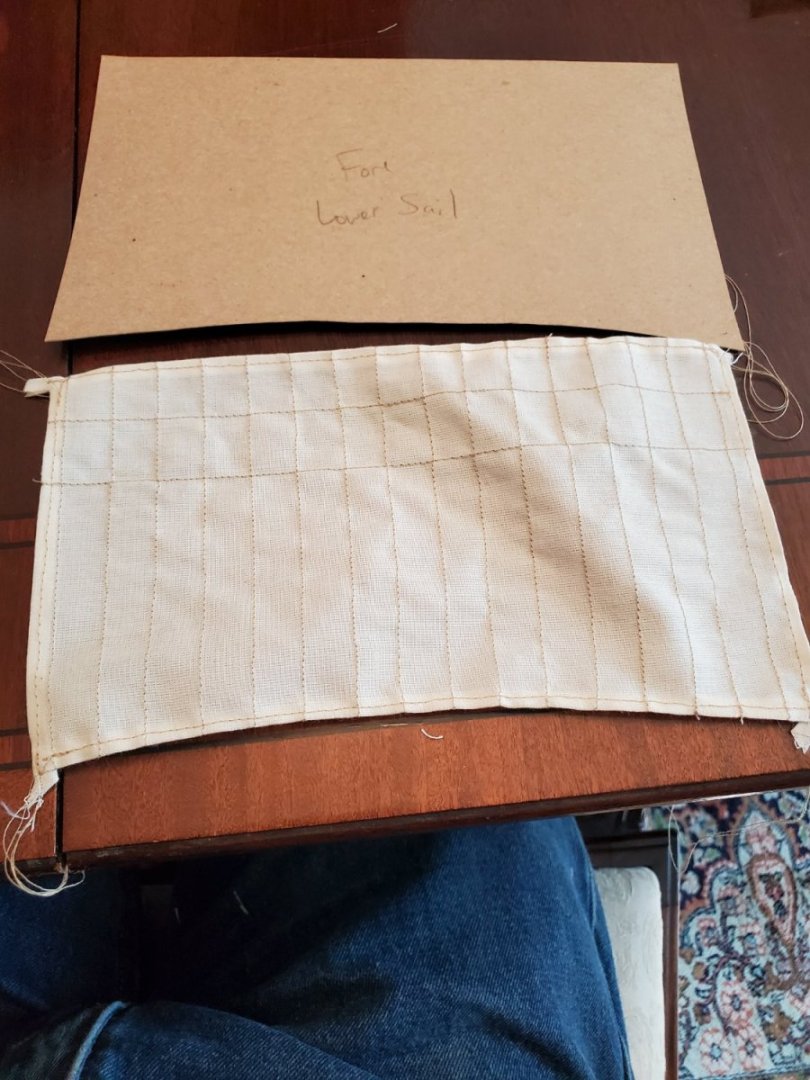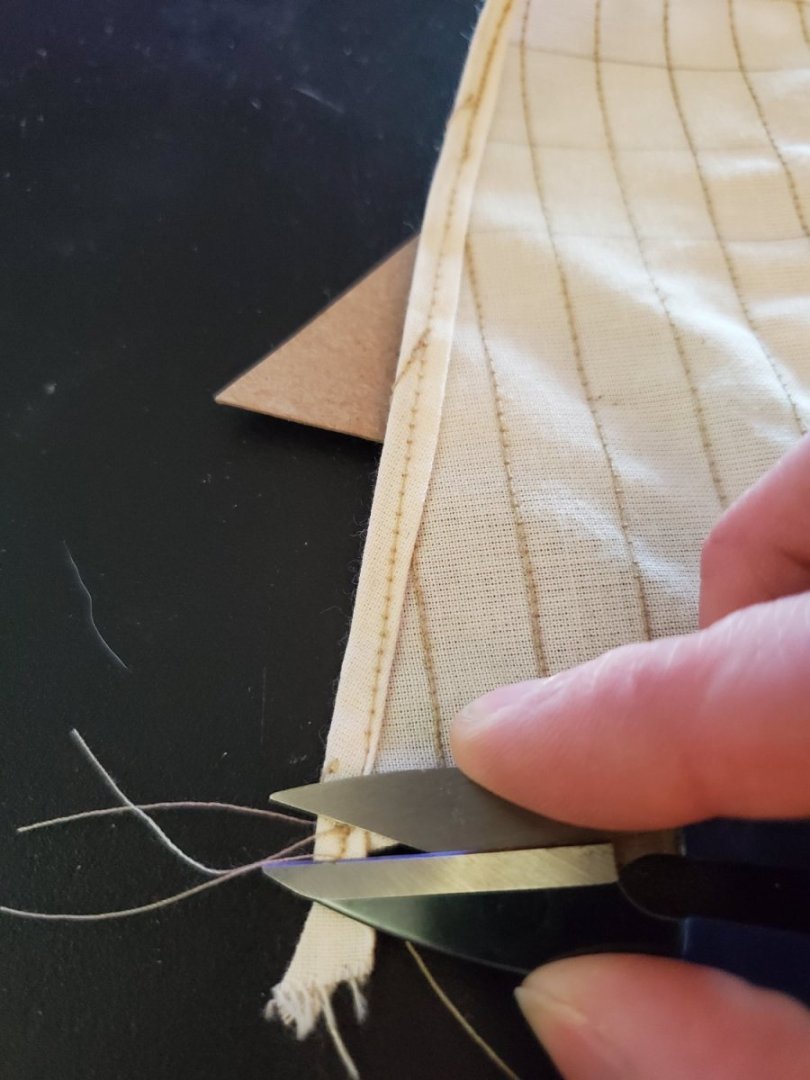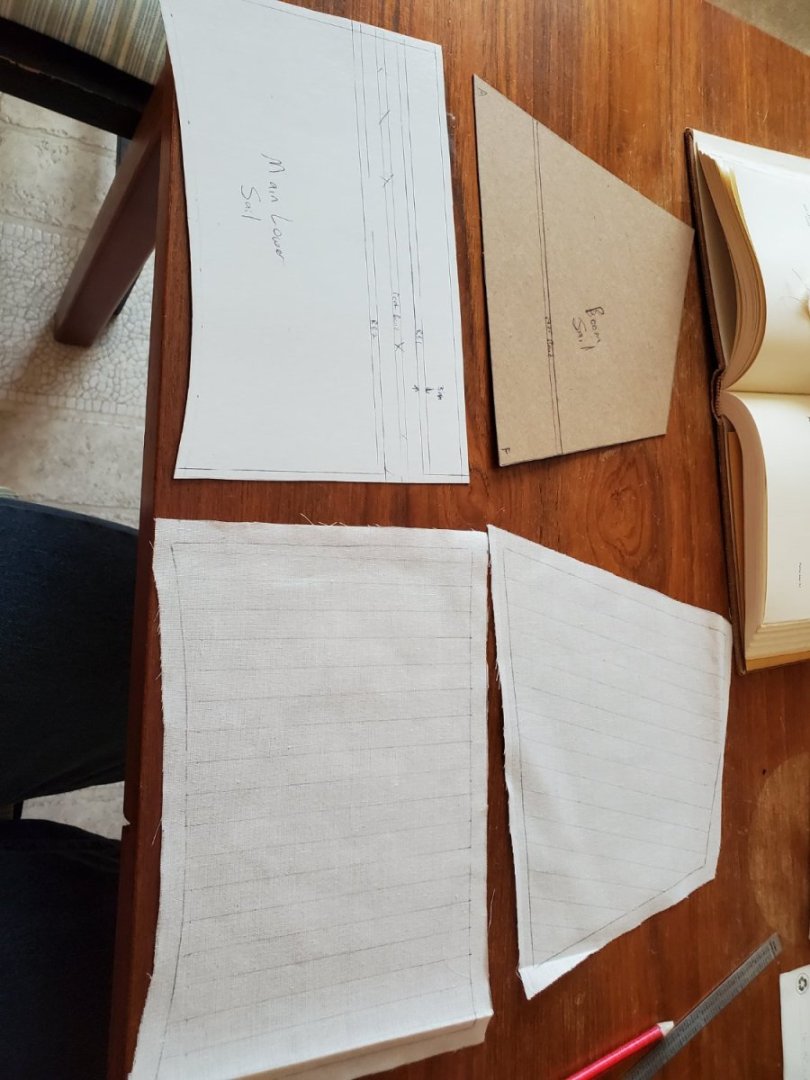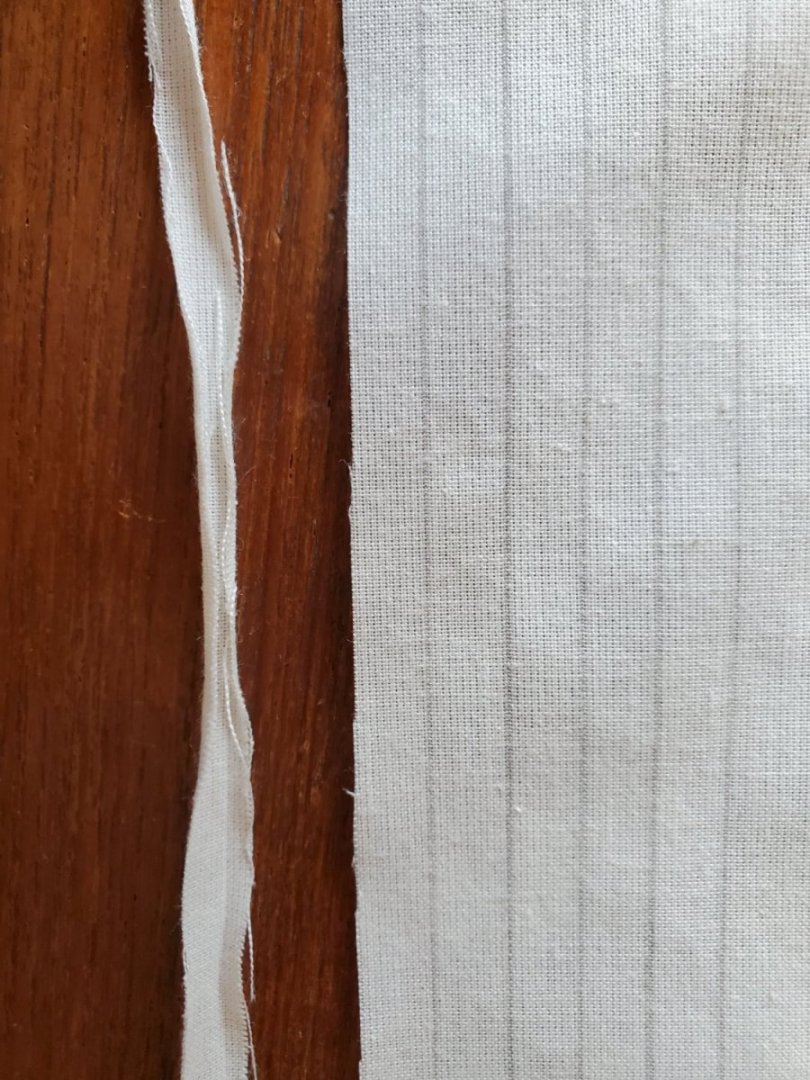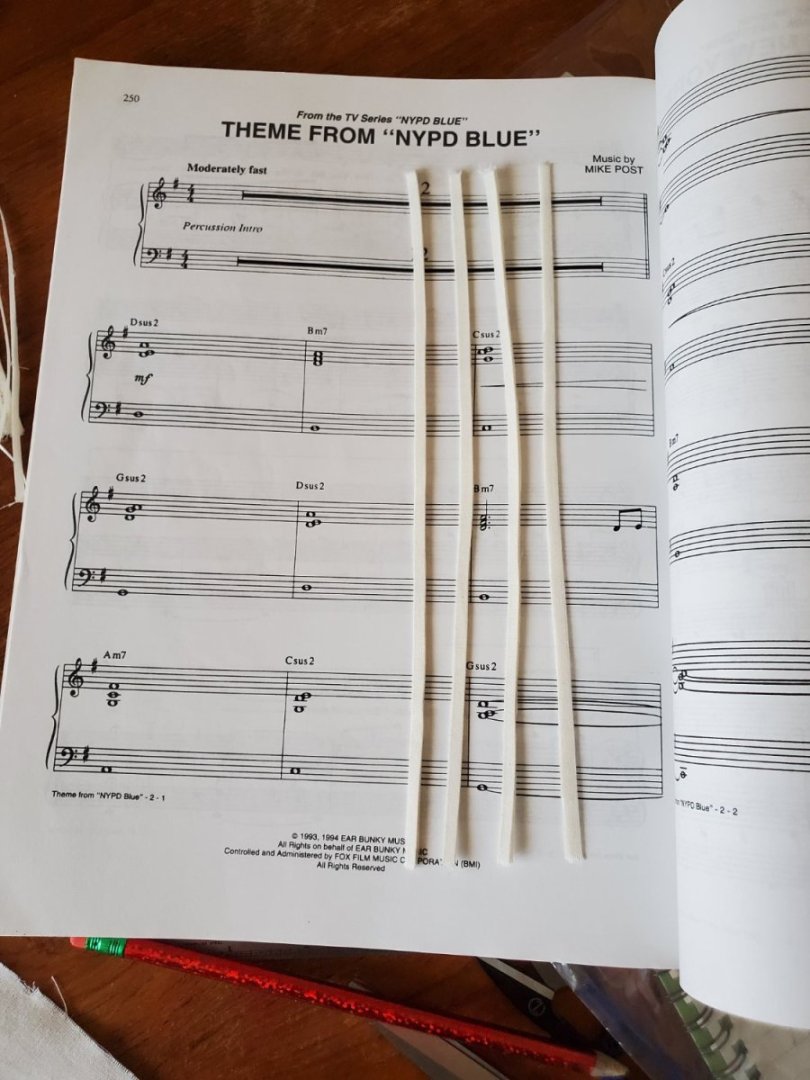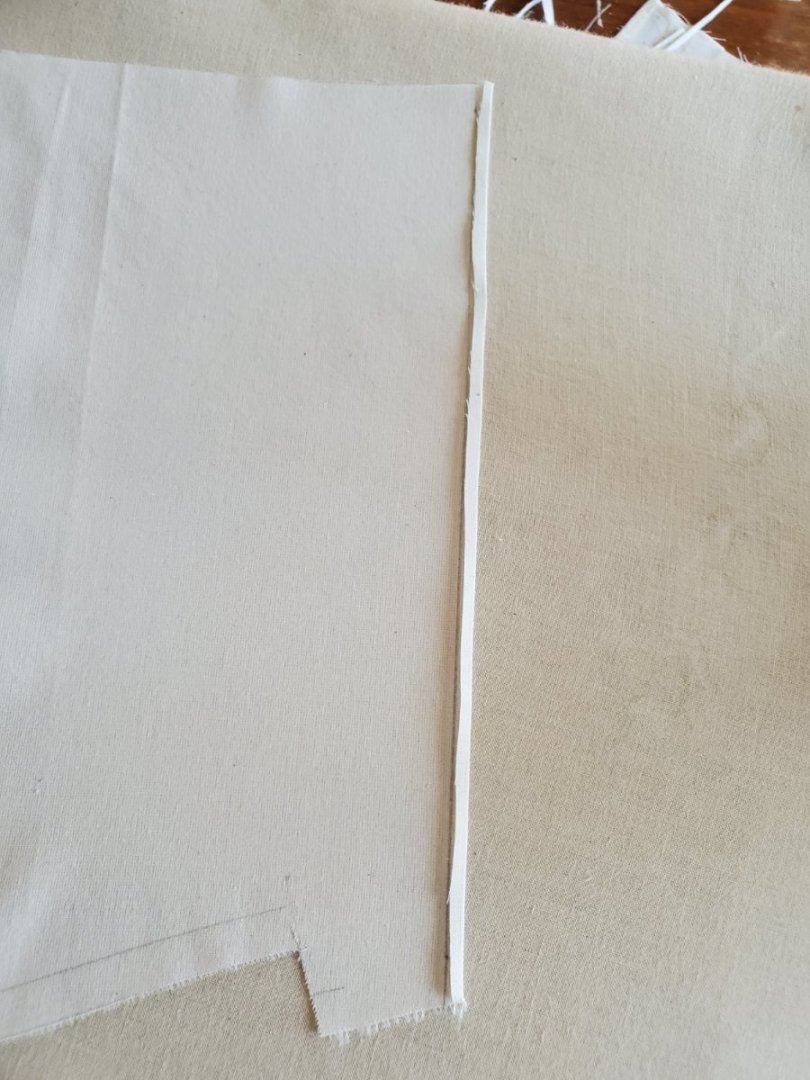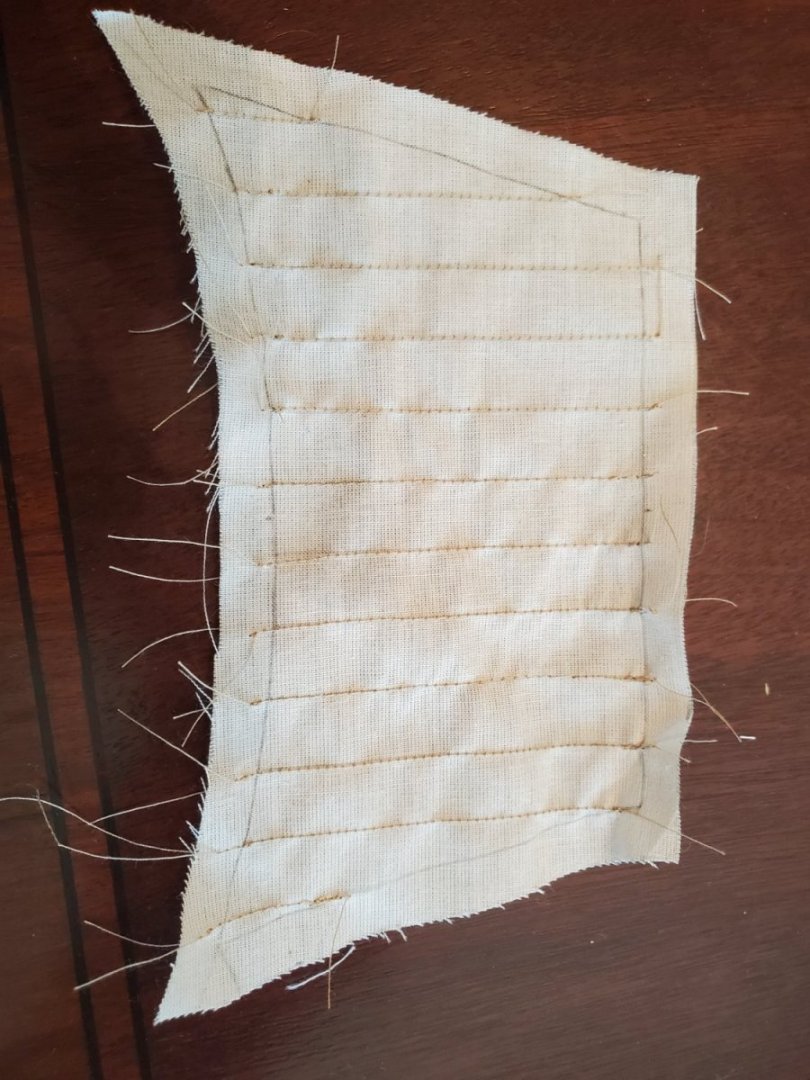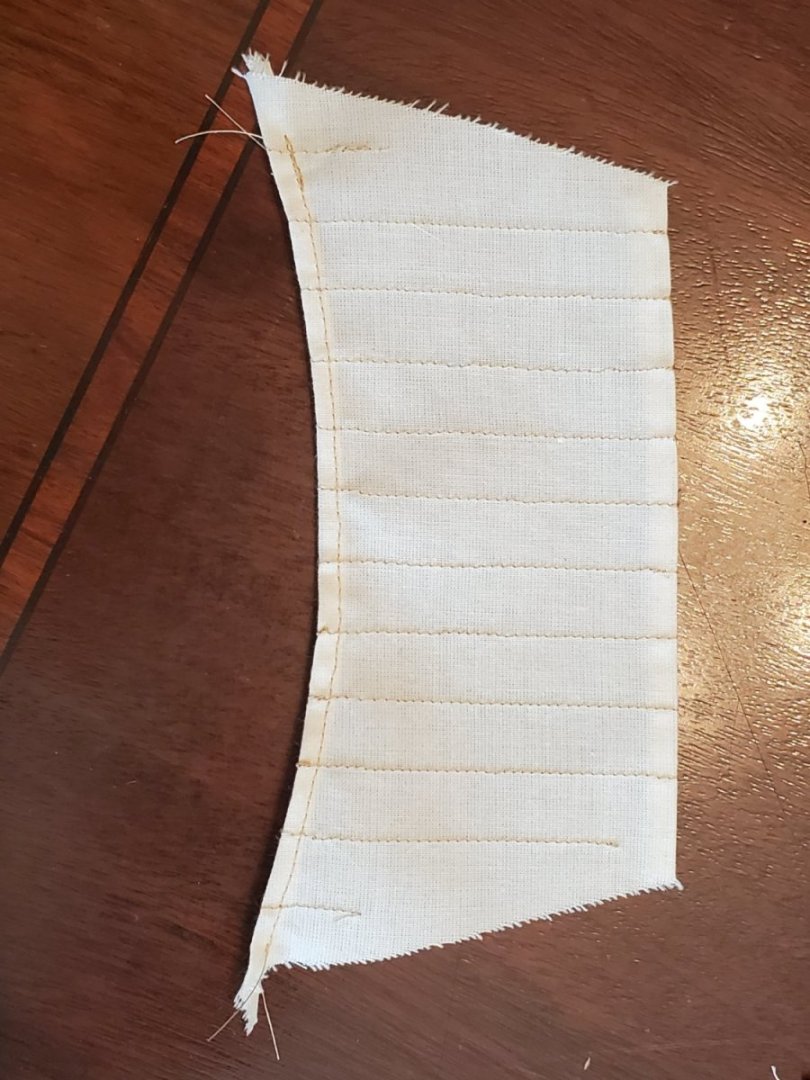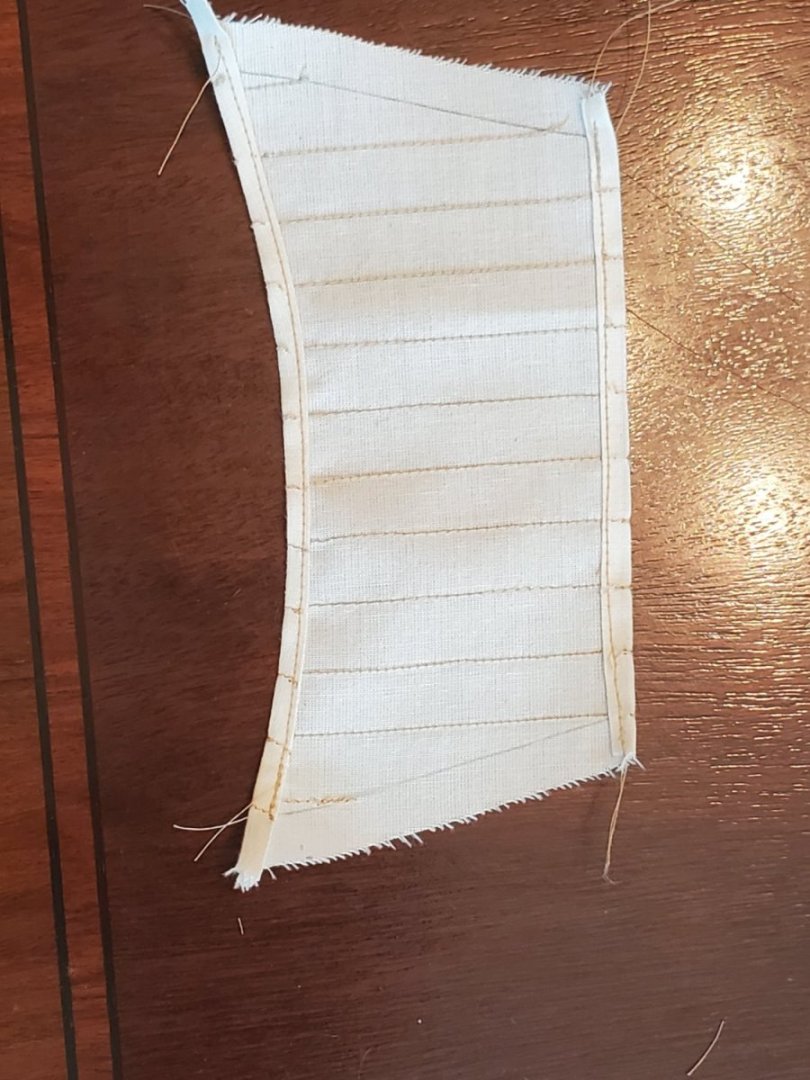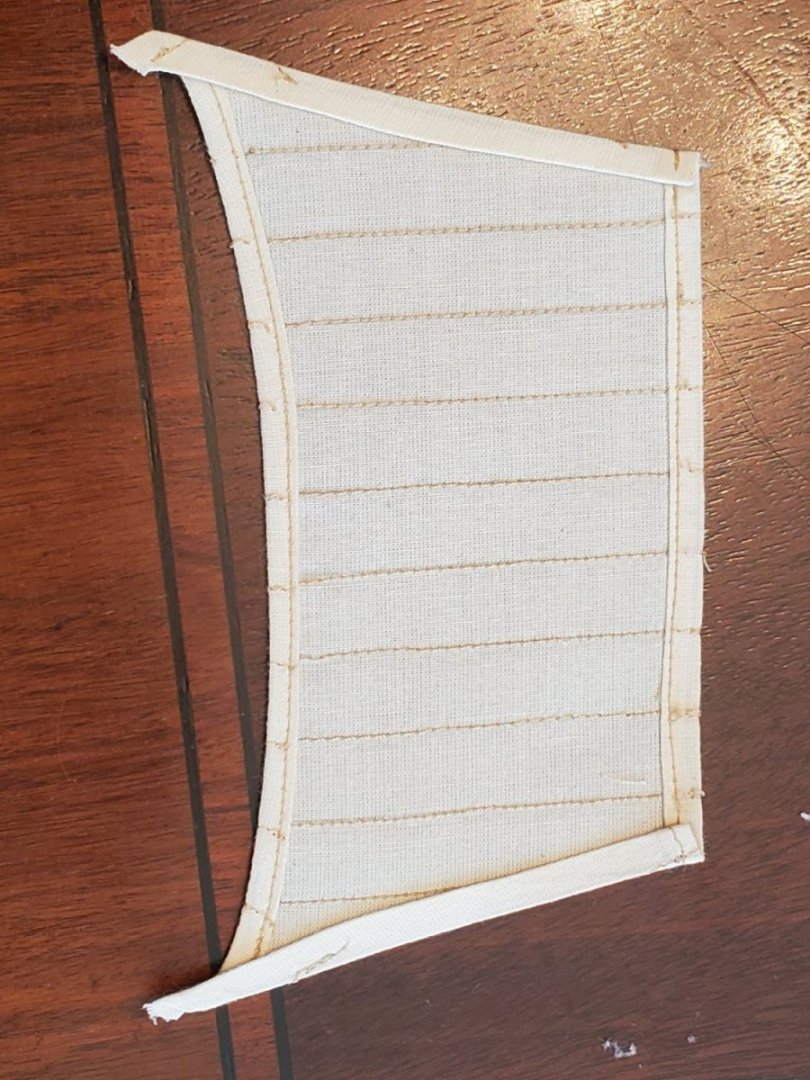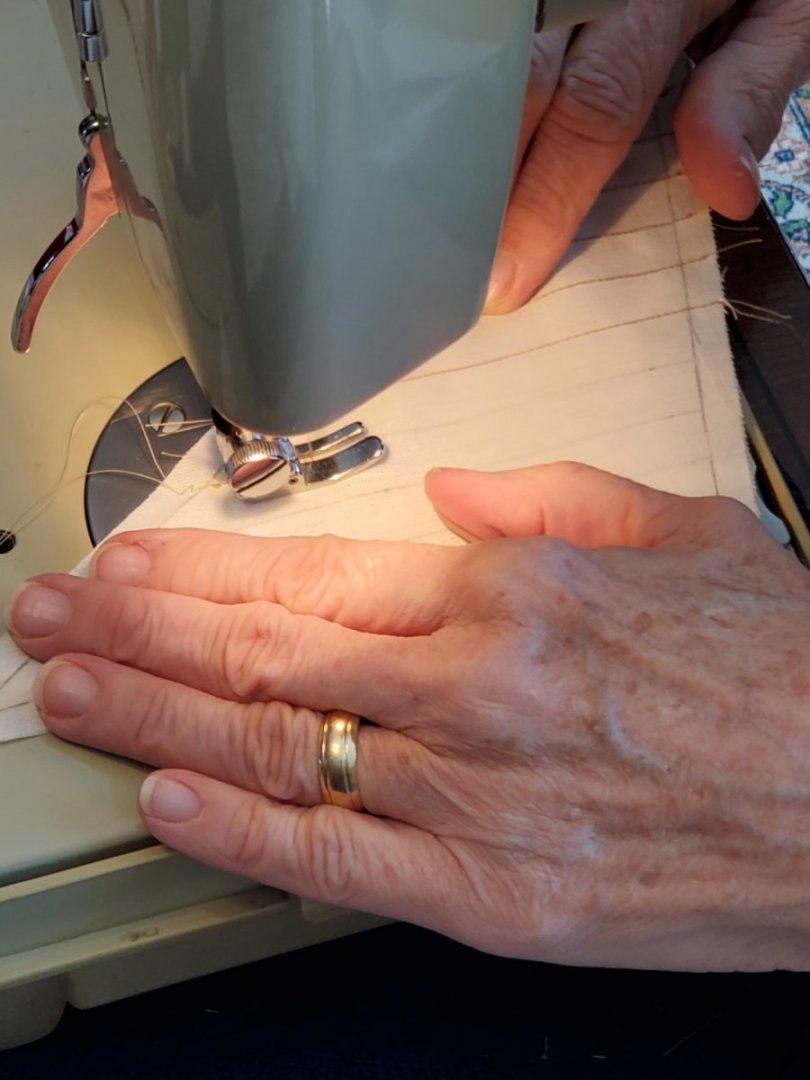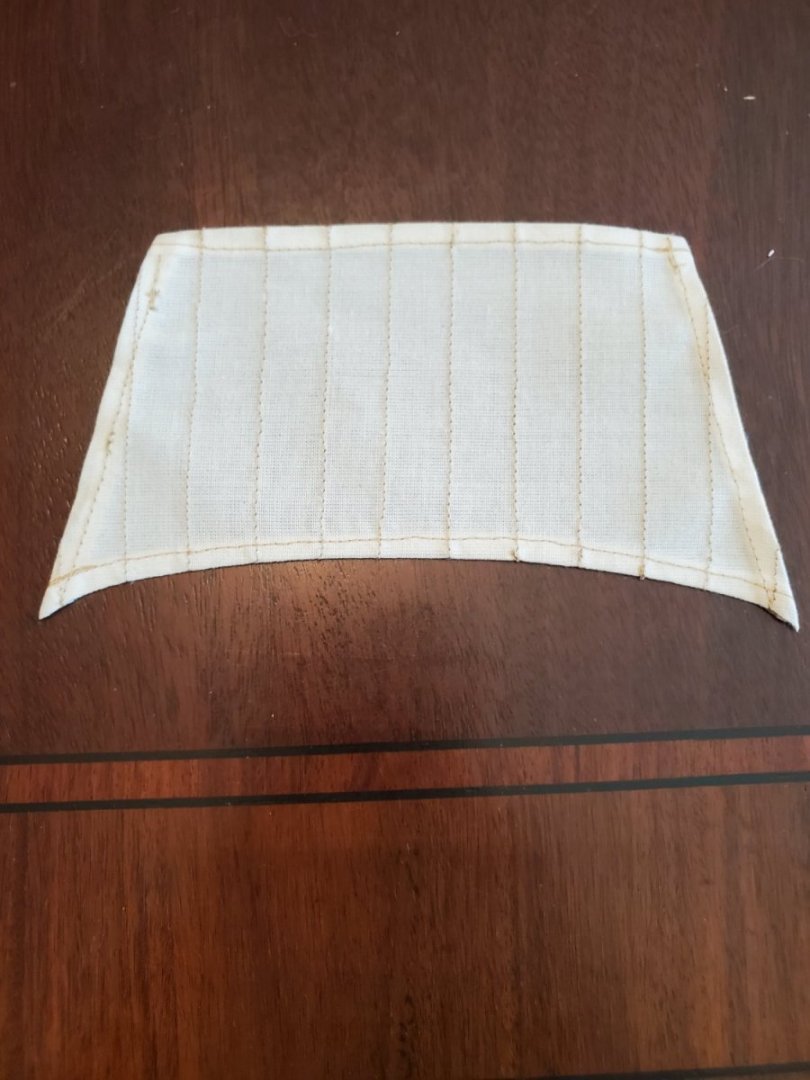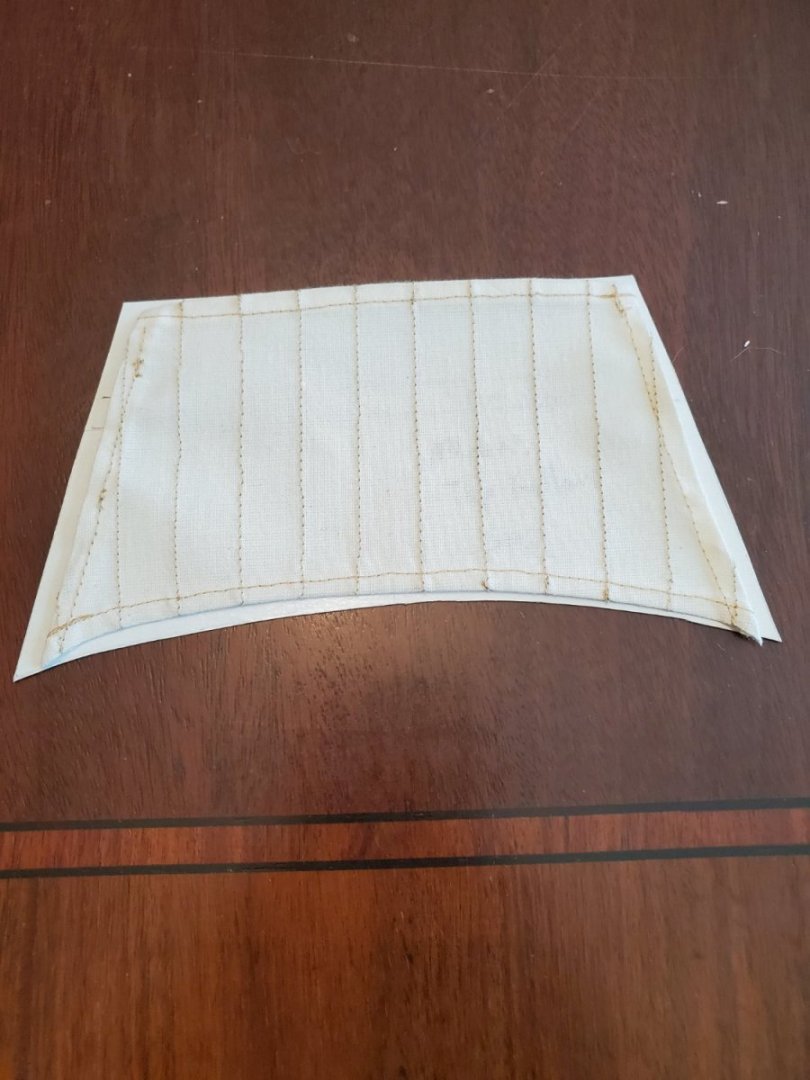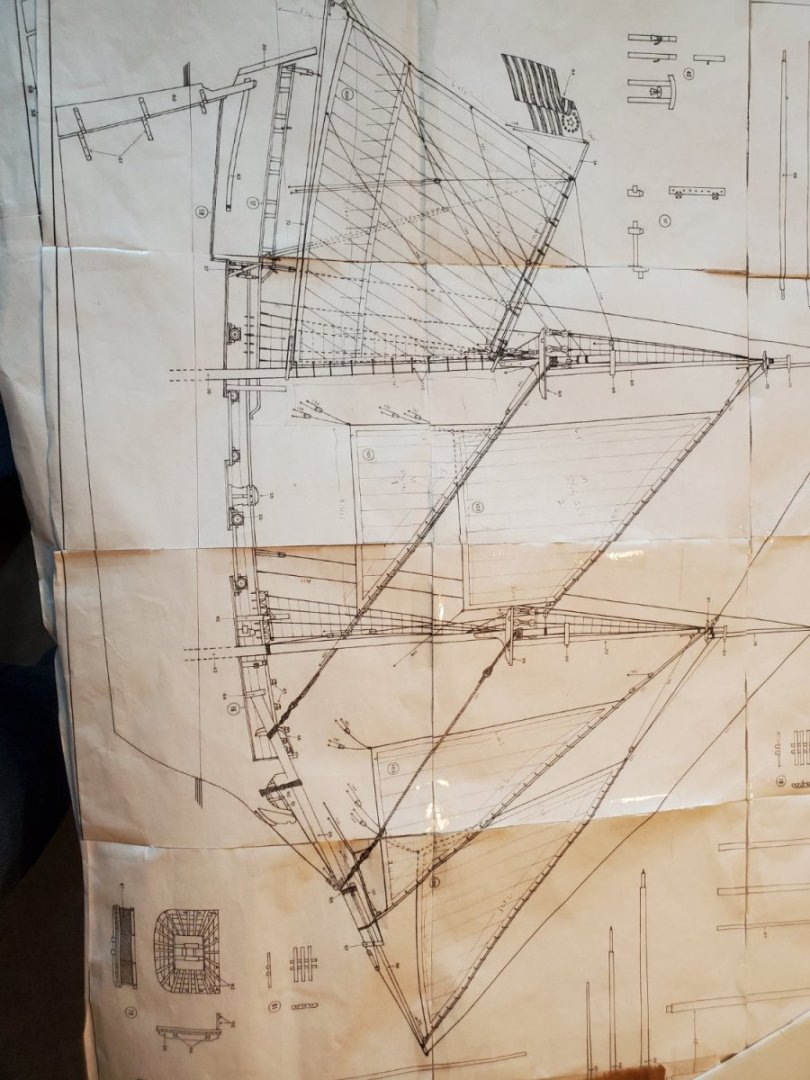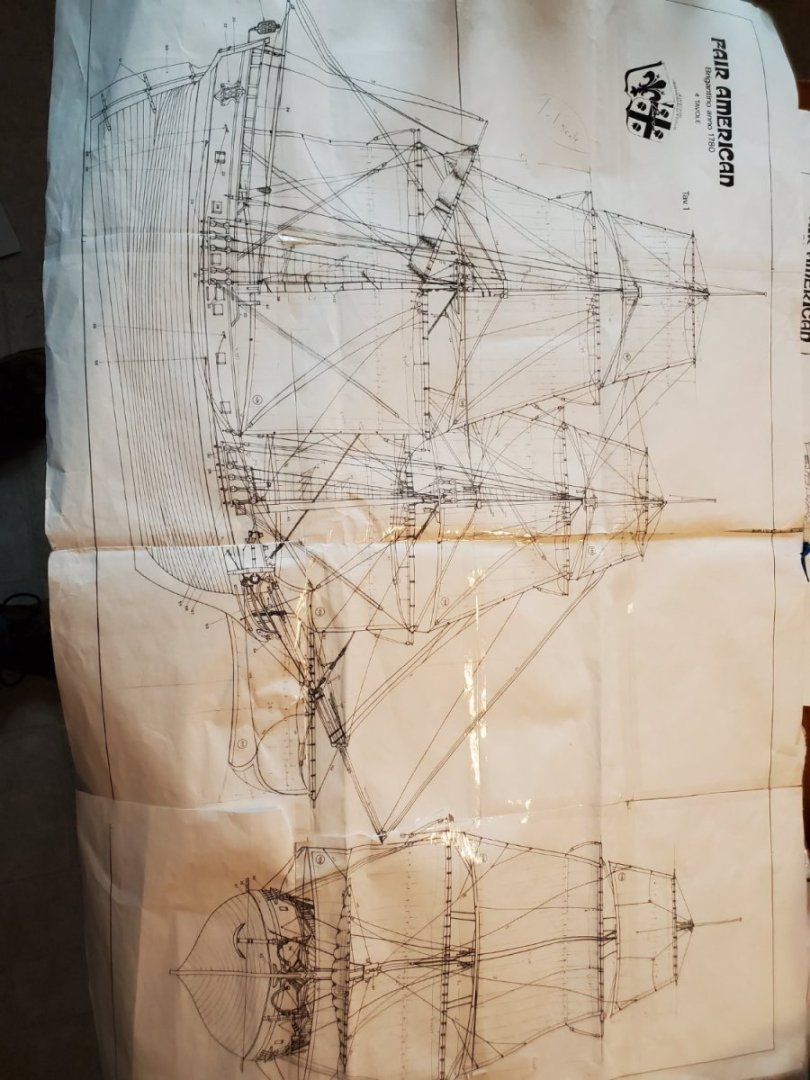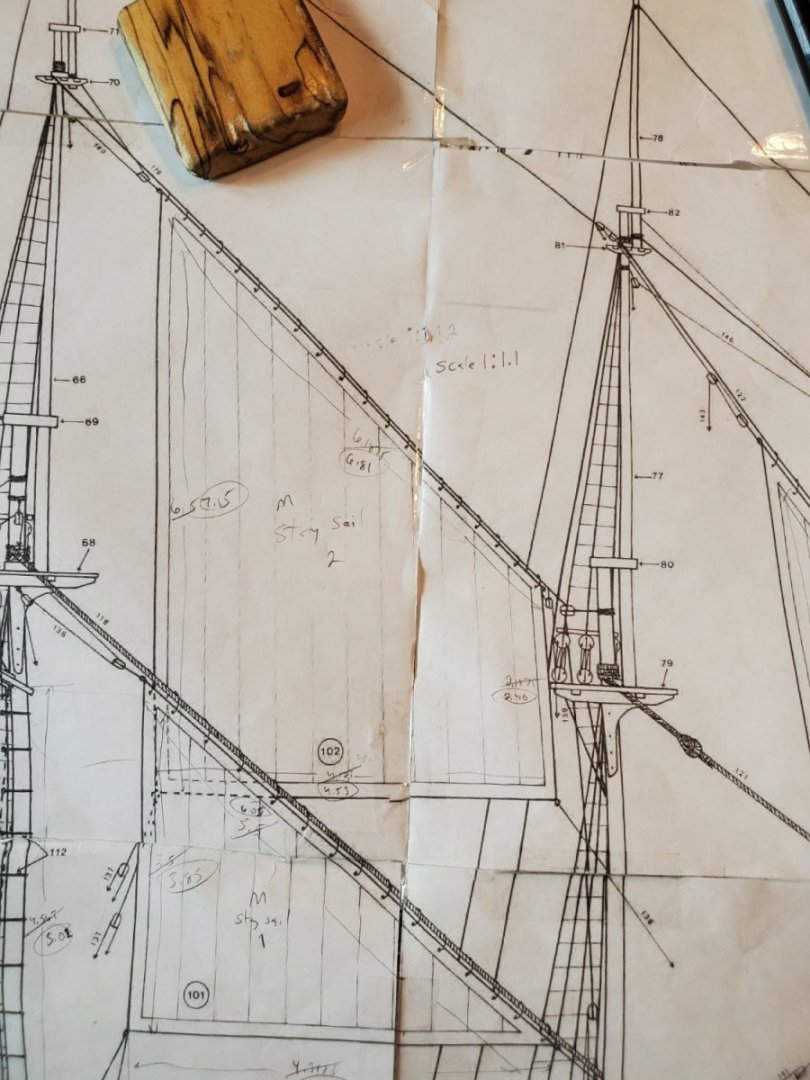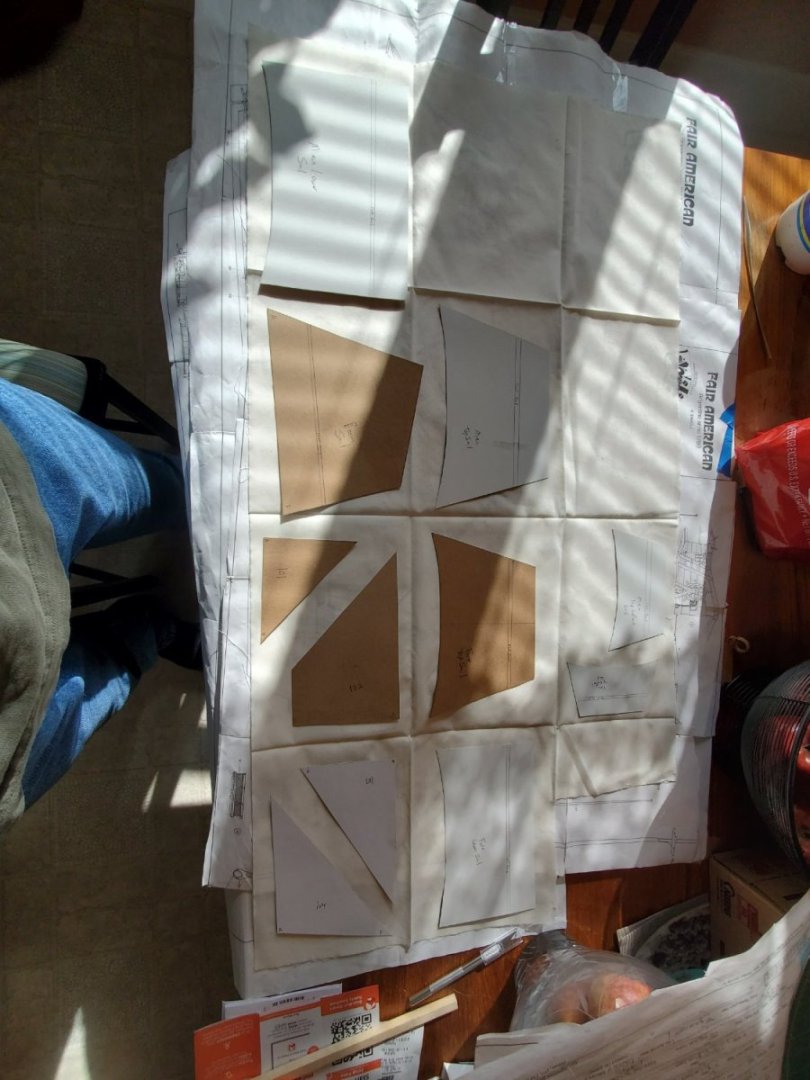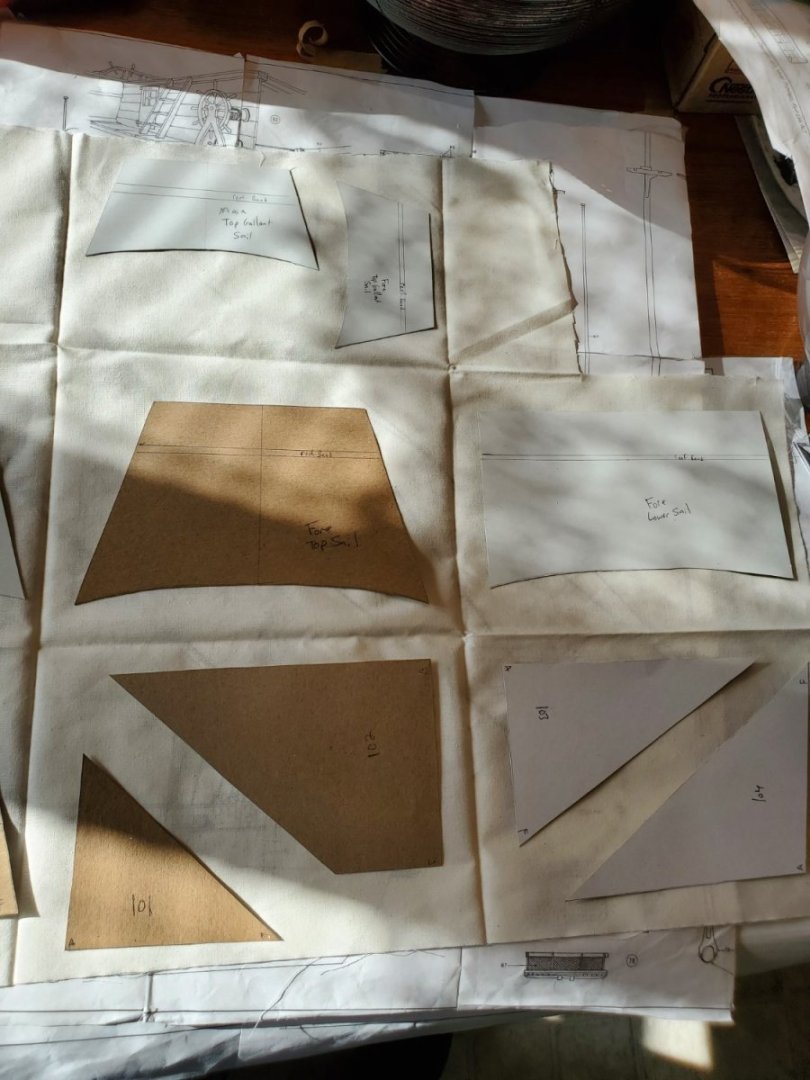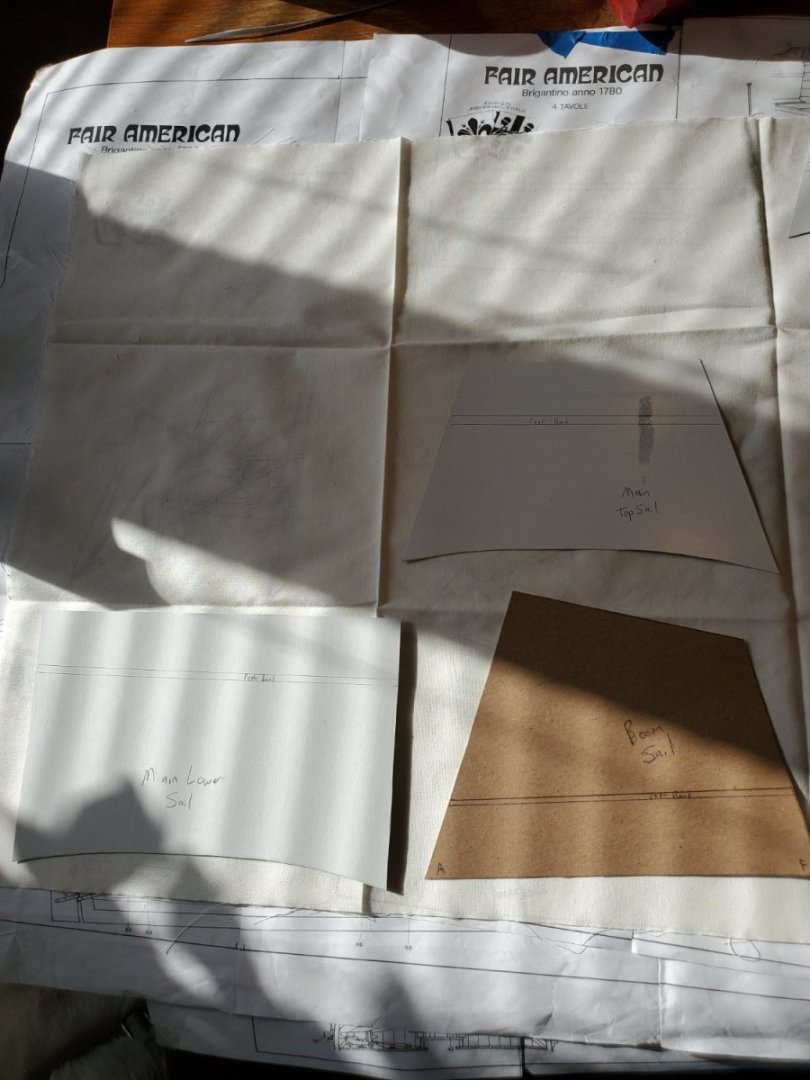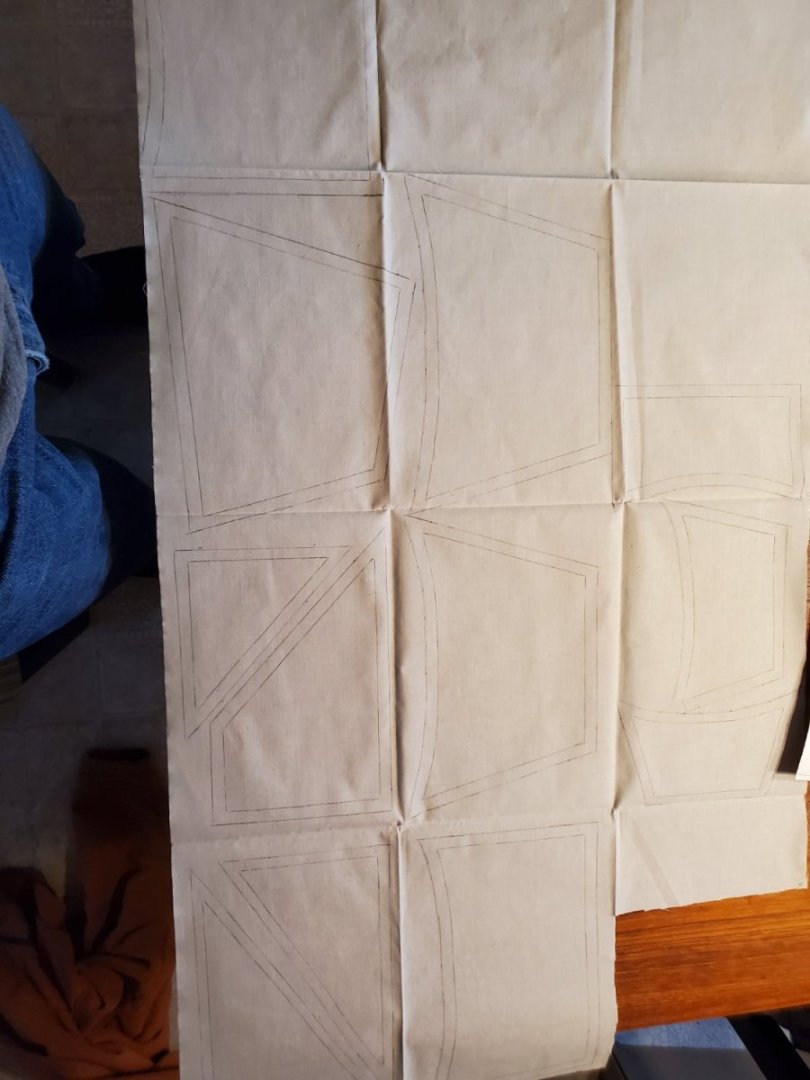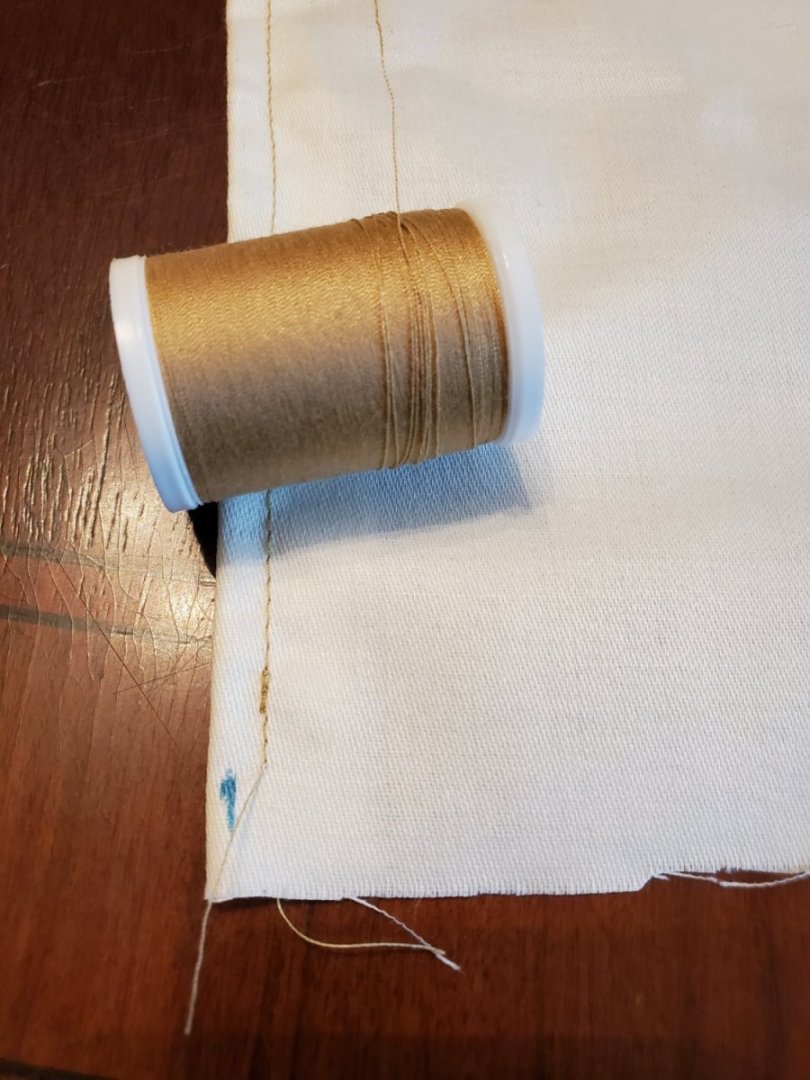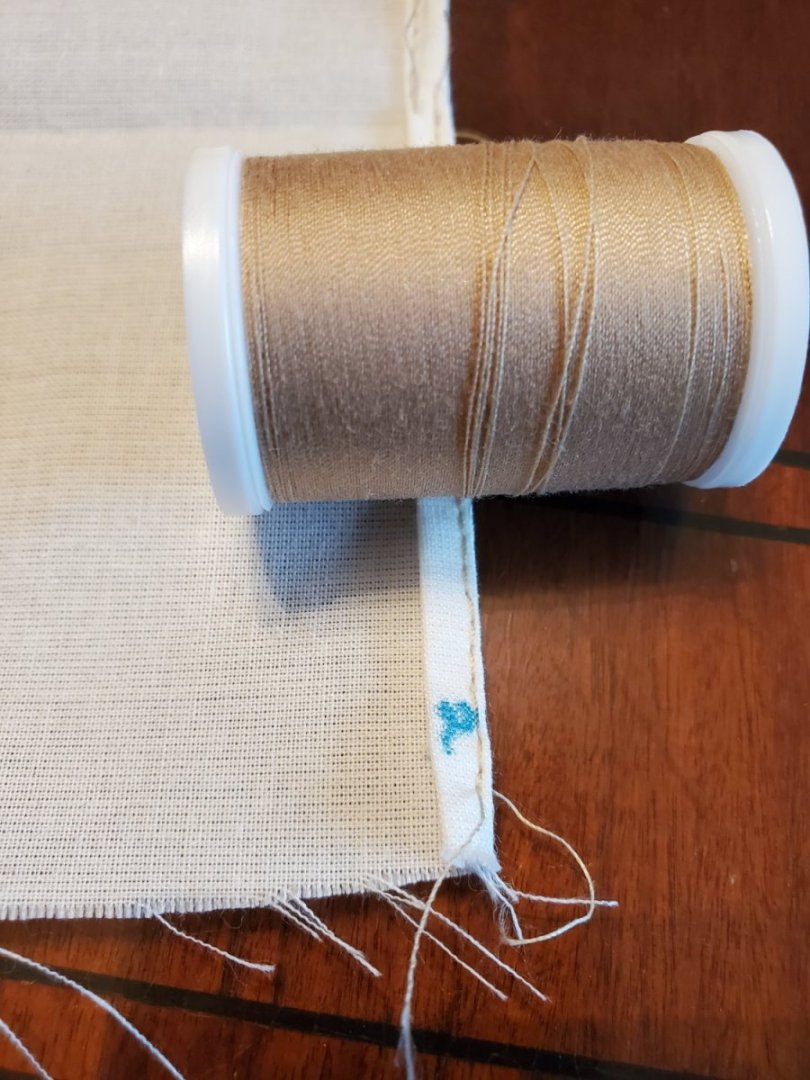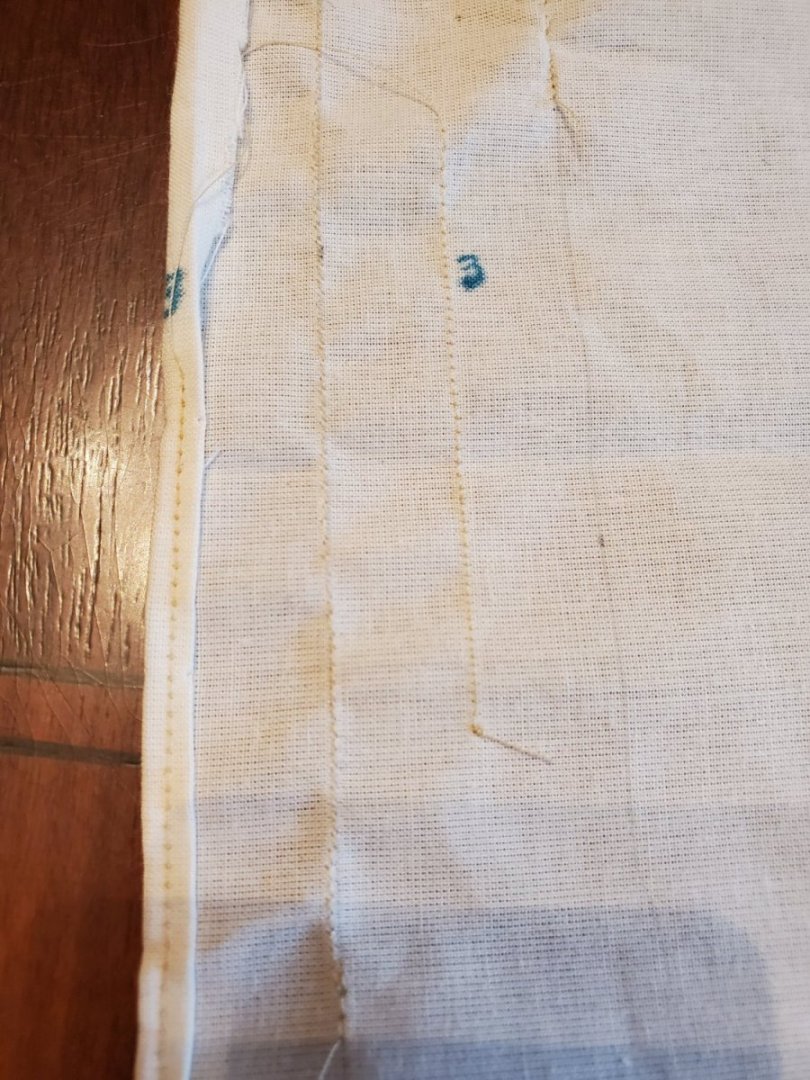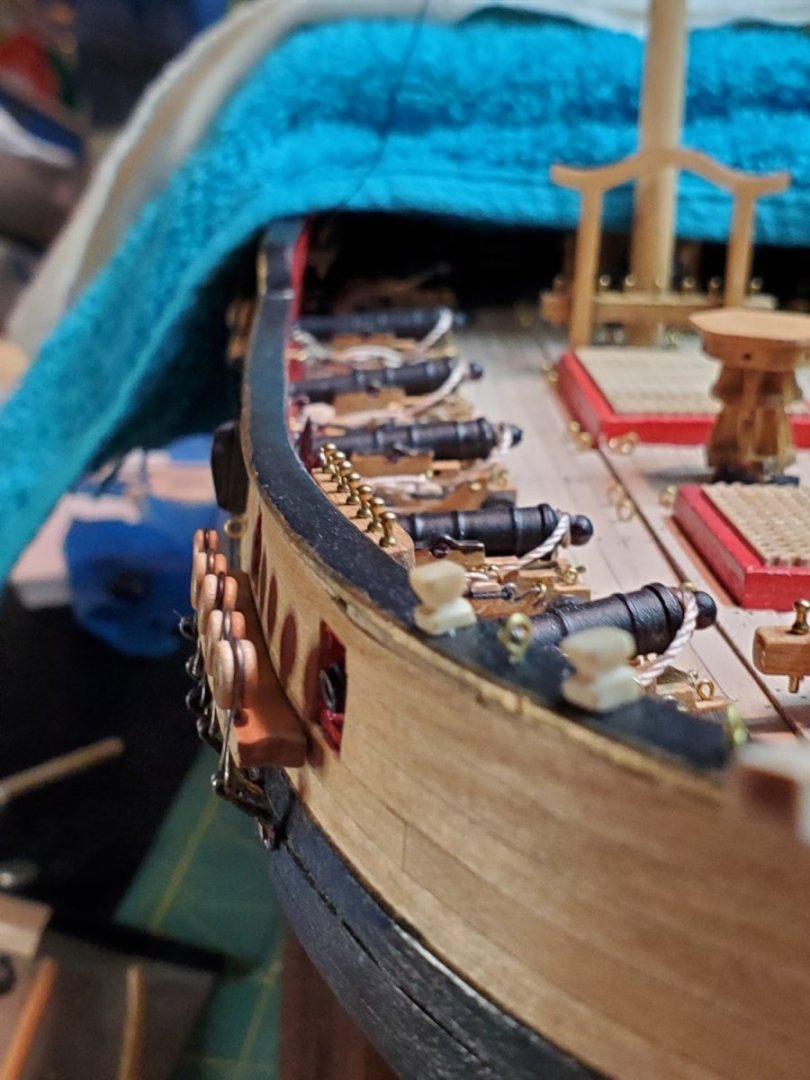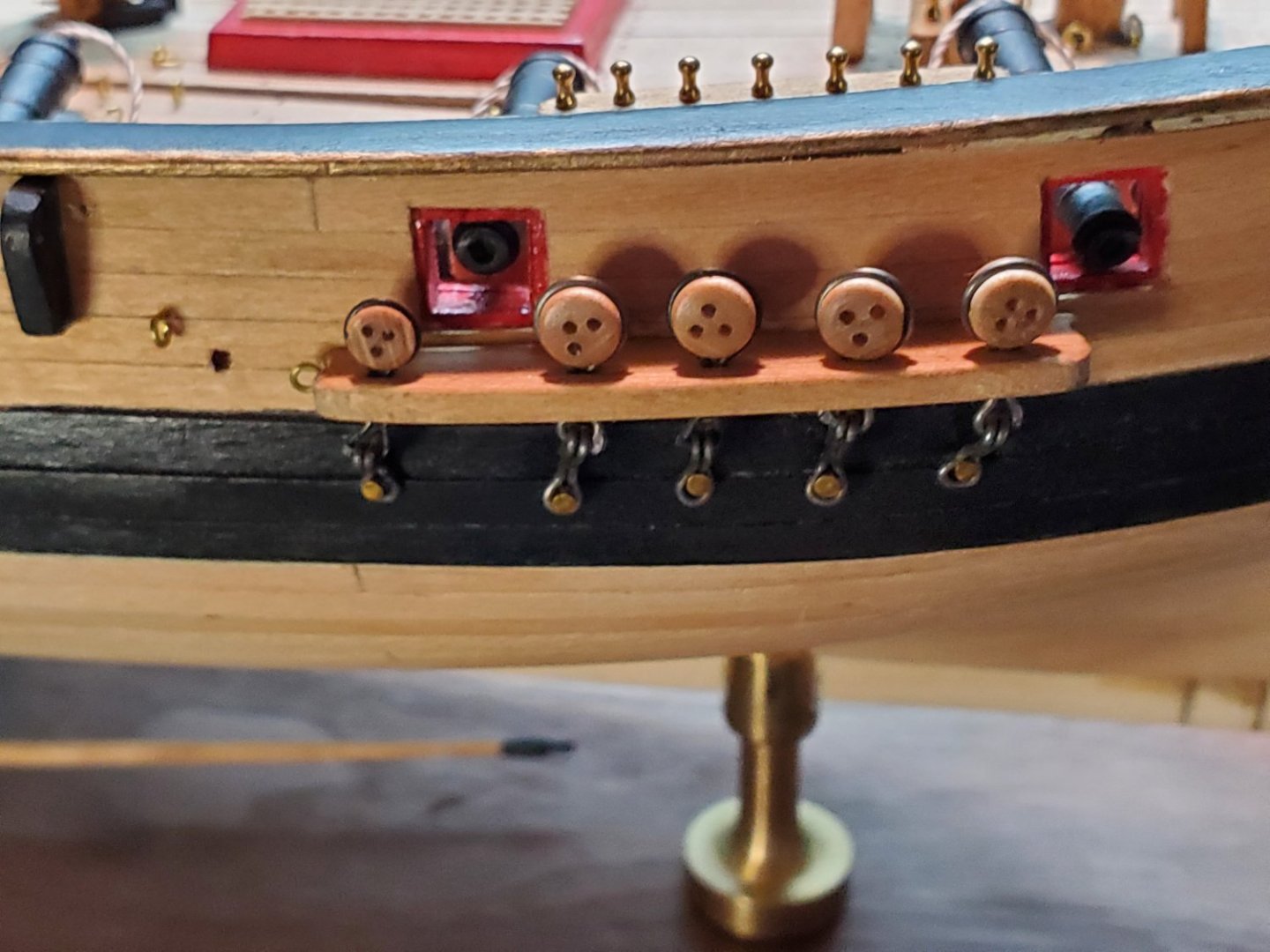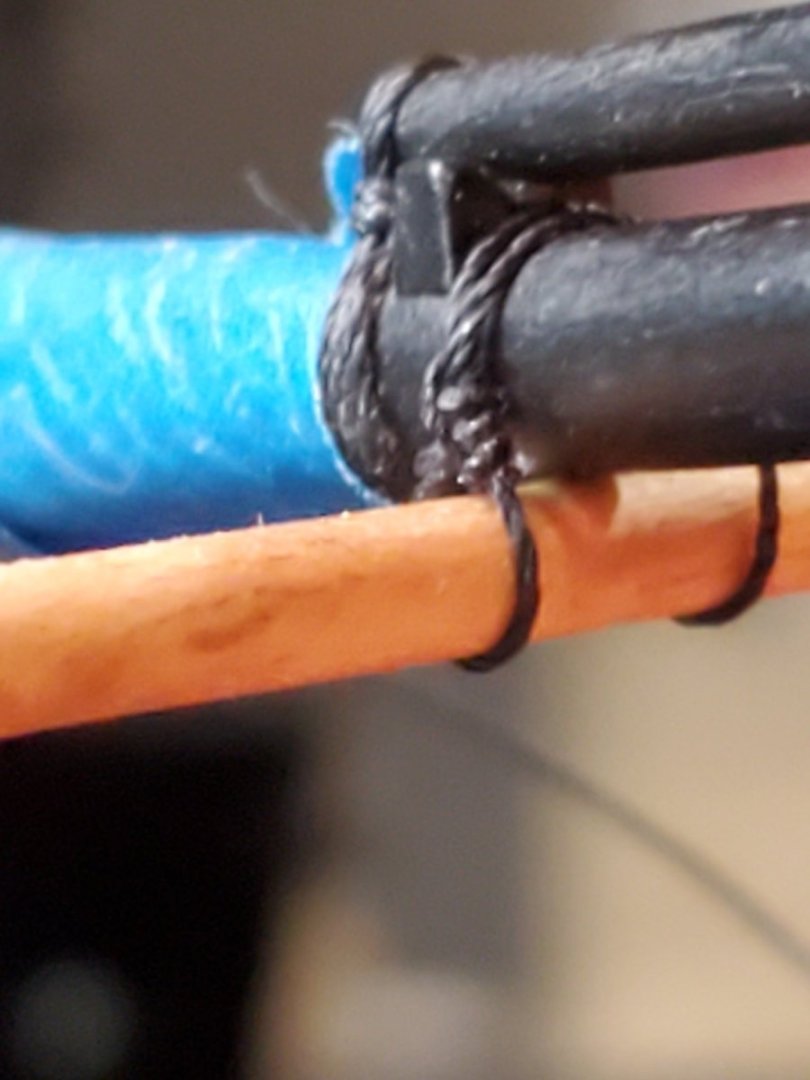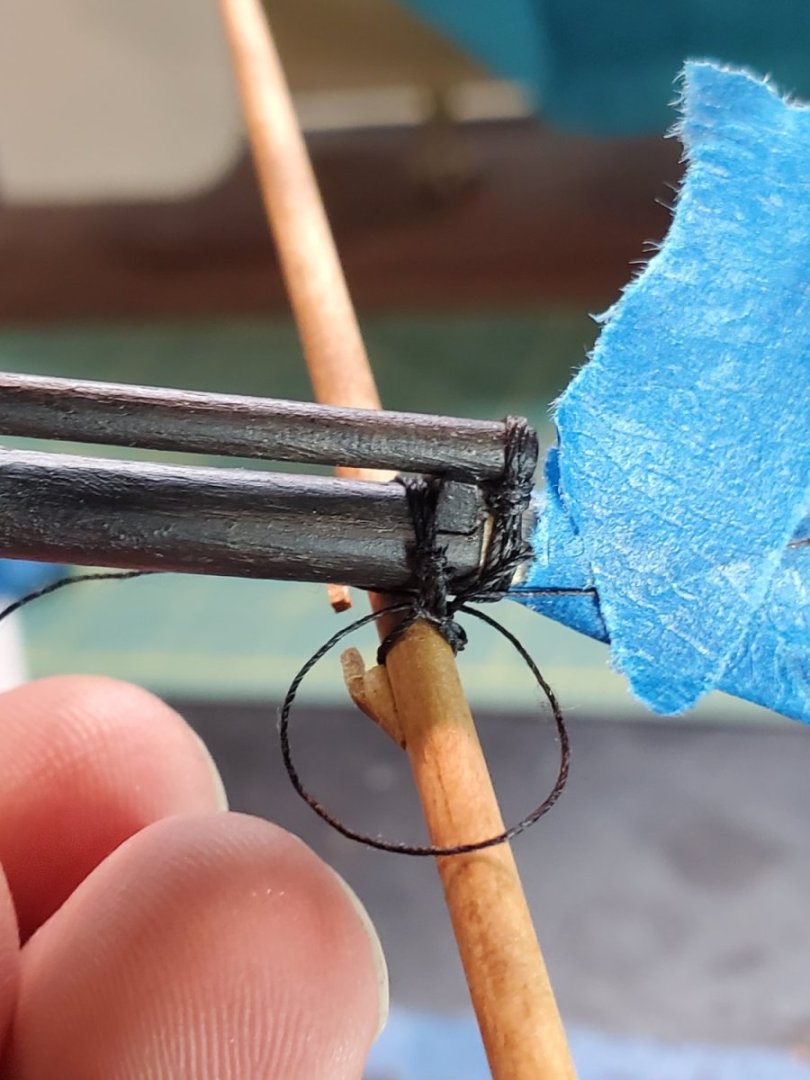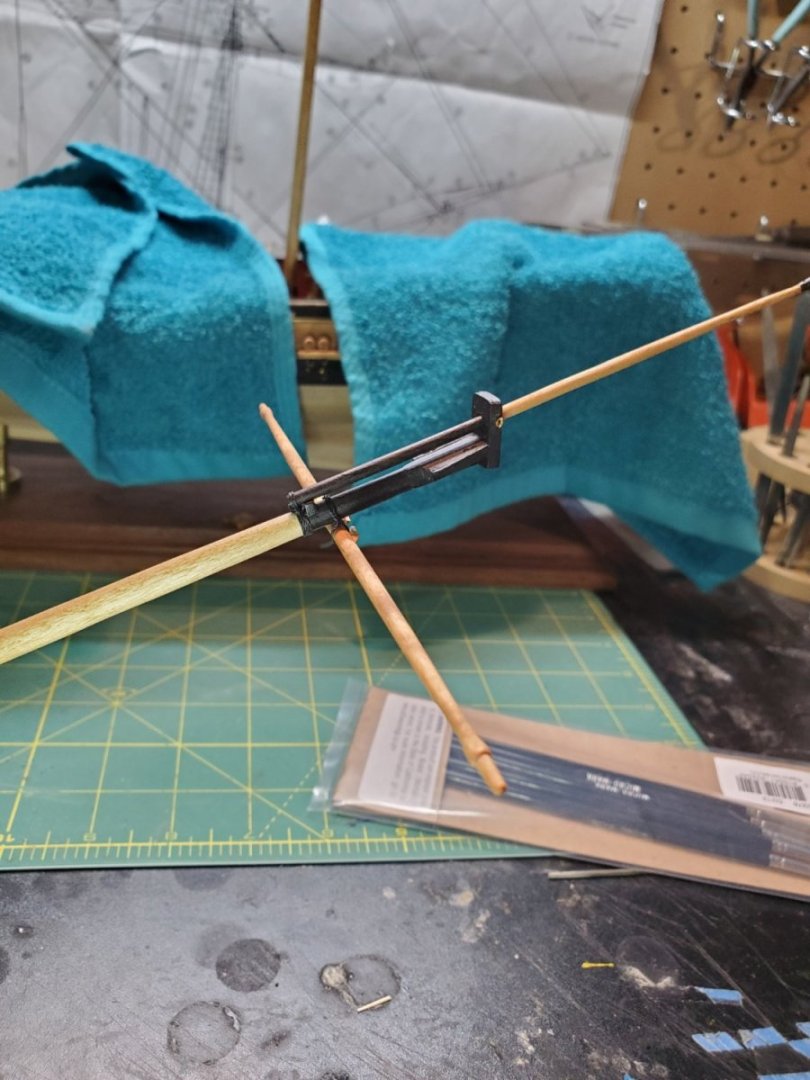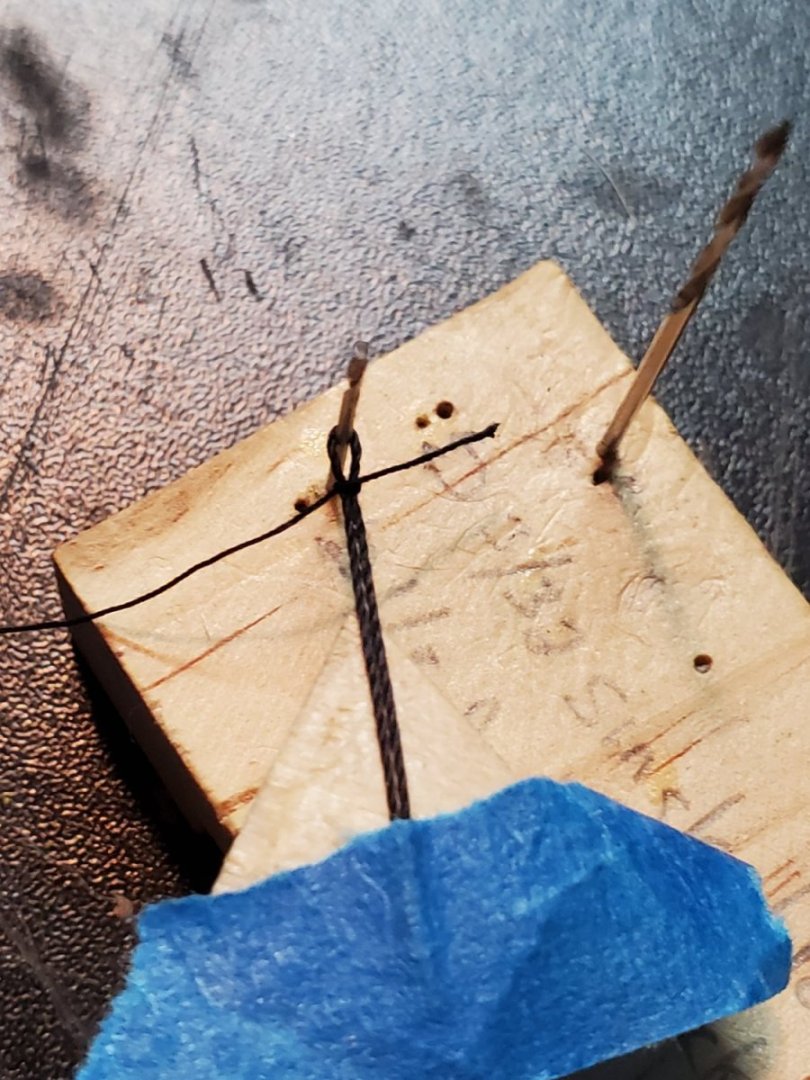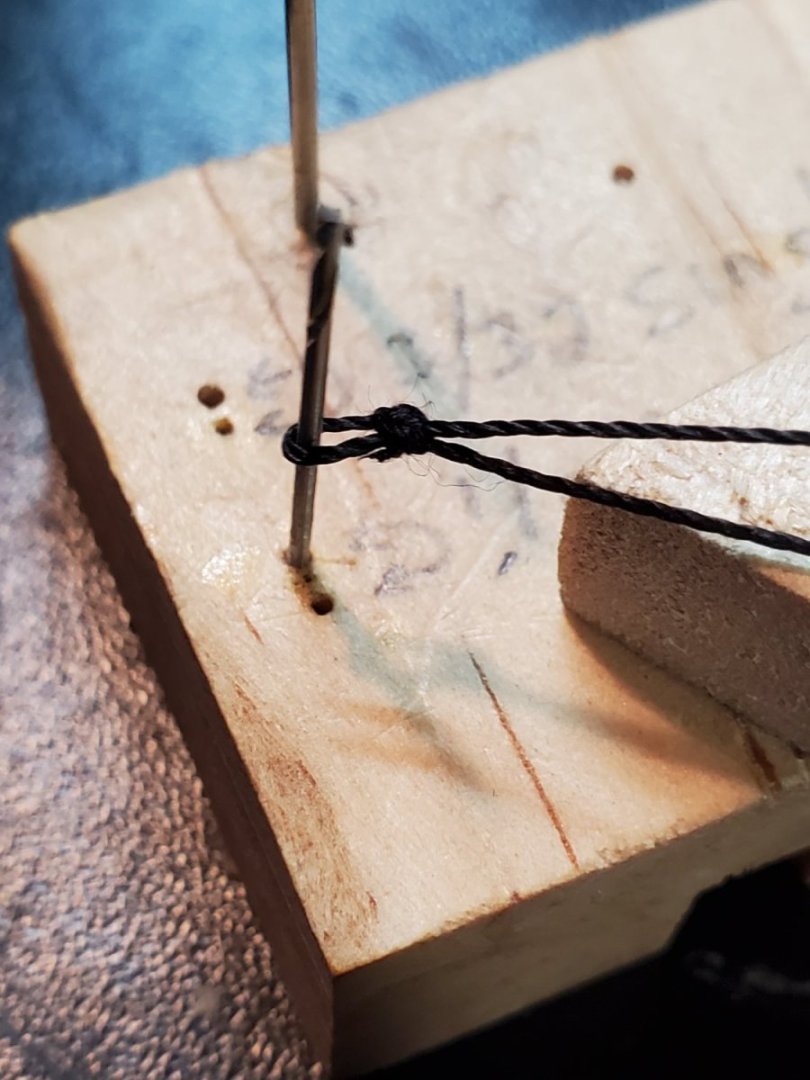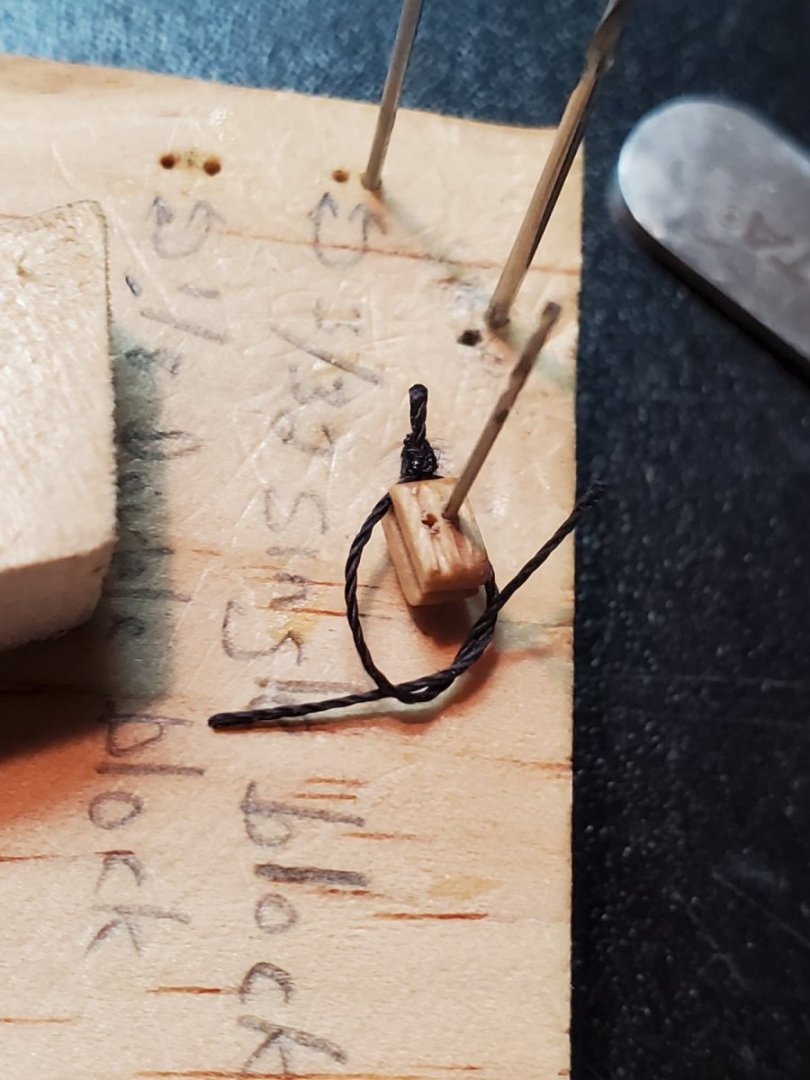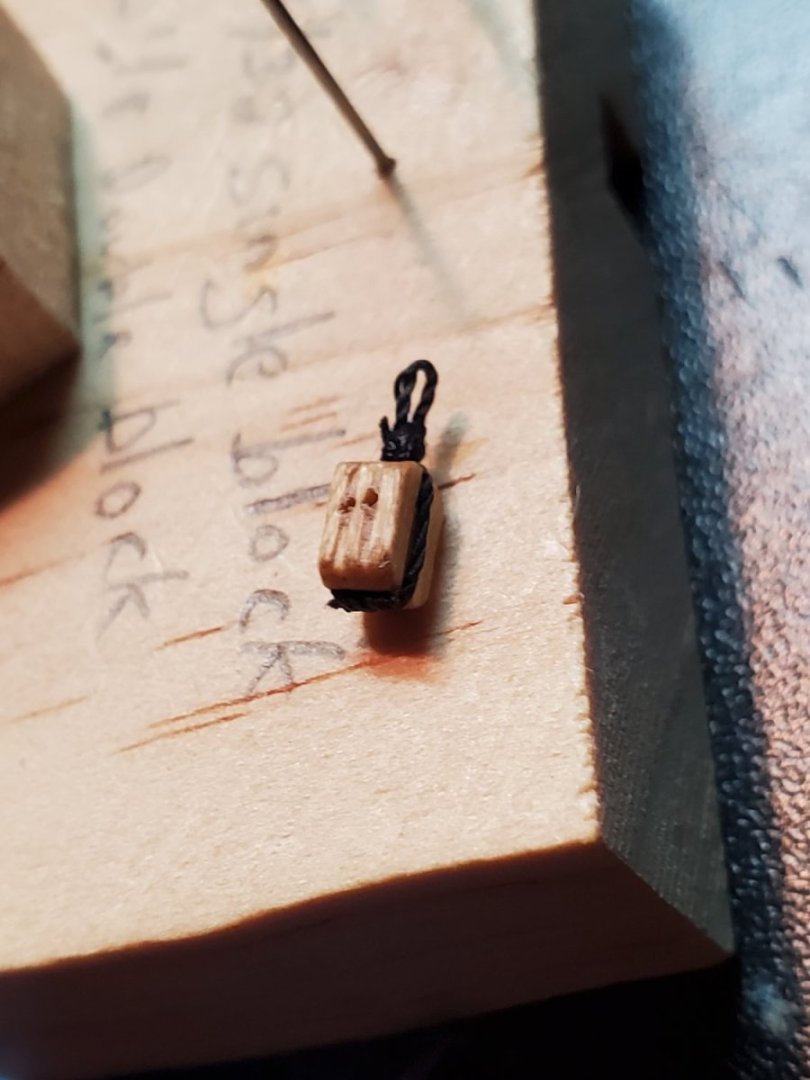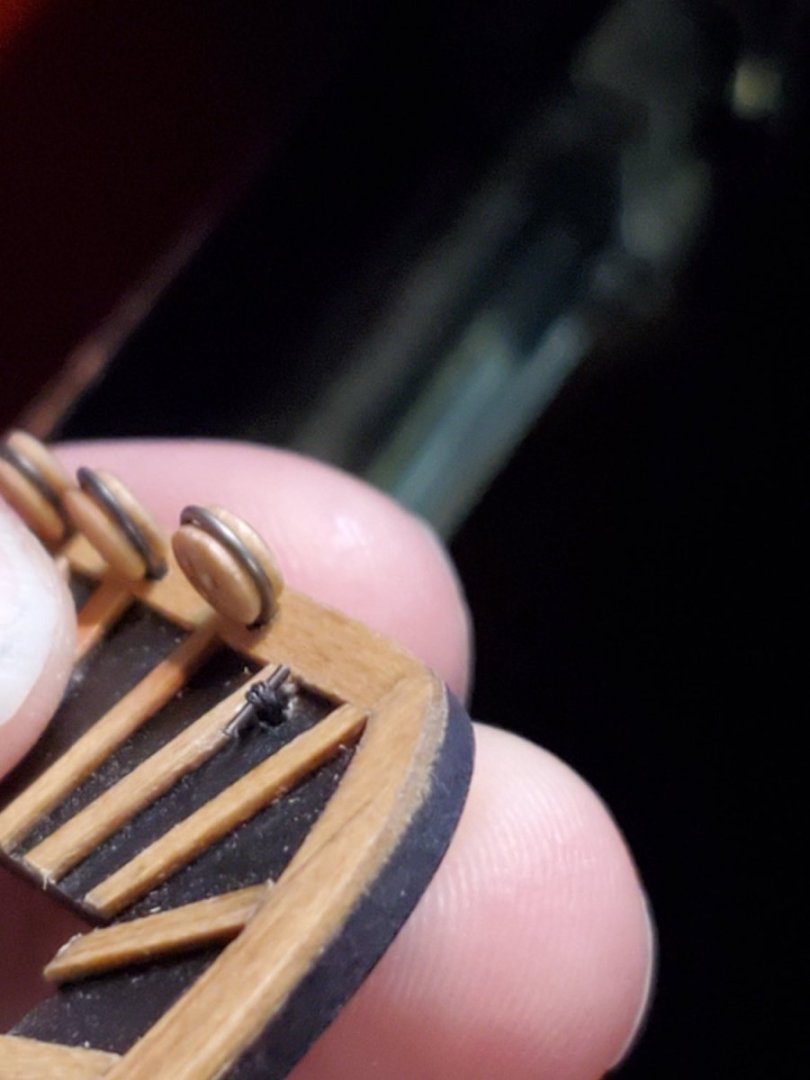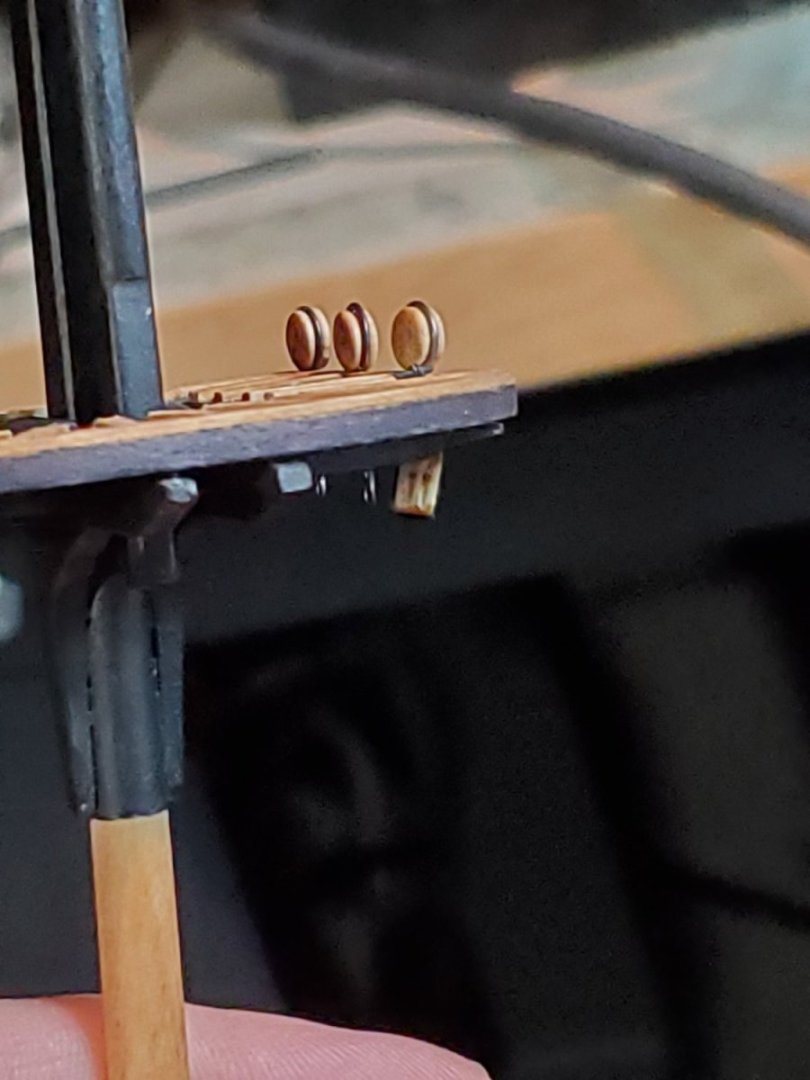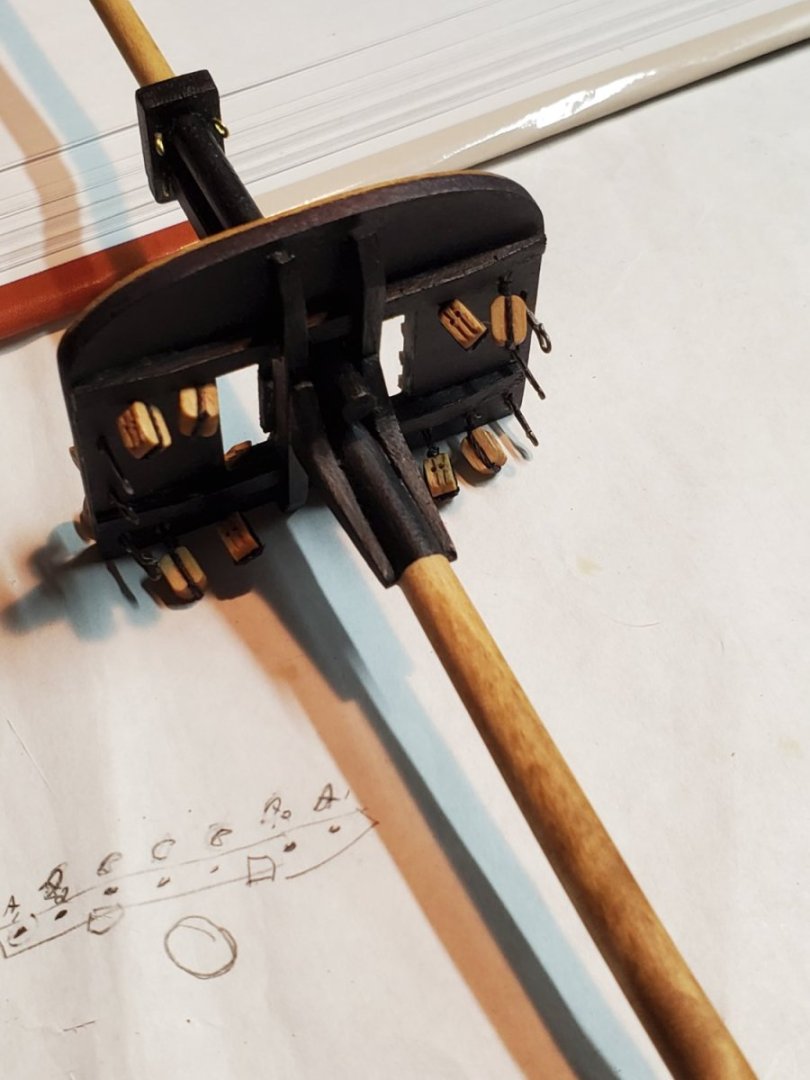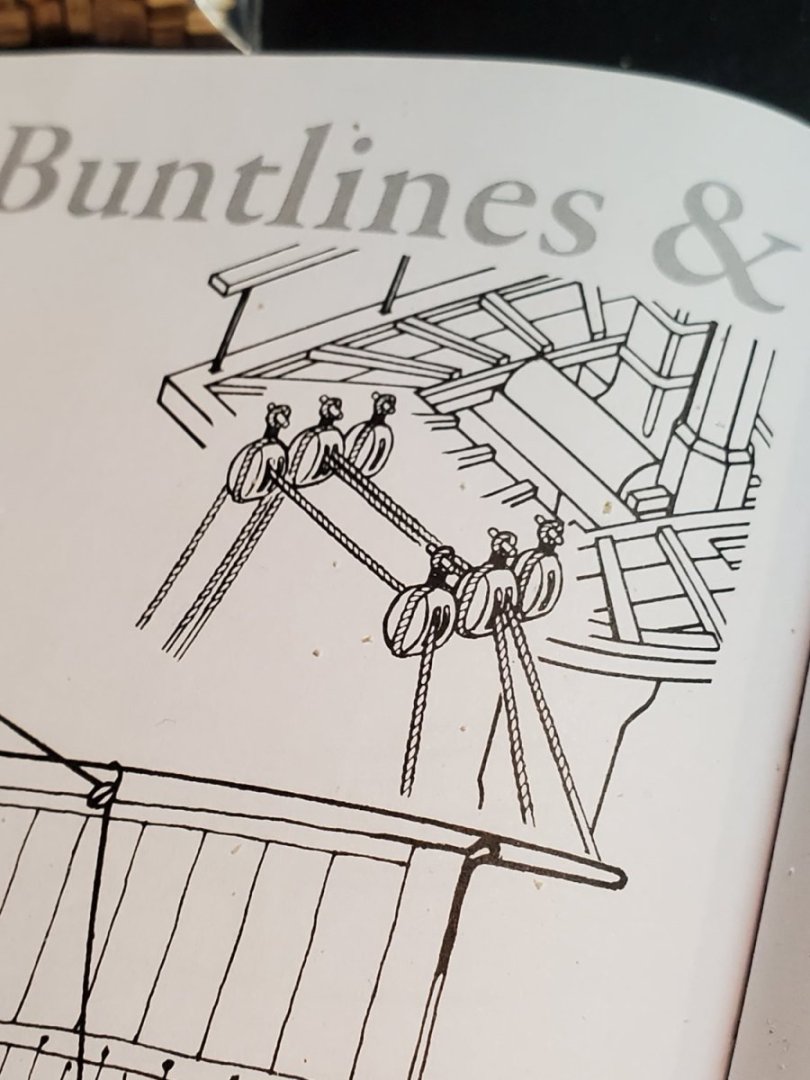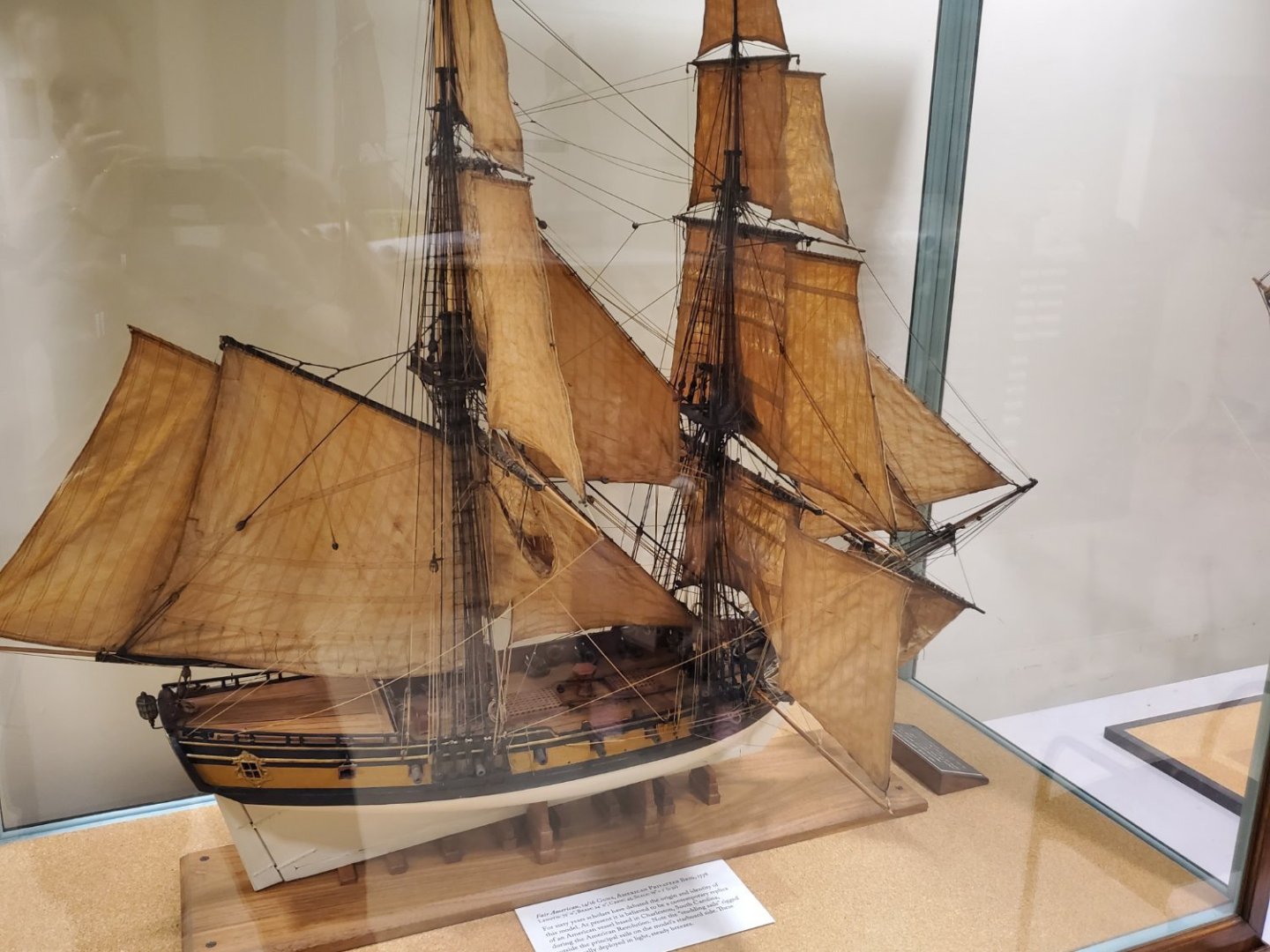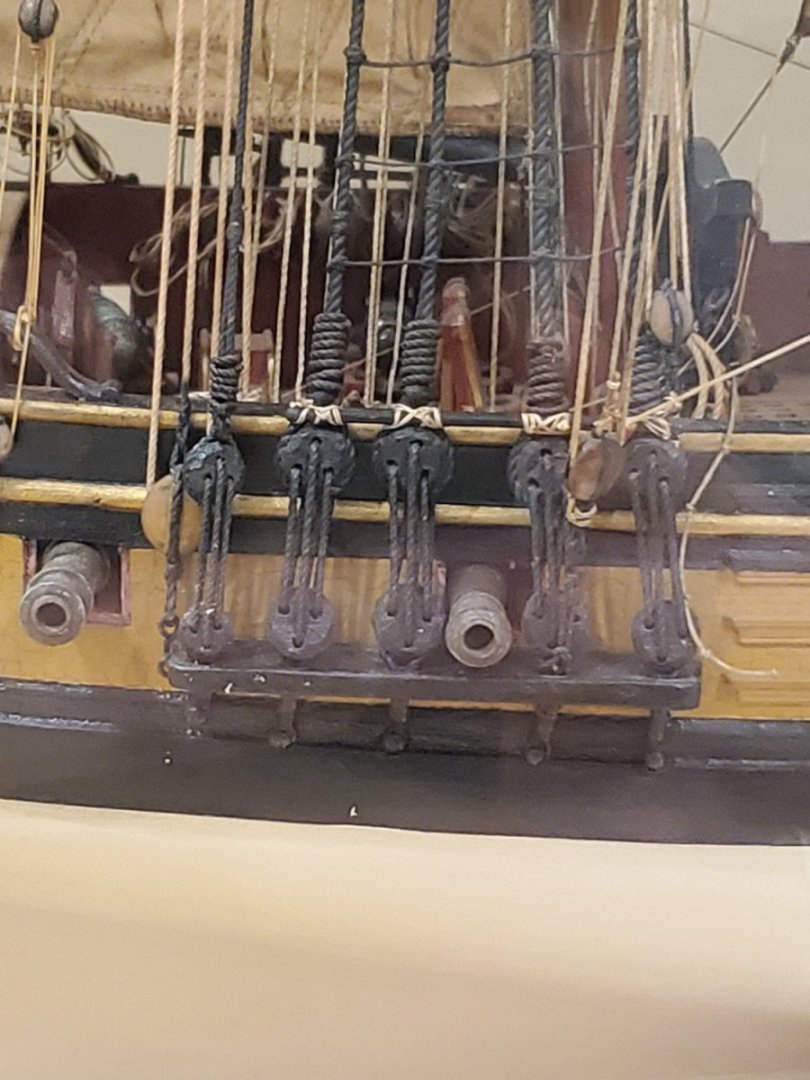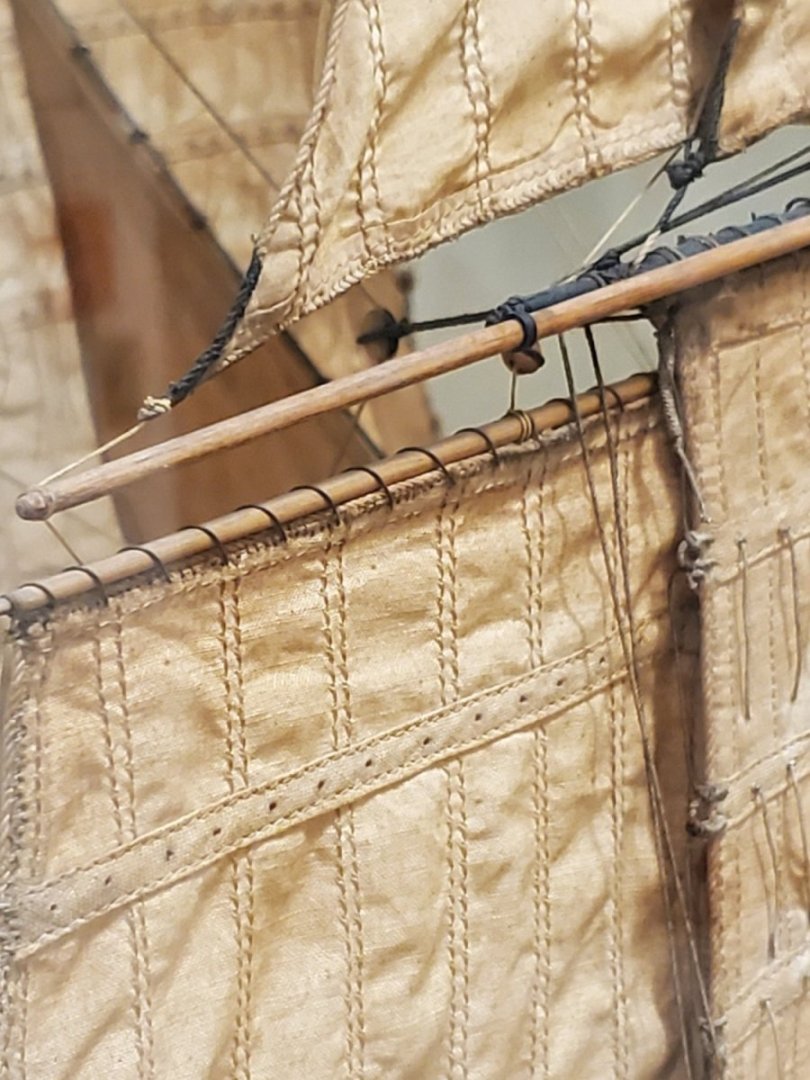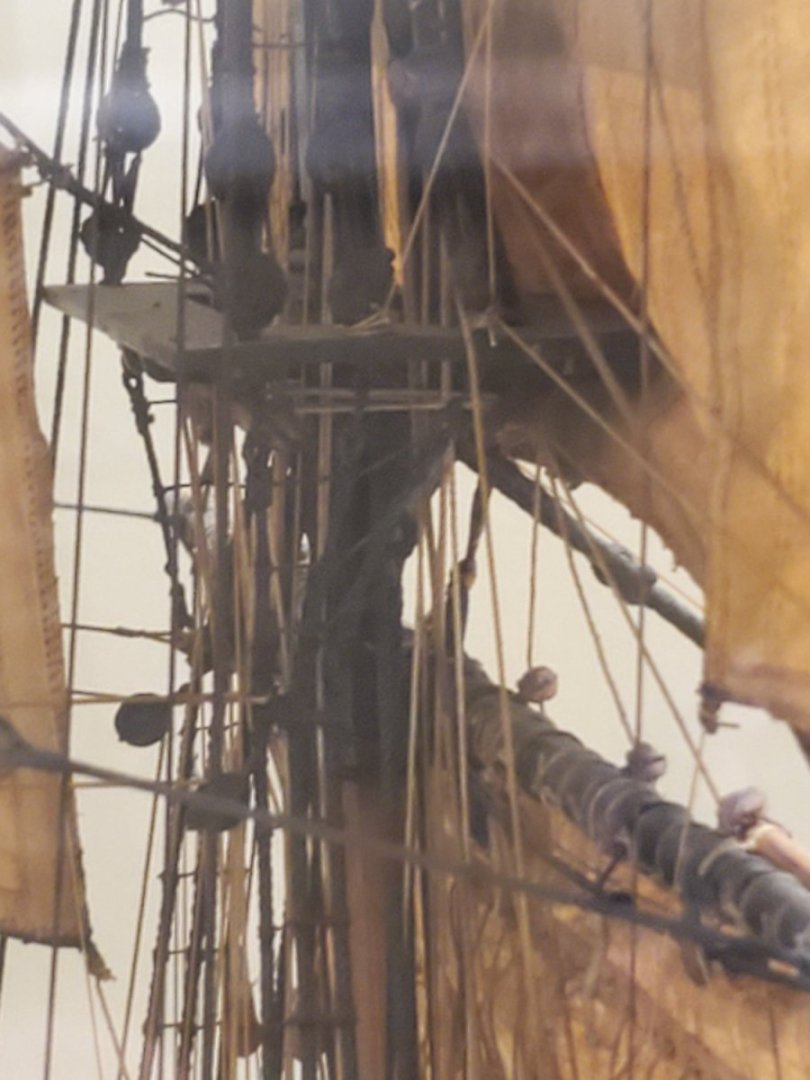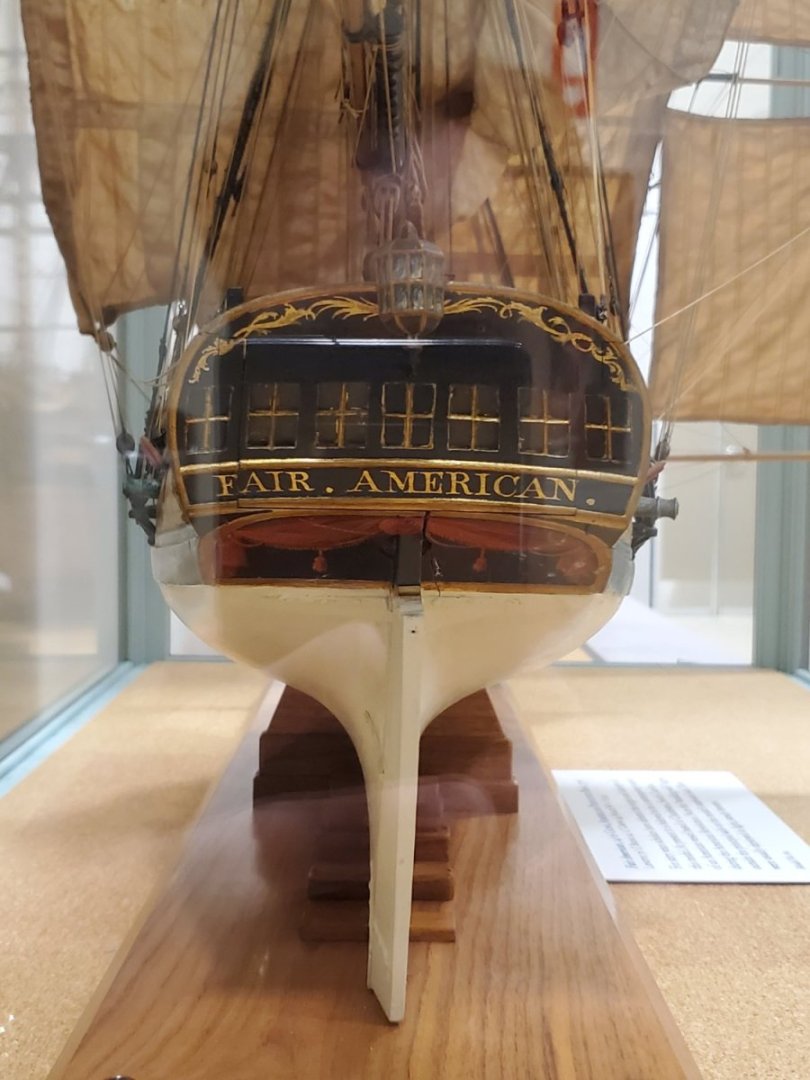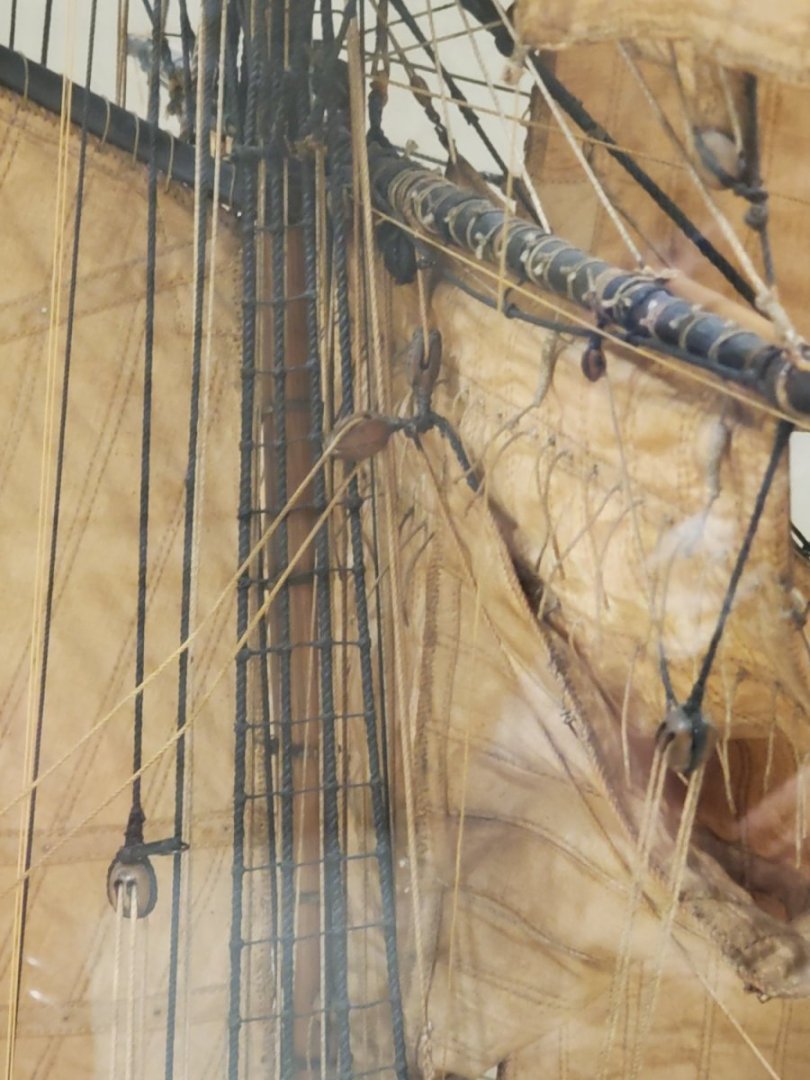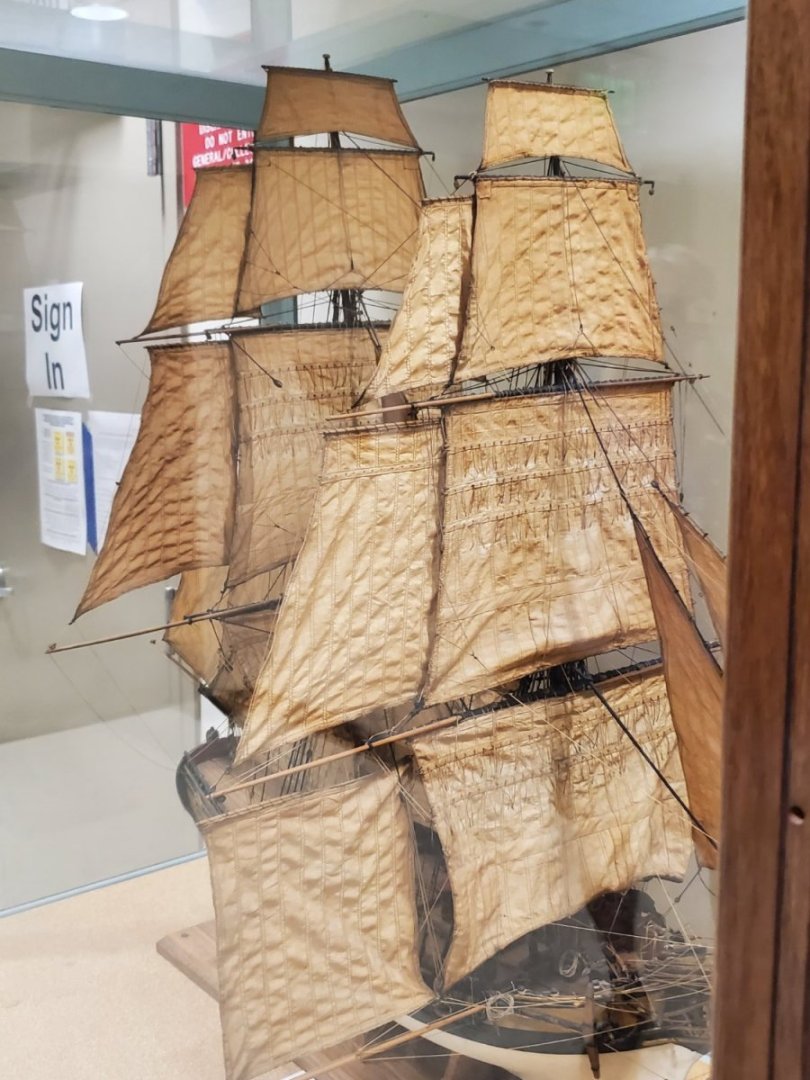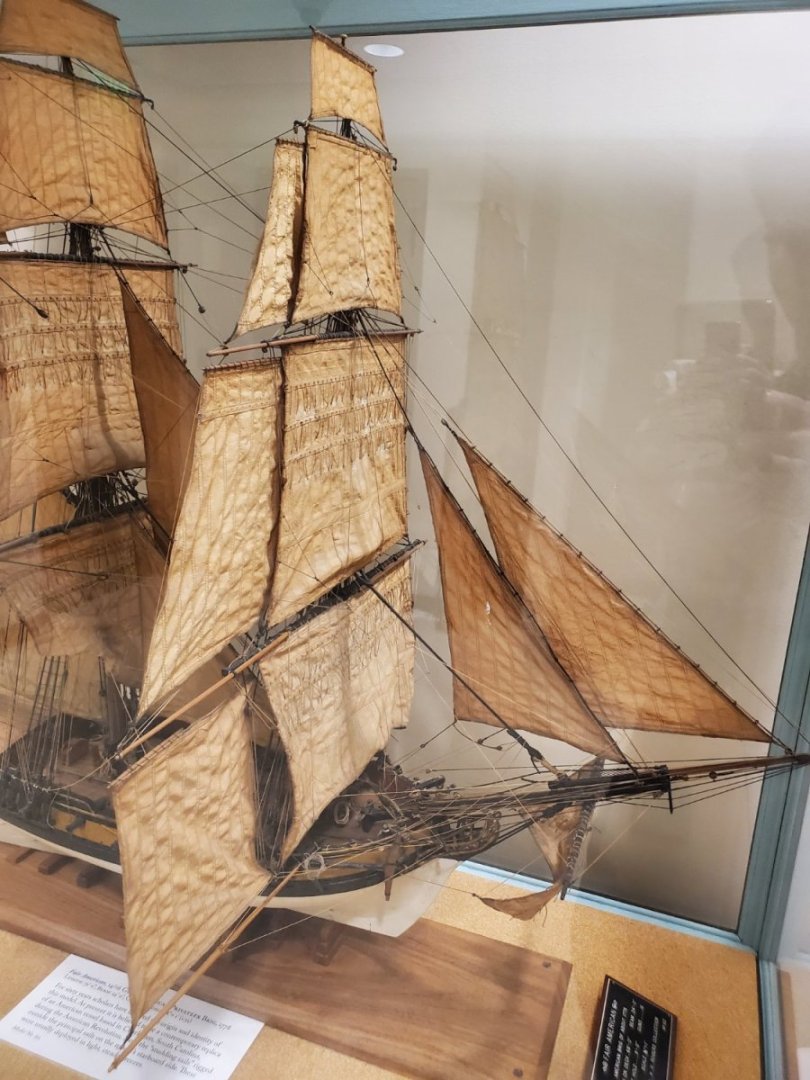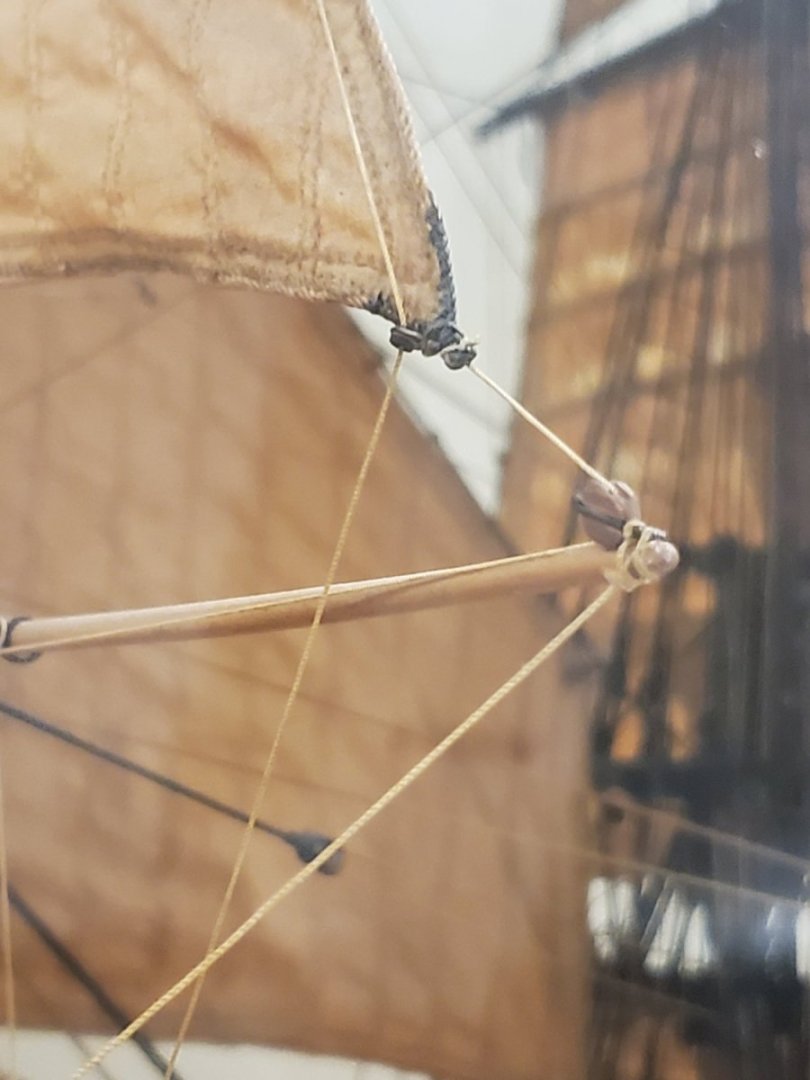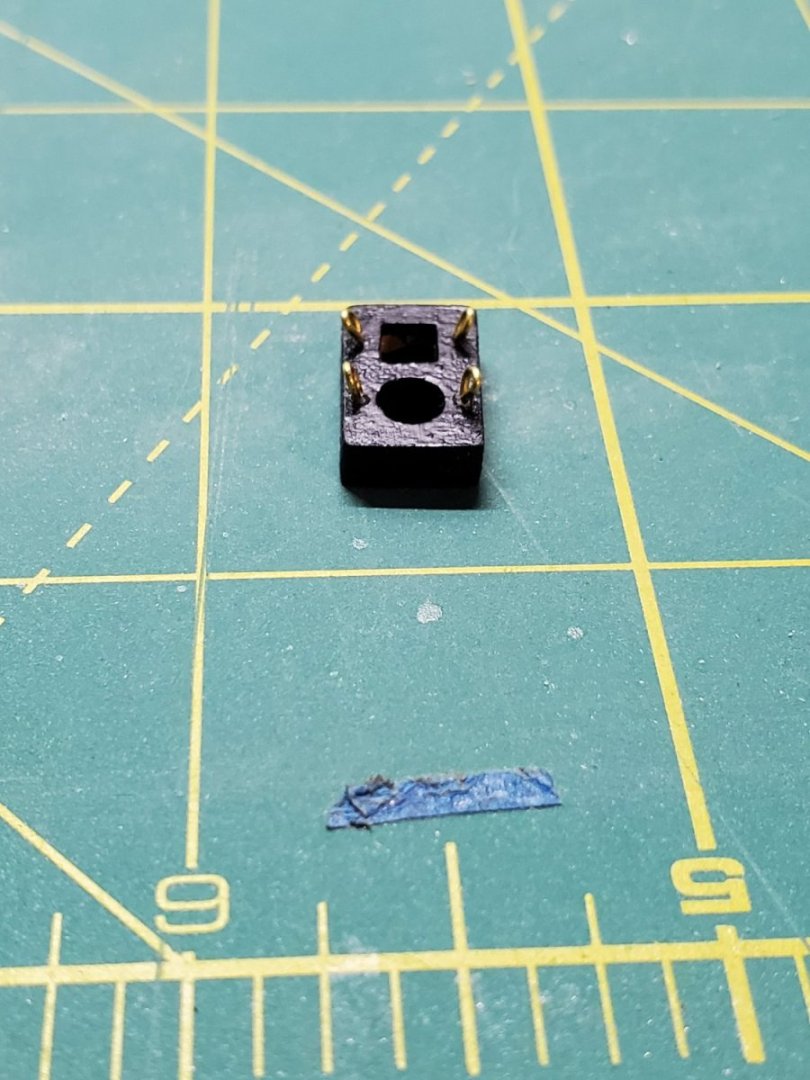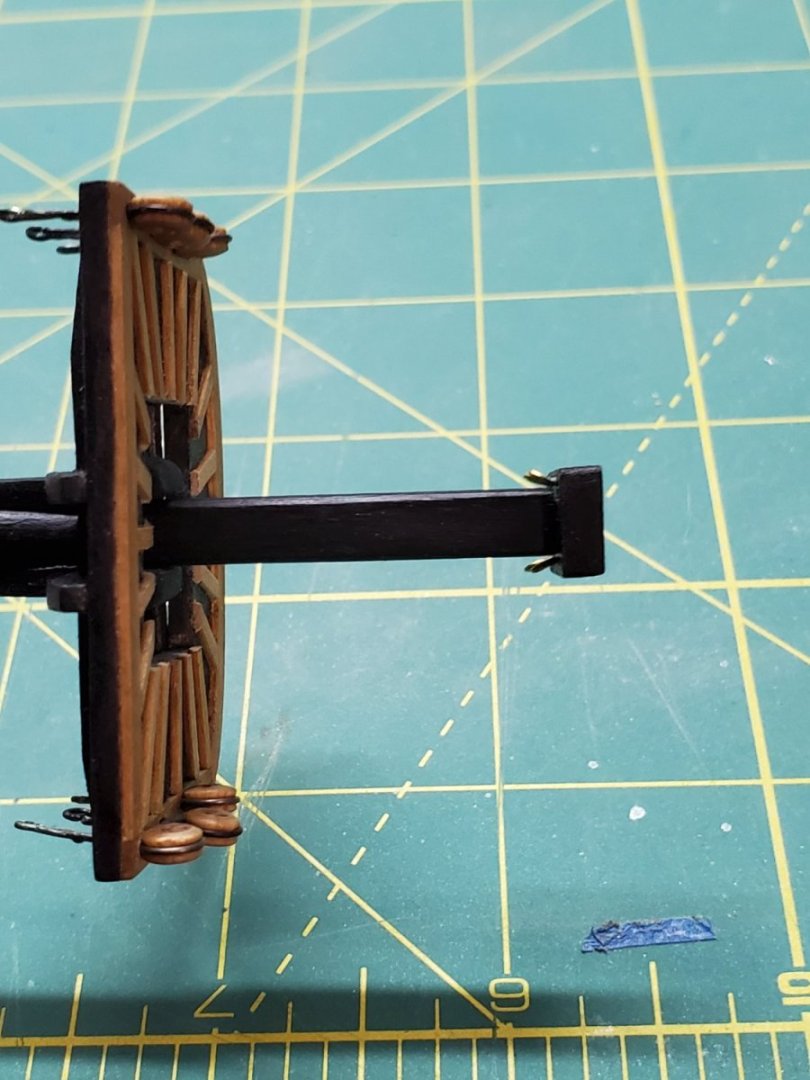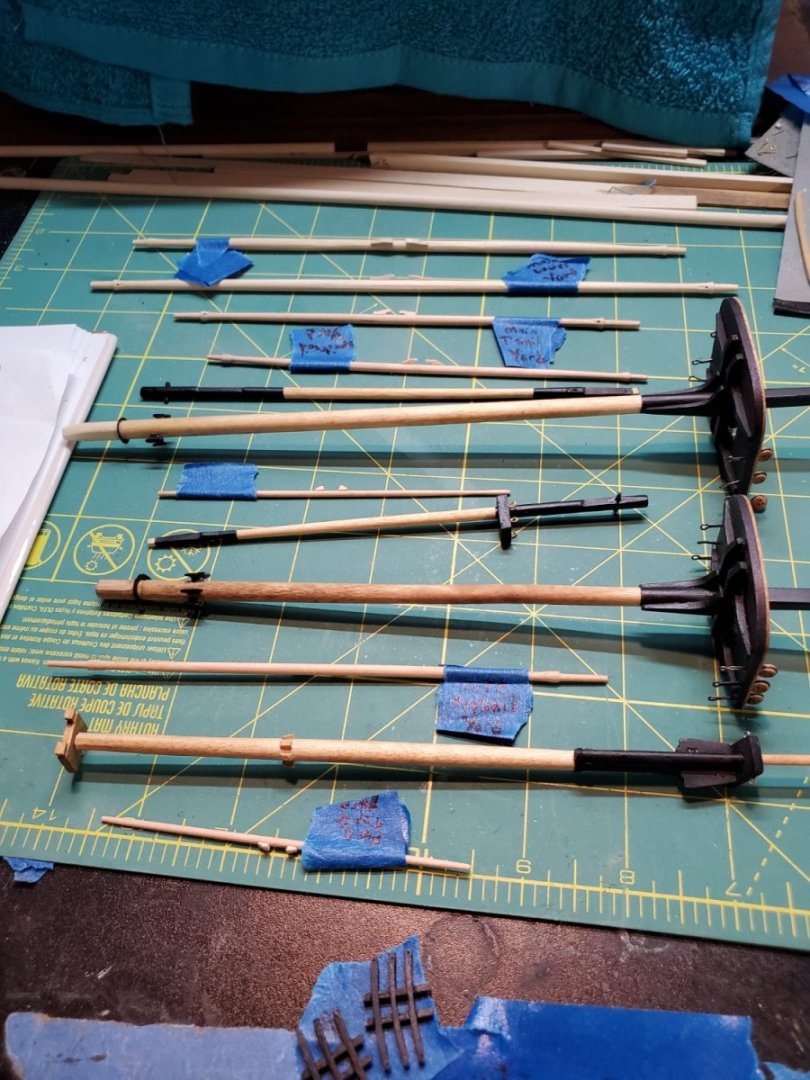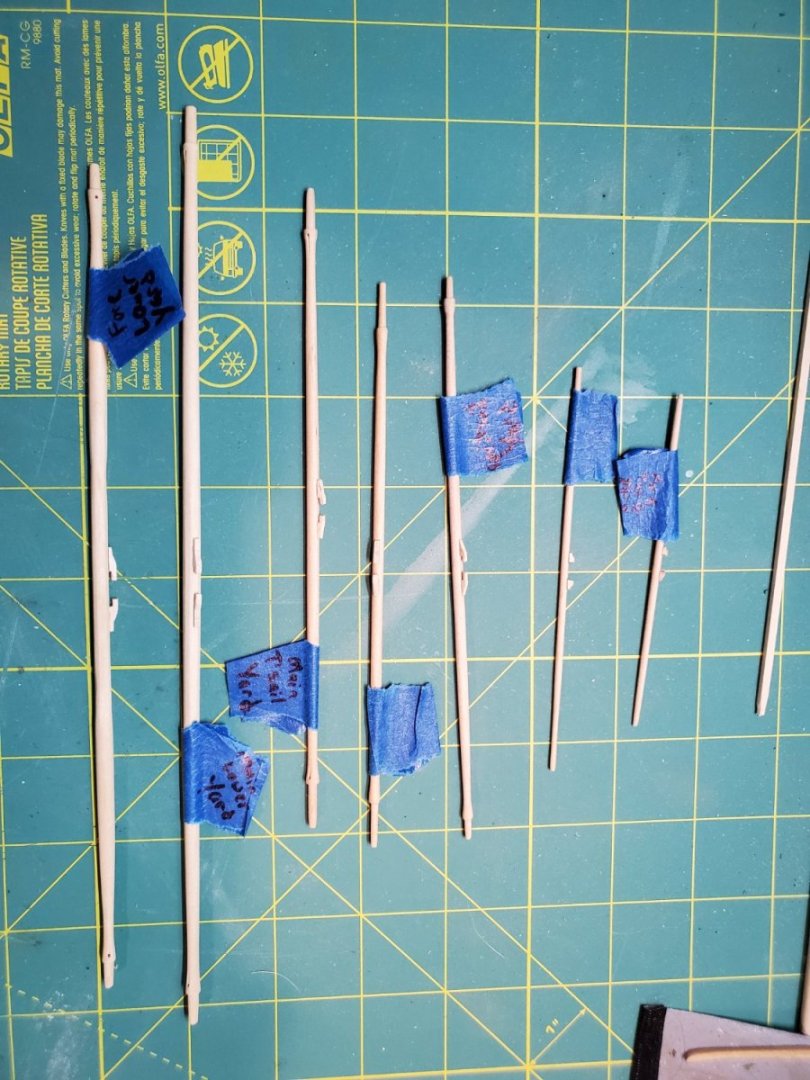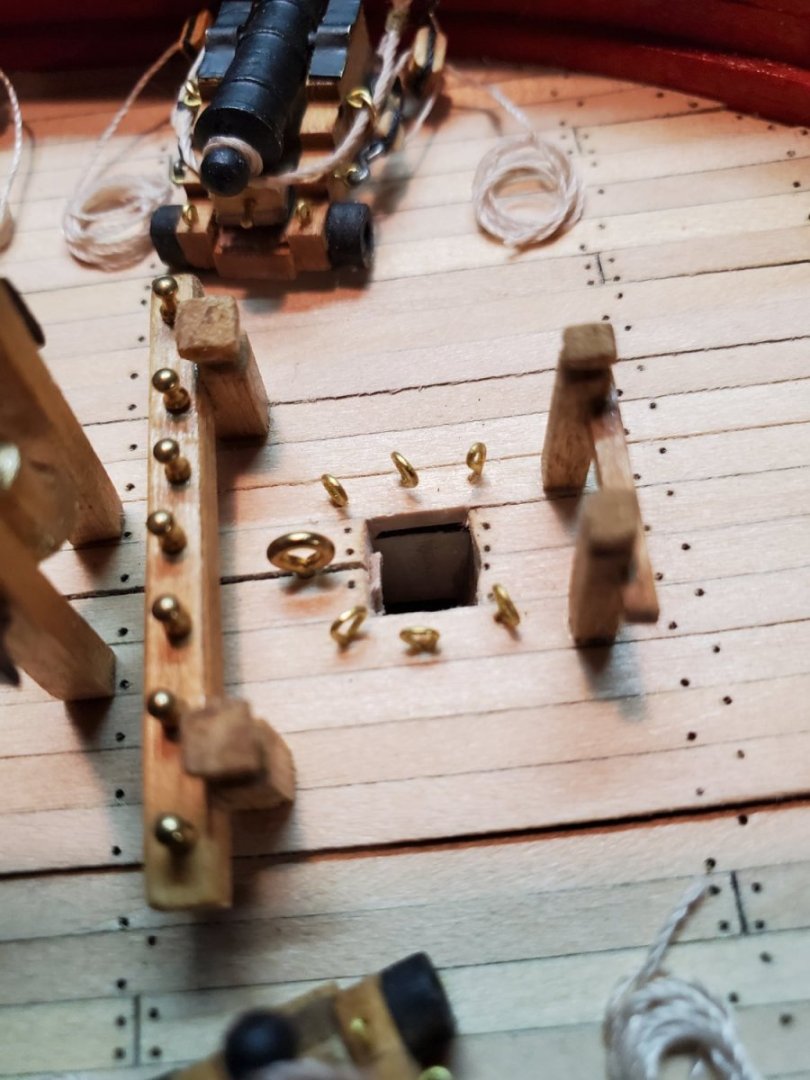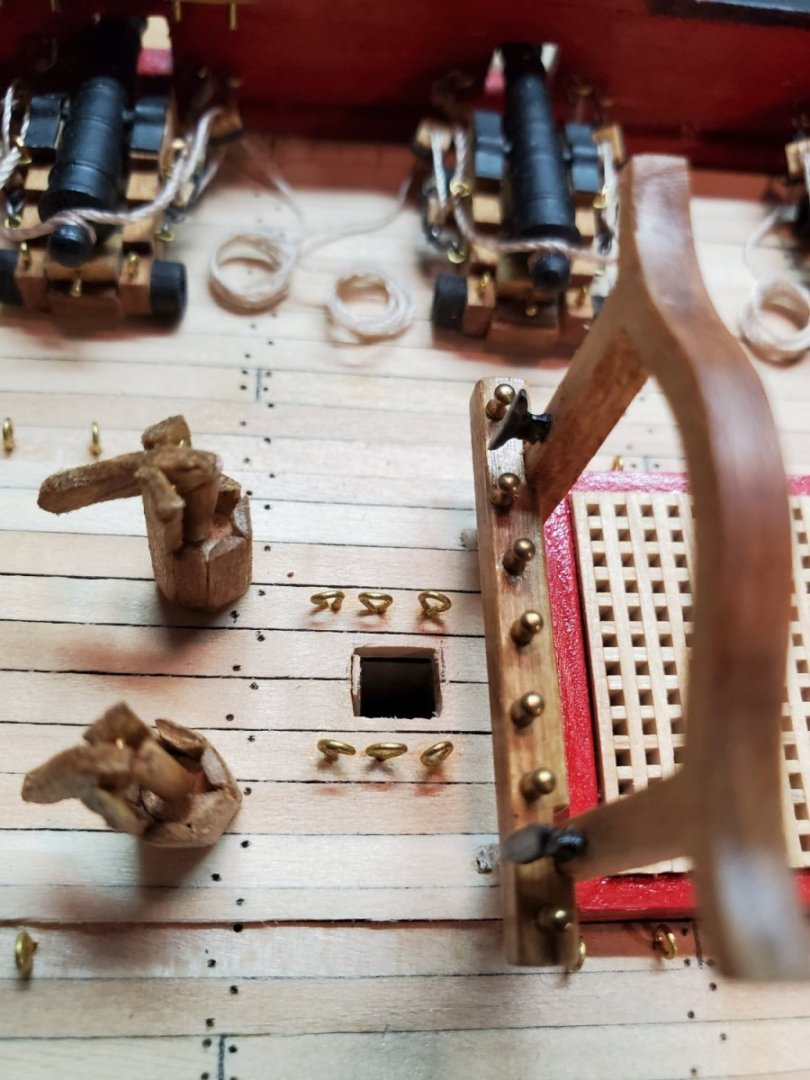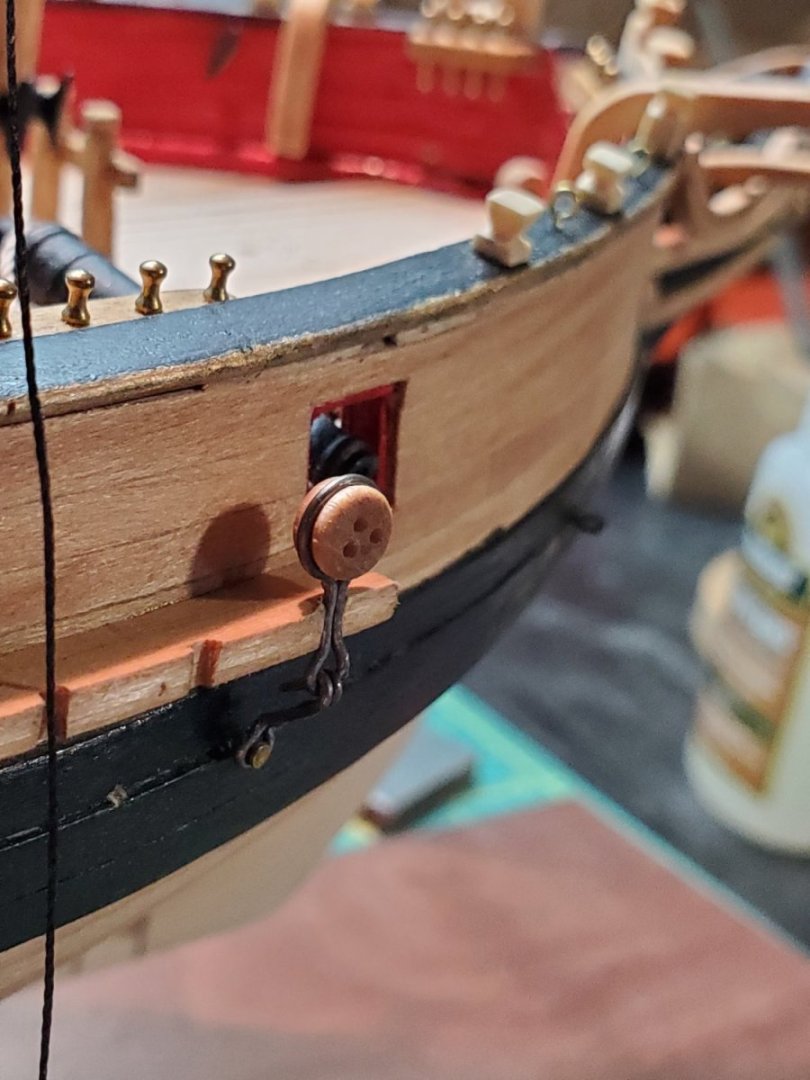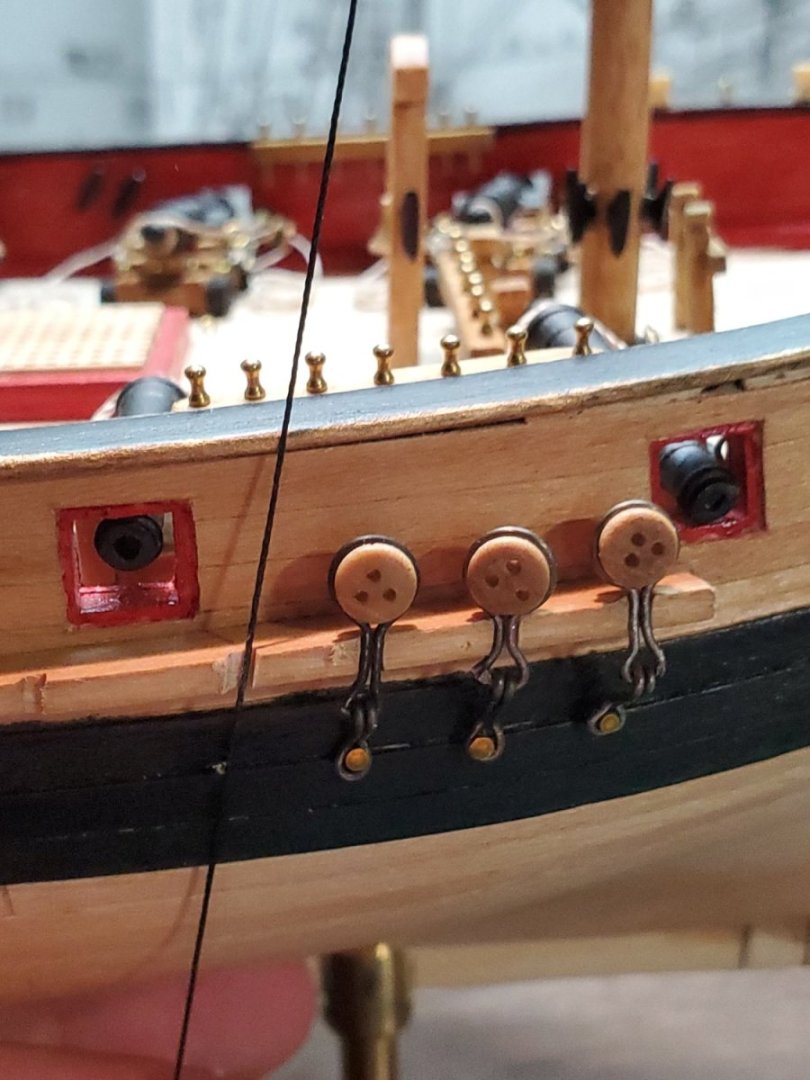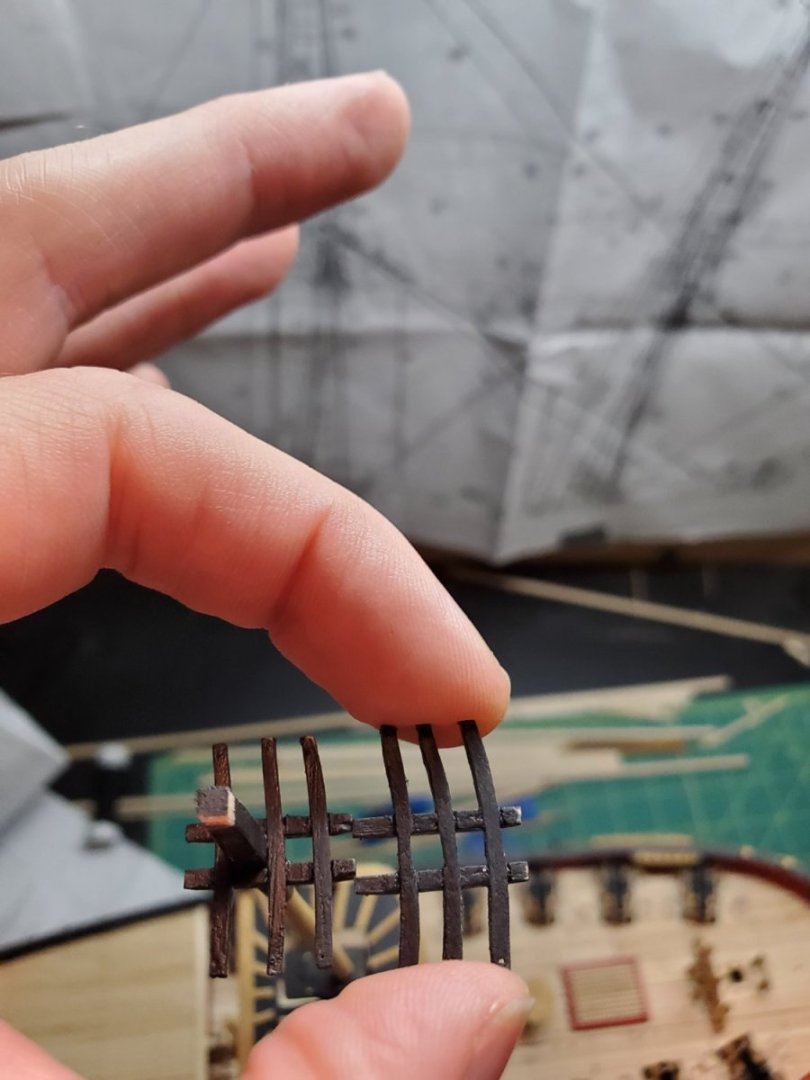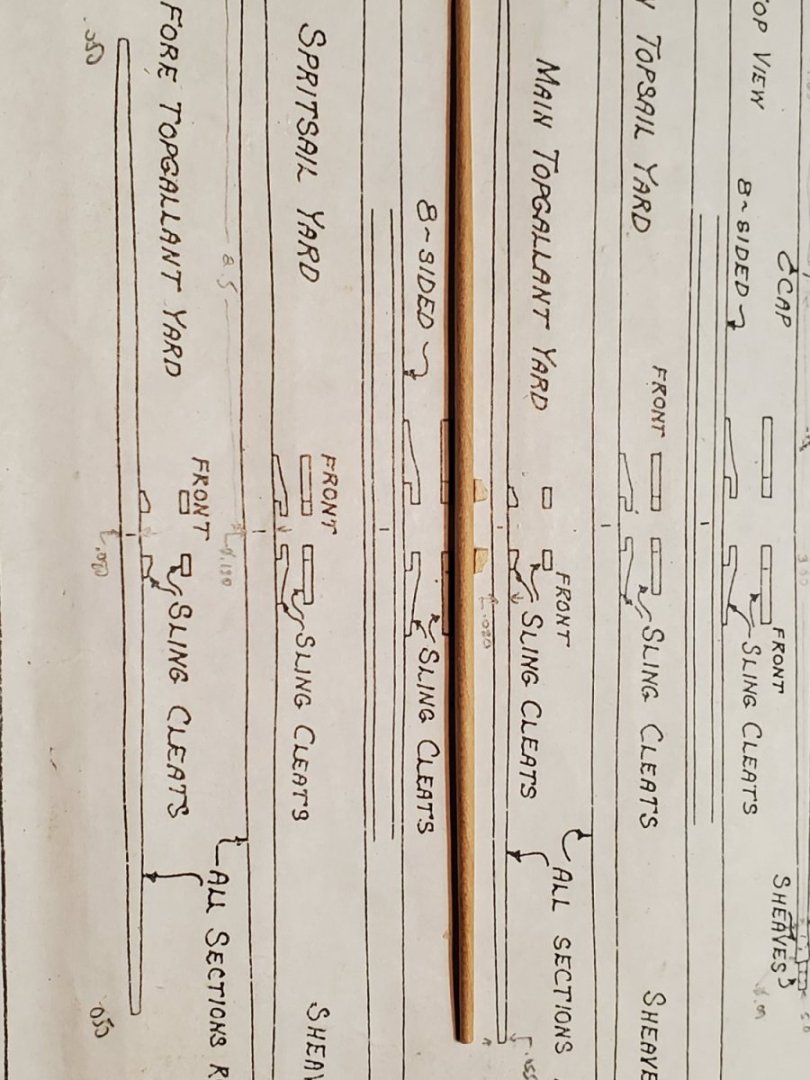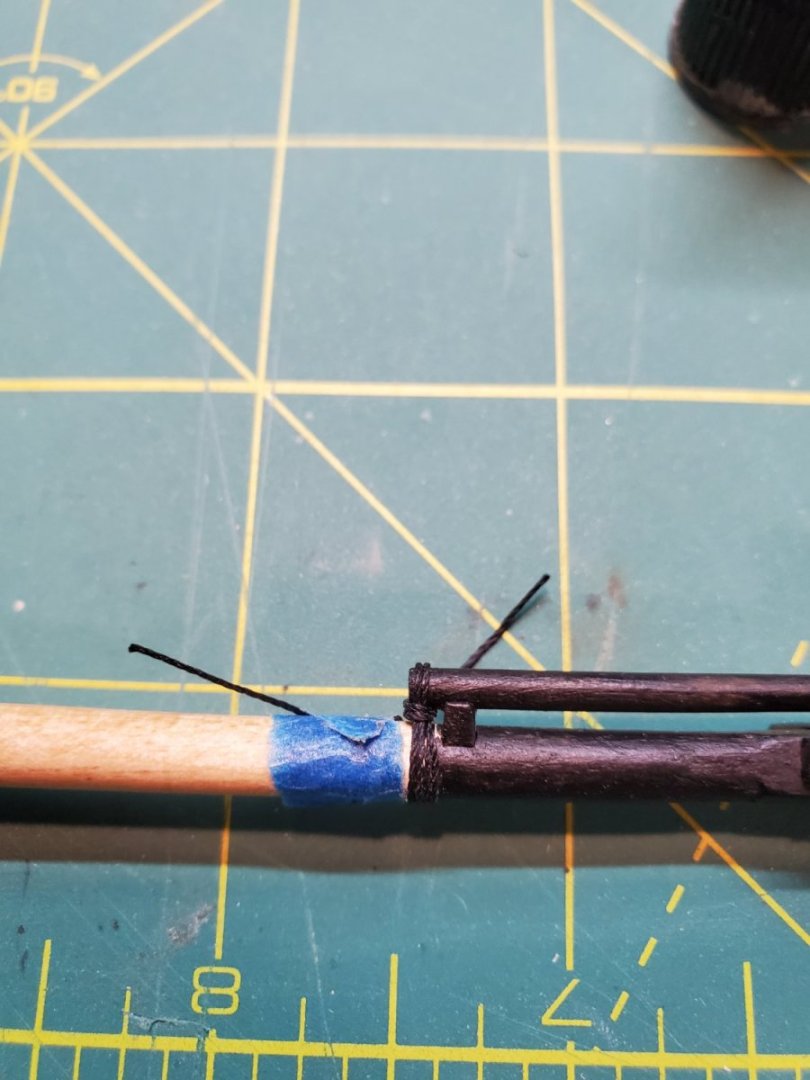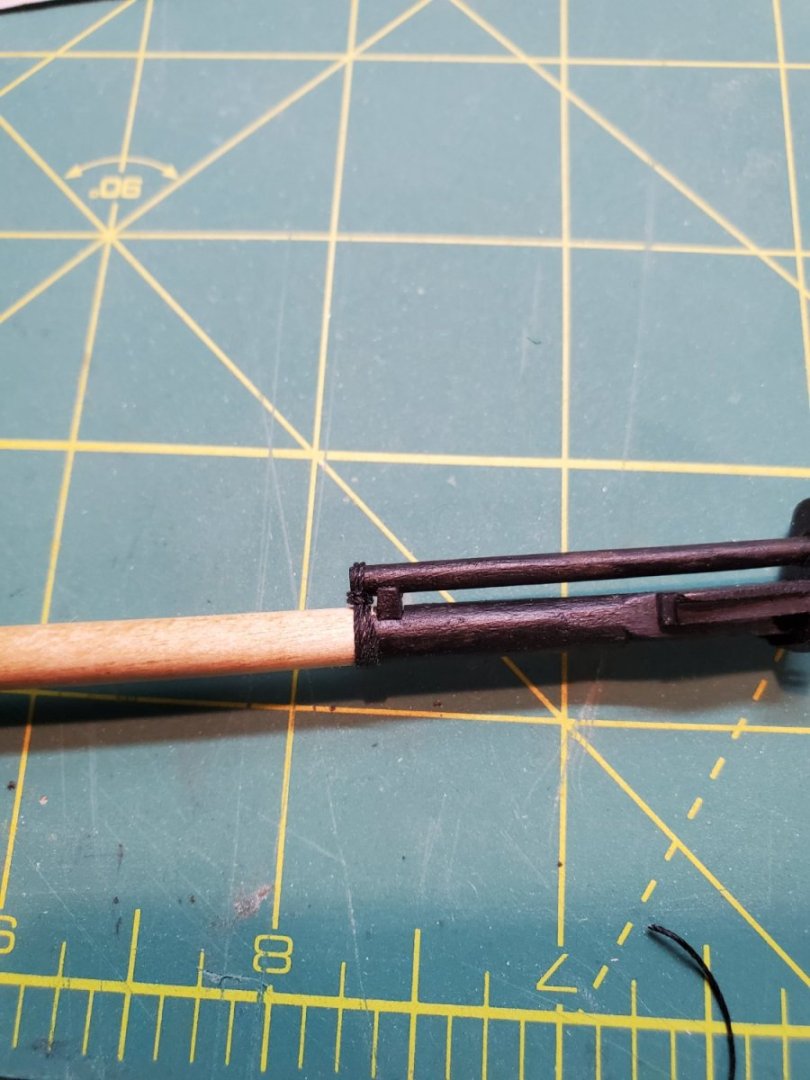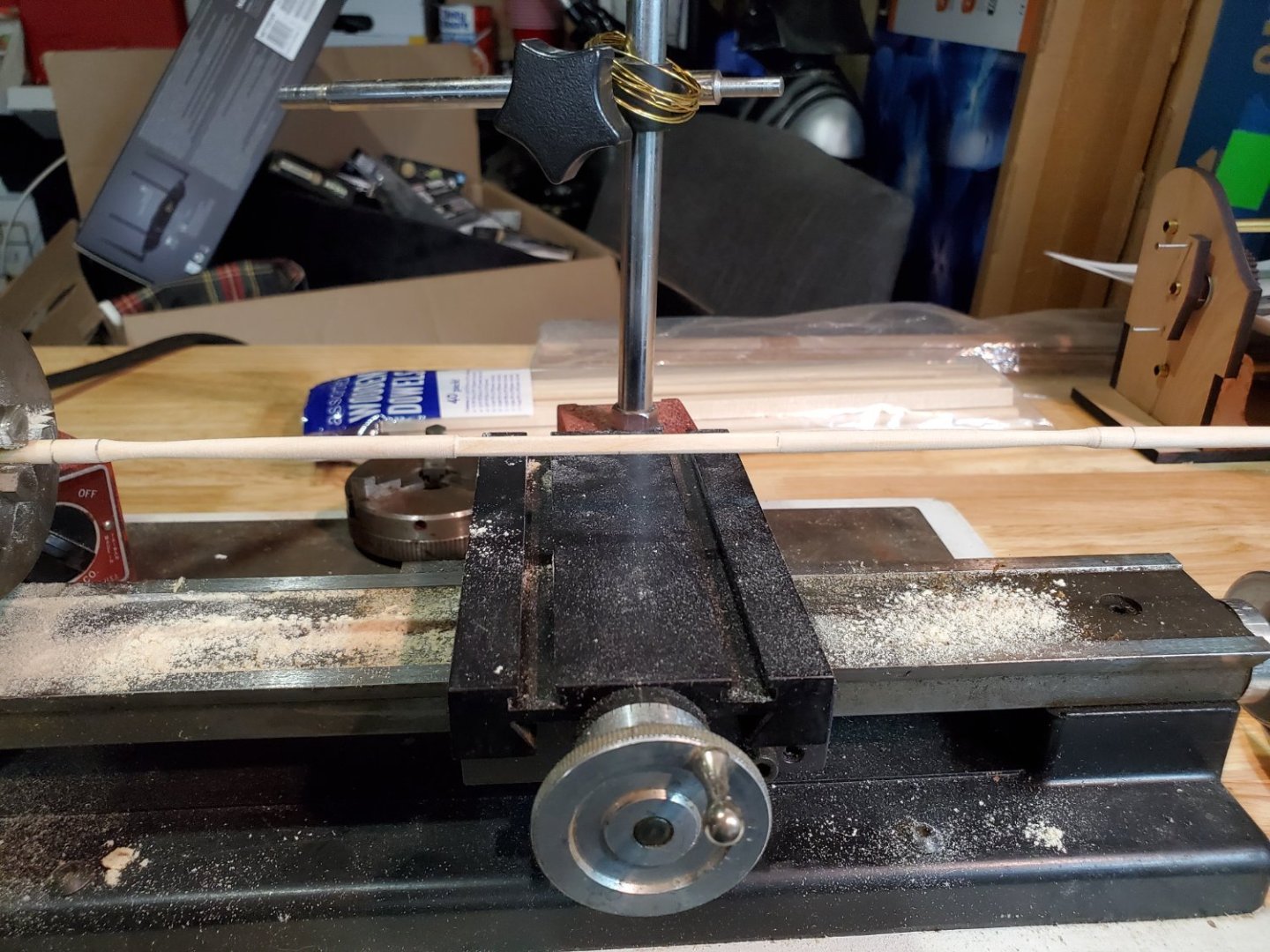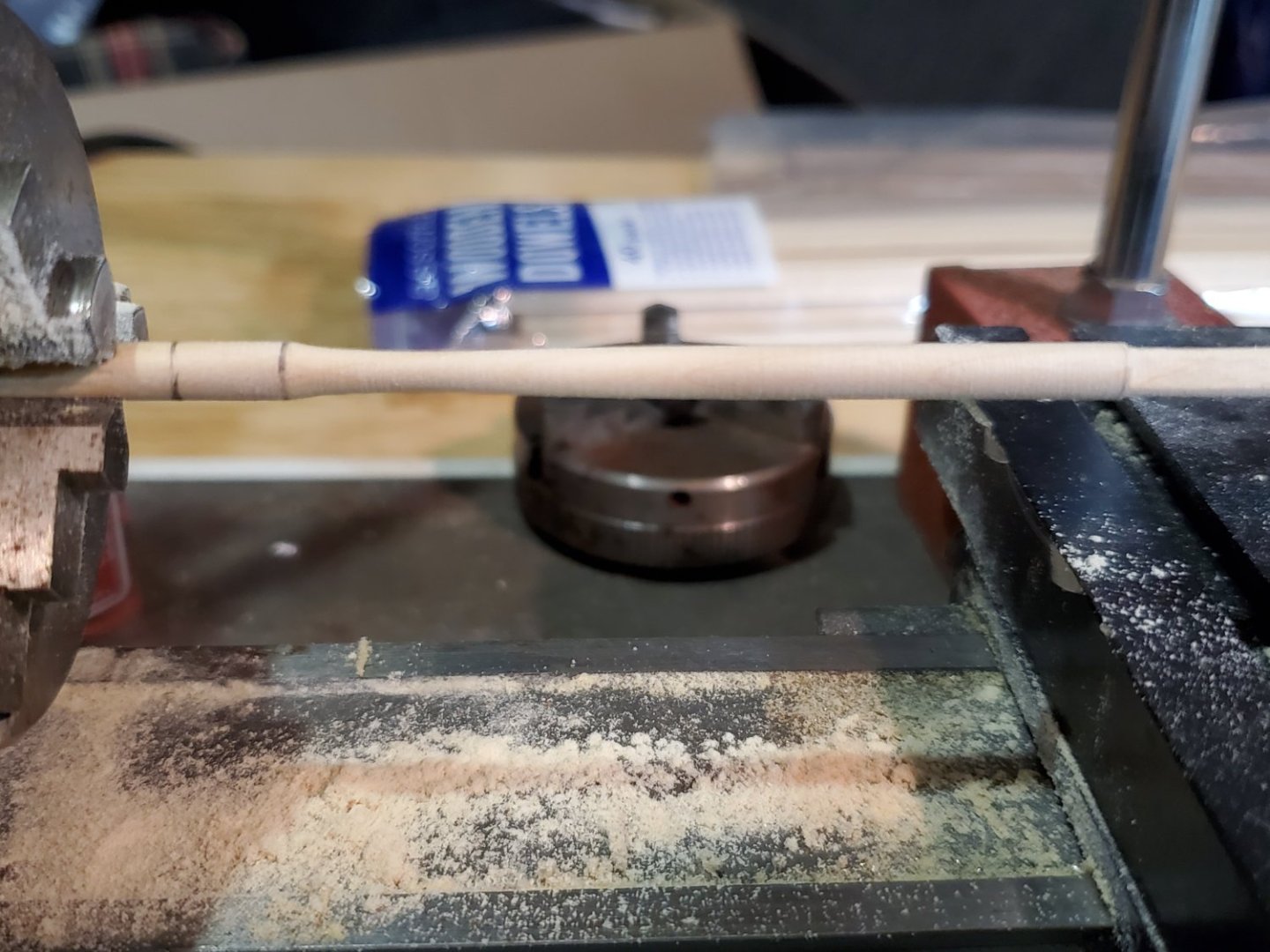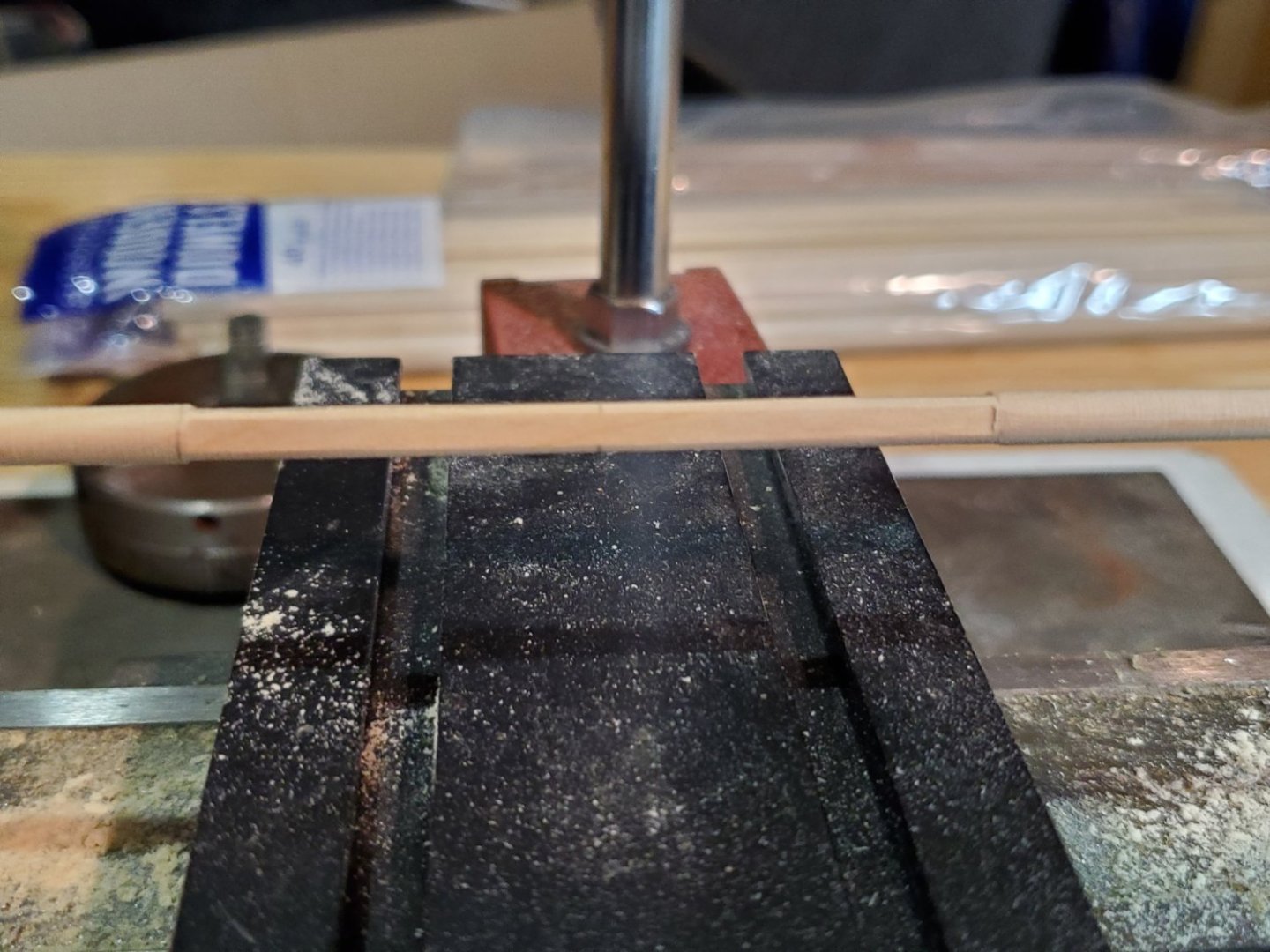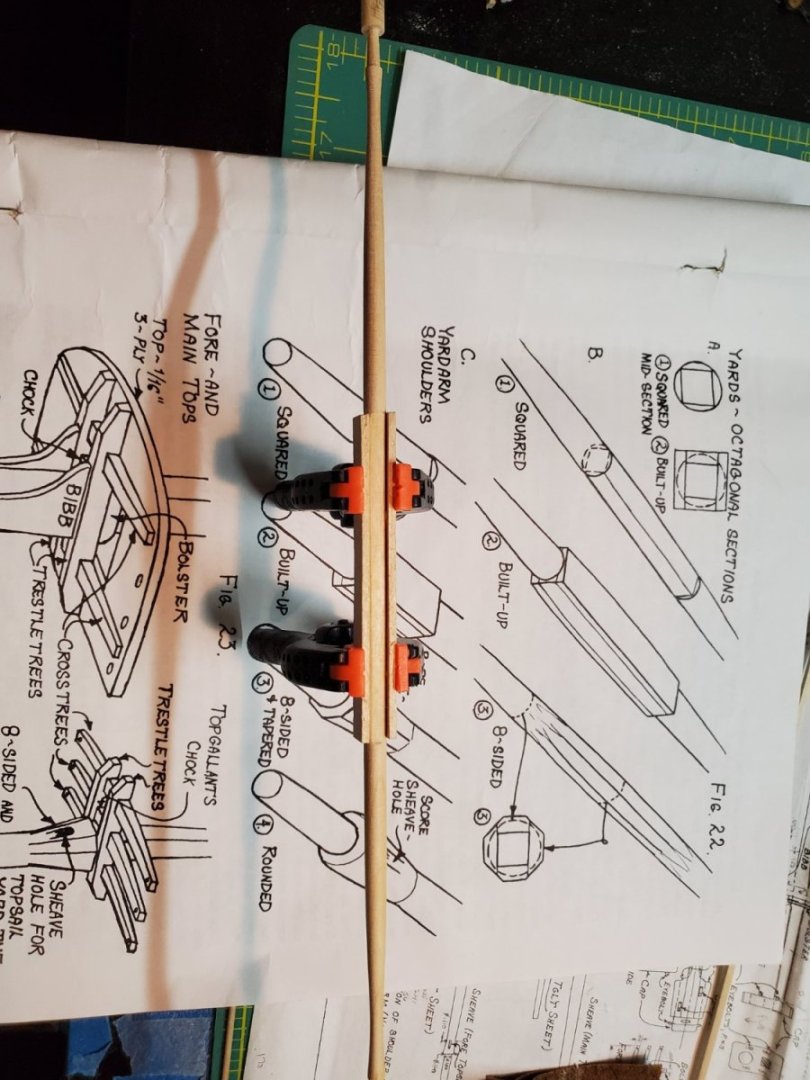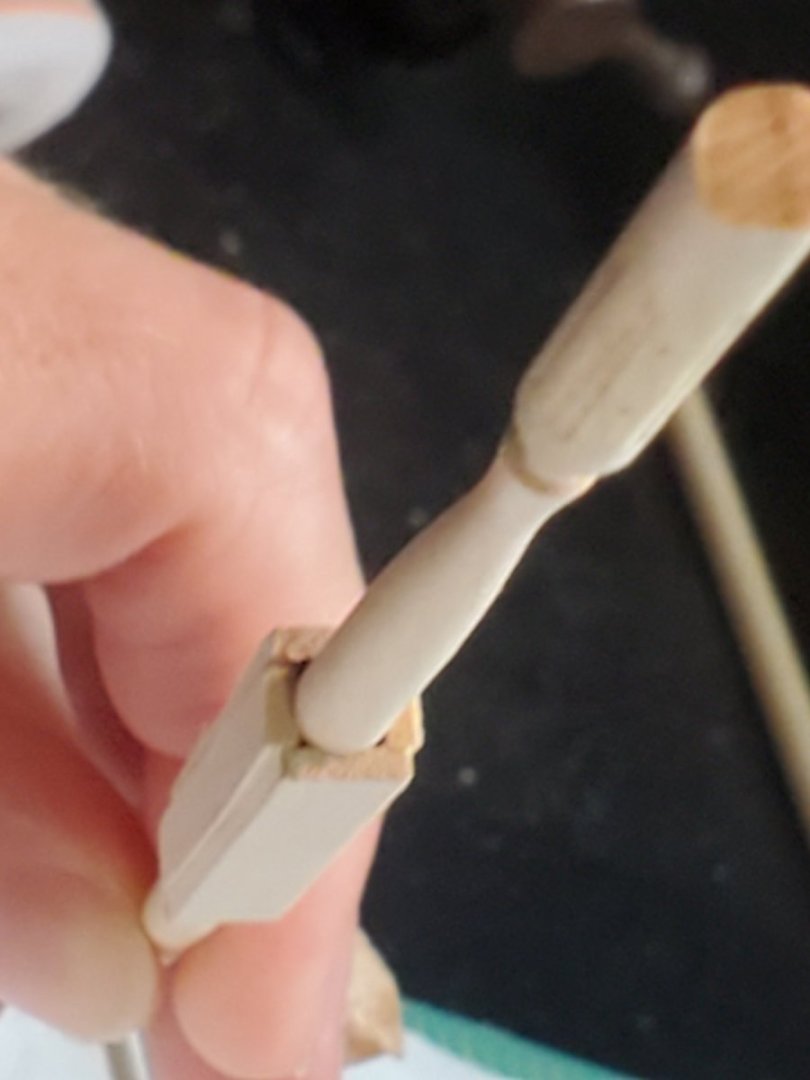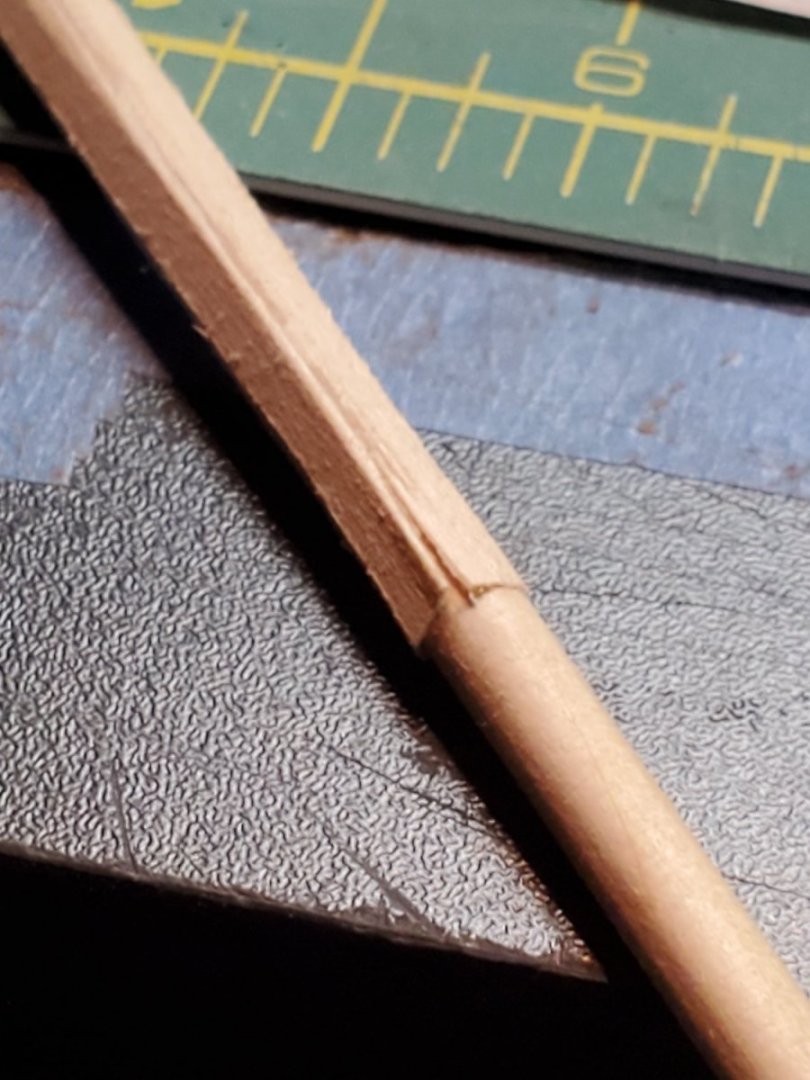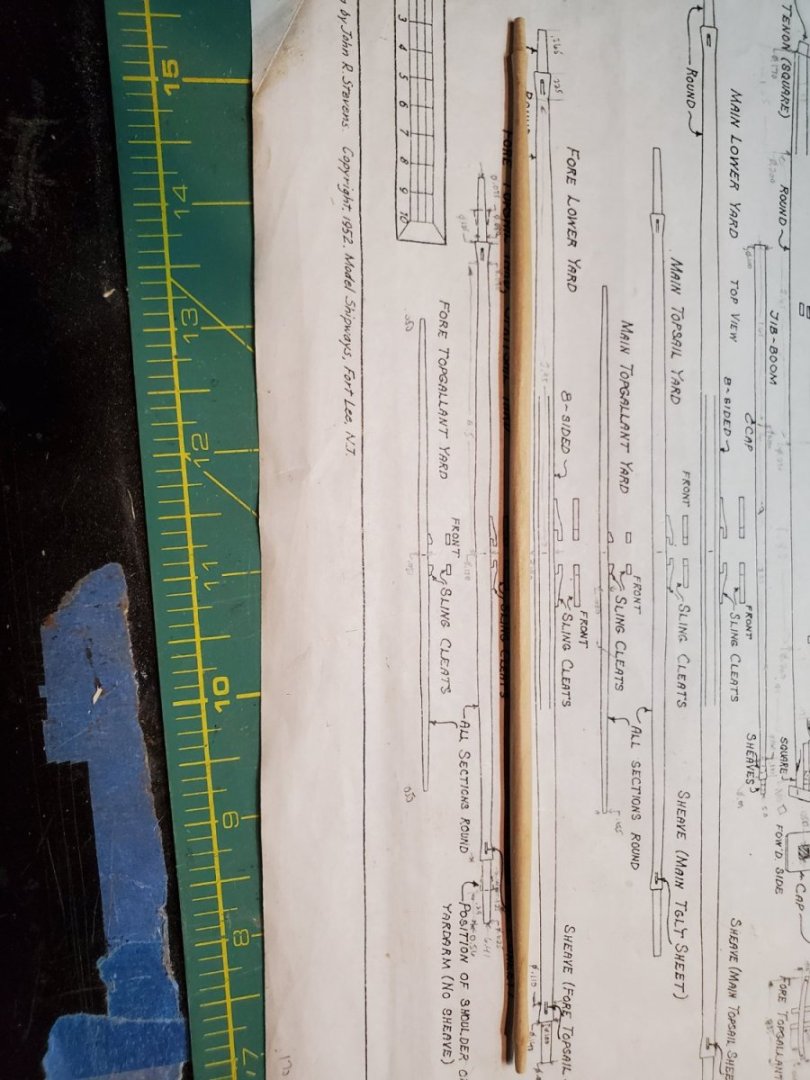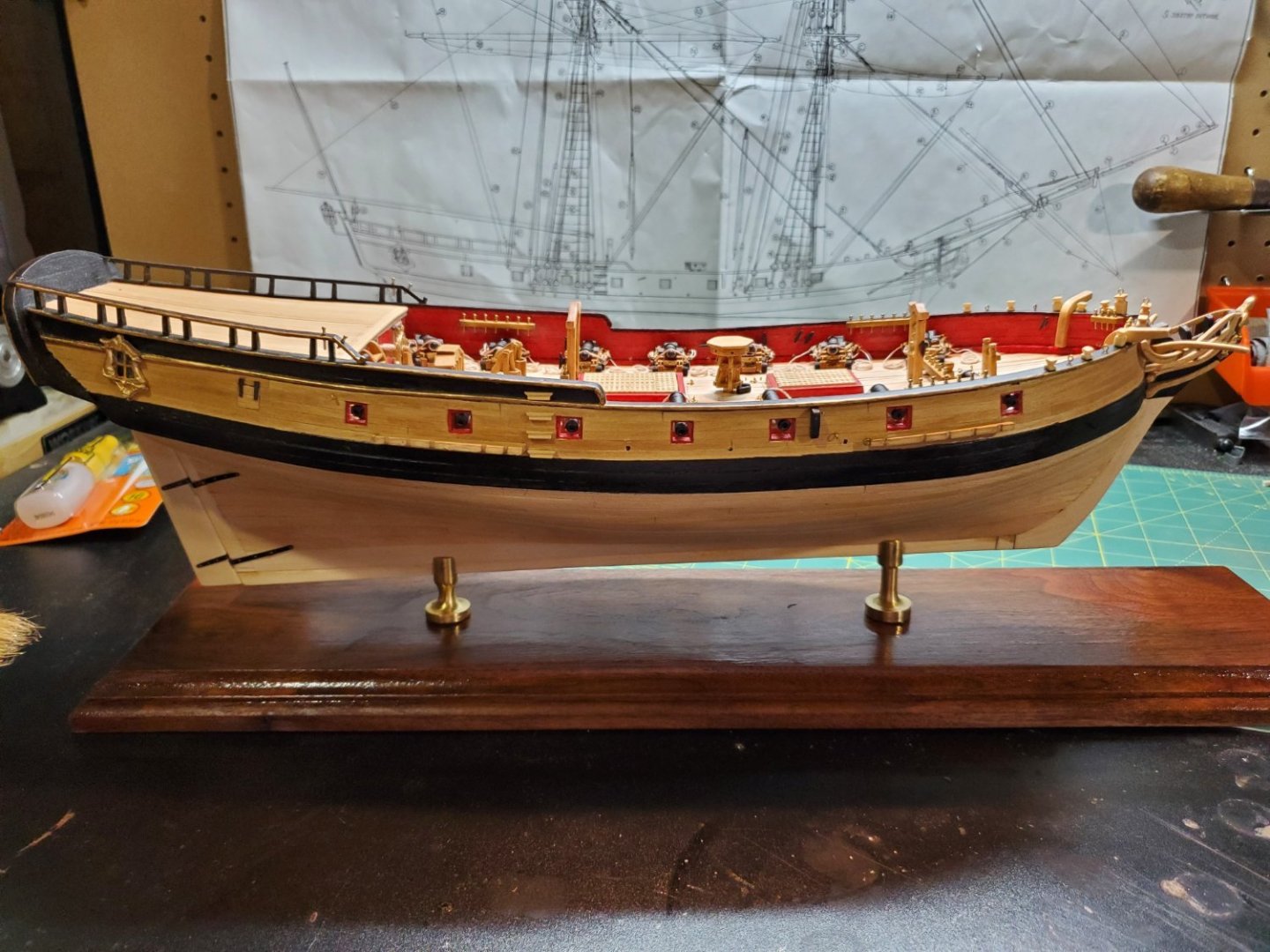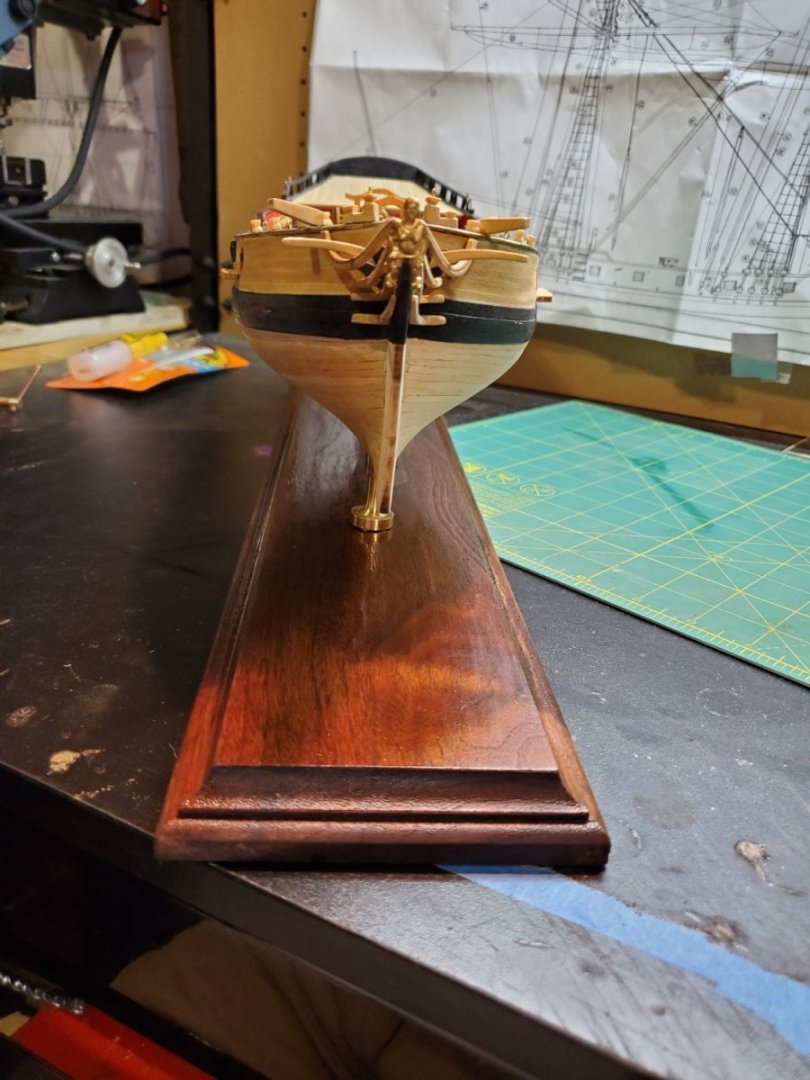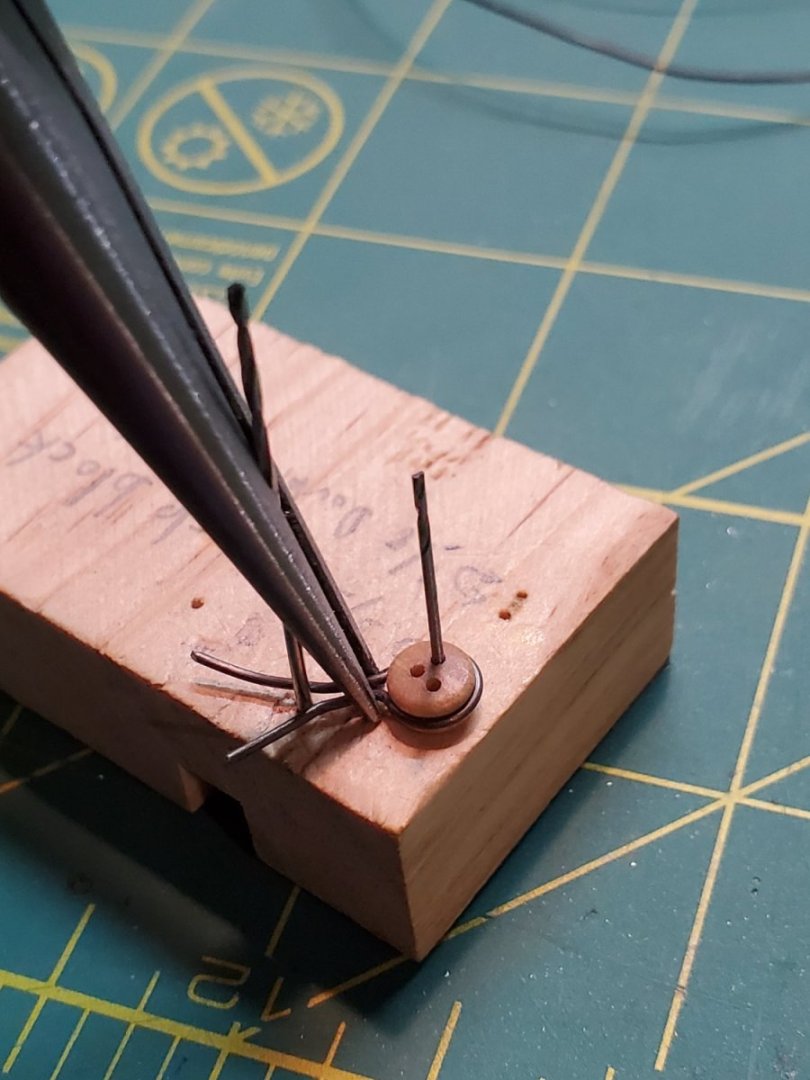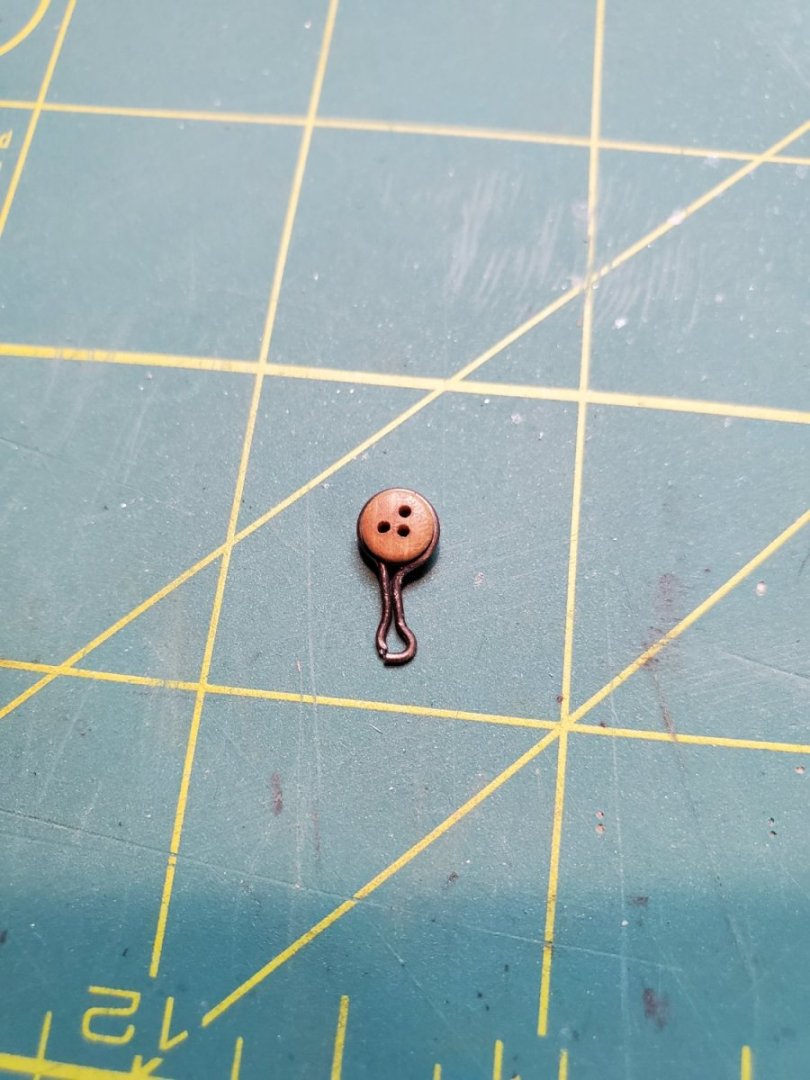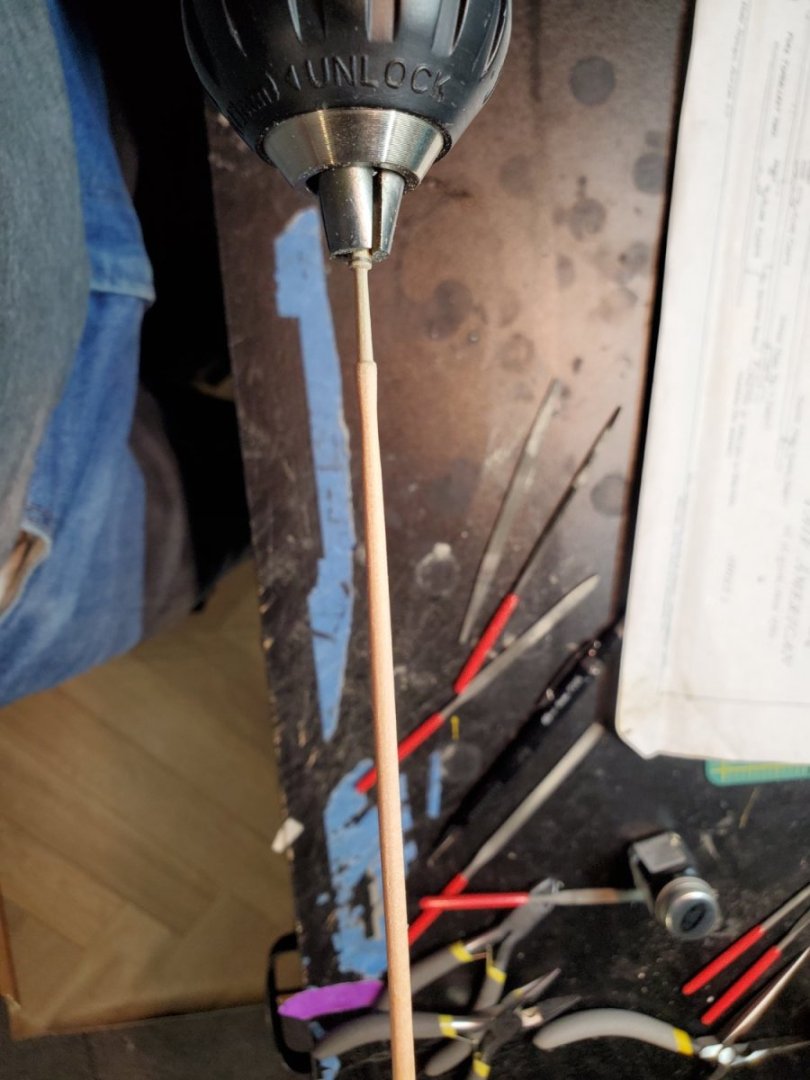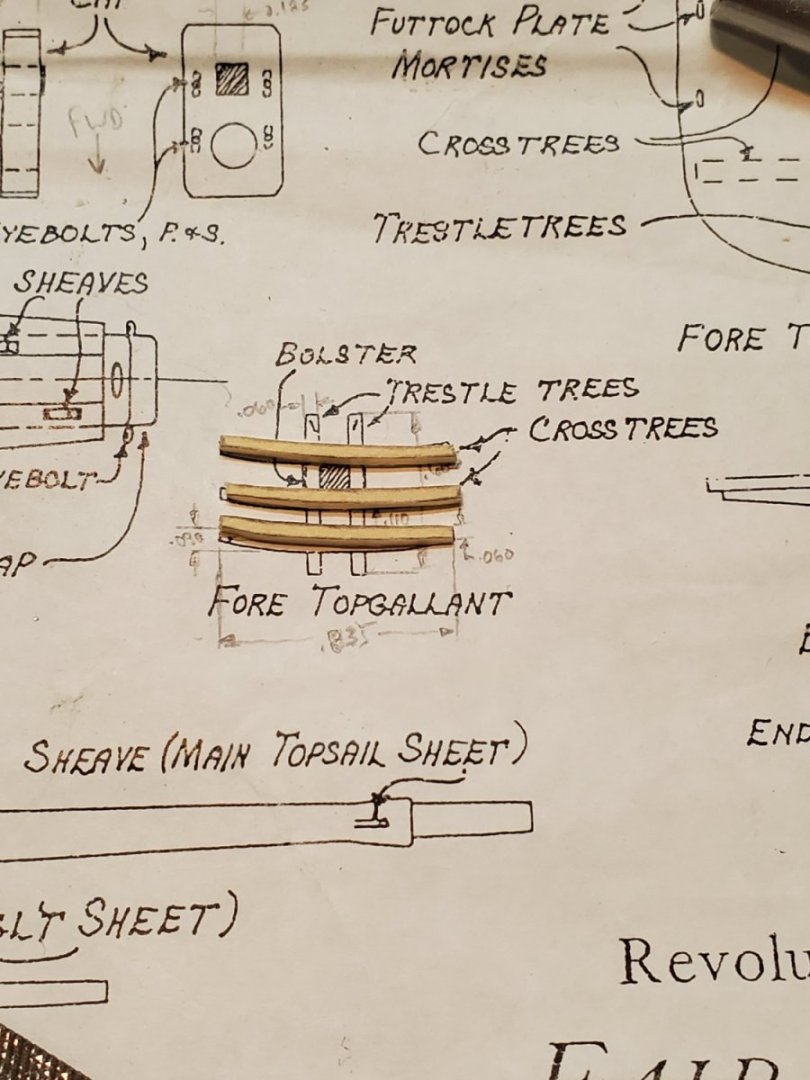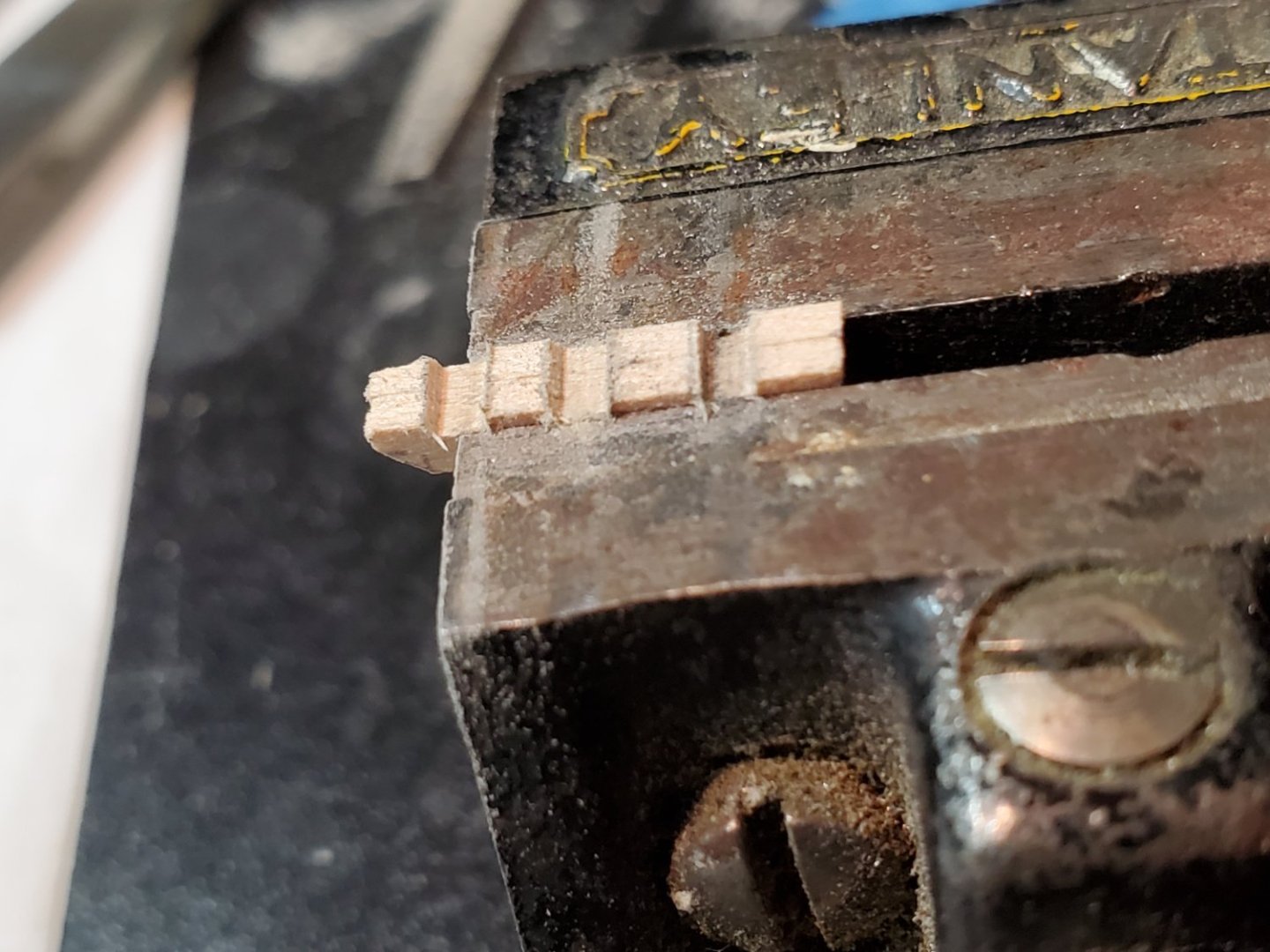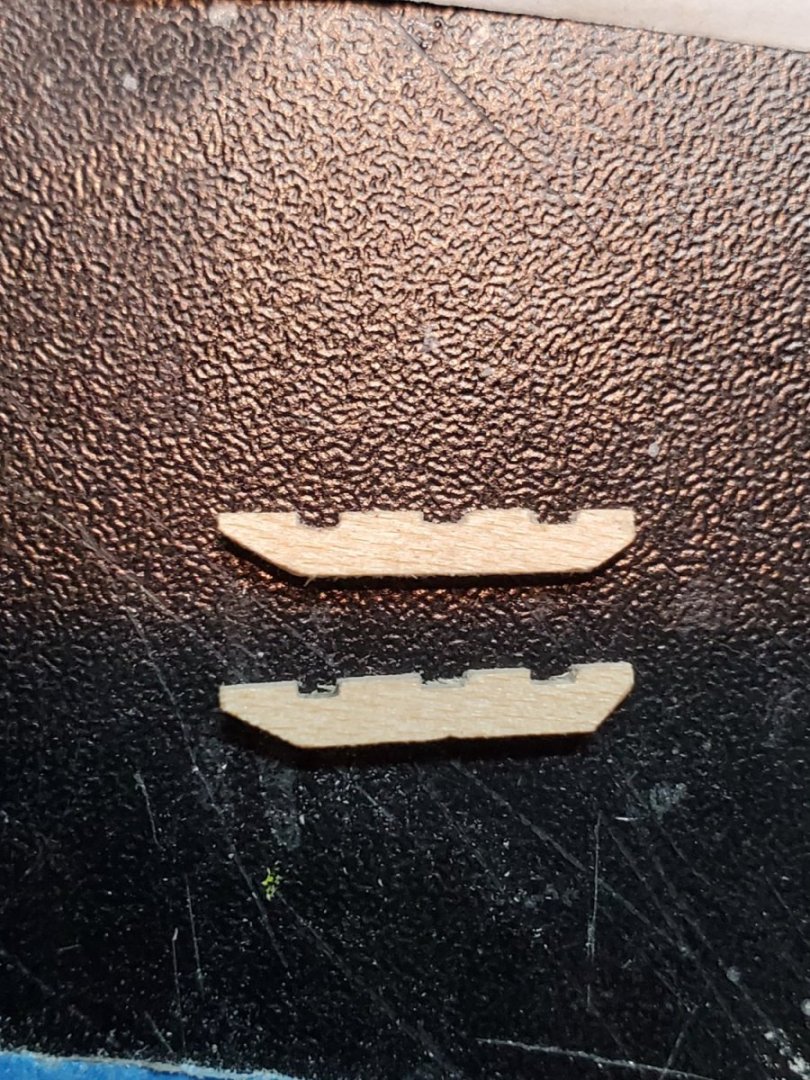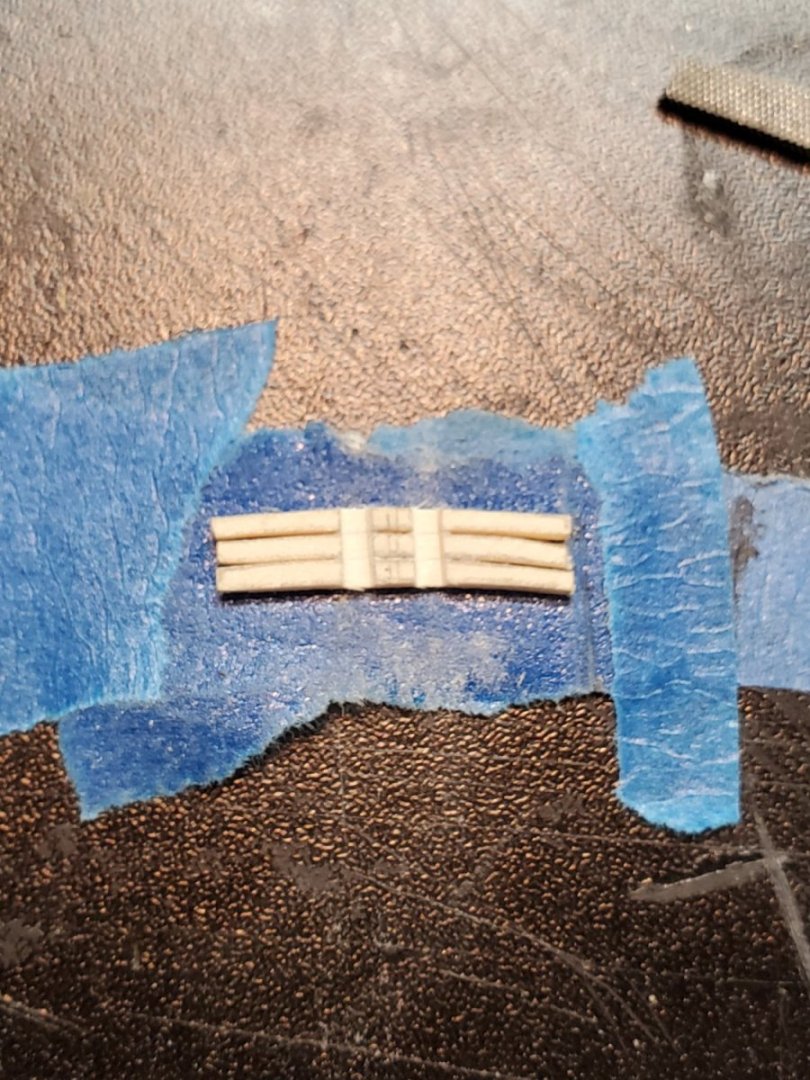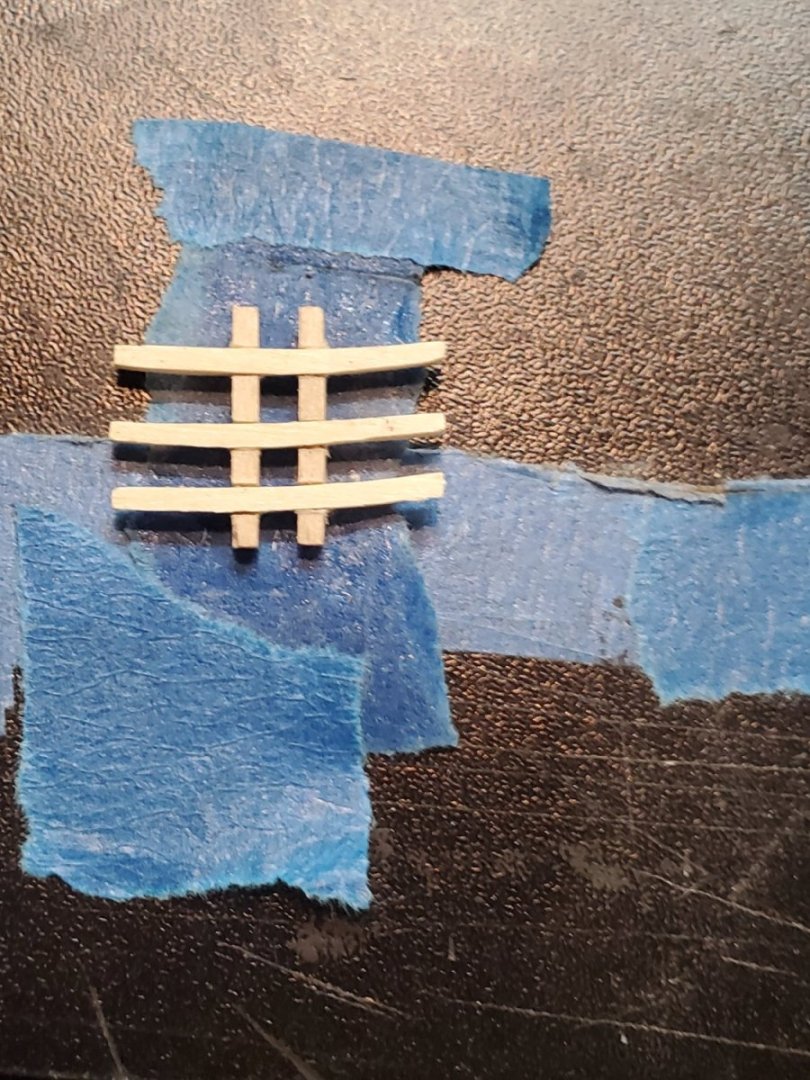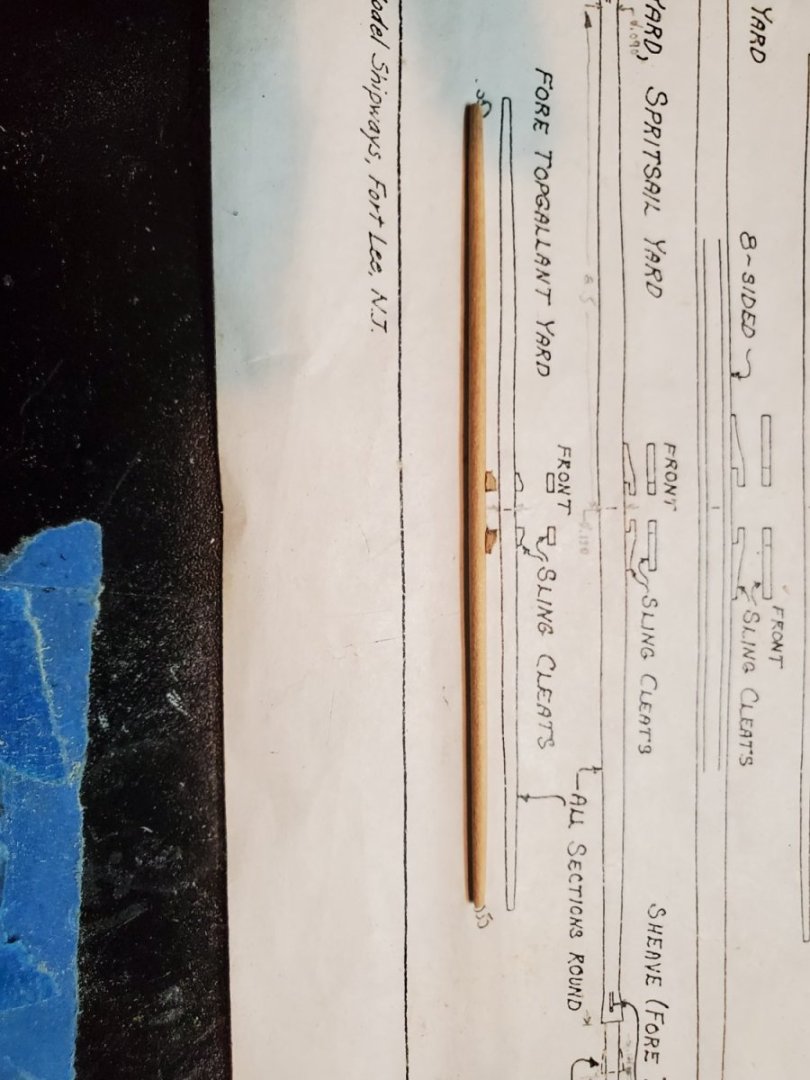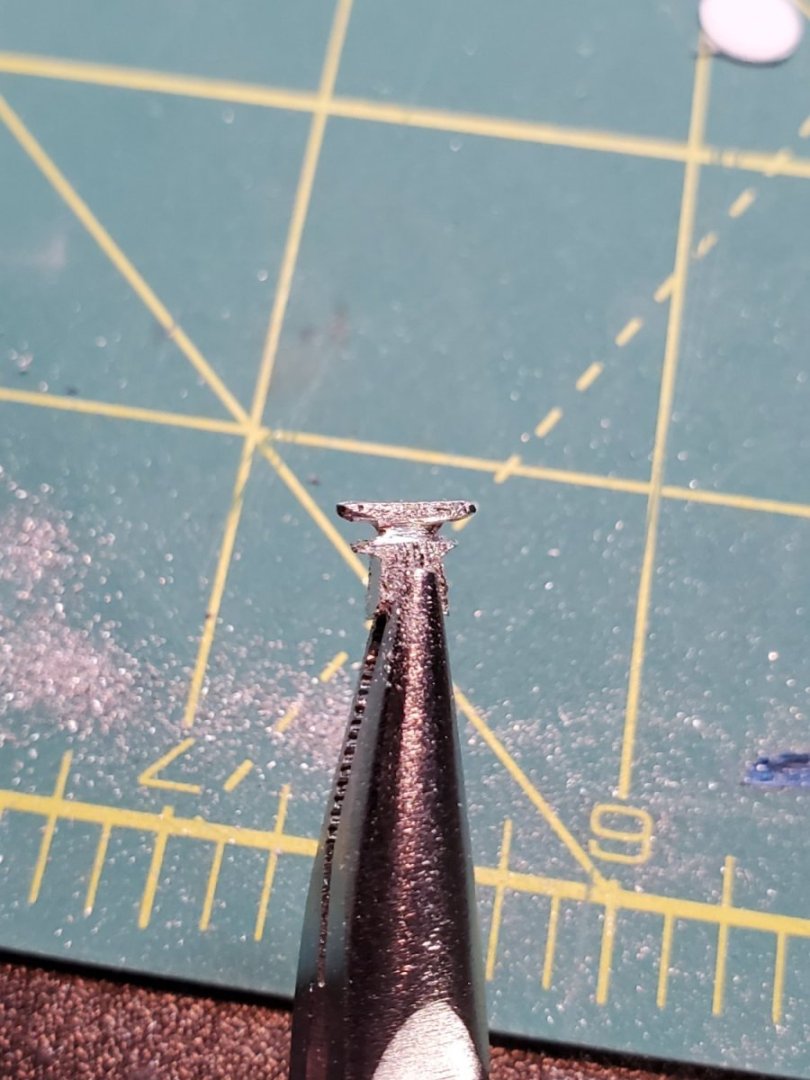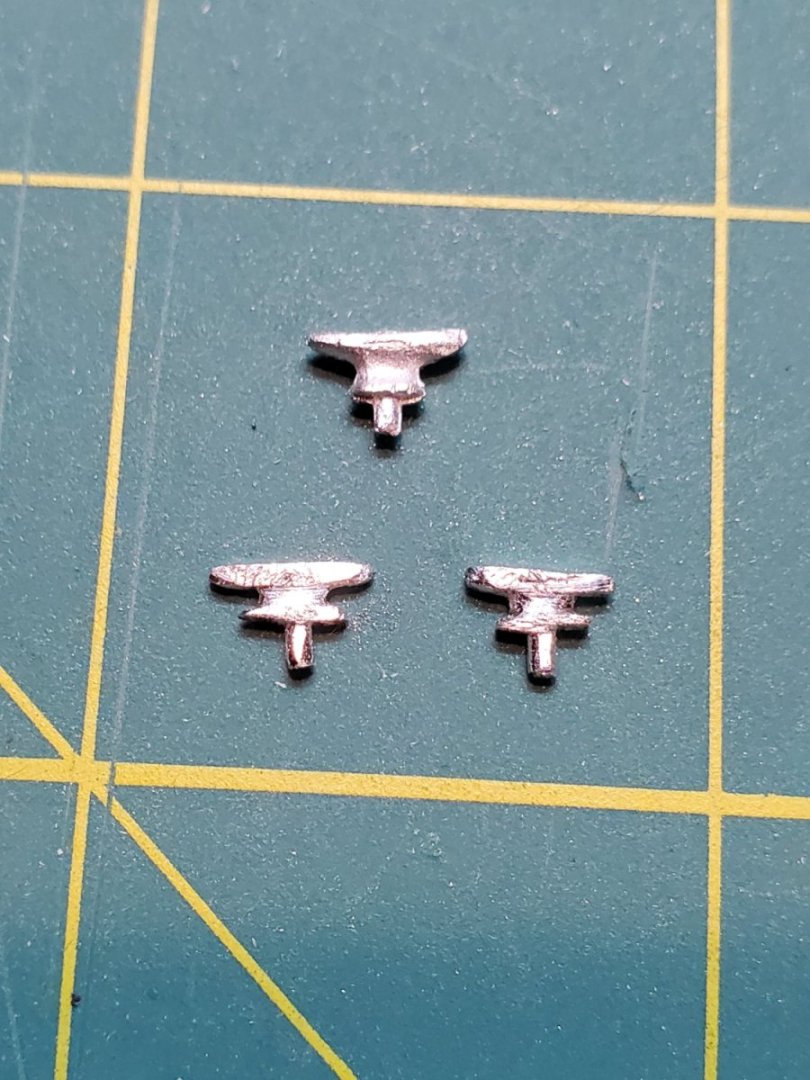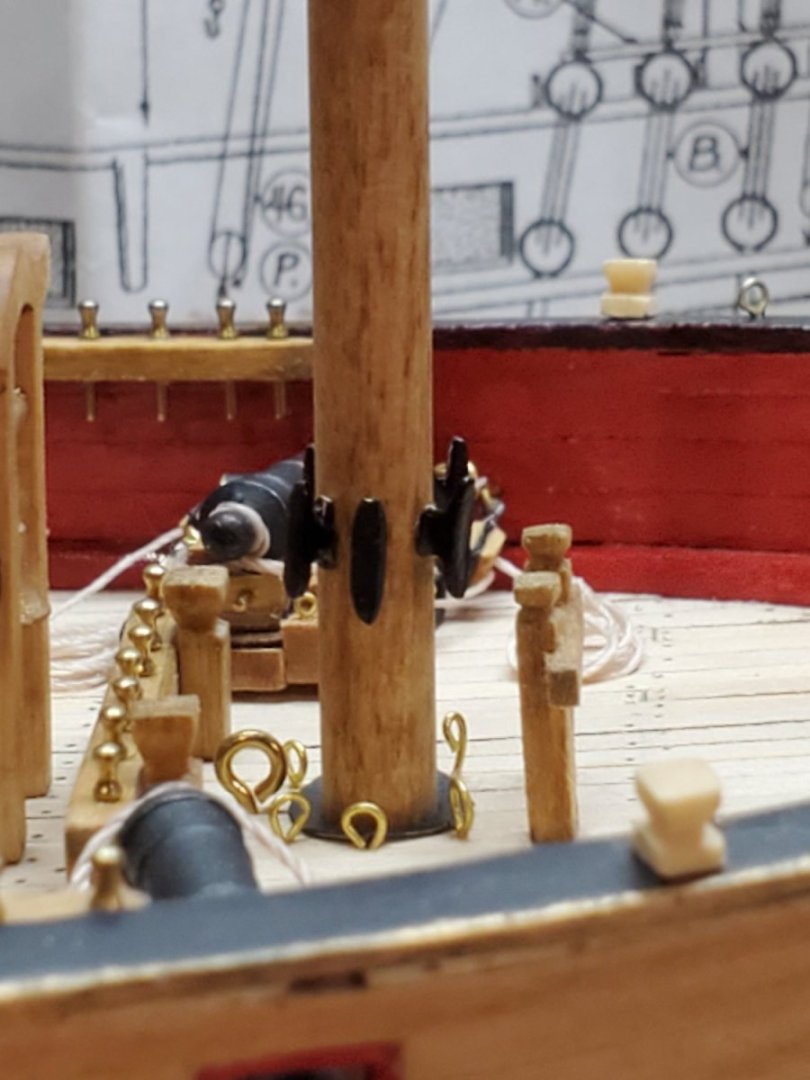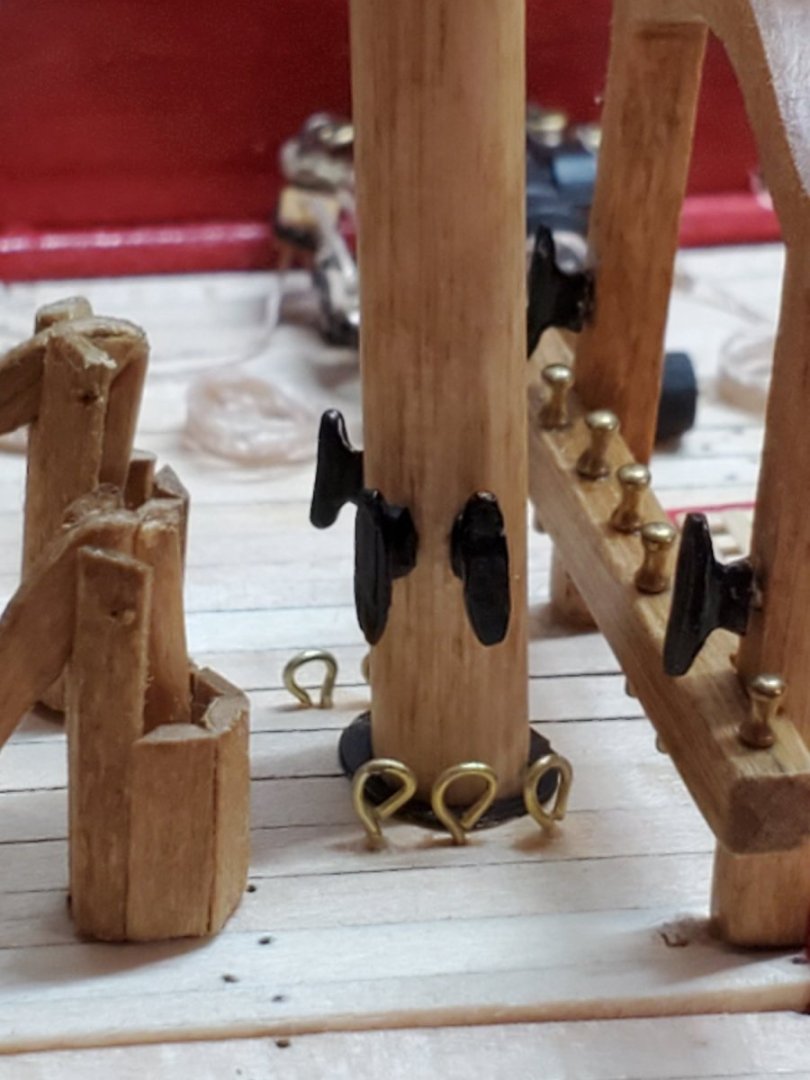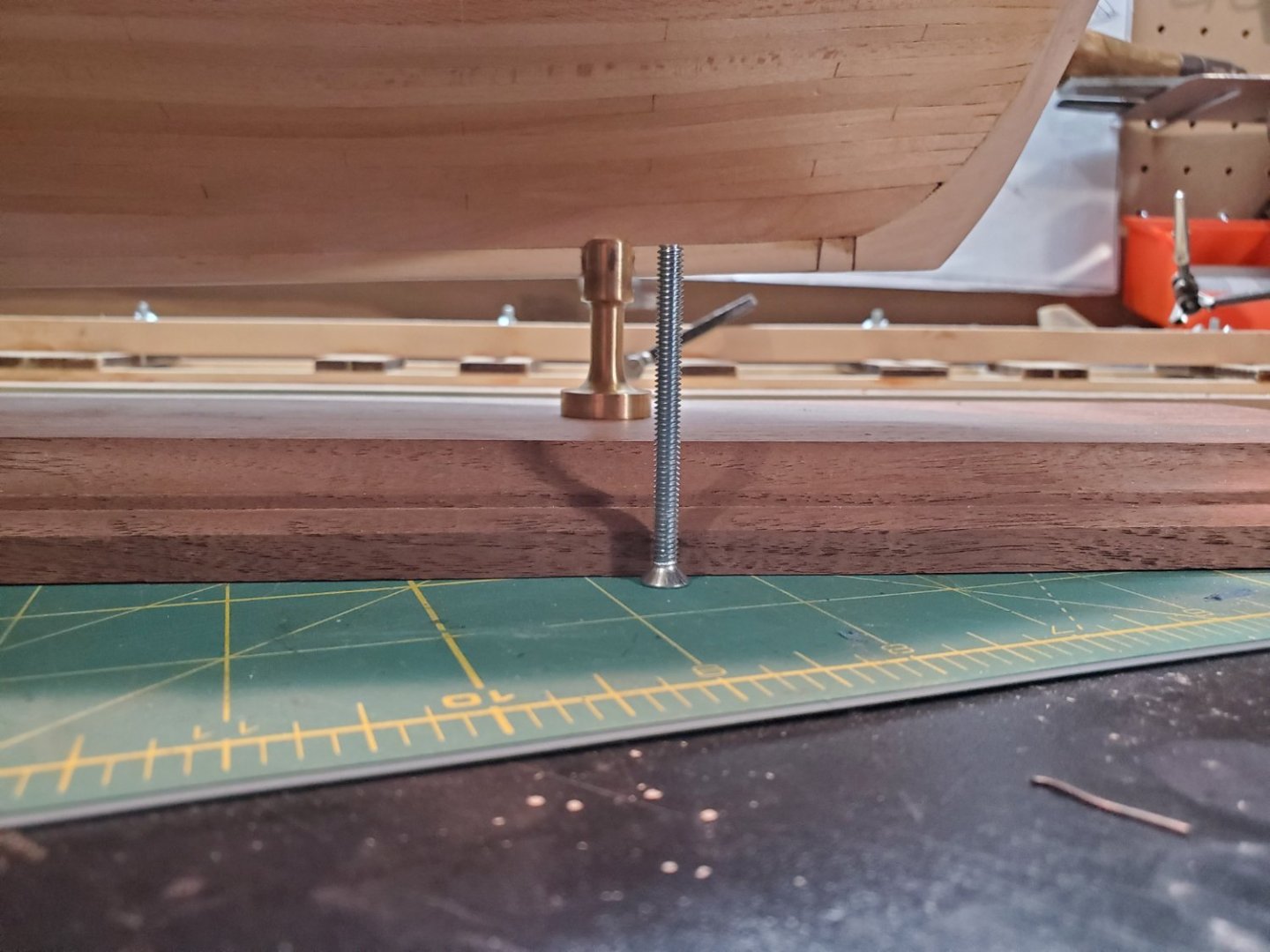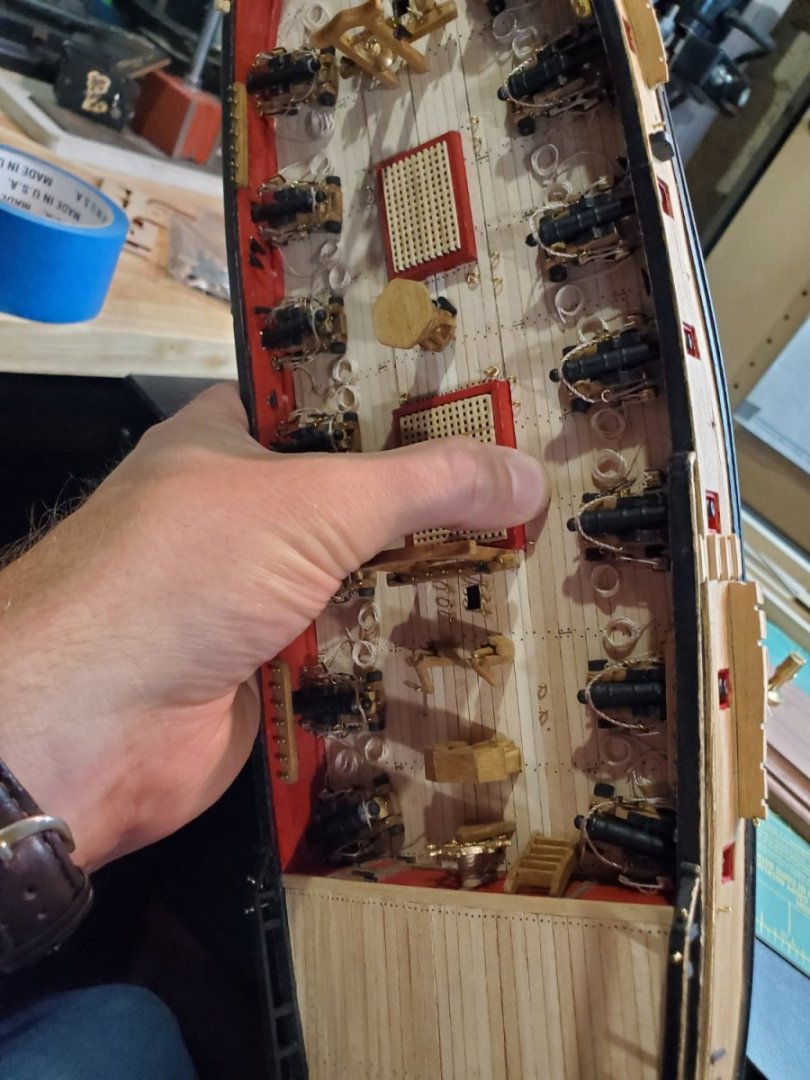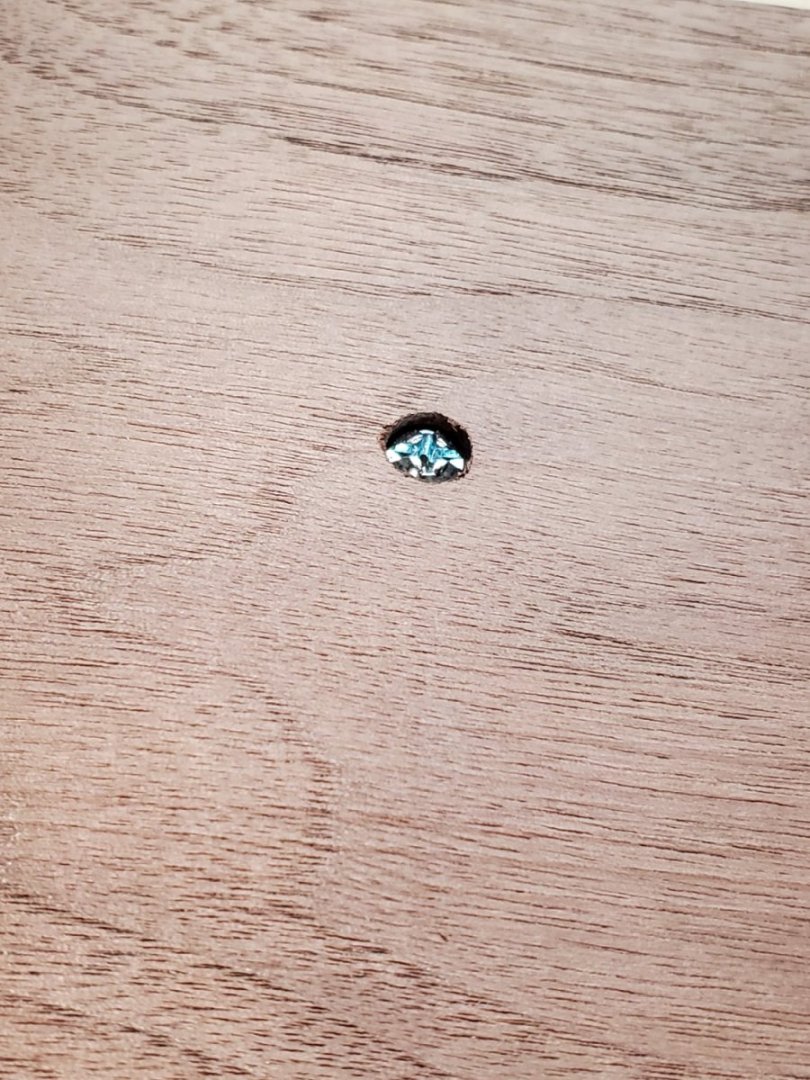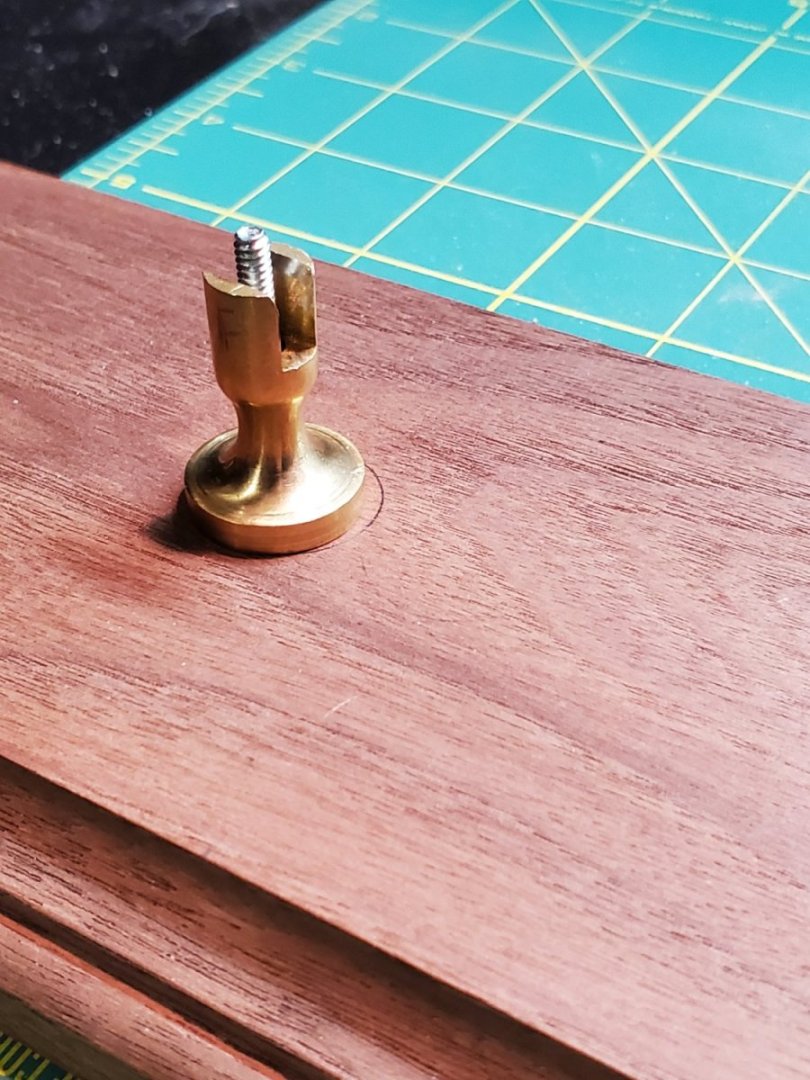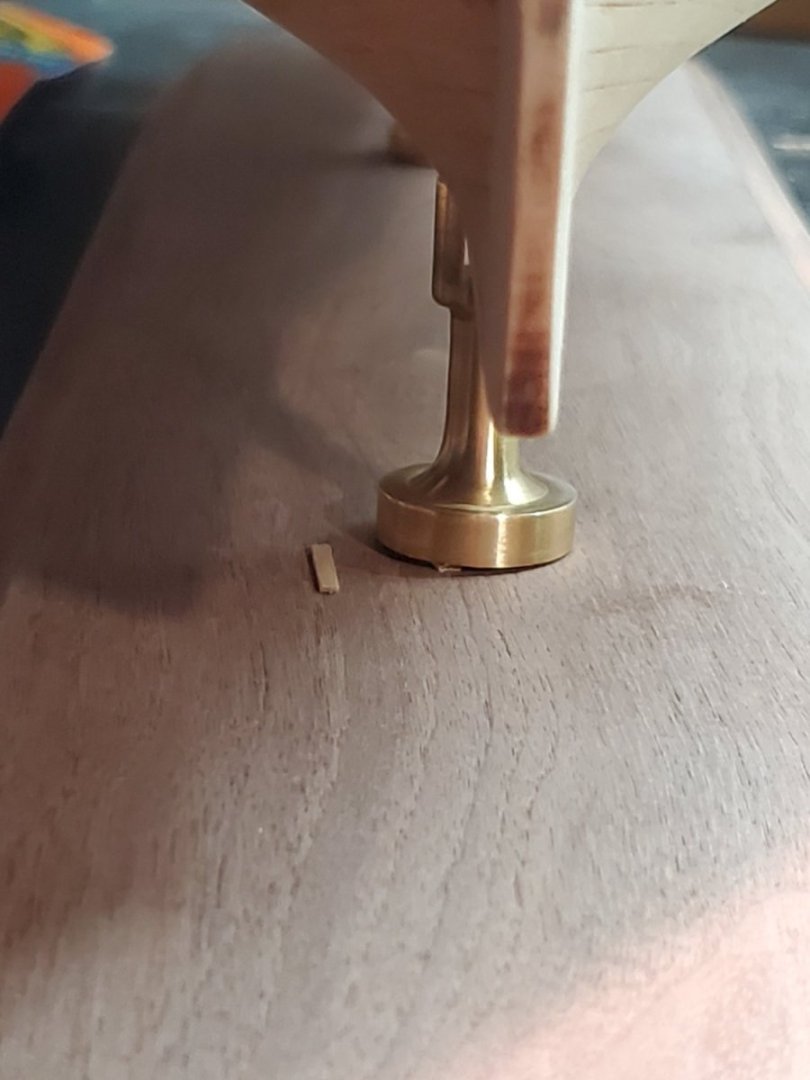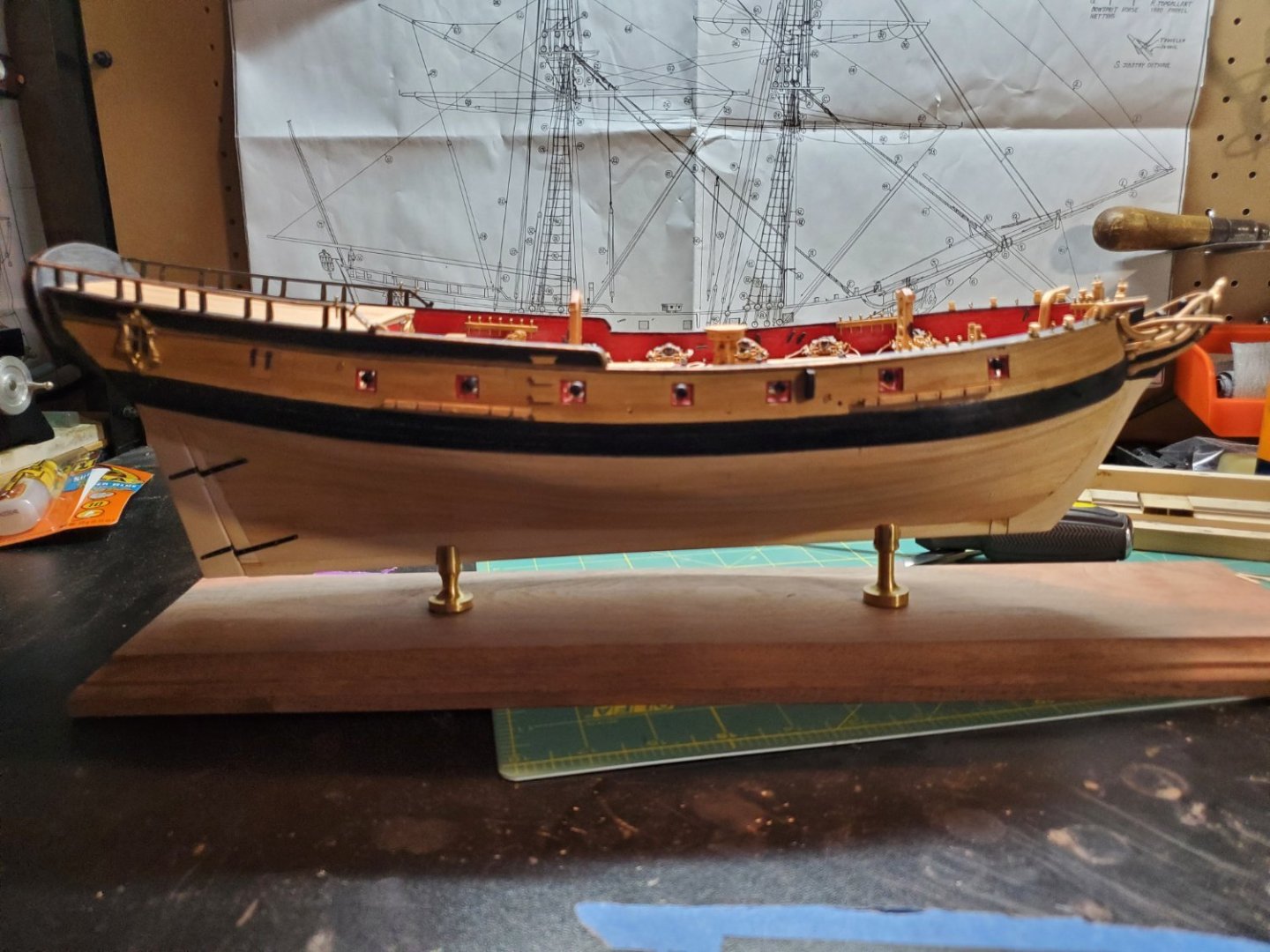-
Posts
110 -
Joined
-
Last visited
Content Type
Profiles
Forums
Gallery
Events
Everything posted by JLong
-
Update on the Fair American Model ship (rigging) I'm finally starting on the rigging for the model. I'm focusing on the bowsprit first, and moving backwards. My approach is to add all the blocks, deadeyes etc to the yards and masts first, then add the sails, then rig the yards to the masts, then step the masts, and so on. We'll see how it works I started to work on the Bowsprit shrouds and bobstays. I also purchased the serving machine from the Syren Model Ship Company months back. Time to put it to good use. The shrouds and bobstays need to be served, so I took some .018in rope to use. I mounted it in the machine, securing it to both the wind and static sides. Then following the instructions, threading some thin sewing thread through one end, with a knot... And tacked it with glue and trimmed short..... The first few inches of serving were very uneven. The rope likes to naturally bend towards the serving thread I'm pulling taught, so getting the pressure down right was tricky at first. You can see how it bunched up, then thins out, then tight wrapped, then semi-spaced. Towards the end, I got much better. Much more even. So I knotted, glued and trimmed short the end, and smeared a diluted bit of white glue onto the entire length to 'set' it, as per instructions. I hindsight, I should have used more glue, less water, and smeared more - it sort of unraveled part way, but I have a usable length. Its pretty easy to use, just have to do a lot of it eventually. I'm not exactly sure if the size of the rope to be served is to be scaled to size, or the final served rope is to be the scaled size. In the future I'll use a slightly smaller core rope than called for, and assume the served rope is the size I need. The shrouds were difficult to make eyes into. I could open up the weave and feed the rope through itself to create an eye, but that is more work than I'm willing to do at this point. I opted for a "fold an tiny eye of served rope, dab of glue, pinch hard with pliers and trim close as possible. At this scale size model 1:48, this is good enough for me I have to sort of guess how much length of rope I need to wrap the deadeye. I try to measure lengths, but its challenging. I'll wrap it around, tack a few spots with glue so it doesn't fall out, then finish the serving/knotting on the bottom as close as possible. Again, estimating where the other side will go, once finished to get the length right. I hold it with my fingers best I can. Make the second eye And tack and seize the other deadeye in place... This is as neat as I can produce a siezing here. It'll work. With the running end, I loop it over itself, tack with glue and pinch with pliers to form an eye Sieze/knot it.... And we have an ugly pair of shrouds! But I have to remember everyone who sees this on display will be wearing 500x magnifiers, so perfect details are key ;-). Lashing it to the bowsprit had to be done from the side, then rotated back into place, so the eyes are hidden under the jib boom. I made the eyes WAY too long. They wrap around the bowsprit, but are buckled because they aren't tightly wrapped, after lashing. But they're in place now. The bob stay is next, and that should be easier because there's only one deadeye. Most of this I'm coming up with on the fly. There isn't any real instructions for how to do this. ''Make an eye first, then wrap the deadeyes with 0.25in gap, then add 5/32" to the running end, then.." Something like this would have helped. Anyway, I'll keep chugging along. Thanks for reading. - Jason -
-
This is really nice work. I'm currently starting the rigging for the Fair American, and I bought the plans for the Niagra so I could see the rigging plan in better detail. I really appreciate all the detail you've included in your update, its helping to guide me in how to approach my build. Really enjoying seeing your progress. -Jason-
-
Update on the Fair American Model Ship Since the sails have been completed, I decided to focus on the Topgallant masts and Main Boom. The masts were finished, but I hadn't added the trucks yet. They sit on the very top of the Topgallant masts, and are pretty thin. These trucks are small. The plans show them in one view in a perspective view, which is unhelpful. I guestimated their shape and size. Once they were carved, they got glued to the topgallant masts with Wood Cement. I wanted to create small square pegs to fit inside, but making them so small, and having room for the sheave holes, wasn't going to happen. You can see on the fore topgallant mast, that I tried making a square peg a while ago, but couldn't carve a hole small enough in the truck without splitting it. I also continued staining the masts. I'm not painting them black, since I want the detail to show up. I spent a lot of time on the yards and masts, I didn't want to cover up all the shape with black paint. My choice. I also started working on the strap ring, and eye bolt behind the gooseneck of the Main Boom. I had some thin brass in the kit, which was close to size, so that just got tightly wrapped... I'd get it as close to size as possible, then I'd snip the brass a little long, and file it back until it fit. The long needle nose pliers I got a while ago helped tremendously. It was pinched and filed smooth as I could get it. I also didn't want it to be too large a diameter that it slide half way up the boom. It needs to wedge just behind the gooseneck about 1/16", so there was a lot of test fit, adjust and refit. Once the ring was wedged and glued in place, I worked on drilling out a hole for the eyelet. This was a little challenging, but I got it done. In hindsight I could have notched the boom to allow the ring to inset a little deeper, but at this scale, it's tough to do. I used some annealed steel wire to create the gooseneck. It turned out well. The eyelet was also a little big, but again, tough to bend eyes that small. Remember, museum curators are lined up outside my door, waiting to look at this feature with a scrutinous eye ;-). More progress with rope serving and bowsprit deadeye shrouds next time. Thanks for reading. - Jason-
-
VERY Overdue progress on the Fair American Sails... After vacations in April, and Alaska in May, and other life stuff, I hadn't made any progress in over a month. Now since June, and now July I picked back up. All Sails are completely finished!!!!! The Top Stay Sail was pretty simple sewing the cringles on, there are only 3. It did get a little challenging to keep the cringles all the same size. Often the sail material would fray at the corners, so I'd have to move the anchor stitch around to make it work - you can see they start/stop at random points, which was kind-of unavoidable. The Main Course took the longest. So many cringles, largest sail, and 68 Reef points is a lot. The Fore Course Sail wasn't much faster, only a few less cringles, and reef points. But I'm very pleased with the overall look of the sail. I like all the nice details. The Sprit Sail was fairly quick. I know the reef bands are really thick on this one, but folding and sewing them on this small sail, was very very challenging, so it does look out of scale. I will likely go back and iron all the reef points to see if I can straighten them out a little bit, since they kind of point, haha, in all different directions, rather than have a hang-straight-down appearance that I'm after. The Fore Topsail had 3 reef bands, so that takes a while to get all the points sewn in, and the cringles for bowlines and reef pendants and leech lines and bunt lines. But they are all finished.... I am finally able to move on to rigging and all the rest of the ship building When I finally finished sewing all the sails, a friend helped me celebrate by making some ''ship cookies''. A great little treat. Even some icing-planking was a nice touch. All 12 sails done!!!! I need 10 more cookies.... So this is where I am after months of work. I enjoyed sewing these, but I'm happy to be moving on to the the next stage of construction. Sorry for such a long span between posts.... I'll post more progress in weeks, not months next. Thanks for following along! -Jason-
-
More Sail progress on the Fair American: I was able to sew several more sails in the last few weeks. The Main Topsail had a lot of cringles to do with the bolt rope, but I got it done. Cringles have turned out well, just very tedious. Another one was the Main Course, the biggest sail. This took some time. Again, I didn't add Buntline bands or Middle bands: I'm happy with the detail I've done on the sails thus far. Repeating the cringle technique again: Sew through the rope itself.... Then loop around and through near the same spot.... Through that loop for a knot.... ...and pull tight. Again, not sure of the best technique, but I feel this is a nice secure way of making the cringle. Another detail I'm adding is the Reef Points - the little dangling ropes from each reef band. There's two per piece of canvas, so I'll follow that from Steel's. I'm using the same sewing thread I've been using. Anything else is too out-of-scale looking to me, and I've got lots of it. Now how to attach it so they don't fall out? I decided to make a two-knot design, at the end of the thread. Making the knots as close together as I could. That way, they'll hold each other from falling out fore or aft from the sail - I hope. I'd push the needle through the reef band, until I got to the first knot. Then gently popped just one through, until the fore knot was against the reef band. Then I trimmed the thread just above the lower band, to look like how Steel's drawing shows. On the aft side, I just trimmed the thread above the knot. There's a lot of these! As I went along, obviously they didn't hang very satisfactorily. They tend to cris-cross each other, looking messy. Straightening them by hand really didn't help. But for this Main Topsail, I just got them all done and trimmed. Phew! Now to help them look dangled, I blotted a small amount of diluted white glue over the thread with a small brush, then pressed it down to help it 'tack'. It sort of worked, but not completely (forgot to take picture of the tacked reef points). I'm almost half done all the sails. The reef points will take time on all the bands too, but I'm making progress. We'll see how many I complete by next update, but I'm on vacation next week in Cancun so I doubt I'll do much until I'm back and more sunburned. Have a great week! - Jason -
-
Continued Sail Progress... I finished my first ''real'' sail! One of the stay sails, complete with cringles. The port/aft end of the sail is a little messy. The tabling looks big, but it was as small as we could manage in this scale. Since I'm planning on ultimately displaying this looking at the starboard side, the port side will be facing away. The starboard side is my ''good side''. I had to make sure I had enough .025in rope to go all the way around, plus cringles. Here at the end, the rope overlaps a little bit, with some extra left over. I just trimmed it close once I finished. So this is the Fore Topgallant sail, finished. So much sewing!!! Again, the aft side isn't quite as pretty, but its progress. I'm happy with progress. The Fore Topsail was next. This one had the most cringles. To make my life easier, I used colored pins to mark where the corner cringles, bowline cringles, reef band cringles, buntline cringles, and reef pendant cringles are located, according to Steel's. I didn't include a middle band, buntline cloth, middle cloth or top lining on my sail. Its meant for when the sail is half worn in Merchant Service, and extra sewing I didn't want to spend time on for this build. As with before, at the cringle, I'd sew through the bolt rope, then loop and through for a secure stitch. You can see the needle poking through the rope before it got looped. I'd go around the reef band, and sew through the rope on the other side. Then just continue on.....and on.....and on... This is as far as I've gotten so far. I am halfway done the Fore Topsail. There's a lot of cringles to do. As the weeks progress, and time allows, I will continue to sew the bolt ropes on each sail. As soon as they're done, I'm ready to start rigging them to the masts and yards! I'll be setting 'sail' soon! Thanks for reading. - Jason -
-
Sail progress on Fair American Model Ship. Its been a month, and I'm happy to say all the sails have been sewn up! Machine sewn that is. The reef bands were a little tricky, since they were so narrow. Keeping them straight, while sewing proved difficult, since the band liked to walk as it was sewn, but we got it done. Keeping them pressed in my music book worked well, they held shape nicely. One row of stitches down the middle didn't look right, and on the Rogers Model, the reef bands had two rows of stitches each. Obviously its a bigger scale model, so there's more room, but I liked the look, and they turned out nice. I followed Steel's for guidance of reef band number and placement per sail. This Fore Course needed two bands, not one as per the TallShips printout I had. After they were all 'banded', I laid them all out - you can kind of see the shape of the ship in there. The next thing needing done, was (hand) sewing on the bolt rope. This is also used to create the cringles. Obviously I have years of experience sewing bolt ropes, so I knew just what to do. So I started with a tiny test sail we used for practice. Basically I'd whip stitch under the rope, near the very edge of the sail.... Go over and under again, then under the loop to create a knot. Then continued along the length in equal spaces I also practiced creating a cringle. I'd hold the rope with my thumb... Then sew through the rope and sail, and make another stitch Its not bad for a practice, and I got more proficient as I went along Originally, the rope would 'lean' fore or aft of the edge. I wanted it on the very edge. So I found that keeping the unsewn rope on the fore side, while starting the stitch from the aft side, resulted in the rope staying right on the edge. So I kept going. It looked pretty neat, in the end, so I was happy with it. I found it ironic that the dinning room table, which had ample light, had green loose woven placemats nearby. I managed to do pretty well with the corner cringle too. At the head of the sail, this cringle is called an earing. Hand sewing takes a LONG TIME. Once I started with the real sails, I didn't change my stitch spacing, but BOY is it tedious now. Now to get started.... - Jason -
-
Somewhat smooth sailing with sail making on the Fair American Model ship... As time has allowed, Jane and I have , well mostly Jane has made significant progress with sewing all the sails with me. I've kept referring to Steel's along the way, trying to be somewhat representative of sizing and shapes. She spent the last week sewing all the seam lines on all the sails - tedious work, but she did beautifully. We kept each sail with the cardboard stencil so we knew which was which. After the seams were sewn, I'd hand fold the tabling(s), which was really difficult at times with trying to keep them neat and small. Afterwards, I'd iron the folded tabling, then hand it over to be sewn - literally hot-off-the-iron. Folding over previous tabling proved challenging, especially on the old sewing machine. I wasn't really sure how to terminate them, exactly, so they turned out a little mashed, but acceptable. You definitely have to watch out for the 'flying nernies' as she said. The end result is quite attractive. For some of the leech side tablings, I tried to cut and fold the ends flush with the head/foot tabling. With angled sails, this doesn't always work. But with some, like this top sail's top corner, it was very 'neat'. Another issue that kept coming up, was missing stitches. If you look closely, between the first and second reef band lines, on the right table, there's one missing stitch. We don't know why this happens, but some had to be cut and resewn. It was very frustrating, and unavoidable, in some cases. But we kept trucking along, and got them all done. In fixing missed stitches, Jane was so skilled that she was able to sew over existing stitches, to where they blend in. You can barely see it! After each sail was sewn, I'd trim all the ends with rigging scissors as close as possible. Some of them had to be hand stitched to close the ends, but not many. I even had some time to work on the Main Boom and Gaff. I kind of had to eyeball the jaws for the Gaff. I left the tapered end thick, then once it was glued, I sanded it down to a smooth taper They turned out okay, for the most part. The cleats were a little tricky, as small as they were, but I got it done. After they were glued on, I also filed them down a little bit so they weren't so bulky. I still need to stain them, eventually, but that'll be another day. The only thing that remains on the sails is the reef bands, and sewing the bolt ropes on, and creating cringles. Then I'll be able to start rigging them to the yards. Seeing the final product, or close to it, with the sails has been very rewarding. It took some time to plan, but was worth it. Not sure if any of this is best/good practice for sail making, but hope this gives other modelers an idea of an approach anyway. More progress hopefully soon! - Jason -
-
Hi Chuck. Thanks for all the kind words. I wanted to challenge myself with this build, and LITERALLY learn the ropes, so I'm doing as much as I can, and test my skills. Regarding the stropping, you can see from Dec 12, 2023 post, I use black rope (either .012 or .018). With hooks, I'll typically overhand knot the hook, CA Glue it to the top of the block so it's tacked. Then wrap the rope around the bottom and overhand knot again, pulling in opposite directions so it's neat (Dec 12 post). CA Glue, let it dry, then snip super close with rigging scissors. Hope that makes sense. I do wish the block quality was better yes. Syren blocks are really nice, but I won't change type mid-build at this point. I did buy all Syren ropes though - they are really high quality. Next build I'll get better blocks, or a better kit. I appreciate you following along so far! -Jason-
-
Some sail making progress on the Fair American: After last time, sewing sails was postponed 2 weeks, as my (retired) mother in law was busy. It was worth the wait. With each sail cut out, I made light pencil marks showing where to sew the seams. These were spaced apart 0.5in, which is scaled 2ft, as dictated in Steel's Sail making section. The thread will cover up the pencil marks, so I'm not too worried about it showing up. Bottom and Top sails have reef bands. Acccording to Steel's, they are to be 1/3 width of canvas. For practical/folding ability, I targeted 3/16" wide. This fabric is NOT easy to use, and folding them over 2x to prevent unraveling was a nightmare. It got all twisted and rolled, instead of folded. I was going to use the Iron to flatten, but I couldn't even get to that point. I thought that folding along the weave direction wasn't going to work, so I tried cutting them out from an angle, so the weave would stay more intact (see the angled line I cut). It didn't help. the pieces are just too narrow to handle. Very frustrating. So then I thought, well I need more 'substantial' material to fold with. So I didn't cut the strip free, just folded over 1x.... Then ironed it. Then folded again, ironed again. THIS WORKED! Afterwards, I just cut along the second fold - worked great. I just needed something to 'hold onto'. I took the cut reef bands, and placed them in between the pages of a big music book. I play piano, so this is apparently the page I turned too. They'll stay flat and protected until I'm ready for them. Now for the more fun stuff. Please note: I have no idea what I'm doing - really just trial and error and ''yeah that'll work''. Bob Hunt's practicum on Sail Making is helpful, but I really wish there were more pictures. Anyway after careful consideration, I decided on a medium tan thread, as the sewing thread for the sails. In hindsight, I probably should have gone with the next lighter shade, but I'll live with it - No turning back now! My mother-in-law started with the vertical seams first, following my pencil lines as a guide. We played with the settings for the tension, stitch, and 'that spool up on top' (12, 7, 2, respectively) You can see the master at work tabling the ends This first Main Topsail had a generous curve on the foot. Folding and ironing this tabling was a challenge. We discussed folding/ironing all 4 tabling ends was not easy to sew - to many layers at once. So we did the head and foot first, then I folded and ironed the leeches afterwards. Note - Nowhere in my research, or in Steel's, did I find which way the tabling should face: fore or aft. My brain says aft, but I wish I could know for sure. The Rogers model LOOKS LIKE the tabling is aft, but I really can't tell. The reef bands do go on the fore side, so those will be sewn last. Here's the 'fore' side of the sail, with tabling facing aft. Here's the head tabling sewn - it looks pretty good. It was hard for her to stay close to the edge of the seam without the stitch walking over the edge. Thus, it's not perfectly straight. Beginning and ending the stitch was very difficult. The material likes to snag in the sewing machine. We had to make adjustments for start/end to get it right, with a couple reverse stitches to keep the thread from unraveling. After the head and foot were sewn, the leeches were next. I left the folds long, so she had something to grab onto, then trimmed later. The final sewn sail ended up being slightly smaller than the carboard stencil at-scale. There's some material puckering and my folding wasn't perfect. When the sail is rigged, it will be bent to the yard anyway, so thank God it didn't end up bigger! I think it looks pretty good, considering first sail, first time, first material, first ship. Most of the credit goes to Jane, but we made a good team. We worked on one of the Jib Sails next - This was about as far as we got yesterday.... We spent ~1hr deciding on the plan, 1hr with a practice sail/seam, and 1hr of real sail sewing. I'm going to go back later in the week to make more progress. She sews, I fold and iron, she sews some more. We haven't sewn on the bolt rope yet - that'll be at the end once they're all tabled, and the reef bands are on. Hopefully more progress in the coming weeks. Enjoy your week - Jason -
-
Progress on the Sails for Fair American... After putting this off for a while now, I decided I needed to bite the bullet and finally work on the sails. I can't do much progress with rigging without them, so it's time. My mother-in-law graciously offered to help with the sewing machine and stitching expertise, which I'll go into more next post. First, I took all the rigged plans I downloaded and taped together from https://www.shipmodell.com/index_files/0PLAN1C.html, to see if they were even close to scale to the actual yards. Some were, some weren't. This pages' sails were really close to my model (1:48), at least lining up the yards to the page. So I took the measurements from here, to start... But this view, (stay sails, and gaff/boom sails), were not in scale, for some reason. They were 1:1.12, so I measured, then calculated the 1:1 size, and circled that number. From there, I laid out the sail cloth I purchased from ModelShipways on the dinning room table. Its a big piece of fabric. With the measurements in hand, I made cardboard stencils to scale. It was a sunny day, so shadows were abundant, sorry. After all the stencils were made and cut, I arranged them on the sheet so they all fit. I made sure to allow extra material in between for tabling (seams). Here's all of them laid out. There's extra material in the top corner for reef bands, middle bands, and linings, as necessary. After studying Steel's for a while, and looking at Bob Hunt's practicum from Lauck Street Shipyard on Sail making, I came to the decision to make 3/16" wide tabling. Any smaller than this is going to be really hard to handle and fold. The Fair American in the Annapolis Naval museum is 1:32 scale, so those sails' tabling was probably more manageable, I would imagine. For this smaller scale model I have, I'm happy with 3/16" as a first attempt. It'll do nicely for Jason's personal museum quality workmanship. Note, the offset for tabling is actually 3/8", since I'll be folding over the edges before sewing, so they look large. now I traced the edges of the stiff stencil with pencil. I tried to erase a mistake, but that started to leave eraser debris in the fabric, and picking it out started to fray, so I have to be really careful not to shred it or get it dirty. Pictures are lacking from here on out. At my mother-in-laws, I wasn't focused on taking quality pictures, but more on her sewing skill which was impressive. This first 'tan' thread was a little too dark for my taste, and it's supposed to match the rigging line color (picture absent). #2 tan was pretty darn close to the right shade. (bad picture again). But I wanted to see #3 the lightest shade too.... #3, the lightest tan was a little too light. It blended very well, much like the Naval Museum model sails' does, but just a little too light. Also, I measured out 9/16" spaced seams for this stitch, to get an idea of how it looks seamed. It's too wide; not sure how I came up with 9/16". Later seams were 1/2" apart which looked better. And since Steels mentioned ~2ft wide canvas used on sails, my model is 1ft = 1/4", that makes 1/2" between seams. All these are just test/practice pieces so far. Only trying to get an idea of how the stitching/color/sizing looks and feels before the real thing. Also practiced ironing the material after stitching to see if it helped the wrinkles. I might keep them in, for a more authentic look. I'll spend this week planning out order of operations (seams 1st, then reef bands, then leech tabling, then head/foot tabling). Then I can draw some faint pencil marks to guide my wonderfully helpful seamstress to where the stitching goes. I might have some actual sails ready next weekend, if things go to plan!!! More progress soon. Thanks for reading - Jason -
-
Progress on the Fair American Model Ship: Again, very overdue, but progress nonetheless... I got all the deadeyes and chain plates mounted. Got them as straight as possible and raked with the masts. I made sure to line up each deadeye as parallel as possible, before gluing the channel cap. There was a lot of re-working and re-bending chain plates to get them all to look right. While this was happening, I rigged up a little ''stain-sling'' to help hold the yard while I stained them. It was just two rope loops hung from two helping hands, with the yard in the middle. The Roger's model has the yards black, and the studding yards stained, but I'm staining the main yards in my model. Now was time to do some actual rigging, starting with the Spritsail Yard Truss. No instruction on how to start/stop this thing, so I made up my own method. I wrapped rope around the Sprit sail yard P&S, then blue taped it to the Bowsprit. Tied a knot on one end as a makeshift ''loop'', and fed under Jib boom. Then I semi-seized the loops tight on P&S sides with fine thread Then pulled it tight, and snipped the ends close. The final knot/seizing on the opposite side was just a hidden square knot. I didn't know how else to terminate it. That's about as neat as I can make it. After the Spritsail Yard Truss, I moved onto making double blocks for the leechline, buntlines, and Spritsail yard braces. I took some .012in black rope and made a tight loop around an old drill bit and taped the ends back. Then I could tie two knots to form an upper loop that will feed in the mast top later on. I did not feel confident in my ability to splice a loop on itself with this size rope. A knotted loop is more my style right now. And snipped close. I glue/tacked the knot to the top of a 5/32in double block, and then knotted the bottom with an overhand. I did this with cannon blocks too, and it worked well, but tedious. the 1/8in blocks were just too small to ''hang'' from the top well enough to access, so I used 5/32in. Glued and snipped close again, and it looks alright to me. According to Petersson, this is how these blocks will attach to the top. My instructions were useless, as well as the rigging plan. I'm following this approach. I'm going to reeve ropes for leech, bunt and stays similarly, but make educated guesses for my own model as I get there. I was hoping the Roger's model would make it more clear, but again - difficult to see exact pin assignments through glass. Petersson also shows blocks fore and aft, so that lines come up and over the yard, then down to their pins without getting tangled. The Rogers model also showed this detail, so I'm doing the same thing here. Drilled some block-loop-holes in the top, and snipped some .012 annealed wire, and glued in place. The block hangs pretty well - just accessible. I now have two blocks fore and aft, and port and starboard. I'm doing all of this with the mast detached from the deck. I haven't stepped it yet. Once it's permanently fastened to the deck, I'll never be able to access the underside again. I'm trying to do everything I can before I can't 'reach' anymore. I'm sure I'm doing the rigging wrong, but without any help from the instruction manual, I'm doing what I can. If other modelers have recommendations for HOW they learned to do blocks, or start rigging, I would be eager to learn. I'll keep plugging away at the main mast blocks next, the same as the fore mast ones. More progress soon. - Jason -
-
Very long overdue update on Fair American Few months ago, fellow model ship buddy CiscoH and I went to the Annapolis Naval Ship Museum. The Fair American from the Rogers collection was supposedly located there. First 40min looking around, no Fair American. After asking one of the workers there, she mentioned it was not on display, but up in the Restoration Room. She kindly took us up the private elevator to see it. It was an amazing model. Fully rigged with sails, including studding sails. The only draw back was that it was in a poorly lit area, and inside a glass case - reflections prevented good shots with my phone. This was a 1:32 scale model, so much larger than the kit I'm building from Model Shipways My primary goal was to document the rigging, to use on my own model. I didn't take many overall pictures, sorry. The folllowing pictures are NOT my model. They are of the Rogers Collection Model only The detail on the sails was incredible with amazing stitch work. There was a lot of black on the model - hard to see exactly where things were rigged, especially with the glare. I wish I had taken more wider pictures, but this is what I got with Cisco and her waiting patiently for me to snap pictures. I didn't want to impose too long. There were several other pictures I took, but not included here. I won't be putting studding sails on my model, but seeing how/where some things were rigged and attached gave me a lot of insight for my own model. I'll be updating my own Fair American tomorrow, hopefully. I have made progress, but with holidays, birthdays, anniversaries and weddings, it was hard to find time to do much. Thanks for reading - Jason -
-
Fair American progress update: Lot has happened in September - turned 40, got Covid, missed the Admiralty workshop, brother's bachelor party and still had time to do some work on the ship! For the mast tops, started adding eyebolts in place. Also started making plans/drawings for where various blocks will go to (not shown). Had to bend the eyes out slightly, so they could be accessed near the mast. Almost done all the yards too. I like the fine details of the yard shapes - they've been fun to turn on the lathe. The yards are supposed to be black, via the plans. I'm debating whether I want to stain them instead. I think that black will hide all the great detail, but I'm still not decided. I'm moving onto setting the rake angle for the chain plates/deadeyes next. Before that, I need the rake of the masts to be correct. I needed to add little shims in the deck hole to offset the heel of the mast correctly. You can see the little piece on the left side. According to the plans, I can use taut string to approximate the angle needed for the chain plates. I'm drilling a hole at the bottom of the black strake where the plate will be pinned. After the pin hole, I can place the deadeye in. About as aligned as I can do. I made mine a little differently, as you can see. The instructions call for a metal strip that isn't available anymore. I pre-measured dimensions from the channel to the black strake, to come up with my hook and loop design for the chain plates. I did have to make some adjustments, but they fit pretty darn nice. I'm really happy with how they turned out! I also got the top mast and tops glued to the masts. I needed a reverse grip tweezer to hold it straight while the glue dried. The fit was just a little loose. Of course nothing is perfect - especially for me. The Fore and Main tops are NOT the same size. And obviously I grabbed the black one, instead of the black one and now the Fore top is glued to the Main mast. The one in my fingers is the Main Mast top, its just slightly wider than the Fore. I'm going to live with it, but now everyone knows - always label things - like I did for the yards in blue painters tape. Another learning moment. So that's all for now. I'm going to keep chugging away at the chain plates and maybe I'll have the masts glued/stepped next time!!!! Have a great week, - Jason -
-
Time for an update on Fair American Model ship. Back in July, I ordered a selection of rope from Syrenshipmodelcompany.com, as well as the Serv-o-matic. I'm excited to start serving ropes soon. One first bit of rigging I did, was the tiny gammoning wrap for the Spritsail. Neither the plans nor instructions describe HOW to do this, just a picture of it having been done. So I wrapped some .012in black rope around the Bowsprit and tacked with glue, I guess... Then taped one end with painters tape, and made a few more loops. I hadn't left much Spritsail overhanging the saddle, so I really had to wedge it in there. Then made a few wraps, as you can see... Added one clove hitch tucked inside, then trimmed the edges tight. Dab of CA glue here and there to secure it. I didn't want it ever unraveling... Looks pretty 'neat' to me. After battling with the hand drill for 5min at a time to shape the yards, I went back to the lathe. I know I don't have a spindle on the opposite end to keep the yard straight, but I minimize the wobbling as best I can during chucking and using low speeds. Most of the time I'm using low grit sand paper to shape it, which is taking a while. I'm reluctant to use the turning tools, because I don't want to go too deep and ruin it. So, slow and steady as she goes.... I've managed to complete a few yards now, such as the Main Topgallant Yard below, and Main Topsail Yards Working on the Fore Lower Yard, the instructions say to add blocks to the middle, then shape to 8-sided geometry from there. This was because the diameter in the middle is just under spec. So I started with filing flats for the blocks to go in: Then glue the blocks as per the instructions... But I didn't file the center down far enough, and so the blocks have a small gap. Right where the 8-side corners are going. Not good. When I tried to file it down, the blocks shredded, since they're so close to size and the notches weren't deep enough. Really not good. So, I decided not to remake the entire spar, and I simply filed the middle 8-sided section a little undersized. I'll live with it. The ends turned out a little short, but the overall length was correct. I think I was too conservative during the shaping, not wanting to cut off too much too soon, and risk the whole shaft wobbling in the lathe. I'm now moving on to the Main Lower Yard, and I won't attempt the same 8-sided build up again. I'll just make it a little undersized. I should be done the rest of the yards soon too. The lathe surprising goes much faster than 5min spurts on the hand drill. Who knew? I also had a week off last week, so I was able to dedicate more time to the build Have a good week, all! - Jason -
-
Making slow headway on the Fair American Model Ship The summer has been full of activity, and my progress has been on/off. I wish I had posted a little sooner. I did, however have a great time making beer and hanging out at Cisco's house, recently. Trying not to drown in the pool by his kids was tough - I could have brought the Fair American and rigged up a few mini-cannons to fire, but I'm not sure it would actually float, which wouldn't have fought any kid-armada off at all. 'Kidding'' aside, I was able to stain the base with MinWax Puritan Pine. It almost looks professional - almost! I went back to work on all the chain plates and futtock plates for the deadeyes. As with a much earlier post, I made a jig to hold the deadeye in place, then used fine tip needle nose pliers to pinch the wire-plate to shape, and wrapped around the pin. Afterwards I could trim the excess to leave a satisfactory chain/futtock plate. This was similar to the method described in the instructions, but I'm still deciding whether to solder and file the flat. I might just leave it. I had to file the cutouts for the deadeyes in the tops to make the plates fit. That was tedious, but I got it done. In between that work, I would intermittently work on the yards. The lathe I have is really small, so i couldn't chuck both sides the way I wanted to. I resorted to the hand drill. It took a lot of chuck-centering, but it wasn't too bad. Using files takes a really long time before the battery goes. Coarse sand paper sometimes turns faster, but burns my fingers just as fast. It also doesn't help that I'm a perfectionist, trying to get within 0.005in diameters. I wonder why it takes so long?!?! I got the Fore Topsail Yard and Fore Topgallant Yards done this way. I also worked on the Fore and Main Topgallant trestletrees and cross trees. These were simply sawn to shape, to get the curves. Notches cut in both Trestletrees and Crosstrees done on the vice, which provided a nice edge to file down to. Nothing perfect, but they're done. Upside down painters tape works really nice for lining things up for sanding/filing/gluing. I continue to work on the rest of the yards, as time allows. Hopefully I won't burn out the drill, trying to turn them all down, but we'll see. Have a great week! - Jason -
-
Progress on the Fair American model ship: Yet again, long time blogging progress. This month (May) has been sluggish. Primarily because the new Legend of Zelda: Tears of the Kingdom video game came out, and I've been playing non-stop for weeks. But anyhow, I found out I was 2 cleats short in my kit, and I needed them for the masts. First I tried shaping them from scrap wood, and because they're so small, they basically shredded in my hands. Fortunately I had some leftover casting, that I never used, since I made my deck furniture in wood pieces. So I cut a piece from the binnacle, and used my jewelers files to shape it. The top cleat is the real cast one, and the bottom two are the ones I made by hand. They were fun, and I'm proud they turned out even close to shape! They got painted black then installed on the masts. Masts are not glued yet. I decided it was time to mount the model (extremely late, I know). With all the progress I've made, I had nowhere to grab, except like this. I'd hold in one hand, and flip the entire model over. Then use pin vise to drill the holes, smallest to largest, hoping they were straight. I'd made pencil marks on either side of the stand-off so I'd know where to drill. Keeping the drill straight was really difficult, obviously. I didn't want the screw to split the keel, so I went with a 6-32x2in machine screw. After the tap drill was used, I took the screw and drove it into the keel a little ways, to pre-start the threads. I also counterbored the hole in the bottom so the head would be just a little under-flush. Marked the front of the stand-off with a pencil ''F'' to indicate the orientation. I had already pre-chamfered the corners so it wouldn't gouge the wood when it finally mounted. The screw is just a little proud, so it won't bury in the keel too far. I carefully placed the model in the stand-offs and hung one end of the baseboard over the edge of the bench. Then I could reach the screw from underneath. I got both screws in with little problem. Then I got into trouble, BIG trouble. The model was WAY WAY tilted. I was careful with drilling everything. But it wasn't enough. I think any small off axis drilling, causes larger effects when you mount it. I did everything I could think off to counteract the tilt, to no avail. I stepped away for 2 days for Zelda to cool my nerves, and not wreck my ship in frustration. The only idea I had was to shim under the stand-offs with scrap wood. I didn't have any washers thin enough to use. This is not what I wanted to do, but I needed to move on, and I felt good about the sturdiness of the screws to the baseboard and keel. You can see the little shim underneath. Fortunately it worked. As close as I am willing to accept. I don't want to ruin the model, or worse risk dropping it to try more fixes. Its ''within'' level, and I can sleep again. Again, I'm using the Capstan as the middle reference point. It may not be dead level to the model, but it's what I can use as a check. It's about mid-ship anyway. So there she is - mounted! Finally. I'll be working on the deadeyes for the tops next, getting them installed with other block before finally mounting the masts. What a month for me. Zelda and near-miss shipwrecks. Probably more progress next month! - Jason -
-
Thanks for the kind words, Chuck. I plan on doing full rigging, with sails. Its ambitious for a first build, but I like a challenge. The rigging ''plans'' are already a challenge to understand. I like your suggestion of the shroud cleats; its also why I added pins to the bitts, to provide appropriate belaying points. I'll keep rigging along....
About us
Modelshipworld - Advancing Ship Modeling through Research
SSL Secured
Your security is important for us so this Website is SSL-Secured
NRG Mailing Address
Nautical Research Guild
237 South Lincoln Street
Westmont IL, 60559-1917
Model Ship World ® and the MSW logo are Registered Trademarks, and belong to the Nautical Research Guild (United States Patent and Trademark Office: No. 6,929,264 & No. 6,929,274, registered Dec. 20, 2022)
Helpful Links
About the NRG
If you enjoy building ship models that are historically accurate as well as beautiful, then The Nautical Research Guild (NRG) is just right for you.
The Guild is a non-profit educational organization whose mission is to “Advance Ship Modeling Through Research”. We provide support to our members in their efforts to raise the quality of their model ships.
The Nautical Research Guild has published our world-renowned quarterly magazine, The Nautical Research Journal, since 1955. The pages of the Journal are full of articles by accomplished ship modelers who show you how they create those exquisite details on their models, and by maritime historians who show you the correct details to build. The Journal is available in both print and digital editions. Go to the NRG web site (www.thenrg.org) to download a complimentary digital copy of the Journal. The NRG also publishes plan sets, books and compilations of back issues of the Journal and the former Ships in Scale and Model Ship Builder magazines.



